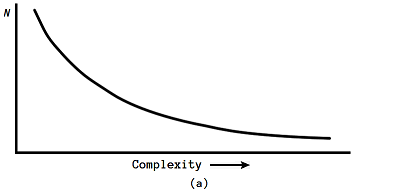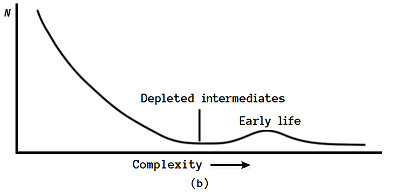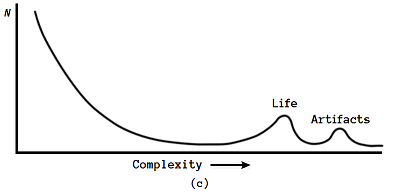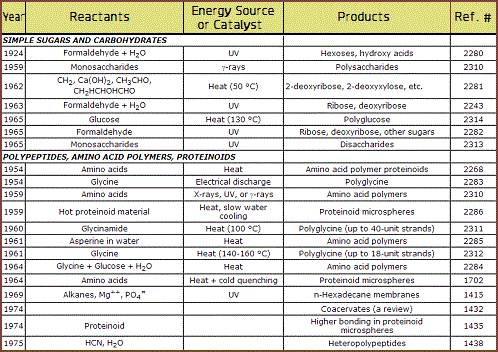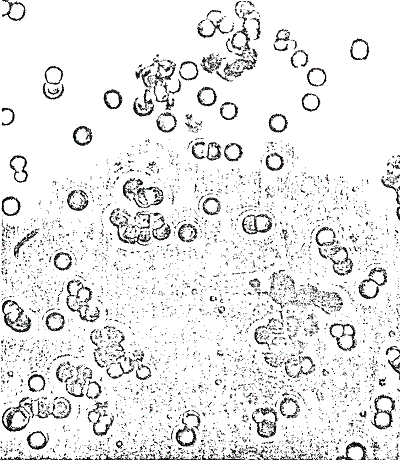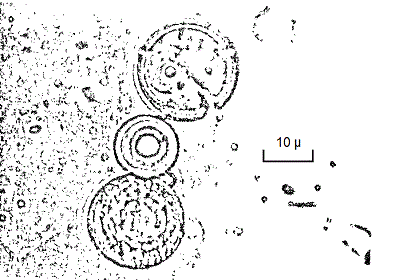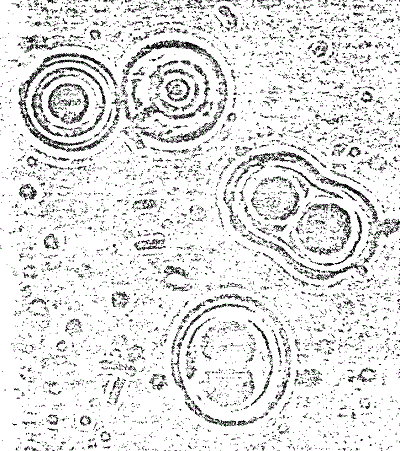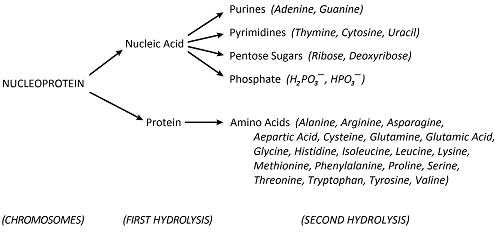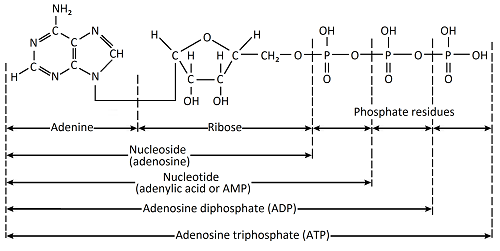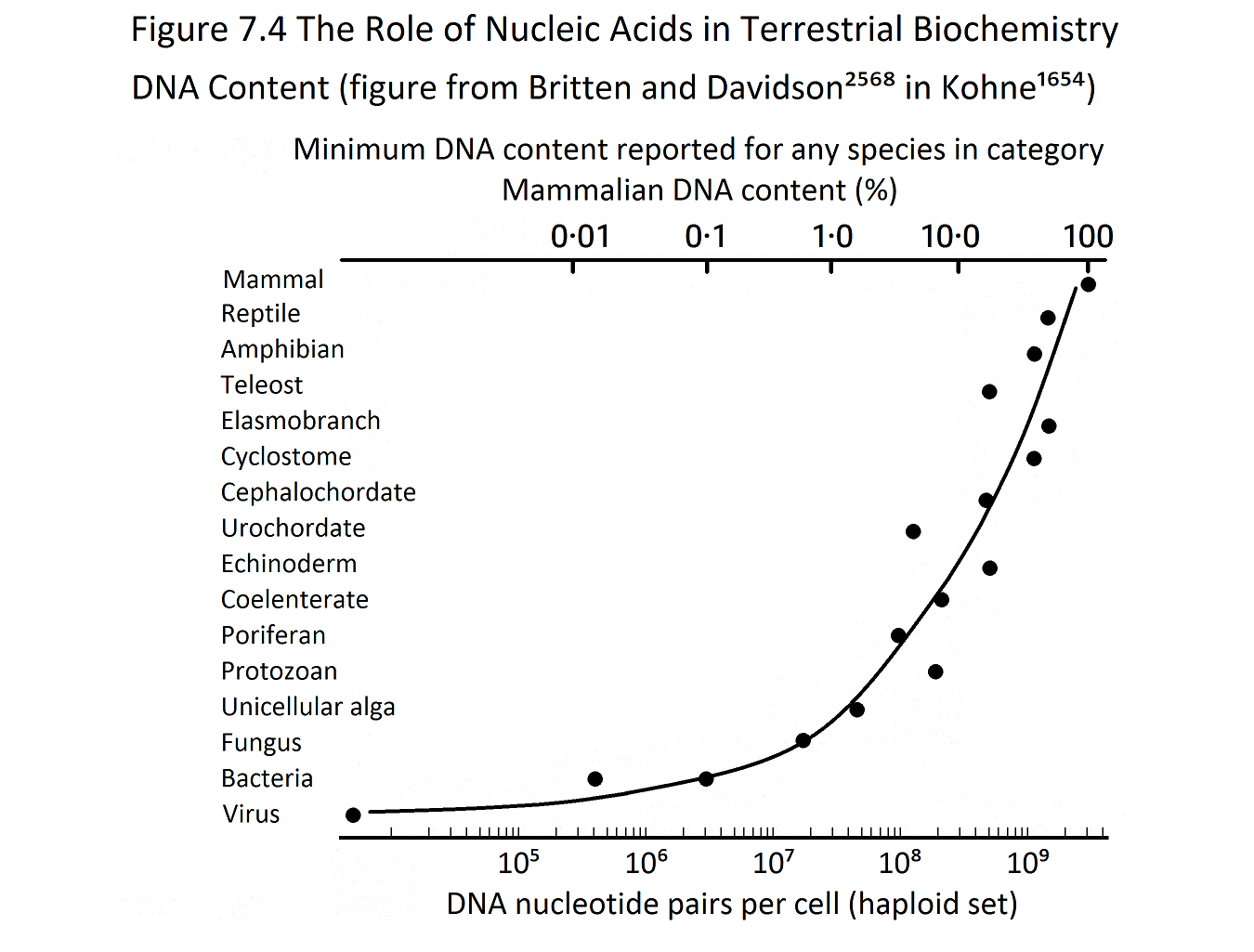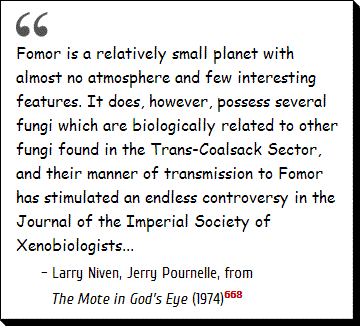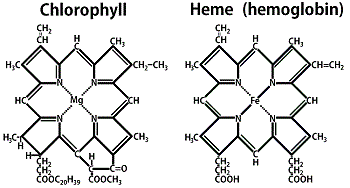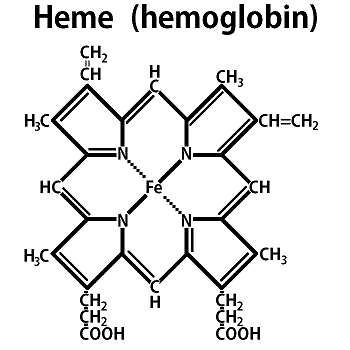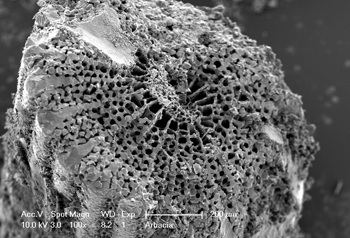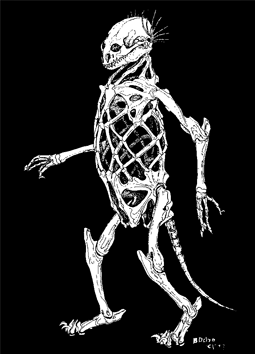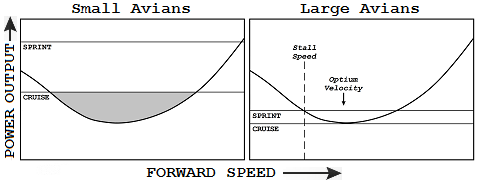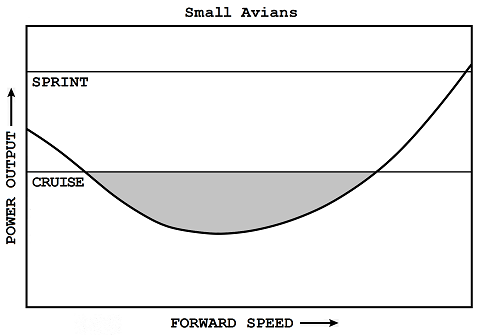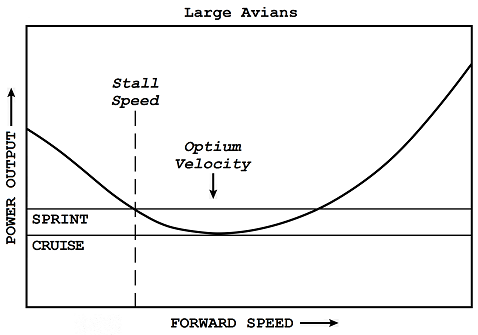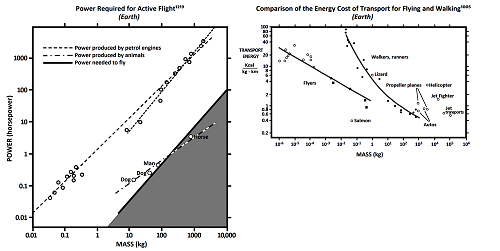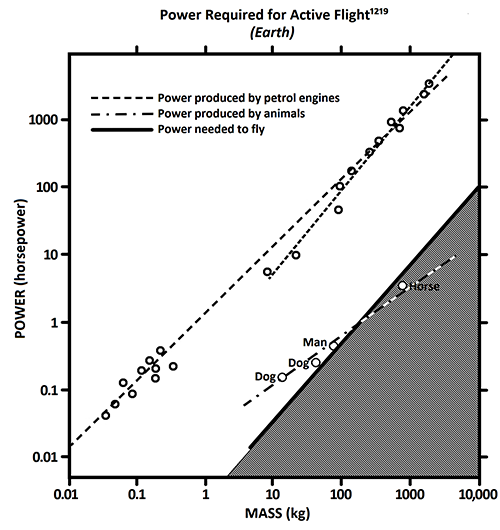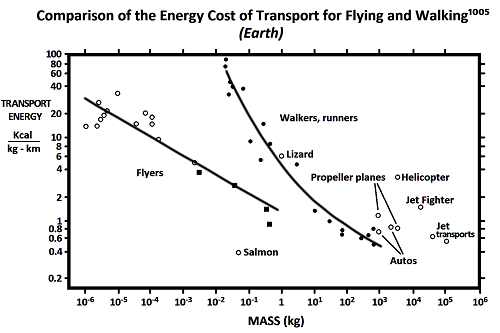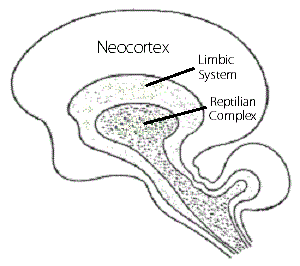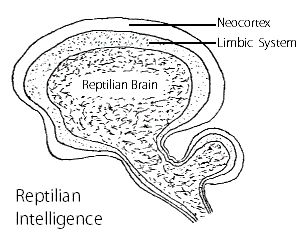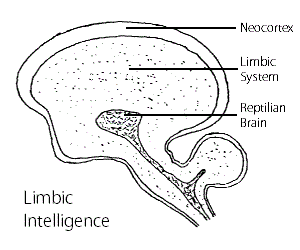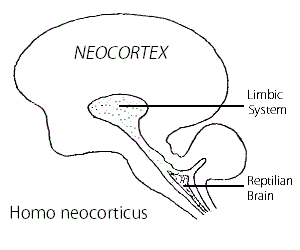© 1979 Robert A. Freitas Jr.
All Rights Reserved
| The ubiquity of life |
 In earlier chapters we considered the astronomical environment which extraterrestrial lifeforms must cope with. Other galaxies, stars, and countless planets appear amenable, if not perfectly hospitable, to life.
In earlier chapters we considered the astronomical environment which extraterrestrial lifeforms must cope with. Other galaxies, stars, and countless planets appear amenable, if not perfectly hospitable, to life.
Since no ETs have been detected outside the Earth to date, it might be argued that any statements regarding the ubiquity of life in the universe must necessarily be pure speculation. But this is not so. We have the incredibly good fortune to be alive at the first moment in history when this tantalizing question can be approached with rigor and in some detail.20 Not only can we draw certain tentative conclusions regarding the existence of extrasolar planetary systems, but we may also seriously discuss whether or not other worlds will possess environs which permit, encourage, or demand the emergence of life.
It is probably true that a good many planets are merely dead bodies of rock washed by sterile seas.939 Much depends on whether life originates quickly and regularly given suitable conditions, or if it requires an event so improbable that evolution in any reasonable time is scarcely possible on any world.
| Abiogenesis |
The study of the origin of life, called "abiogenesis" by many researchers in the field, is highly relevant to xenology and xenologists. By determining the conditions that existed on the primitive Earth, and by duplicating them in the laboratory, scientists can attempt to recreate events that must have occurred on this planet billions of years ago. Should these experiments indicate that the fundamental chemical building blocks of life are easy to generate — perhaps even inevitable under the proper circumstances — then we might well be justified in concluding that biology is a fairly widespread phenomenon among the many worlds of the Milky Way.
Studies in abiogenesis give some clues as to the universality of those processes which lead to the emergence of life. Of course, any rigorous discussion must include a good working definition of the subject of discourse. When we say we are searching for "life," what do we really mean? The traditional wisdom that "if it wiggles, it’s alive" is insufficient to deal with exotic lifeforms which may have little in common with organisms on Earth.50
We must also remain sensitive to yet another aspect of the problem of the origin of life. We 180-centimeter-high lifeforms with mere 70-year lifespans all too easily lose sight of the broader perspective we need to appreciate the vastness of space and time. This "chauvinism of scale" is simple to identify but almost impossible to overcome.
|
… in terms of mere planetary
spatial frames, biology is only an impurity, a trace constituent of the cosmos. |
In one sense, life is both abundant and ubiquitous on Earth. The live weight of microscopic organisms in an acre of soil to the plow depth of 18 cm has been estimated as more than two tons.* But viewed from a slightly different perspective, life fades into obscurity. The entire Earth weighs 6 × 1024 kg, the whole atmosphere only 5 × 1018 kg. The total mass of the biosphere is no more than 1016 kg, about 0.2% as much as air or 0.0000002% of the entire planet. The mighty works of man and nature are a kind of biological rust, clinging doggedly to the surface of a small world.20
So even in terms of mere planetary spatial frames, biology is only an impurity, a trace constituent of the cosmos.
Perhaps an even more relevant problem of scale is what might be called "temporal chauvinism." Man tends to think in terms of timescales commensurate with his own puny lifespan. But if we are to comprehend the meaning and the magnitude of evolutionary processes that lead to the origin and development of life, it becomes necessary to overcome temporal chauvinism. Centuries are of little concern in this arena — it is only the millions and billions of years that count.
Events which seem unfathomable in the usual time frame become more sensible on geological timescales. Indeed, it appears that the key to evolution is time. As one scientist puts it,
… in two billion years the impossible becomes the inevitable.702
A proper sense of the passage of time enables us to firmly grasp, not only the origin of life and the evolution of intelligence in the universe, but also such seemingly diverse topics as comparative culturology, technology gaps and alien thought processes, suboptic communications lag times, and the mechanics of galactic colonization.
* This includes 900 kg of molds, 450 kg of bacteria, 450 kg of branching unicellular organisms (Actinomycetes), 100 kg of protozoa, 50 kg of algae, and 50 kg of yeasts. Viruses are present in great numbers, but their mass is insignificant.38
In 1648 James Ussher, the Archbishop of Armagh, announced that the creation of Earth occurred promptly at 10 A.M., October 23, 4004 B.C. This span of roughly six thousand years was calculated in accordance with the descriptions and geneologies found in the Bible, and enjoyed wide currency until about two centuries ago.
Today we know that the material universe is far older. The primieval fireball is believed to have exploded perhaps sixteen billion years ago, the Milky Way coalescing a few eons later. Such vastness is scarcely conceivable in any meaningful terms.
How does one conveniently comprehend a span of time equal to millions of human lifetimes? Imagine that we draw a line from top to bottom of this page, a linear scale to portray the entire history of the universe.
On this map, the sum total of human civilization would be represented by an invisible sliver a few hundred atoms long. On the same scale, the time man has known electricity is measured by the span of two or three atoms. Even the segment illustrating the entire Age of Mammals would hardly exceed a millimeter in length (Figure 6.1).
|
Figure 6.2 Radical changes on the Earth due to 50 million years of continental drift are predicted by three University of Chicago paleoclimatologists477 |
 |
One rather well-known visualization was set forth by the famous British astronomer Sir James Jeans many decades ago. Imagine a penny carefully balanced atop the Washington Monument. Affixed to the cent is a postage stamp. Proportionately, the Monument represents the age of the Earth, the coin the entire age of the species of man, and the stamp the length of time since humans first learned to use tools.2109
Our minds are easily boggled. The whole history of the United States spans a mere two hundred years, a series of only eight generations of humankind. The differences between the late 18th century and the modern world seem immense. To contemplate our world as it may exist two hundred years hence sorely taxes our imagination (Figure 6.2).
But hundreds or even thousands of years are nothing to the xenologist.143 As biochemist and Nobelist George Wald aptly observes, "in geological time, even one million years is just a day.867 It is inconceivable that all other lifeforms throughout the Galaxy began evolving at exactly the same time as we, and at the same rate. If ETs do exist, many of them undoubtedly possess civilizations millions of years our senior — if not hundreds of millions or even billions of years more advanced.
|
Figure 6.3 Timescales of Responses to Change(from Wilson565) |
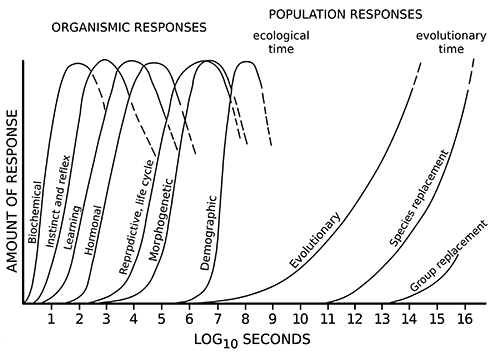 |
Before such numbing timescales, humanity pales into relative insignificance in view of the mission of intelligence in the cosmos. Even if mankind were to be virtually annihilated in some terrible natural catastrophe, over a span of millions of years other mammals might evolve to take up the niche vacated by ourselves. Considering the broad sweep of the evolution of sentience, there seems no reason to doubt that higher intelligence would reassert itself on this planet.
Barring such catastrophes, humanity and its progeny may have literally eons of life and development ahead of it.* The Age of Dinosaurs lasted only a hundred million years, roughly 0.2% the age of the Earth. Says Arthur C. Clarke: "If we last a tenth as long as the great reptiles which we sometimes speak of disparagingly as one of nature’s failures, we will have time enough to make our mark on countless worlds and suns."81
Part of our problem in understanding time is due to the differing order of change in nature (Figure 6.3). Humans are accustomed to dealing with events that can best be classified as "organismic responses" — instincts and reflexes, learning, cycles of reproduction and so forth.565 We are only now, in the 20th century, becoming dimly aware of the concept of ecological time, the scale upon which demographic (population) and ecospheric changes take place. And the next highest levels — of evolutionary and geological times — still remain beyond our ken.
* Ultimately, we are limited only by the lifetime of our sun. Another 8-10 billion years remain before it flickers and dies, although Earth will probably become uninhabitably hot in 4-5 eons.20, 2056 Perhaps by then, humanity will have discovered a new homeland.
One interesting example of a long-term trend is the change in the length of day. Every million years, because of tidal friction caused by the Moon, Earth’s day becomes about 3.3 minutes longer.2206 A couple hundred million years ago, during the Age of Dinosaurs, our planet revolved about one hour faster. In the steamy Carboniferous Period, when giant insects cruised forests of giant ferns, the day was only 22 hours long. One eon ago the components of Earth’s air were stabilizing near their present values and marine organisms were reeling with the discovery of sex. But they had to accomplish in only 18 hours what we take 24 to do.
Projecting into the future, a day in 1,000,000,000 A.D. will last about 30 hours. The Earth is gently slowing, a giant top marking time in eons.
"I perceived that I was on a little round grain of rock and metal," wrote Olaf Stapledon in his 1937 science fiction classic Star Maker,
filmed with water and with air, whirling in sunlight and darkness. And on the skin of that little grain all the swarms of men, generation by generation, had lived in labor and blindness, with intermittent joy and intermittent lucidity of spirit. And all their history, with its folk-wanderings, its empires, its philosophies, its proud sciences, its social revolutions, its increasing hunger for community, was but a flicker in one day of the lives of stars.1946
All of these considerations are of great significance to the origin of life on this planet. Until recently, scientists were of the opinion that the creation event itself might have taken place one or two eons after the formation of the Earth. But how much time was really required? As late as the middle of this century, no one really knew the answer to this question. The skeletal fossil record extends back only to the beginning of the Cambrian Period, about 600 million years ago. The Precambrian, comprising the first 87% of our world’s history, remained enshrouded in mystery and ambiguity.
In the last decade or two, improved techniques and several major finds have lifted the veil of ignorance. Scientists now hunt for molecular fossils, traces of the biochemical signatures left behind by the remains of microscopic organisms long dead.1420 The evidence now seems fairly clear that single-celled life existed some 3.4-3.6 billion years ago. (But note Schopf.2369) It is plausible that extremely primitive replicative lifeforms existed for several hundred million years prior to these earliest finds.41
|
We cannot even prove
that 10,000 years is too short a period. |
The implication is that life had half a billion years, perhaps even less, in which to assemble itself from nonliving chemical precursors. As two pioneers in abiogenesis research have noted:
There is no way at present to estimate when, during this (first) billion or so years, life arose. Periods of a hundred million years are so removed from our experience that we can have no feeling or judgement as to what is likely or unlikely, probable or improbable, within them. If the formation of the first living organism took only one million years, we would not be very surprised. We cannot even prove that 10,000 years is too short a period.521
The process of biological evolution must have begun as soon as the first living system emerged from the primieval "soup" four eons ago. Early forms of anaerobic photosynthesis probably arose three eons ago, in response to what one scientist has called "the world’s first energy crisis." Energy-laden molecules floating in the seas had become depleted. Photosynthesis allowed organisms to directly tap the power of the sun, which partially solved the crisis.
Unicellular life began to diversify about 2.3 billion years after the formation of the Earth, with the appearance of the first metazoans (multicellular animals).939 Aerobic photosynthesis was invented a short while later, and the concentration of oxygen — a harmful, poisonous waste product detrimental to most lifeforms in existence at the time — rose dramatically. In response to this "smog crisis," nature invented organisms able to consume the harmful oxidant and return carbon dioxide, thus detoxifying the air. These efforts were not entirely successful, however: Burning oxygen proved more efficient and made possible the conquest of land.
| Man - footnote to history |
Perhaps the vastness of time and our place in it can best be illustrated by the chronology in Table 6.1. Earth’s biography is plotted as a series of slow, painstaking steps from the formation of our planet 4600 million years ago up through the present. Truly, man is a mere footnote to history.
|
Our descendants …
will see our present age as the misty morning of human history. |
Sir James Jeans gracefully surmounts the barriers of temporal chauvinism:
We are living at the very beginning of time. We have come into being in the fresh glory of the dawn, and a day of almost unthinkable length stretches before us with unimaginable opportunities for accomplishment. Our descendants of far-off ages, looking down this long vista of time from the other end, will see our present age as the misty morning of human history. Our contemporaries of today will appear as dim, heroic figures who fought their way through jungles of ignorance, error and superstition to discover truth.2109
Opens (Mys) |
Characteristics |
and Climate |
(hrs) |
Midlatitude Lifeforms |
Life and Major Events |
||
|
4600
|
Azoic (~1000 Mys) |
H2 CH4, NH3, H2O (N2 CO, HCl, H2S trace constituents) |
Formation and consolidation of planet Earth |
||||
|
4500
|
(~2100 Mys) |
Primitive prebiotic chemical evolution |
|||||
|
4400
|
Atmosphere very highly reducing |
||||||
|
4300
|
|||||||
|
4200
|
Differentiation; solidification & stabilization of the crust |
||||||
|
4100
|
* * Origin Of Life * * * |
||||||
|
4000
|
Atmosphere strongly reducing |
Oceans filled to 10% their present volume |
|||||
|
3900
|
|||||||
|
3800
|
Great volcanic activity, granite intrusions, some sedimentary deposition, and extensive erosion |
||||||
|
3700
|
Great increase in N2 production |
||||||
|
3600
|
(~1100 Mys) |
H2 CH4, NH3, N2 (CO2, H2O, HCN, H2S as trace constituents) |
Graphites of possible |
Unicellular Life" |
|||
|
3500
|
|||||||
|
3400
|
Atmosphere less reducing |
||||||
|
3300
|
Oceans essentially filled | Onverwacht and Fig-Tree: Organisms resembling blue-green algae (chemical molecular fossils) Early protozoans |
Nonoxygenic photosynthesis | ||||
|
3200
|
CO2 rises to 1% of total atmospheric composition; H2 vanishes |
||||||
|
3100
|
First limestone deposits | Microfossils and bacteria | |||||
|
3000
|
|||||||
|
2900
|
Atmosphere slightly reducing neutralized |
Bulawayan Group, South Rhodesian limestones |
|||||
|
2800
|
|||||||
|
2700
|
Soudan Shale microfossils | ||||||
|
2600
|
|||||||
|
2500
|
(~300 Mys) |
N2, CO2 (NH3, CH3, H2O, O2 as trace constituents) |
Wealth of evidence of biological activity Strikingly advanced flora, Macro-fossils remain rare |
Primitive Marine Invertebrates" |
|||
|
2400
|
PRECAMBRIAN (300 Mys) |
||||||
|
2300
|
|||||||
|
2200
|
(~120 Mys) |
. | |||||
|
2100
|
PRECAMBRIAN (~600 Mys) |
Atmosphere slightly oxidizing |
Witwatersrand Supergroup, South Africa (microbiota) |
||||
|
2000
|
Great sedimentation; sedimentary rocks extremely thick; repeated glaciations; extensive erosion |
Anaerobic and oxygenic life flourish, the former slowly giving way to the latter Gunflint Iron Formation (Canada): blue-green algae, flagellates, & fungi |
oxygenic photosynthesis |
||||
|
1900
|
O2 begins a dramatic rise CO2 drops to present level CH4, NH3 vanish |
||||||
|
1800
|
Some volcanic activity | ||||||
|
1700
|
Atmosphere oxidizing | ||||||
|
1600
|
Primitive aquatic plants, marine protozoa and aerobic metazoa |
||||||
|
1500 |
|||||||
|
1400
1300 1200 |
Atmosphere strongly oxidizing | ||||||
|
1000
900 |
(~400 Mys) |
N2 78% O2 21% Ar ~1% CO ~0.1% H2O (trace) Modern atmosphere established |
Bitter Springs: blue-green algae, red algae, fungi, dinophyceans Mollusks, worms, & other marine invertebrates (sponges, brachiopods) |
||||
|
800
|
|||||||
| Algonkian Ice Age | |||||||
|
700
|
All animal & plant phyla established |
Higher invertebrates" |
|||||
|
600
|
(~375 Mys) |
Cambrian (100) | Climate warm; formation of major Paleozoic geosynclines |
Spores, tracheids Trilobites and brachiopods dominant Spread of land plants Freshwater fish, coral, Marine arachnids |
|||
|
500
|
Ordovician (75) | Low continents; warm Arctic; extensive land submergence & flooding |
Vertebrates |
||||
|
400
|
Silurian (25) |
Eocambrian Ice Age |
Wingless insects; amphibians, lungfishes, First reptiles |
||||
|
300
|
Permian (50) | Climate warm & humid at first, cooler later |
Giant ferns, cool swamps Large insects, thernlonts |
Insects and Amphibians" |
|||
|
200
|
(~150 Mys) |
Triassic (50) | Dry and cool; continental uplifting, Pangea breakup |
Modern insects First dinosaurs First mammals |
|||
|
Jurassic (50) |
Climate warm, last widespread flooding, shallow inland seas; Alps, Andes, Himalayas, Rockies rose |
Giant dinosaurs, toothed birds Dinosaurs decline; first flowering plants |
|||||
|
100
|
(~75 Mys) |
Tertiary (75) | Climate cooler Quaternary Ice Age (repeated global glaciation) |
Rise of birds, higher mammals, and arthropoids (including the genus Homo) |
|||
| Quaternary (1) | |||||||
 Anthropologists jokingly tell of two cannibals watching an airplane fly overhead. Eyeing the craft wistfully, one says to the other, "It’s very much like lobster. It’s hard to get into, but very good once you get inside."
Anthropologists jokingly tell of two cannibals watching an airplane fly overhead. Eyeing the craft wistfully, one says to the other, "It’s very much like lobster. It’s hard to get into, but very good once you get inside."
Kenneth Boulding, Director of the Institute of Behavioral Science at the University of Colorado, insists that the cars, planes and factories which surround us bear an analogous relation to the life inhabiting them as the lobster’s shell does to the lobster. "If a being from outer space were observing this planet," Boulding suggests, "he might well report that the process of evolution had produced a species of large four-wheeled bugs with soft, detachable brains."30
How can we accurately differentiate the living from the nonliving? For years, science fiction writers have been teasing our imaginations, giving us stories about plants that act like animals,564, 2115 animals that act like plants,607, 2168 and other organisms that almost defy classification.1561, 2163, 2210, 2221 Countless stories have been written around the theme of "machine life,"983, 1755, 1836, 1912 and a well-known Stanford radioastronomer has speculated that there may exist aliens which are simply spherical balls. Instead of handling objects as we do, Dr. Ronald Bracewell suggests that "they might have to ingurgitate them and manipulate them as we can manipulate things with our tongues. Perhaps their tongues would be luminescent and there would be an eye in the roof of their mouth, or a microscope."1040
Science fictioneers have devoted a great deal of time to an attempt to identify some of the problems we may encounter simply in recognizing that an object on another world is alive. False calls in either direction are possible. We may, for instance, mistakenly ascribe life to what is in reality a purely physical process. Conversely, there is the more frightening possibility that we might fail to identify a fascinating but unusual lifeform, which could cause irreparable harm before the error was discovered.
|
Hypothetical organisms
|
| Polymorph |
Such hypothetical organisms generally fall into five broad categories (although there are numerous exceptions). First we have the polymorph, a creature having a plural or changeable form. In Olaf Stapledon’s First and Last Men, Earth is invaded by a host of microscopic organisms from Mars. On occasion, these microbes form themselves into a rational entity by solidifying as a kind of "intelligent cloud."81 Such is not without precedent even on Earth: It has long been debated whether the sponge (Porifera) is a true organism or a colony of unicellular organisms.443
| Lithomorphs |
Ralph Milne Farley wrote "Liquid Life" back in 1936, in which a virus in a pond achieves group-collective consciousness.581 This is similar to the "scum-intelligence" proposed by Bracewell80 or the "mold-intelligence" proposed by Academician A. Kolmogorov, a Soviet writer.1330 Perhaps easier to view as living but equally difficult to understand are Arthur Clarke’s Palladorians, each of which is described as possessing "no identity of its own, being merely a mobile but still dependent cell in the consciousness of its race."2207 Another class of exotic fictional lifeforms are the lithomorphs, organisms having the form of rock. Such creatures have actually been discussed in sober scientific circles.1238 The two extremes of the problem of false calls are nicely illustrated by a pair of science fiction tales involving lithomorphs.
The Star Trek episode entitled "Devil in the Dark" deals with the discovery of a silicon-based organism that lives in the rocky mantle of a small planetoid. The human miners had been collecting and destroying apparently useless spherical silicon nodules — which turned out to be the Horta’s eggs. In Clarke’s novel Imperial Earth, exactly the opposite difficulty is encountered. Early settlers on Titan, the largest moon of Saturn, discover the "waxworms," entities snaking around on the surface at speeds up to fifty kilometers per hour and often pausing to climb over hills. "To the bitter disappointment of the exobiologists," Clarke writes, "they had turned out to be a purely natural phenomenon…"1947
| Macromorphs |
Macromorphs are beings having a large or elongated distribution. Typical of this class is the huge single-cell lifeform encountered in the Star Trek adventure "Immunity Syndrome," or the Gaia concept of the living planet sponsored by scientists Margulis and Lovecock.1293
Perhaps the most fascinating suggestion along these lines was made by the Swedish writer Gosta Ehrensvärd, who pointed out that organisms in the sense we understand may not even be a prerequisite for life.257 As an example, he envisions a coordinated network of lakes and streams covering a planet, participating in a complementary carbon cycle together with a sun-activated circum-planetary flow of water. Such a system, Ehrensvärd claims, "would undeniably constitute life, but it would hardly correspond to our idea of organism life. We could hardly recognize at first that we were dealing with something living, for we would not see any mass, body, or anything moving, but only a global activity in chemical serenity."
| Amorphs |
The fourth class of unusual creatures are the amorphs, those entities which exist without form or shape. Perhaps the best-known amorph is from the 1958 Paramount Studios movie "The Blob," the story line of which will not be gone into here. Suffice it to say that such organisms are not wholly without precedent on Earth. Slime molds are acellular plants which, because their construction is not unlike a sheet of water, find it possible to slowly creep about on the ground.
| Plantimals |
Blobs could also arise by natural evolution from Euglena ancestors (a photosynthetic microbial animal), or by artificial evolution as a direct consequence of genetic experimentation with "plantimal" cells. Plantimals are created by fusing animal cells with plant cells to form viable interkingdom protoplasts. To date, human tissues have been mated with carrot and with tobacco cells, and rooster cells have been joined with tobacco as well. According to Dr. James X. Hartmann of Florida Atlantic University at Boca Raton, a living, meatlike amorph might eventually be grown as livestock which could build animal protein by converting the sun’s energy directly into chemical energy — just as plants do.1617
|
There have been many variants on this theme in science fiction,1389 including petroleum-blobs such as in Brenda Pierce’s "Crazy Oil" on Venus.2071 In a familiar plot line, the human miners discover too late that the sticky black goo they’ve been extracting is part of a living organism. Still more fascinating is the possibility of superfluid amorphs, such as those described by Larry Niven in his "The Coldest Place":
| Electromorphs |
Finally, we have the electromorphs — beings having the form of electronic energy, fields or plasmas. These ethereal creatures, first described by the Russian space pioneer K. E. Tsiolkovsky445 and later given a more public airing in the Kubrick-Clarke masterpiece 2001: A Space Odyssey,1912 are among the most beloved of science fiction writers. Hal Clement notes that "one must admit that very complex electric and magnetic field structures other than those supplied ready-formed by atoms and molecules are conceivable."878 One of the first science fiction novels the author ever read, decades ago, was about a form of intelligent ball lightning inhabiting the planet Mercury.*
Arthur Clarke has warned that we might not even be able to detect the presence of an alien species on a planet, save by the use of sophisticated electronic gadgetry. The lifeform could be gaseous, electronic, or could operate on timescales far faster or slower than our own.81 Hal Clement has fictionally created creatures constructed of densely packed electrons possessing quasi-solid properties and which live inside suns,2139 and still others that inhabit neutron stars, existing in a kind of superoptic quantum space and feeding directly on patterns and structures of information.2183
The classic electromorph of all time remains, however, astronomer Fred Hoyle’s Black Cloud — a kind of intelligent comet.62 (Being a lifeform of the dimensions of a solar system, it is also a macromorph.) In the novel, a great patch of ionized gas, which enters our solar system and engulfs Sol, is found to be alive when efforts to predict its movements using the simple laws of mechanics fail. Says the astronomer-protagonist in The Black Cloud: "All our mistakes have a certain hallmark about them. They’re just the sort of mistake that it’d be natural to make if instead of the Cloud being inanimate, it were alive."
It turns out that the biochemistry of this amazing organism is plasma physics instead of molecular chemistry. Memory and intelligence are stored on a conductive substrate of various solid materials, and are controlled, operated and manipulated purely by means of electromagnetic forces. Ionized gases carry substances to wherever they are needed, like a bloodstream. The Cloud must therefore be recognized as alive, at least in the sense of possessing intricate structures, a capacity for regeneration and energy utilization, and a complex behavior.
* I have since forgotten the title, which annoys me greatly. (Note added, 2 Jan 2011: Erik van Lhin (aka. Lester del Rey), Battle on Mercury, The John C. Winston Company, Philadelphia PA, 1953.)
 The possibility of discovering an exotic lifeform such as the above has spurred biologists to carefully reconsider their assessment of the nature of life. Scores of situations can easily be conjured up in which our tried-and true common sense rules break down horribly. The need for a more rigorous definition is clear.
The possibility of discovering an exotic lifeform such as the above has spurred biologists to carefully reconsider their assessment of the nature of life. Scores of situations can easily be conjured up in which our tried-and true common sense rules break down horribly. The need for a more rigorous definition is clear.
If so many different kinds of life are possible, though, can we hope to reach them all with a single definition? Perhaps. For instance, one comprehensive characterization of life, at once exact and unsatisfying, might be: "Life is a highly improbable state of matter."1171 The difficulty arises when we try to be a bit more specific than this.
Some of the most generalized functional definitions have been rather ingenious. One author presents an ecological specification: A rock has small influence on another rock, but an organism profoundly affects all other living things around it. Living creatures alone can form ecological systems.64 Dr. Daniel Mazia has suggested that survival is the key to understanding what life is. As he correctly points out,
the living world thwarts time by survival, all the rest combats time by endurance.313
Another writer, Dr. V.A. Firsoff, has proposed that "mind" underlies all life, but is a quality denied to the nonliving.352 Others would claim that "the exclusive property of life is consciousness"171 or "self-direction."444 Still another definition hinges on the similar concept of "free will." As the late John Campbell, former editor of Analog, once put it: "Inorganic matter displays the characteristic that what it can do, it must. Any nonliving system always does everything it can do. Living systems don’t display that characteristic; if a living organism can do something, it — may."200
|
Life's unique properties
|
The traditional biologist points out that all living things possess certain unique properties. One way to define life rigorously is in terms of specific, enumerated traits: Growth, feeding and metabolism, motility (physical movement), responsiveness to environmental stimuli, and reproduction with adaptation.
Let’s look at each of these in turn.
During the process of growth, a living organism takes in raw materials and integrates them into itself. Molecules of various substances are added, redistributed, or removed as the body changes shape and develops new structures. Growth also allows for replacement of old worn-out parts.
Unfortunately, many non-living systems also display growth. Crystals of table salt, for instance, or hailstones can be said to grow.
|
Reproduction is probably
the most frequently cited "essential" defining characteristic of living systems. |
"Chemical gardens," made from heavy metal salts immersed in a bath of sodium silicate solution, also exhibit growth. It is true that most of these counterexamples involve only simple accretion from the outside, and the structure remains basically unchanged. But the flame of a candle appears to grow, and in a fire there is an actual throughput of new atoms. Hence, the candle flame is a valid exception to growth as a defining characteristic of life.
How about the criteria of feeding and metabolism? We know that living organisms eat primarily for two reasons. First, food is ingested and metabolized to provide an energy exchange with the surrounding medium. This gives a lifeform the ability to carry out any other functions it may wish to perform — reproduction, movement, thinking, more eating, etc.
Second, food must be accumulated to secure the raw materials necessary to effect repairs and to maintain growth. As has been pointed out, the kind of food consumed is really irrelevant. While humans and worms may prefer apples, some bacteria thrive on the most putrefactious sewage (and abhor oxygen), and plants "eat" carbon dioxide and sunlight.
But here again we note that the candle flame has a kind of metabolism. Fires may be said to digest their fuel and to leave wastes behind as chemical energy is converted to heat. Crystals too may eat, if we are willing to consider the saturated chemical solution in which they grow to be their food. Even machines metabolize their fuel, whether to manufacture spare parts or to build near-duplicates of themselves.
Motility is another oft-touted characteristic of life: Animals, and plants to a lesser extent, are capable of bodily movement. Yet there are many analogues in the world of the nonliving. Rocks and snow move in avalanches, cars travel highways, rivers flow, and under the proper thermal conditions metals will expand and contract. Granted, most of these are the result of the imposition of strictly external forces.444 Nevertheless, the fact that forest fires may spread under their own power constitutes an exception to the motility rule.
What about irritability? It has been said that if organisms are to profit from their association with the environment, they must be responsive to it at all times. Sensors and effectors thus become more and more highly developed as we climb the evolutionary ladder.
However, some non-motile bacteria show little evidence of reaction to stimuli,64 and plants are notorious laggard in their responses. Also, irritability is a property demonstrated by many nonliving systems. Crystals react quite sharply to changes in the solute concentration or temperature of their environment. The candle flame recoils when an open door admits a draft. A flask of nitroglycerine is highly responsive to certain environmental stimuli, particularly heat and shock.881
Reproduction is probably the most frequently cited "essential" defining characteristic of living systems.20, 521 Although a few scientists would demand the presence of DNA or RNA molecules, proteins, lipids, polysaccharides and the like as requirements for life, most stick to the basics: Replication plus adaptation.
According to these so-called "genetic" definitions of life, living things are entities capable of reproducing themselves, mutating, and subsequently re-reproducing the new mutated form. Organisms are required to multiply geometrically as well. Simple arithmetic reproduction, as in a printing press, is insufficient. The copies themselves must also be able to make more copies. When mutations arise, they are faithfully duplicated — variation is preserved in subsequent replications.
The central idea behind this attempt to define life by reproduction is that living organisms must be the subjects of natural selection, capable of adaptation and evolution. Any system that can replicate, mutate, and replicate mutations will be susceptible to normal evolutionary processes. Favored organisms with the highest potential for survival go on to multiply; others who fare more poorly in the struggle for existence eventually become extinct. Fundamental to the genetic definition of life, then, is the built-in and perhaps unwarranted assumption that a certain level of complexity cannot be achieved save by natural selection operating via adaptive replication.2358
It is entirely possible that some lifeforms may have no need to reproduce themselves. Such nonreproducers, if they exist, must be either immortal or very recent arrivals. One class of such beings would be self-creating but nonreplicating organisms, such as robots capable of making continual repairs and of upgrading their own mechanisms periodically, or such as astronomer Hoyle’s Black Cloud mentioned earlier.
There could even exist beings who evolve by means of acquired characteristics.2216 Such lifeforms could neither die nor reproduce, but would instead modify their parts in response to the changing environment. As Dr. P.H.A. Sneath of Leicester University puts it: "Evolution and selection would then operate internally on their constitution, rather than on a succession of descendent organisms."64 Dr. Sneath suggests that the closest analogy to this might be soils, which don’t reproduce in the usual sense but are complexly organized systems nevertheless. Soils respond to environmental changes, arise wherever there is rock and wind to erode it, and are virtually immortal. Organisms such as these would be unable to "compete" with their neighbors without blending together with a total loss of individuality.
|
Most bees, ants, wasps and
termites don’t reproduce… |
There are other objections to the use of adaptive reproduction as the fundamental criterion for life. Mules, the offspring of a mare and a male donkey, are sterile and so technically are not "alive"- under the genetic definition. Most bees, ants, wasps and termites don’t reproduce either. Selection acts on the whole nest, rather than on individual units, so evolution proceeds through the queen and drones alone. Many varieties of hybrid flowering plants are similarly sterile.
The inorganic world too is rife with exceptions. Flames, driven by wind or with sparks, can reproduce and "mutate." Crystals placed in solutions doped with foreign ions are perfectly capable of reproduction, mutation, and of propagating the mutation (i.e., lattice imperfections).
We see that traditional concepts of life are unduly restrictive for our purposes. As Dr. Mazia laments: "The problem is not that our conception of a living thing is vague; on the contrary, our concern is that it is too definite because it is too provincial."313 We must seek more generalized means to identify and to define life.
| Complex interrelatedness |
 Life is a process by which relatively unorganized environmental components are made more organized. That is to say, life is a building up-process, although to organize also means to cut down the possibilities. But certainly a basic characteristic of all lifeforms is that they are highly organized.2214
Life is a process by which relatively unorganized environmental components are made more organized. That is to say, life is a building up-process, although to organize also means to cut down the possibilities. But certainly a basic characteristic of all lifeforms is that they are highly organized.2214
What do we mean by "organization"? The concept may be viewed in terms of what Sneath has called "complex interrelatedness.64
Interrelatedness means simply that all parts of the pattern are related to and somehow affect all other parts. Each component reacts to changes in its surroundings so as to preserve internal integrity and minimize the effects of any disturbances. This damping action is the principle of homeostasis, common among biological systems. Of course, biochemical homeostasis can be preserved only within certain critical tolerance limits. Death will rapidly overtake any system which is subject to stresses it cannot tolerate.
Complexity is the other facet of organization.64, 1643 "Complex" is used here in its normal sense, as opposed to "simple." Candle flames have a great deal of interrelatedness, yet they lack complexity and hence "organization" as well. Conversely, a lump of granite is highly complex, but because it lacks interrelatedness it cannot be considered "organized" in the sense of having life.
|
The key to life
may well be information itself. |
Dr. Sneath cites a most useful example of the role of complexity. If complexity is defined as the amount of information needed to completely characterize a system, the perplexing case of the growing crystal is greatly simplified. We might describe a small cube of rock salt as follows: "A simple-cubic Bravais crystal lattice structure with spacing of 2.82 × 10-8 cm, consisting of alternating sodium and chlorine atoms, containing a total of 1020 atoms of each kind." This requires only a few lines of print, and is complete.
On the other hand, living things are typically characterized by enormously more complicated descriptions. Life systems possess order on a scale far smaller than the macroscopic. Unlike the monotonous repetitiveness of the salt crystal, even the simplest bacterium needs some 103-104 different enzymes, each with a unique sequence of perhaps a hundred or so amino acids.64, 630 This is real complexity. On the microscopic level, life might best be characterized as a highly "aperiodic crystal."2213, 2364
The key to life may well be information itself. The living world is built from the stuff of the nonliving world, different only in its complexity and organization. Organisms find it possible to actually store and replicate the information that specifies their organization.
Yet it is purely capricious to set some arbitrary level of complexity as the threshold of life.1717 A frozen amoeba, for example, has an amazingly detailed and intricate structure without being alive — it has only the potential for life. Organization, as we shall see presently, is a most useful parameter for assessing the intensity or efficiency of life. However, it is more reasonable to base our definition on the fundamental processes and functions displayed uniquely by living systems.
|
Entropy:
|
Thermodynamic and statistical principles are among the most fruitful tools of scientific inquiry. They are equally applicable to simple and to complex systems, living or nonliving, terrestrial or extraterrestrial. As Dr. James P. Wesley, Associate Professor of Physics at the University of Missouri in Rolla, tells us:
The relationship of life to the environment is, above all, a thermodynamic relationship. Wherever man may go and whatever alien lifeforms he may encounter, the thermodynamic behavior of life will always be basically predictable.1717
The idea of entropy is often involved in modern discussions of the definition of life.
What is entropy? There are really two relatively straightforward aspects of this concept. The first ties in to the thermodynamic aspects of matter, having to do with heat and energy; the second pertains to statistics and order in any system.
Entropy in the thermodynamic sense is a distinct, physically measurable quantity, much like length, temperature, or weight. At a temperature of absolute zero, to take one example, the entropy in a lump of matter is exactly zero. If the temperature is slowly increased in tiny, reversible little steps, the increase in entropy is mathematically equal to the amount of energy (in joules) divided by the temperature at which it was supplied. This holds even if a change of state occurs, as from solid to liquid.
Suppose that we melt a cube of solid ice at 0 °C. If the mass is 1 kg, the increase in entropy can be calculated as exactly 1223 joules/degree. Entropy in the thermodynamic sense is thus a very real, physical quantity.
In the statistical sense, entropy is a measure of the disorderliness of a system. It seems rather clear that when we melt our 1 kg block of ice, the neat orderly arrangement of water molecules in the cube is destroyed. The rigid crystal lattice is converted into a less ordered system — the continually changing, sloshing, randomized distribution of molecules in a liquid.
When the orderliness of a system decreases, the entropy correspondingly increases. The situation is analogous to the state of the public library when the shelvers are out on strike. Books are removed from their proper places but are not returned. Disorder and randomness — entropy — increase.
The greater the structural complexity of a system, the more information is required to describe it. The more organization a system has, the more information and the less entropy it possesses. But information and orderliness, on the one hand, and entropy, on the other hand, are irreconcilable.
|
It is the business of the
universe to destroy complexity and to become progressively more randomized. |
The Second Law of Thermodynamics states that entropy and disorder shall always increase and that information will naturally tend to be degraded and lost in any isolated physical system. (Such isolated systems drift from less probable states to more probable ones.) It is the business of the universe to destroy complexity and to become progressively more randomized.
How does this relate to life? Organisms appear to present a rather curious thermodynamic anomaly. Living systems "violate" the Second Law, by developing well-ordered systems (themselves) out of relatively chaotic systems (their food).85 At first blush, lifeforms seemingly oppose the "universal drive to disorder" mandated by thermodynamic principles. They organize their surroundings and produce order where there was little or none before. Entropy is actually reduced.
This apparent conflict has only been resolved in the last decade or so. Classical treatments dealt with idealized, isolated systems which transfer no energy or matter between themselves and the external environment.2213 In sharp contrast, most systems in nature are nonisolated "open" systems, exchanging matter and energy with the surroundings.
|
Energy emerges from the source,
flows to the sink, and is there absorbed. |
Energy by itself is not enough — there must be a useful flow of it. This means that to support life, an environment must possess both a "source" and a "sink." Energy emerges from the source, flows to the sink, and is there absorbed.
Living systems customarily establish themselves as intermediate systems, interposed between some source and some sink in the environment. Then, they utilize the energy flow from source to sink to power their own internal functions.
The total entropy of the entire system, which we shall label E, is the sum of the entropies generated in two separate places. First, there is the entropy caused by the source-to-sink energy flow which we shall call S. Then there is the entropy generated by the intermediate system (the living organism) due to exchanges of matter and energy with the surroundings. If we call this L, then we know that the change in total entropy DE = DS + DL.
The second Law of Thermodynamics demands that the total entropy E of any isolated system always increase. Hence, the amount of change must always be positive, so DE > 0. The flow of energy from source to sink (S) consists of irreversible processes, so it too must always cause entropy to increase: DS > 0. Consequently, -DL < DS is our only constraint.
|
Negentrophy: Local pockets of negative entropy change. |
What does this mean in plain English? The last equation above simply says that while the entropy of a living system is always permitted to increase by the Second Law (e.g., upon death), a short range of decrease is allowed as well. That is, it is thermodynamically permissible to have local pockets of negative entropy change — "negentropy."
|
… the essence of life is
that it feeds on negentropy. against increasing entropy. |
Dr. Erwin Schroedinger was really the first to point out that the essence of life is that it feeds on negentropy.1678 An organism able to transfer disorder from itself to its environment can reach a plateau for which the steady-state entropy within the living system is less than the formal entropy entering it.85 Life involves a continuing struggle against increasing entropy.
Living systems thus increase local order at the expense of a larger decrease in order within the environment.
Does life really violate the Second Law of Thermodynamics? We’ve seen that organisms can effect a local decrease in entropy by maintaining an energy flow.* This leads to an ordering of the intermediate (living) system. So the Second Law does not hold for nonisolated systems (L), but only for isolated ones (E). It is invalid for lifeforms alone, but does hold if that same living system is considered in conjunction with the medium in which it is immersed.
Life by itself is a nonisolated system capable of achieving negentropic conditions locally. Life plus environment is an isolated system, for which the total amount of entropy must always increase.
As one writer puts it:
|
* A probable corollary is the necessity for "phase separation." In some sense, the sources and sinks should be physically separated with the living system inserted between them. So we expect barriers to exist between an organism’s sources and its sinks. This prevents dissipation of the system, protects it from adverse changes in the environment, and insures the lifeform’s ability to exert and maintain control over its interior.2213 The exact nature of these barriers — whether gravitational, electromagnetic, or utilizing some hitherto unsuspected principle — has not been widely discussed.64
|
It is the business of life to accumulate
information and complexity. |
At the most fundamental level, negentropic ordering processes are achieved by living organisms. Life drives its environment to physical or chemical disequilibrium, establishing an entropy gradient between itself and its surroundings.1144 All living systems possess this feature, and it is contended that any system engaging in such negentropic operations must be considered "living" to a certain extent (Figure 6.4).
The question is, of course, to what extent?
Rather than viewing the question of life in absolutist terms, it seems more fruitful to establish the intensity of negentropic processes as a measure of the extent of the life-quality. One of the more fundamental distinctions between "life" and "nonlife" is the degree of organization and internal structure possessed by living systems. Order and structure are virtually synonymous with information content.1012
That is, living systems do more than merely establish a thermodynamic entropy gradient — they establish an organizational / informational gradient as well. As organisms feed on negentropy, they in effect remove information from the surrounding medium and store it within themselves. It is the business of life to accumulate information and complexity.
|
“It is the business of life
to accumulate information and complexity.” |
In a physical sense, these data bits which permeate all lifeforms may be thought of as being stored in an "aperiodic crystal" — a biological lattice with highly irregular small-scale nonuniformities.2213 The more effective the negentropic processes, the greater the organization which will arise and hence the more aperiodic the physical structure will become. Organization is maintained by the extraction of order from the environment.
If we consider every "autonegentropic" system to be alive, then its character or richness of expression may be defined along a spectrum from lesser to greater levels of organization. At one extreme are the viruses, which are not negentropic systems by themselves and thus cannot be considered alive in the absence of living hosts. At the other extreme are mules and bees, earlier rejected by the genetic definition of life because of their individual inability to reproduce. These animals are quite clearly auto negentropic systems possessing a vast degree of organization both in the macroscopic and microscopic realms. Thus they are not only "alive" (because they feed on negentropy to build internal complexity) but also "very alive" (because they are so internally complex).*
The refrigerator in my house technically should be considered a "live" system in the very broadest sense, as it is a well-defined intermediate system which uses an energy flow to decrease entropy within (the icebox gets colder, and well-ordered ice crystals collect on the freezer walls) at the expense of increasing the entropy in the external environment (the kitchen air gets warmer). Yet its organizational structure is minimal. Little information is stored, and there is only trivial interrelatedness even on the macroscopic scale. There is scant evidence of aperiodic crystal, no complexity at all on the microscopic stage. So the intensity of life in my refrigerator is negligibly small.
Note that "machine life" or "solid state life" per se is not ruled out. As machines become more and more sophisticated, complexity follows. Large-scale integrated circuits available today pack millions of components onto a tiny silicon wafer the size of a postage stamp. Under the microscope, significant aperiodicities have begun to appear in the latest generation of electronic devices. It is entirely possible that, in time, machines will evolve beyond the point of negligible life-quality. This is true, despite the fact that modern digital computers (which merely process data without adding any of it to their internal structure) are not yet alive at all.
* While evolution and the capacity to reproduce are of immense biological importance, a system need not be capable of reproduction for it to be classified as living.2213, 62
In conclusion, xenologists suspect that there are two fundamental properties any system must possess before it can be considered alive:
|
For those who prefer succinct and pithy definitions, the author would
like to offer the following as a starting point for further discussion: Life is negentropic and self-organizing aperiodic crystal. |
- First, it must be thermodynamically negentropic, establishing an entropy gradient between itself and the environment.
- Second, it must utilize the entropy gradient to create or to maintain structural order internally — that is, it must be autonegentropic or self-organizing.
Then there is the quality of organization, known as complex interrelatedness or aperiodic crystal, which reflects the intensity of the life process displayed by a given entity.
 |
| Two central themes of xenobiology |
Scientists today will still admit that they really don’t know how life began on our planet. Laboratory work is tricky, and nobody was present to witness events at first hand on the primitive Earth. Researchers in abiogenesis can only invent some reasonable story about how life arose, and then maximize its plausibility by theoretical and experimental investigations.20
There are two central themes that run as undercurrents throughout the whole of xenobiology. First, what is the probability that life of our kind will evolve on other worlds? By illuminating the abiogenic processes of this planet in ancient times, scientists hope to get a handle on the exact combination of conditions and events necessary for the origin of carbon-based Earthlike life anywhere in the Galaxy.
The second central theme of xenobiology, to which we shall return in later chapters, is the likelihood that life, once having emerged in a planetary environment, will constitute a form of biota more or less similar to that found on Earth. The laws of biochemistry demand that molecules combine only in certain specific ways, and usually only in a very few most probable ways. In other words, what are the physical and biochemical limits of the possible?
 Speculations on the source of life have been abundant throughout recorded history. The Rig Veda mentions that biology began from the primary elements, and the Atharva Veda suggests that the oceans were the cradle of life. The Bible, with its contradictory accounts of the Creation in Genesis (did man arrive before or after the beasts?), is strictly adhered to by many fundamentalists. Philip Henry Gosse, an eminent 19th century zoologist and Christian, found it a simple task to reconcile the growing mass of paleontological evidence with the Scriptures. God, he declared, created the Earth entirely in accordance with scientific findings. The Lord fabricated geological strata, embedded fossils and the like for the sole purpose of fooling geologists. The apparently extreme age of Earth is only an illusion.
Speculations on the source of life have been abundant throughout recorded history. The Rig Veda mentions that biology began from the primary elements, and the Atharva Veda suggests that the oceans were the cradle of life. The Bible, with its contradictory accounts of the Creation in Genesis (did man arrive before or after the beasts?), is strictly adhered to by many fundamentalists. Philip Henry Gosse, an eminent 19th century zoologist and Christian, found it a simple task to reconcile the growing mass of paleontological evidence with the Scriptures. God, he declared, created the Earth entirely in accordance with scientific findings. The Lord fabricated geological strata, embedded fossils and the like for the sole purpose of fooling geologists. The apparently extreme age of Earth is only an illusion.
| Hylozoism |
Peculiar ideas abound. Hylozoism, for instance, is the belief that matter and life are one and inseparable. From this viewpoint, life either has no origin and has always existed, or else the question may be deferred to the origin of all matter.
The theory of pyrozoa, to cite another example, was advanced by William Preyer in the last century. Preyer believed that life has existed at all times, even when our planet was still in the molten state. These first fiery living things, the pyrozoa, slowly modified and adapted themselves as the environment cooled and changed, eventually assuming the form in which life presents itself to us today.2218
Most theories on the origin of life have fallen into one of four distinct categories:
- Life has no origin — both life and matter have existed forever;
- Life is the consequence of a supernatural event, intractable and in explicable by the methods of science;
- Life originated via ordinary chemical evolution in a deterministic fashion — under similar circumstances, the same general evolutionary patterns would repeat themselves on any world; and
- Life originated elsewhere by means unknown, and was subsequently transported to Earth (panspermia).
The first two are self-explanatory, and the third closely approximates the leading modern theories. The last deserves a word of explanation.
The Greek philosopher Anaxagoras of Clazomenae (ca. 500-428 B.C.) was possibly the first to suggest that the seeds of life permeated the universe. With the downfall of spontaneous generation millennia later, panspermia enjoyed a brief revival. The theory was sponsored by many 19th-century notables, including Richter, Kelvin, Helmholtz, Arrhenius, and the great Italian chemist Avogadro.
| Lithopanspermia |
The doctrine of lithopanspermia held that meteorites were the means by which life wandered from planet to planet throughout the cosmos. Lord Kelvin, a central proponent of this view, considered it probable that countless life-bearing "stones" existed in space, perhaps as the result of collisions between inhabited worlds. Hermann von Helmholtz, a German philosopher and a pioneer in physics, believed that the interior of a meteorite would be a safe retreat for interplanetary microbes during the long incandescent journey through thick planetary atmospheres. The presence of hydrocarbons in the carbonaceous chondrites was cited as evidence of the biological activities of the tiny organisms from space.
Modern analyses suggest that microscopic lifeforms embedded in interstellar comets are possible, but unlikely. The accumulated radiation dose from cosmic rays and natural internal radioactivity is "embarrassingly high" over the large transit times involved between worlds.22 Furthermore, it is now known that meteorites are of roughly the same age as the rest of the solar system, and that the organic molecules found in chondrites are reproducible by strictly chemical means.208,2030,2219
| Radiopanspermia |
The famous Swedish physical chemist and Nobelist Svante Arrhenius was the loudest advocate for the theory of radiopanspermia.2304,2305,2306 He suggested that minute spores might be carried upward through planetary atmospheres by convection, where electrical forces could provide sufficient energy to expel them from the body. The pressure of sunlight would then be enough to propel these cosmozoa to other solar systems. Tramping through space, or riding piggyback on small grains of dust, these legions of microscopic interstellar emissaries thus brought the good news of life to the rest of the Galaxy.
Carl Sagan has done a careful analysis of the problem,20 the details of which will not be repeated here. His conclusion is that radiopanspermia is not a viable theory of the origin of life on Earth. Those microbes ejected from a stellar system by radiation pressure accumulate a dose of x-rays and UV three or four orders of magnitude higher than the maximum lethal irradiation sustain able by even the hardiest terrestrial organisms. Shielding won’t help: Life-forms large enough not to be killed aren’t ejected by radiation pressure because they are too heavy.22
| Cosmospermia |
The theory that life arose in the ancient swirling gas and dust clouds of interstellar space and then traversed the cosmos, seeding the Galaxy with life, may be called cosmospermia. Dr. J. Mayo Greenberg at New York State University set up a laboratory experiment a few years ago, using tiny grains of matter the size of space dust and appropriate gases. He found that many compounds of relatively high molecular weight could be formed under the influence of ultraviolet radiation. Greenberg evidently believes that a similar mechanism could lead to the production of grains of a size and composition similar to that of viruses.
Dr. Sagan has disputed such theories, noting that any hypothetical extraterrestrial organism of 10-5 cm — the size of a rabies virus or the PPLO (the smallest lifeform known) — would have a replication time on the order of two hundred million years. There could only have been fifty or so generations since the Galaxy first formed, insufficient time for natural selection and evolution to operate.141 It is hard to imagine a smaller yet viable organism; the replication time for a larger microbe would be even longer, permitting still fewer generations.
|
Panspermia does not address
the phenomenon of abiogenesiss but merely displacess the problem in space and time. |
Accidental panspermia is a class of theory typified by the "Gold Garbage Theory," popularized by Dr. Thomas Gold, a leading astrophysicist at the Center for Radiophysics and Space Research at Cornell University. The Garbage Theory was first announced in a paper read before a Los Angeles meeting of space scientists in late 1958,139 and proposes that Earth may have been visited by an expedition of advanced ETs who carelessly allowed some of their native microbiota (picnic basket litter?) to escape. "While this garbage theory of the origin of life understandably lacks appeal," one xenologist notes wryly, "we should not exclude it altogether."20
A similar idea is the concept of directed panspermia, which suggests that organisms were deliberately transmitted to Earth by intelligent beings on another planet.1283 Advanced civilizations might intentionally seed sterile worlds, either as a prelude to colonization or perhaps simply to perpetuate the heritage of life on the home planet as insurance against catastrophe.
Panspermia does not address the phenomenon of abiogenesis but merely displaces the problem in space and time.* Consequently, panspermia hypotheses aren’t strictly relevant to the ultimate origin of life in the universe but simply explain how any particular world might have come to be inhabited.
* One science fiction story suggests that life on Earth may have arisen from biota left behind by a careless time traveler from our planet’s future.636 If any theory begs the question it is this one!
 |
| The ubiquity of Life's essential compounds |
The building blocks for life are lying around everywhere.
Great clouds of organic molecules have been discovered drifting between the stars, presumably formed by various natural processes.1002,2219,2220,2221 Radioastronomers have seen relatively complex compounds hiding deep in inter stellar space, including methyl alcohol, ethyl alcohol, cyanogen, formaldehyde, formic acid and ether,1002,2217 and the search is on for amino acids.
Compounds of carbon and hydrogen, particularly cyanogen, methane and hydrocarbon radicals, are detected on the surfaces of stars.1973,2297 To find the limits of such processes, Dr. John Oró performed an experiment which simulated a hot stellar plasma. Using a graphite resistance apparatus and a plasma torch device temperatures from 1500-4000°C were obtained. Methane, ammonia and water were introduced continuously. The products were condensed at room temperature and allowed to interact for a few hours before analysis. Three amino acids appeared — alanine, glycine, and aspartic acid — along with hydrogen cyanide and a host of other organics.1072
There is no doubt that the carbon compounds essential for the development of Earthly life are ubiquitous. Organics have been detected on the Moon,2443 other planets,2037, 2046 asteroids,2037 and in comets.1973,2222
The carbon chemistry of meteorites is also well-documented.702,2219
The Murcheson rock which fell in Australia on September 28, 1969 contains 2 × 10-7 moles of amino acids per gram of meteorite, which is more than many desert sands on Earth.521 These amino acids correspond rather closely to those produced in prebiotic synthesis experiments performed in the laboratory.225
|
The basic constituents
necessary for the emergence of life are universal. |
The Orgueil meteorite contains approximately 7% organic matter, including hydrocarbons, fatty acids, aromatics, porphyrins, nucleic acid bases, optically active lipids, and a variety of polymeric material.1075 On the basis of the amounts of carbon compounds detected in various meteorites, researchers have concluded that these interplanetary wanderers could have brought as much as 5 × 1010 kg of formaldehyde and 3 × 1011 kg of amino acids to Earth during the first eon of its existence.134
Taken together, these studies of meteorites, comets, planets and interstellar matter strongly suggest that chemical evolution is a continuing and commonplace occurrence in all parts of the cosmos. The basic constituents necessary for the emergence of life are universal. This implies that life should be widely distributed throughout the Galaxy, wherever conditions are clement, since the required ingredients of abiogenic processes are abundantly available everywhere.
Chemical evolution refers to the period in Earth’s history during which the chemical components on the surface changed from simple forms into complex substances from which the first living organisms — protobionts — could develop. The primary investigative tool in abiogenesis research has been the prebiotic synthesis experiment. Plausible primitive Earth conditions are arranged in a closed laboratory apparatus, and the changes that take place are carefully monitored.
The argument has long been made that since no geological record of the origin of life exists, the course of events leading up to the creative event is fundamentally unknowable. While most biochemists today would dispute this supposition, how close to reality are the simulated prebiotic experiments?
|
The alphabet of life is extremely
simple; the wide variety of life observed today may be traced to a mere handful of chemicals. |
It is unnecessary for scientists to heat together water, methane, ammonia and hydrogen (components of the primitive atmosphere), irradiate the mess with various forms of energy, and then sit back to wait for a recognizable lifeform to reach its slimy paw over the edge of the beaker and crawl out onto the lab desktop. We won’t ever achieve this kind of completeness, because that takes evolution and the secret to evolution is time.225 (But it has been seriously suggested that a complete artificial seashore be set up to test some of the proposed mechanisms in the origin of life.1630)
From chemical equilibria we know the kinds of substances that had to be floating around in the primitive atmosphere and seas. Protein molecules ultimately consist of different combinations of only twenty different amino acids. Nucleic acids are composed of one of five bases, one of two sugars, and a single type of phosphate group. As Cyril Ponnamperuma of the NASA/Ames Exobiology Division once remarked: "The alphabet of life is extremely simple; the wide variety of life observed today may be traced to a mere handful of chemicals."85
| Abiogenesis: an unverifiable historical process |
Abiogenesis research differs markedly from most other scientific work, in that an unverifiable historical process is being reconstructed. It probably is not practical to run through an entire origin of life "from scratch," so different criteria must be used to evaluate hypotheses. For instance, postulates must at least be consistent with known astronomical, geophysical, and biochemical principles insofar as this is possible. And stepwise experiments, in which only one step of abiogenesis at a time is simulated, are reasonable if plausible and appropriate prebiotic conditions are maintained.
It is believed that the origin of life may have happened very fast, certainly less than a billion years521 and possibly less than a hundred million years.225,305,2160 Most estimates today place the creative event in the primitive seas, roughly 4.2 to 3.6 eons ago.
|
Figure 7.1 Miller Apparatus for Prebiotic Synthesis |
|
In this schematic of the apparatus used in Stanley Miller's s historical experiment, a variety of organic compounds are synthesized as the atmosphere of methane (CH4), ammonia (NH3), hydrogen (H2) and water vapor (H2O) is subjected to an electric spark discharge. Circulation is maintained in the system by the boiling water on one end and the condensing jacket on the ether. After one week of continuous operation, the water was removed and tested by paper chromatography. A great abundance of amino acids and other organics was detected. |
For many years it was known that mixtures of carbon dioxide, ammonia and water vapor would produce small amounts of simple organic chemicals if energy was supplied. But the results of these experiments were generally very discouraging and the yields miniscule under these oxidizing conditions. To originate life in such a poor, thin broth would be well-nigh impossible.
In 1953 a graduate student named Stanley Miller, working under Nobelist Harold C. Urey at the University of Chicago, constructed an apparatus to imitate the conditions of the primitive Earth (Figure 7.1). Previous investigators had always assumed the atmosphere to be oxidizing or neutral. Miller and Urey, following the suggestions of A. I. Oparin in the Soviet Union and J. B. S. Haldane in Britain during the 1920’s, took the unprecedented step of devising a reducing environment instead.2258
Miller mixed together methane, hydrogen, ammonia and water, and carefully eliminated all oxygen from the system. This gaseous concoction was then circulated past an electric spark discharge, followed by a water bath to simulate the primitive sea. After about one week of continuous operation, the "ocean" had turned a deep reddish-brown.
The experiment was halted and the contaminated water removed for analysis. Miller discovered to his amazement and delight that many amino acids had been produced in surprisingly high yields. Two percent of the total amount of carbon in the system was converted into glycine alone. Sugars, urea, and long tarlike polymers too complex to identify were also present in unusually high concentrations.
|
Figure 7.2 Prebiotic Chemical Evolution on the Primitive Earth |
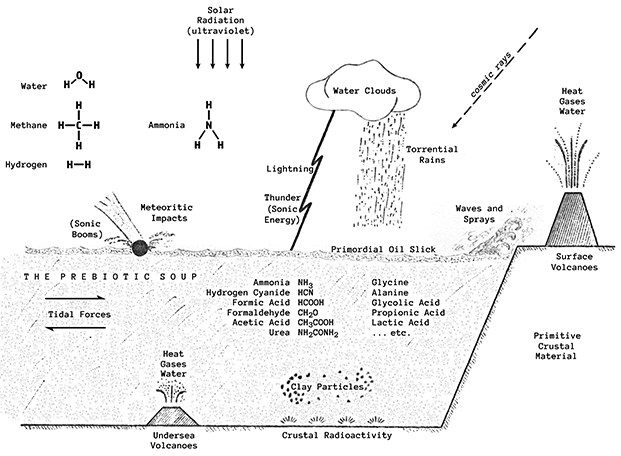 |
Of course, electrical energy was only one of the many sources of energy available on the primitive Earth (Figure 7.2)
In fact, ultraviolet radiation was probably the principle source: UV would have been able to penetrate to the surface be cause the protective ozone layer in the upper atmosphere did not yet exist.
A Miller-type experiment using ultraviolet rays and a reducing atmosphere was performed in 1957 by the German biochemists W. Groth and H. von Weyssenhoff at the University of Bonn.2307 Their results closely paralleled those obtained at the University of Chicago half a decade earlier.
|
Table 7.1 Summary of Prebiotic Synthesis Experiments through 1975 |
|
|
|
Countless prebiotic simulations have since been achieved which confirm Miller’s original conclusions. One bibliography, current through 1974, lists more than three thousand papers on the subject.1679 An exhaustive treatment of all of them is clearly beyond the scope of this book, but the interested reader in encouraged to dive into the literature (Table 7.1).
| Ultraviolet radiation |
Table 7.2 lists the sources of energy believed to be present during the first eon or so of Earth’s history. Ultraviolet radiation leads the pack. Carl Sagan and others have completed experiments with UV which seem to indicate rather high yields for prebiotic amino acids, the building blocks of proteins. Over the first billion years of chemical evolution on this world something like a hundred kilograms of amino acids per square centimeter may have been produced, resulting in a "soup" of about 1% concentration. This is the approximate consistency of chicken bouillon.
But ultraviolet radiation is a two-edged sword. While it may be the most abundant form of energy for molecule building, it is also the most destructive. Early researchers were concerned that organics would be destroyed as fast as they were created. Fortunately, the primitive oceans probably turned opaque like the brownish glop in Miller’s apparatus rather quickly. Vital chemicals newly synthesized and carried a short distance beneath the surface of the soup by convection undoubtedly escaped decomposition.
| Electrical discharge |
Of the remaining energy sources, electrical discharge was the most potent. As much as 5-15% of the carbon in a mixture of methane, ammonia and water may be converted to amino acids and other organics by the energy of the discharge. Various forms of ionizing radiation give high yields as well. a particles, b particles, and g rays were common on the surface of the primitive Earth because of the presence of intense natural radioactive sources in the crust — such as potassium-40, thorium-232, and isotopes of uranium.
| Volcanic heat and other power sources |
Volcanic heat was another prebiotic power supply.2368,2380 It has been shown that lava-heated seawater and underwater volcanoes may be effective in producing biologically important compounds. Heat and sonic energy would have been released by infalling meteorites — certainly a significant factor in the environment of the primitive solar system.1417,2375 In fact, experiments performed recently by Bar-Nun and others have conclusively demonstrated that as much as 30% of the nitrogen in an ammonia atmosphere can be converted into amino acids in this manner.315,1664,2375 Torrential rains have even been suggested as a possible source of energy for prebiotic synthesis, and experiments have shown that a flask of formaldehyde, allowed to stand for a few days at room temperature, will produce some simple sugars.
|
Table 7.2 Energy Available for Synthesis of Organic Compounds on the Primitive Earth |
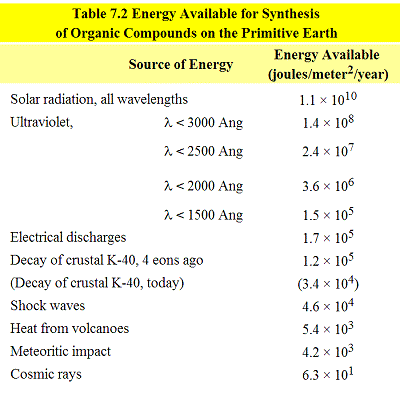 |
The great lesson appears to be that the exact nature of the power supply is relatively unimportant. Amino acids, sugars, and other chemical precursors to life probably arise on any planet possessing an initially reducing atmosphere and quantities of hydrogen, carbon, nitrogen and oxygen in gaseous reduced form — regardless of the particular source, or sources, of energy available.*
* Other factors may also be important. For instance, early-type stars (F) are more likely to emit ultraviolet radiation in copious quantities than are late-type stars (K, M). The speed of chemical evolution in primitive planetary environments may actually slow as we move from class F through classes G to K stars among habitable solar systems.
The cell is the fundamental biological unit and a common denominator among all terrestrial lifeforms. Living things on this planet are made up of cells which vary in size from less than one micron to several centimeters in diameter. While the simplest organisms are unicellular, the typical human is an ambulatory assemblage of from fifty to a hundred trillion (1014) individual cells.
|
… no biologist today would claim that proteinoid
microspheres are alive in the sense of representing the first protocell. And yet, to the extent that they self-organize, accumulate information from their surroundings, and exhibit both structure and behavior, they are certainly near the borrline of life. |
The cellular construction of Earth life is remarkably uniform: Similar water content, similar kinds of proteins, similar lipids and so forth. All have at least one membrane, perhaps no more than 100 Angstroms thick, which protects the inner workings from the harsh vagaries of the external environment. The first protobionts undoubtedly had no such complex organizational qualities.
But how can structure arise in the first place?
It has been shown by Ilya Prigogine that thermodynamic chemical systems may develop certain states wherein some of the chemical constituents have periodic, oscillating values.2230 A biologist, J. Pringle, has demonstrated that initially homogeneous systems can undergo a progressive change, leading to the appearance of "spatial heterogeneity."2231,2232 That is, structure can arise spontaneously. These two treatments of the problem of organization suggest that mechanisms may exist for collecting material into small, localized concentrations, perhaps leading to ordered structures we would recognize as cells.2368
But to build cells, we must have protein. Protein is the most fundamental construction material, used in building cell walls, enzymes, and so forth. To make proteins, there are two requirements.
- First, we need an abundance of amino acids. From our discussion above, we see that this is virtually inevitable on any normal world possessing at least small aqueous oceans and a primitive hydrogenous atmosphere.
- Second, there must be some way to hook up a long string of amino acids into a polymer of protein. Polymerization (linking together) of amino acids leads to the production of protein, which can then be used for cell-building.* It is true that even dilute primordial soups can coagulate into gelatinous masses. But such conditions are far from ideal. In all likelihood, most prebiotic syntheses probably took place in local regions of increased concentration. The efficient construction of amino acid polymers undoubtedly occurred elsewhere than in the open seas.
Numerous concentration mechanisms have been proposed which might conceivably lead to the creation of small pockets of more potent broth. The simplest method is evaporation. Primordial soup, caught in a narrow, shallow lagoon, would slowly thicken as the water that held the components in solution evaporated away.85 As suggested by Miller and Orgel, similar effects result from slowly freezing the solution in the lagoon: The solvent freezes out in the pure form first, leaving the solute concentrated in ever-smaller quantities of solvent.521
A combination of air-water and water-solid interfaces provides mechanical consolidation of suspended matter, as evidenced by the accumulation of scums and oil slicks near coastlines.1667 Another possibility is that organic compounds may have been trapped on solid surfaces such as aluminum silicate clays, quartz, and other minerals which allow polymerization reactions to proceed.1430,2381
| Proteinoid properties |
To date, however, there is really only one proven method which yields polymers of amino acids under plausible prebiotic conditions. Dr. Sidney W. Fox at the University of Miami has obtained long-chain molecules with the following essential properties:
- They contain all amino acids common in contemporary terrestrial organisms.
- They have high molecular weights (the chains are relatively long).
- They are "active" because they interact in the catalytic or rate-enhancing sense. (This anticipates metabolic activities mediated by enzymes — which are also proteins.
- They are as heterogeneous as contemporary proteins.
- They yield "organized units" upon contact with water which have many properties in common with modern cells.1625
* We will not discuss here the significance of molecular optical activity. The curious reader is referred to Sagan,20 Jackson and Moore,47 Glasstone,72 Gabel and Ponnamperuma,315 Miller and Orgel,521 Ulbricht,1445 Hochstim,1446 Bonner et al,1447 Wald,1665 and Walker.2382
|
Dr. Fox calls his substances "proteinoids," because they greatly resemble living protein polymers. His method for producing them is quite simple. A mixture of amino acids is cooked at 120-170 °C for a few hours, and substantial yields (10-40%) of polymeric material are obtained.
Fox decided to test his method under more realistic field conditions. He secured a large piece of lava from the site of an Hawaiian volcano.1702 The temperature of the rock was raised to 170 °C, and the appropriate amino acids seated in a small depression at the top. Heating continued for several hours, after which the lava was washed off with a small spray of sterilized boiling salty water — as might have occurred naturally near a volcanic shoreline in ancient times.
Proteinoid polymers were formed, but there was more! To Dr. Fox’s surprise, billions of tiny "microspheres" appeared in the wash water: spherical, microscopic particles of uniform diameter bearing a striking resemblance to living cells (Figure 7.3).
| Scenario for microsphere protocell origin |
The Miami scientist presented a scenario for the origin of microsphere protocells in prebiotic times:
- Hot lava meets soup;
- water boils away, leaving sticky brown goop on lava;
- contact with water (rain, sea spray, etc.) causes proteinoids to assemble themselves; and
- microspheres are washed back into the soup.
These initial experiments were completed nearly two decades ago,1702 and since that time Fox and his colleagues have refined their methods and perfected their theories on the origin of cells and life. Protein-like materials are now produced with molecular weights ranging from 3000 to 10,000 under plausible primitive Earth conditions.2371 And it has been shown that a primitive “cell” with most of the attributes of life can arise spontaneously in a very brief period of time.
Detailed studies of microspheres have confirmed the researchers’ initial optimism. What makes these spherules so unique is their “active” nature. Dr. Fox has observed and recorded the following characteristic behavior of his proteinoid microspheres under various chemical and physical conditions:
- Spherical shape — 0.5 to 7.0 microns, uniformly.
- Single-walled membranes (like plants) and double-walled membranes (like animals).
- Simulation of osmosis — microspheres swell and shrink in response to changes in the chemical environment.
- Selectivity of diffusion — microspheres possess semipermeable membranes analogous to those of living cells. For instance, in one case Fox discovered that polysaccharides were selectively retained under conditions in which monosaccharides diffused freely through the microsphere walls. (Polynucleotides and other organics are also absorbed from aqueous solution.1624)
- Cleavage — a kind of binary fission of a single “cell” has been observed in acidic proteinoid microspheres.
- Motility — the microspheres, when viewed under a microscope, move non-randomly in preferred directions under certain special conditions. The addition of ATP appears to enhance the movement.
- Budding — buds appear spontaneously on proteinoid microspheres allowed to stand undisturbed in their mother liquor.
- Growth by accretion — buds which have been liberated by mild heating or electric shock will swell by diffusion to the same approximate size as the “parent” cell.
- Proliferation through budding — second generation budding has frequently been observed on buds that grew to the size of normal microspheres. The buds are apparently engaging in a kind of “reproduction.”
- Formation of junctions — microspheres are capable of approaching one another and physically attaching together in a more or less permanent fashion.
- Transmission of information — when two spheres have joined, small proteinoid microparticles within the larger sphere are observed to pass through the junctions. The whole process is highly suggestive of microbial conjugation.
- Stability — the activity of the proteinoids does not diminish with storage over a period of 5-10 years.2370
The best-known of all physical cell models prior to the discovery of proteinoids was the coacervates, thoroughly researched by the Soviet biochemist A. I. Oparin, the Dutch biochemist H. G. B. de Jong, and others. Coacervates are produced by combining solutions of oppositely charged colloids such as gelatin or histone with gum arabic. When solutions of the two substances are commingled, they interact to yield clusters of microscopic structures having the appearance of tiny liquid droplets. Coacervates have many interesting properties from the point of view of the origin of life.
For instance, after these uniform spherules have aggregated, they are able to absorb various simple organic molecules from the external medium (sugars, dyes, etc.). However, Oparin has admitted that this process quickly leads to static equilibrium, and the coacervate "protocell" then becomes a passive system, unstable and prone to break-up upon standing. Another property of coacervates is their ability to convert certain chemical monomers to polymers after diffusion through the "cell" wall, although it is generally recognized that the dynamic behavior of these droplets is fairly limited.
There is another reason why coacervates,1432 sulphobes,1625 "biphasic vesicles,"1630 and many other prospective pseudocells1211,1415 do not compare favorably with Dr. Sidney Fox’s microspheres as model protocells. Coacervate droplets are formed from polymers which themselves were synthesized by living organisms. The gum arabic used to manufacture Oparin’s droplets was not produced abiogenetically, nor is it at all clear how this might be done. The great advantage of the microspheres is that they are the direct product of single, simple amino acids — amino acids that must have been common on the shores and seas of the primitive Earth eons ago.
Of course, no biologist today would claim that proteinoid microspheres are alive in the sense of representing the first protocell. And yet, to the extent that they self-organize, accumulate information from their surroundings, and exhibit both structure and behavior, they are certainly near the borderline of life.
|
|
… the development of molecular DNA – the primary information- |
In the previous section it was mentioned that there are two requirements for the production of proteins. First, there must be amino acids, and second, there must be a way to hook them together to form polymers.
There is, however, a third requirement for the origin of living systems on Earth. It will be recalled from the discussion of the definition of life that "it is the business of life to accumulate information and complexity." Let us consider this mandate in view of the problem of building proteins.
To abiogenetically produce a living system, that system must be capable of accumulating information and order from its environment. The proteins constructed by a cell must have the proper architecture for whatever job needs to be done. So our third requirement may be stated: There must be a way to hook the amino acids together in the correct sequence. Any old proteins will not do — they must be the right ones.
| Autocatalysis |
There exist simple chemical techniques to achieve this kind of ordering. One common example is called "autocatalysis" by chemists. Autocatalysis is a way for a process to catalyze its own production. Once a tiny bit of it has been produced, that bit catalyses the rate of reaction to yield still more, and faster.
Aside from this simple selective feedback effect, the development of molecular self-replication was probably the most critical single event in the origin of life on Earth. The origin of replication and the genetic code, as opposed to the origin of proteins and cells, allowed natural selection to begin to operate on stored information. And once evolution begins, selective advantages of superior membranes and of multicellular colonies can be expressed in the form of increased organismal complexity.
DNA — the primary information-carrying molecule used by all lifeforms on this planet — is a polymeric nucleic acid (Figure 7.4). We’ve already seen how easy it is to get amino acids and their polymers. But what about nucleic acids? Can they be demonstrated in prebiotic synthesis experiments, along with their polymers?
|
Prebiotic assembly of purines and
pyrimidines into full-fledged nucleotides has proven more difficult, … The main obstacle to success seems to be the formidable complexity of the nucleotide molecules themselves. |
In 1963, Dr. Cyril Ponnamperuma managed to synthesize adenine (one of the two most important nucleic acid purine bases) under simulated primitive Earth conditions. The NASA scientist and his three colleagues used a Miller-type apparatus, and began their synthesis with nothing more than methane, ammonia and water in the system. The mixture was bombarded with energetic electrons, and about 0.01% of the carbon in the methane was converted into adenine.304 This is highly significant because adenine is useful, not only for making DNA, but also RNA, ATP, ADP, FAD, and a host of other critical life-molecules.
In a related experiment two years later, Dr. John Oró of the University of Houston and A. P. Kimball produced adenine is a closed reaction system which included ammonia, water, and hydrogen cyanide. Heat was supplied as the energy source, and this time the production of the purine base rose to 0.5% of the available carbon.303 This value was observed over a wide range of chemical conditions, indicating the relative ease with which this complex molecule must arise in a plausible prebiotic environment. The synthesis of the other important purine, guanine, has also been convincingly demonstrated.
There have been various attempts to fabricate the three major varieties of pyrimidine bases which are also necessary in the production of nucleic acids. However, the appearance of these substances under conditions similar to the primitive Earth has not been investigated as thoroughly as the purines.
One experiment that yields a hefty 20% of cytosine requires a three-step process involving methane and nitrogen initially to create a cyanoacetylene intermediate, which then goes on to produce the pyrimidine when combined with cyanate ion. Uracil, another pyrimidine, is obtained in very good yield by the direct hydrolysis of cytosine — a prebiotically reasonable reaction. All the pyrimidines have been synthesized in environments at least arguably analogous to that of the early Earth.
Prebiotic assembly of purines and pyrimidines into full-fledged nucleotides has proven more difficult, and intensive investigations are now underway to determine and eliminate the problem. The main obstacle to success seems to be the formidable complexity of the nucleotide molecules themselves. While bases and sugars are relatively easy to produce, combining them together is a much harder task.
Nevertheless, demonstrations of nucleotide synthesis under geologically plausible constraints have been made. One such technique involves the use of a mediating mineral called apatite, which contains phosphates and oxalate ion, in an "evaporating pond" scenario.
|
Purines and pyrimidines are comparatively
simple to manufacture abiogenetically. The assembly of nucleotides has also met with some imited success, but to date it has proven difficult to synthesize more than six-unit polymeric chains in a prebiotically plausible way. |
We are not quite home yet. Just as amino acids needed polymerization to become protein, so must nucleotides by polymerized into DNA. What progress has been made in the prebiotic synthesis of polynucleotides?
The experimental record is admittedly spotty. When adenine nucleotides were heated in the presence of polyphosphate for 18 hours at 55 °C, adenine polynucleotide polymers were obtained ranging from 20-30 nucleotides per chain. However, in the words of the experimenter, "the concentration of the reactants had to be as high as possible when the formation of high polymeric material was desired."1625
That is, unless quite artificial conditions were contrived, the adenine nucleotides could not be forged into very long chains. In another experiment, solutions of adenine nucleotide were irradiated with UV light. Long chains were again obtained, but only when extraordinarily high concentrations of polyphosphate were maintained.1628 Under similarly unrealistic conditions, uracil polynucleotides with chain lengths ranging from 10-50 units have been found.1626,1627
One good experiment has been performed by John Oró and E. Stephen-Sherwood, using a plausible "evaporating lakebed" scenario and temperatures from 60-80 °C. Uracil two-unit chains were formed with a yield of 23%, and three-unit segments with a 12% yield. Cytosine polynucleotide chains were obtained by these experimenters with up to six nucleotides in straight-line linkages. Thymine polynucleotides 2-12 units long were produced when an unreasonable chemical environment was used; with more closely matched prebiotic conditions, five-unit chains were obtained in yields of 1% or less.1429
The polymerization of some nucleotides has proven unexpectedly difficult, partly because of the inevitable formation of unnatural side chains and partly because the reaction just doesn’t seem to want to go. Various solutions to these problems have been suggested. For instance, there are enzymes — ordinary proteins — that are capable of catalyzing these polymerization reactions with ease. These enzymes, or enzymes like them, could have arisen by nonbiological means. If this is the case, claims one researcher, "such catalysts may have been responsible for the first polymerization of nucleotides on the primitive Earth."72
So at present, here is where we stand. Purines and pyrimidines are comparatively simple to manufacture abiogenetically. The assembly of nucleotides has also met with some limited success, but to date it has proven difficult to synthesize more than six-unit polymeric chains in a prebiotically plausible way.2370
Can these short strands alone make a stab at primitive replication? Dr. Leslie Orgel at the Salk Institute in San Diego, California, mixed up a solution of nucleic acids that might be considered prebiotically reasonable. He then placed some of the six-nucleotide polymers in his specially-enriched "soup." The short-chain DNA polymers correctly replicated themselves once out of every ten tries.
|
Q. How did Life arise? A. No one knows. |
Thus far we have concentrated on the parallel development of polymeric amino acids (proteins) and polymeric nucleotides (DNA). We’ve seen that Dr. Sidney Fox’s proteinoid microspheres exhibit many properties which are strikingly similar to those displayed by contemporary living cells. We’ve also seen that Dr. Leslie Orgel has succeeded in demonstrating accurate, if erratic, replication in primitive polynucleotides. And yet, despite these remarkable achievements, the great final question remains untackled: How and when did the first living organism arise?*(see note on Tab# 5)
|
It has been fairly clearly demonstrated
that life as we know it could not have arisen if either one or the other [proteins or nucleic acids] was wholly absent. |
The answer is as unsatisfying as it is precise: No one knows. The arguments on this score smack of the "chicken-or-the-egg" controversy. It is unknown at present if proteins and protocells came first, to be followed later by replicative nucleic acids, or whether the nucleic acids were first, and from them the cells later spawned.
It has been fairly clearly demonstrated that life as we know it could not have arisen if either one or the other was wholly absent.521 Organisms lacking nucleic acids would have no means of achieving genetic continuity and evolutionary progression, while organisms without proteins would find themselves severely limited in their ability to utilize the chemicals in their environment. Some manner of coevolution seems to be indicated.
 |
One theory holds that nucleic acids evolved some kind of boundary layer, a proteinous skin to protect themselves from their surroundings — the so-called "naked gene" theory. When this invention inhibited or prevented reproduction, the parent nucleic acid molecule became extinct. When the new boundary layer served to protect the DNA without interfering with replication, these were the "protobionts" which survived.
There is some experimental evidence to support the view that polynucleotides might be able to influence protein synthesis directly.1431,2255 To do this, they must cause a selective linear organization of amino acids, and must facilitate amino acid polymerization.1444 Unfortunately, other studies have shown that the interaction between polynucleotides with individual (monomeric) amino acids is relatively weak.1248
|
Most valid evolutionary sequence: From the simple to the more complex |
More convincing, perhaps, is the idea that cells were first. Self-assembly in molecular structures has been known for many decades, and experimental evidence to date favors the easy synthesis of proteins in comparison to polynucleotides.1634 Sidney Fox has remarked that the sequence:
- protoprotein → protocell → nucleic-acid-coded contemporary cell
is the most valid evolutionary sequence because it proceeds from the simple to the more complex.1625
The primitive protocell, as modeled by the proteinoid microspheres, could have exhibited many of the properties customarily regarded as belonging only to "living" things. Under Fox’s theory, the cell would have developed nucleic acids to serve its ends, rather than the other way around.
One final piece of evidence seems to argue for the primacy of cells. In 1974, Dr. Fox and his colleagues published some experimental findings on micro-spheres which seem to imply that the proteinoid protocell can do everything optimistically predicted for it. The abstract of the paper reads, in part:
roteinoid microspheres of appropriate sorts promote the conversion of ATP to adenine dinucleotide and adenine trinucleotide. When viewed in a context with the origin and properties of proteinoid microspheres, these results model the origin from a protocell of a more contemporary type of cell able to synthesize its own polyamino acids and polynucleotides.1435 (emphasis added)
|
[Life is] an obligatory result
of the general growth of the universe. |
We’ve seen that scientists have discovered a relatively smooth chain of synthesis from the stuff of stars to the stuff of life. On the basis of pre biotic experiments performed to date, it is probable that most of the organic molecules of life with a molecular weight less than 1000 spontaneously appeared in significant quantities during the early years of our world. While a number of problems remain, most indications are that the origin and development of life on Earth had a certain inevitability about it.
From the simplest compounds present when our planet first congealed about 4.6 eons ago, to the first viable protobiont some half a billion years later, the patterns of development and the upward march of complexity seem unavoidable. Only the most general conditions must be needed for carbon-based life to arise: A body of water, a primitive reducing atmosphere, some source of energy, and lots of time. Life, in Soviet Academician Oparin’s own words, is "an obligatory result of the general growth of the universe."2297
Even now we humans just begin to suspect the truth: The universe is not ours alone to keep.
There are countless side issues that cry out to be discussed at this point, but which unfortunately can be given only a passing nod. First of all, there is the absolutely fascinating question of the genetic code. As is well-known, genetic information is written on the DNA strand in short, three-nucleotide "words" called codons. By properly reading these encoded blueprints, a cell can construct exactly the right protein molecules.
| The series of adenine nucleotides in a codon |
For instance, a series of three adenine nucleotides in a codon tells the cellular machinery to use one molecule of an amino acid called lysine at that location. Three guanines in a row means that a molecule of the amino acid glycine should be used. One by one, the codons tell which amino acid to use and in what order, and proteins are built up in precisely the right way.
What is the origin of this marvelous code?1064,1444,2383 Is a three-nucleotide codon somehow optimal,1777 or would four have been more evolutionarily efficient?1064,1066 Why not the simplicity of only two? And what determined the rules of the coding itself? Three guanines mean glycine to a virus, a dandelion, or a human. Is the code somehow efficiency-maximized or error-minimized?1065 (It appears to be!1066,2378)
| Origin of chromosomes / purpose of genes / methods for storage of genetic information< |
What is the origin of chromosomes,2301 and the true purpose of genes?2322 These are important questions for xenobiologists to be asking, because the universality of our genetic mechanisms will determine the limits of variation that can be expected in alien biochemistries.
For xenologists, of course, there are far more fundamental issues that must be raised. For example, why must genetic information be stored digitally in a linear sequence of monomer units? Could not some form of analog system serve? What of the possibility of genetic systems whose information was stored, replicated and transcribed in a planar fashion rather than linearly?1777
|
… on Earth, DNA is used for "replication" and
proteins are used solely for "expression" or "action." |
Dr. Francis Crick has pointed out that on Earth, DNA is used for "replication" and proteins are used solely for "expression" or "action." Is it possible, he asks, "to devise a system in which one molecule does both jobs, or are there perhaps strong arguments, from systems analysis, which might suggest that to divide the job into two gives a great advantage?"22 Others have echoed this idea.521
| Necessity for genotype distinct from a phenotype? |
Similarly, Michael Arbib of the University of Massachusetts at Amherst questions "whether it is necessary for any lifeform to have a genotype distinct from a phenotype; in other words, whether we have to have a program to direct growth and change, or whether in fact the organism might be able to reproduce itself as a whole."85 Crick seems to agree,, suggesting that it might be possible to "design a system which was based on the inheritance of acquired characteristics."22 (At least one science fiction story has been written along these lines.2216) Arbib also wonders: "One might imagine some planet whose beings reproduce by xerography with no gene required!"85 The possibility of inheritance without genes has been suggested before,1178 although in a different context. (A general review of replication was published in 2004 by Freitas amd Merkle.)
| Nucleic acid chauvinism |
And we must take care not to be guilty of "nucleic acid chauvinism." We are familiar with only one molecular replicating system, but there is no reason why others should not be possible. Gordon Allen writes: "Life on other planets need not be based on nucleic acids or proteins if their catalytic functions can be otherwise provided."1591
Dr. Alexander Rich at MIT also suspects that the functions of Earthly nucleic acid are not unique. Rich believes that "other molecules could be used to form other polymers which could be used as information carriers for living systems." Later, he elaborates:
I think it would be amusing to make a chemical system of complementary polymers based on monomers that are not nucleic acid derivatives, simply to demonstrate that it can be done. In about ten years’ time, I think we will have a well-developed field of synthetic polymeric information carriers that will give us a great deal of insight into our own terrestrial system. That another system is possible might have relevance, if not to biology on this planet then perhaps to another.1587,1632
Clearly, a search should be made for non-nucleic acid self-replicating molecules. Exotic systems based on silicon, boron, or nitrogen-phosphorus chemistries are possible: Specialists in these fields expect an abundance of compounds comparable to that of carbon chemistry.1777 But we must not anticipate the subject matter of the next chapter.
 |
In the previous (chapter), we asked the question: What is the likelihood that life may evolve somewhere else in the universe? We answered by showing that, given a primitive environment similar to that of ancient Earth, some form of proteinous life is not unreasonable.
But how deterministic are the processes that occurred on this planet four eons ago? What are the chances that life must follow the identical biochemical pathways taken by organisms on Earth? It is the principle aim of xenobiology to ascertain where life exists in the universe, and what form it takes.
At first glance, the Hypothesis of Mediocrity might seem to rule out the possibility of alternative life biochemistries. There are no silicon beasts or chlorine-breathers present on this world, ergo natural selection does not favor them and they cannot exist.
This is, however, an incredibly chauvinistic argument. The only rigorous conclusion that can be drawn from the lack of exotic biochemistries on Earth is that contemporary conditions do not favor those other systems. Since a rich diversity of habitats is possible in the Galaxy, peculiar life chemistries cannot be categorically ruled out.
| Life adapts itself to its environment |
Life adapts it self to its environment. Change the environment, and the nature of life itself will change. It may be that no negentropic life-system can arise spontaneously under non-Earthlike conditions, but it is poor science to tie one’s hands with this assumption from the outset. Owing to the unique adaptivity of living things, the Hypothesis of Mediocrity must be applied cautiously when we venture out into new environs.
Experimental investigations have brought to light new facts which appear to indicate that significant variations on terran biochemistry are possible — even probable — on other planets.
[Note: See also the author's article "Xenobiology", published in 1981.]
|
|
|
The word chauvinism is derived from the cognomen of a highly jingoistic French soldier by the name of Nicolas Chauvin, born at Rochefort in the late 18th century. In 1815 Chauvin gained great notoriety by his obstinate, bellicose attachment to the lost cause of Napoleon’s crumbling imperium. The term has since become identified with the absurd, unreasoning, single-minded devotion to one’s own race, nationality, sex, or, most recently, to one’s own point of view.
| Solar chauvinism |
Chauvinisms are predictably common in xenology. For example, we have argued against what might be called "G-star chauvinism," the idea that a home sun exactly like Sol is a prerequisite for life.15 Although our sun is class G, F stars and K stars undoubtedly are also hospitable to life. But stars may not be necessary at all. The possibility exists that interstellar space may contain a large number of starless planets, objects having jovian or superjovian mass. Neglecting such an alternative could be condemned as "solar chauvinism."1470
| Planetary chauvinis |
There have been discussions of "planetary chauvinism," the belief that life can only exist on the surface of planets. Fred Hoyle exposes this parochialism in his science fiction novel The Black Cloud. After humans manage to open a communications link with the gaseous lifeform, the interstellar electromorph is quite astonished. "Your first transmission," says the Cloud, "came as a surprise, for it is most unusual to find animals with technical skills inhabiting planets — which are in the nature of extreme outposts of life."62
| Atmospheric chauvinism |
And atmospheric chauvinism? Carl Sagan has imagined organisms trapped on a planet whose air is slowly leaking away to space. Over time, such creatures might evolve mechanisms to cope with what is essentially an interstellar environment.15 Another possibility might be an advanced spacefaring civilization that had set up outposts in deep space or on airless worlds.
| Biochauvinisms |
There are many biochauvinisms in xenology, various preconceptions relating to indigenous alien lifeforms. For instance, one biochauvinism this author finds exceedingly difficult to overcome is "phase separation chauvinism."2371,2393 The requirement that all organisms must retain some sort of boundary layer between themselves and their surroundings seems to follow directly from the basic thermodynamic nature of life processes.
|
The extremes of life on Earth are well documented;
microorganisms are especially hardy. |
Other things seem not so fundamental. The extremes of life on Earth are well documented; microorganisms are especially hardy.
Acontium velatum and Thiobacillus thiooxidans flourish in some of the strongest acids known (pH = 0.0), while a blue-green algae known as Plectonema nostocorum thrives in the strongest bases (pH =13.0). (Normal water is neutral, with pH = 7.0).
Microbes can tolerate poisons of many kinds in their environment, such as corrosive sublimate (mercuric chloride), sulfuric acid, and arsenic. The tardigrades can stand prolonged periods of virtually complete desiccation,* and organisms have survived pressures ranging from the vacuum of space to more than 8000 atm (the barotolerant deep sea bacteria).
Growth and reproduction have been demonstrated from -24 °C (psychrophilic bacteria) up to 104 °C, and a few organisms (tardigrades, spores) have been frozen to near absolute zero, or heated to more than 120 °C, and survived the ordeal.
Radiation resistance is low in mammals and other higher lifeforms — whole body lethal dose for man is a few hundred roentgens. But Deinococcus radiodurans and certain algae have endured as much as ten million roentgens of neutron bombardment, owing in part to special protective chemicals contained within their cells. Ultraviolet chauvinists claim that life is impossible on Mars because of the intense, unshielded solar radiation (UV) there, but many protective adaptations readily can be imagined.15,26,1238
| Oxygen chauvinism |
Perhaps one of the most persistent biochauvinisms is "oxygen chauvinism." A few decades ago, before the matter was given the serious thought it deserves, it was alleged that any planet lacking this "vital" gas was ipso facto uninhabitable. However, O2 is not a requirement for survival for many organisms alive on Earth today (e.g., yeasts, tetanus bacillus, etc.) and was not present in appreciable quantities on the primitive Earth when the origin of life occurred.
|
Oxygen needs life, rather than
the other way around |
It has been shown that the present level of O2 is not optimal for plant growth. Greenery evidently grows more luxuriantly in an atmosphere containing only about half the normal amount of oxygen.53 Human scuba divers are poisoned by the pure gas at more than a couple atmospheres of pressure. The presence of O2 in the nuclear regions of contemporary living cells is usually fatal.
Oxygen is basically a reactive, toxic gas which chemically combines with and degrades virtually all useful biomaterials. The disastrous and widespread contamination of Earth’s atmosphere with O2 a few eons ago (the first real "smog crisis") might have spelled the end of life on this world had nature not been able to quickly readjust to the new situation. It is as Arthur Clarke says: "Oxygen needs life," rather than the other way around.609
The mere absence of oxygen on a planet cannot, by itself, argue against the presence of life there.
* The kangaroo rat, a common resident of American deserts, never needs to drink water. Its metabolism breaks down chemical compounds in sufficient quantities to enable it to live on the water manufactured from the food it eats. Other animals, such as the flour beetle, are known to have similar abilities, and camels can sustain themselves for weeks in this fashion. In the plant world, the Spanish moss can grow without contact with any groundwater — when humidity is high, it can extract the needed moisture directly from the air.
|
The liquid phase is probably
the preferred mode of existence for extraterrestrial lifeforms. |
Perhaps a more general biochemical question is whether or not the chemistry of life must occur in the liquid state. Most biologists would probably insist on a liquid solvent.
But life in the gaseous state cannot categorically be ruled out. One can imagine a "soap-bubble beast," laced with innumerable compartments and sub-compartments throughout. Probably a creature of the air, its metabolism might consist of chemical redox reactions taking place within its many "cells" in a controlled manner with the reaction products slowly diffusing outward. Because of the lower concentration of chemicals in such a gaseous medium, the organism’s structure, complexity, size and behavior would be sharply limited.
Solid life, too, is not out of the question. Although it has been alleged that reaction rates would be too slow for such lifeforms to exist, we know that timescales are relative and highly subjective. Trees often take hundreds of years to grow to full maturity, and many are thousands of years old. There is nothing a priori absurd in positing a form of life which has extremely slow negentropic processes.
Of course, it must be admitted that the liquid phase seems rather more convenient than the solid, gaseous or plasmic phases. Ions form easily, transport is greatly simplified, the breakup and recombination of chemical bonds is facilitated, and crude environmental stability is assured. The liquid phase is probably the preferred mode of existence for extraterrestrial lifeforms.
|
||
|
Any life chemistry will inevitably be subject to a narrow, or at least specific, temperature range. This is because a successful biochemistry is based on large assemblages of complex, delicately balanced molecules. These molecules must walk the thin line between overstability and overreactivity. Too cold, and the system grows sluggish and grinds to a halt; too hot, and reactions become uncontrollably rapid and the metabolism destabilizes.
The dedicated temperature chauvinist wants to restrict the viable range of all lifeforms to less than 100 °C, hardly enough to cover the gamut of terrestrial organisms alone. More sophisticated arguments suggest that even unfamiliar carbon-based systems probably could not exist much above 500 °C, because large carbon macromolecules shake themselves to pieces long before things get even that hot.
At the cold end of the scale, carbon-based biochemistries may be much less successful below about -100 °C. Reaction rates become extremely low, and there are fewer and fewer solvents in which the life-chemistry may proceed.
But are these valid limits for all conceivable living systems?
Perhaps not.* Table 8.1 gives the energy of various chemical bonds that might possibly occur in biologically significant molecules. If a structure is given more than this energy, the bonds may snap and the molecule falls apart. The higher the bond energy, the more stable the molecular structure. And stability is essential for any chemistry that aspires to live.
Carl Sagan suggests that for life to exist, the fraction of bonds disrupted due to random thermal motions must be no larger than 0.0001%. If this is true, then lifeforms whose biochemistry is based solely on van der Waals forces (a weak attraction between atomic electrons and the nucleus of an adjacent atom) alone could survive at temperatures as high as 40 K. Biochemistries relying on hydrogen bonds alone could exist up to 400 K. Bonds of strength 2.0 eV or higher would suffer less than 0.0001% random breakage up to 2000 K, and for 5 eV bonds the molecules survive up to 5000 K.2358
This spans the range of temperatures from the coldest worlds to the surfaces of stars. Concludes Dr. Sagan: "There seem to exist chemical bonds of appropriate structural stability for life, and it would appear premature to exclude the possibility of life on any planet on grounds of temperature."
* Hal Clement’s two science fiction novels, Mission of Gravity (low temperature life)2069 and Iceworld (high temperature life),292 are highly entertaining.
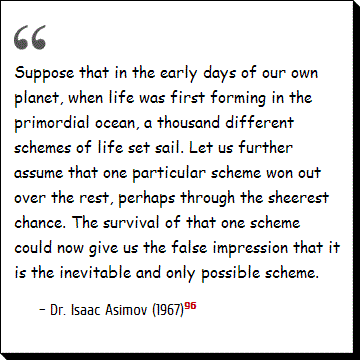 |
Professor G.C. Pimentel, chairman of a NASA Study Group on Exobiology in 1966, remarked that perhaps the most interesting and important discovery that could ever be made in the entire field of xenobiology would be the detection of extraterrestrial lifeforms based on a chemistry radically different from our own. Space probe experiments designed solely to search for Earthlike organisms cannot firmly rule out the possible presence of life solely on the basis of a negative result. Cautions Pimentel, we must beware of the hazards of "down-to-earth thinking."2353
Yet all living creatures with whom we are acquainted are comprised of complex carbon compounds immersed in liquid water. Two classes of molecules always seem to be present: Nucleic acids, the blueprints of inherited instructions, and proteins, the materials and tools with which the architecture of life is constructed.
Must life always be based on carbon chemistry in aqueous solution? If we can agree that a biochemistry is the proper format for living systems, and that a liquid phase is probably essential, does it follow that carbon and water are our only choices in the matter?
|
|
|
| Water: ideal for our kind of life |
Carbon chemistry in terrestrial organisms proceeds by chemical reactions in the medium of water — an amazing substance with a whole set of properties which make it ideal for our kind of life. Some have even contended that "water is the only possible candidate material."
In 1913, Harvard University biochemist Lawrence J. Henderson published a little book entitled The Fitness of the Environment in which he assembled for the first time the many points in favor of water as a life-fluid.879 Henderson’s analysis extends to the other molecules of life as well, and his main contribution is to show that the very chemical properties of the elements gives each of them a certain unique status and irreplaceability.
| Excellent solvent |
Among the many advantages of water, Henderson notes that it is an excellent solvent for countless substances, making it quite useful as a mediator of chemical activity in the liquid phase. Water, too, is an ionizing solvent, which means that an acid-base chemistry is permitted and an ever wider range of reactions can take place. (Acid-base chemistry is fundamental to Earth life but is not necessarily a requirement for all life.1074)
| High heat capacity |
Hydrogen bonding between water molecules gives the liquid a high heat capacity — the ability to store lots of heat without changing temperature very much. Organisms which use water are thus at a distinct advantage in an environment in which sudden swings between hot and cold are common. This same bonding force also holds biomolecules together so that reaction rates are enhanced64 (although it has been pointed out that H-bonding may not be absolutely essential for life2353).
| Wide liquidity range |
Furthermore, water has a comfortably wide liquidity range — a full 100 K under normal terrestrial conditions. However, the extent to which this temperature span may be broadened is not generally appreciated. Saturated salt water may freeze as low as 250 K; under 100-200 atm of pressure, the boiling point may be elevated to as much as 640 K.
In the proper environment, water could remain a liquid over a range of 400 degrees. It is not unreasonable to conclude that H2O may well be the solvent of choice from 250-500 K, particularly in view of its extremely high cosmic abundance.
Serious laboratory work aimed at defining and measuring the limits of carbon-based, aqueous biochemistries has just gotten under way in earnest in the 1970s. Consequently, direct evidence is only beginning to emerge from the scanty data.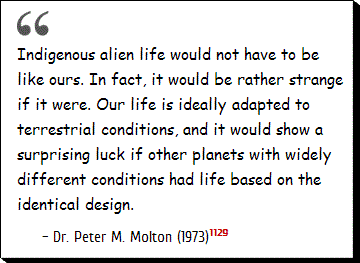
| Alternatives within a carbon-water system |
In spite of this handicap, there are early signs that many alternatives are possible even within the confines of a carbon-water system.
Dr. Peter M. Molton at the University of Maryland has suggested that simple changes in the early prebiotic environment may drastically affect the chemical species which later turn up as the dominant actors on the biochemical stage of evolution.1094 His example is drawn from Miller-type experiments involving the prebiotic synthesis of amino acids, the building blocks of proteins.
| Two forms taken by amino acids: alpha and beta |
In the lab, chemists have learned that there are two common structural forms taken by amino acids. They are called alpha and beta.
The basic layout of an amino acid molecule is a chain of carbon atoms with a small -NH2 ("amino group") stuck on somewhere. In the alpha form, the amino group appears near the tail end of the molecule. In the beta form, the amino group is displaced more towards the front of the chain.
|
All amino acids used in terrestrial biochemistry,
with one minor exception, are of the alpha variety. The beta forms are absent. Why? |
All amino acids used in terrestrial biochemistry, with one minor exception, are of the alpha variety. The beta forms are absent. Why?
Molton shows that this peculiarity may be due to nothing more complicated than the order in which water is introduced during the early stages of chemical evolution. If H2O enters into the prebiotic reactions when the first simple compounds are being synthesized, then life will evolve with proteins consisting exclusively of alpha amino acids.
This was probably the situation on the primitive Earth, eons ago.
But what if the initial products of chemical evolution never come into contact with water at all in the early stages? According to Molton, when water is thus absent the beta amino acids will predominate. The proteins comprising the resulting extraterrestrial lifeforms would then be of the beta, rather than the alpha, variety.*
The next step, says Molton, is to try to synthesize plausible alternative nucleotides in the laboratory, simply by altering the prebiotic conditions under which they arise. Scientists are just beginning to see the myriad possibilities that may be open to carbon-water biochemistry on other worlds.
* Proteins made from the beta forms would probably not be edible by humans. Indeed, they might even be poisonous — a fact of considerable importance for future interstellar astronauts and colonists.
|
Figure 8.1 "Ammonia! Ammonia!"(from Bracewell80) |
 |
Can living processes be based on a liquid other than water (Figure 8.1)? To answer this question we must address a more fundamental problem: What are the properties of a good solvent for life?
- First of all is availability. If the substance is exceedingly rare, there will not be enough of it around to sustain an ecology.
- Next, it should be a good solvent for both inorganic and organic compounds, and in this regard an acid-base chemistry is highly desirable.
- Further, the fluid ought to have a reasonably large liquidity range, so that organisms will enjoy a wide span of temperatures in which they remain biochemically operational.
- A high dielectric constant is preferable — the liquid medium should provide adequate electrical insulation from the surroundings.
- Also, a large specific heat would be nice, because this would give the organism thermal stability in the face of sudden or extreme temperature variations in the environment.
- Finally, the solvent ought to have a low viscosity — it should not be too thick and resistant to flow (not an essential characteristic but certainly convenient).
J.B.S. Haldane, speaking at the Symposium on the Origin of Life in 1954, speculated on the possible nature of life based on a solvent of liquid ammonia.2328 The British astronomer V. Axel Firsoff picked up on this a few years later, and extended the analysis considerably.352,1217 Today, ammonia is considered one of the leading alternatives to water. Let’s see why.
Ammonia is known to exist in the atmospheres of all the gas giant planets in our solar system, and was plentiful on Earth during the first eon of its existence. Ammonia may be a reasonable thalassogen, so it should be available in sufficient quantities for use as a life-fluid on other worlds.
Chemically, liquid ammonia is an unusually close analogue of water. There is a whole system of organic and inorganic chemistry that takes place in ammono, instead of aqueous, solution.1579,1584
Ammonia has the further advantage of dissolving most organics as well as or better than water,2345 and it has the unprecedented ability to dissolve many elemental metallic substances directly into solution — such as sodium, magnesium, aluminum, and several others. Iodine, sulfur, selenium and phosphorus are also somewhat soluble with minimal reaction. Each of these elements is important to life chemistry and the pathways of prebiotic synthesis.
The objection is often heard that the liquidity range of liquid NH3 — 44° C at 1 atm pressure — is a trifle low for comfortable existence. But as with water, raising the planetary surface pressure broadens the liquidity range. At only 60 atm, far less than Jupiter or Venus in our solar system, ammonia boils at 98 °C instead of -33 °C. ("Ammonia life" is not necessarily "low temperature life.") So at 60 atm the liquidity range has climbed to 175 °C, which should be ample for life.
|
Table 8.2 Acid-Base Reactions for Ammonia-based Life |
 |
|
As a solvent for life,
ammonia cannot be considered inferior to water. |
Ammonia has a dielectric constant about ¼ that of water, so it is a much poorer insulator than H2O. But ammonia’s heat of fusion is higher, so it is relatively harder to freeze at the melting point.* The specific heat of NH3 is slightly greater than that of water, and it is far less viscous (it is freer-flowing too).
The acid-base chemistry of liquid ammonia has been studied extensively throughout this century, and it has proven to be almost as rich in detail as that of the water system (Table 8.2).
The differences between the two are more of degree than of kind. As a solvent for life, ammonia cannot be considered inferior to water.
|
Water: Has the virtually unique property of expanding upon freezing |
* The point is sometimes made that water has the virtually unique property of expanding upon freezing, which means that ice will float atop a cooling mass of water and protect the lifeforms beneath. However, water freezing within the cells of living tissue exposes the organism to a new hazard — mechanical damage by expansion. Since ammonia shrinks when it freezes, the very property responsible for massive oceanic freeze-ups should also allow ammono lifeforms to be much more successful hibernators in a frozen clime.
|
Table 8.3 Dissociation of the Vital Solvent1217 |

In the ammonia system, water, which rests with liquid NH3 to yield NH4+ ion, would seem as a strong acid, quite hostile to life. Ammono-life astronomers, eyeing our planet from their chilly observatories, would doubtless view the beautiful, rolling blue oceans of Earth as little more than "vats of hot acid."
|
Compelling analogues to the macromolecules of Earthly life may be designed in the ammonia system.
But Firsoff has urged restraint: An ammonia-based biochemistry might well develop along wholly different lines. There are probably as many different possibilities in carbon-ammonia as in carbon-water systems.1172
The vital solvent of a living organism should be capable of dissociating into anions (negative ions) and cations (positive ions), which permits acid-base reactions to occur (Table 8.3).
In the NH3 solvent system, acids and bases are different than in the water system-acidity and basicity, of course, are defined relative to the medium in which they are dissolved.
|
Figure 8.2 Living in Liquid Ammonia |
 |
After all, water and ammonia are not chemically identical. They are simply analogous. There will necessarily be many differences in the biochemical particulars.
Molton has suggested, for example, that ammonia-based lifeforms may use cesium and rubidium chlorides to regulate the electrical potential of cell membranes. These salts are more soluble in liquid NH3 than the potassium or sodium salts used by Earth life.1132
Dr. Molton concludes: Life based on ammonia instead of water is certainly possible (Figure 8.2), theoretically, at the superficial level.
If we delve further into the complex biochemistry of the cell, we could find some insuperable barrier to ammonia-based life — but it is hard to conceive of any obstacle so insuperable that it would rule it out altogether.
|
Table 8.4 Physical Constants for Xenobiochemical Solvents352,879,1578,2082 |
  |
There are many other life-solvents (Table 8.4) which have been studied to varying degrees, though none so extensively as ammonia. Hydrogen fluoride (HF), for instance, has often been proposed. HF is an excellent solvent in theory both for inorganics and organics vital to carbon-based life.
Hydrogen fluoride has a larger liquidity range than water and has hydrogen bonding as well as an acid-base chemistry (in which nitric and sulfuric acids act as bases!).1583 It also has a large dielectric constant and a sizable specific heat. The major difficulty with HF is its extreme cosmic scarcity. However, this need not be a fatal objection in view of the widespread use of the equally rare element phosphorus in terrestrial biochemistry.
Liquid hydrogen cyanide (HCN) is another possibility. Unlike HF, hydrogen cyanide has a reasonably high cosmic abundance — although it still may be too low to be of xenobiochemical significance. HCN is a good inorganic and organic solvent, has an adequate liquidity range, has hydrogen bonding, a large dielectric constant and specific heat, and a viscosity five times lower than that of water. Its chemistry, however, may be complicated by its tendency to polymerize.
click [HERE] to view Table 8.4 at full size in new window
|
Table 8.5 The Periodic Table of the Elements |
 |
| Sulfur analogues |
Hydrogen sulfide (H2S) is the sulfur analogue of water, in which S atoms replace those of oxygen. (The two elements are of the same family in the Periodic Table (Table 8.5), and have similar chemical properties.) We might expect that H2S would have similar solvating abilities to water, but such is not the case. Hydrogen sulfide has only weak hydrogen bonding, a low dielectric constant, and is a very poor inorganic solvent.1578 Its narrow liquidity range (25 °C) means that it should be suitable, if at all, only for planets with heavy atmospheres and small daily temperature variations.
Sulfur dioxide, another possible thalassogen, is an ionizing substance which is a good organic and a fair inorganic solvent. It has an adequate liquidity range, but a very low dielectric constant.
Carbon disulfide, a wide liquidity range fluid, solvates sulfur and a number of organic compounds. But it is relatively unstable with heat and is expected to be rare on most planetary surfaces.
| Fluorine oxide: direct analogue of water |
Little is known about chemistry in liquid chlorine (Cl2). While it has a good liquidity range, it is five times more viscous than water. One peculiar halogen hybrid, fluorine oxide (F2O), is a direct analogue of water. This intensely yellow fluid is a good ionizing solvent, unstable at high temperatures but ideal for biochemistry below 100 K. At such temperatures, F2O might serve as solvent for the coordination chemistry of the noble gases.1172
There are many, many other less likely solvents that have been discussed in the literature.*
* Dr. Allen M. Schoffstall at the University of Colorado at Colorado Springs has performed some preliminary experiments with possible prebiotic syntheses in exotic solvents, such as formic acid, acetic acid, liquid formamide and other nonaqueous solvents. His experiments have demonstrated the feasibility of prebiotically converting nucleosides to nucleotides or nucleoside diphosphates in anhydrous liquid formamide — an alternative solvent to water.2384 Similar research is just now getting started at several other laboratories.4086
|
Figure 8.3 Depiction of a silicon-based lifeform in science fiction |

Depiction of a silicon-based lifeform in science fiction
The Horta, a silicon-based lifeform depicted in an episode of Star Trek, crouches in fear of the approaching humans. The small mineral nodules littering the subterranean lair are the creature’s eggs. |
Why do lifeforms prefer carbon?
Few elements can compete with its ability to combine with many different kinds of other atoms. As for its ability to form long, polymeric chains, carbon knows no equal. There are many who believe that the element is "uniquely qualified" for the job of life. They may well be correct.
The idea of living systems founded on a radically different chemical basis from ours has been around for a long time. It was already old hat in 1908 when Dr. J.E. Reynolds, a British biochemist, delivered a paper on the subject at a meeting of the Royal Institution in London. The reviewer for Chemical Abstracts wearily reported:
… It contains no new matter. The author advances a speculative theory as to the probability of a "high temperature protoplasm" containing silicon in place of carbon and phosphorus in place of nitrogen, and points out that silicon found in certain animal and plant cells may actually be a constituent of the protoplasm of such cells.1608
Among xenologists, the possibility of silicon (Si) -based extraterrestrial lifeforms was raised by the British astronomer Sir Harold Spencer Jones as early as 1940.44 In more recent times, silicon-based structures have become perhaps the best-known and most commonly advanced proposal as an exotic biochemistry for aliens (Figure 8.3).
|
Table 8.6 Cosmic Abundance of the Elements1413 |
|
|
|
This is because Si lies directly below C in the Carbon Family of the Periodic Table of the Elements (Table 8.5). Members of the same family are expected, more or less, to have similar chemical properties and to form analogous compounds.
There have been numerous objections to silicon life from all quarters of the scientific community.
A common protest, for example, is based on the relative cosmic scarcity of Si as compared to C. From Table 8.6, we note that carbon is roughly an order of magnitude more abundant than silicon in the universe.
|
Table 8.7 Comparative Elemental Abundancess6,96,1413,1470 |
 |
But the real business of biochemical evolution takes place on planetary surfaces. The Earth, Moon, and Mars are remarkably similar in their silicon content — roughly 25-30% of the total topsoil.
But on this planet, Si atoms outnumber those of C by more than two orders of magnitude (Table 8.7). Organics are present in lunar soil only to the extent of a few parts per million, and on Mars there is no trace of carbon in the crust even at the parts-per-billion level.
Carbon is actually rare!*
A few have suggested that since carbon-based Earth life exhales carbon dioxide, a gas, silicon-based lifeforms must surely "breathe out silicon dioxide, SiO2, which is quartz: a painful process …"49 It is difficult to find any merit to this biochauvinistic objection. Silicon organisms probably are able to survive only in a reducing, oxygen-free environment — so SiO2 should not be produced at all. Even if it is, it’s not clear why an extraterrestrial lithomorph should find the excretion of sand at all painful.
A seemingly more valid challenge is the contention that any available prebiotic silicon atoms will be irreversibly locked into large, heavy SiO2 polymers, making it impossible for them to participate in any life chemistry. But silicon dioxide is far from absolutely stable. In fact, it is the original material in the synthesis of many silicon-organic molecules under the action of various chemical reagents.26
Another common complaint is that the number of carbon compounds catalogued — perhaps two million or so — greatly exceeds the total number of silicon-based substances known to chemists today — about 20,000, two orders of magnitude less.
|
Much more attention has been paid to carbon organic chemistry
than to silicon organic chemistry, largely because most biochemists we know are of the carbon, rather than the silicon, variety. |
But the only reason a class of compounds is found may be because someone went looking for them. As few as twenty-seven organosilicon molecules were known at the turn of the century, and real interest in silicon chemistry began to accelerate just a few decades ago. Furthermore, the pitiful number of scientists currently engaged in silicon research is dwarfed by the armada of pharmaceutical houses and petrochemists flying the flag of carbon.
As Carl Sagan notes with some amusement: "Much more attention has been paid to carbon organic chemistry than to silicon organic chemistry, largely because most biochemists we know are of the carbon, rather than the silicon, variety."15
The inability of lone Si atoms to readily hook together to form very long chain polymers is often cited as the fatal flaw in all silicon biochemistry schemes. But exactly how crucial is this ability to concatenate?
* While more than thirty carbonaceous molecules have been detected in the interstellar void by radioastronomers, only two silicon compounds — the monoxide (SiO) and the sulfide (SiS) — had been found as of 1976.1002 This may, however, reflect more the zeal and interests of the searchers than the true ubiquity of molecular species containing silicon.
|
Figure 8.4 Carbon-Family Analogues for Life: Polymers of Silicon (Si),1603,1649,2348Germanium (Ge),1572Tin (Sn),1596and Lead (Pb)1696 |
 |
In Earthly proteins, carbohydrates, and nucleic acids — the three most important and common polymer types — the C-C linkages rarely include more than a few consecutive atoms. Organic side chains may contain up to eight, and fats and various vitamin complexes use even more successive carbons, but the basic molecular backbone of life is served by only a few.
For instance, most proteins consist of a repeating -C-C-N- unit, a mere two carbons in a row.
Biochemistries need stable polymers, not long chains of similar backbone atoms (Figure 8.4).
Silicon, in combination with nitrogen and oxygen, forms a variety of ring-shaped and chain-polymer macromolecules stable in high ultraviolet radiation fluxes (such as might be found near a class F star or on the surface of an unshielded planet like Mars) and at low temperatures as well.1597
Silane (SiH4), the silicon analogue of methane with a repulsive odor, remains a liquid between 88.l K and 161.4 K. It might serve as a solvent for a cold silicon biochemistry under anhydrous reducing conditions. The Si halides might also work, though at somewhat higher temperatures.
Unfortunately, Si-Si bonds tend to break up in the presence of ammonia, oxygen, or water, all of which are more likely to appear on a colder world.
This difficulty disappears in a hot environment in which the role of oxygen has been usurped by its chemical cousin, sulfur. The problem then becomes one of preventing the low-energy Si-Si bonds from tearing themselves to pieces in the blistering heat.1172
|
Figure 8.5 Possible Prebiotic Biochemicals Usable by Si or Si—C Life352,1132,1597,1649 |
 |
At present, the biggest obstacle is in devising plausible pathways of prebiotic evolution (Figure 8.5). Carbon seems more competitive under most conditions we can readily imagine.* Yet as Dr. Molton says, "this may be due to our own ignorance of silicon chemistry as much as to any inherent theoretical difficulty."1132
| Siloxanes: "silicones" in popular parlance |
In the last few decades a broad, new class of silicon polymers has been discovered which might serve as a basis for life. These substances, known as siloxanes to the chemist and as "silicones" in popular parlance, are extremely stable in the presence of oxygen and water. In fact, many silicones are formed by the action of water on the Si-Si bond.
This novel class of compounds is now under intensive investigation, as they have been found to exhibit a wide range of fascinating properties. There are rubbery silicones, analogous to soft living tissue, which remain flexible and "elastomeric" across a span of temperature that few organic polymers can match. There are hard silicone resins with impact and tensile strengths comparable to those of bone, and which retain their stoutness in hot environments.1607,1610
Silicone liquids are useful as hydraulic fluids, and some of them have very handy peculiarities. For example, polydimethylsiloxane is an oil with variable mechanical properties strikingly similar to those of mammalian synovial fluid (a kind of bone joint lubricant).230
Some silicone rubbers are selectively permeable to specific gases. One rubber which passes oxygen has been tested in artificial gill devices designed to extract the dissolved gas from seawater for the benefit of human divers.2348 These compounds are generally less active chemically, stronger, more heat-resistant and more durable than their carbon counterparts.
The molecular architecture of the silicones is relatively simple. Silicones have a backbone, not of Si atoms alone but rather of alternating silicon and oxygen atoms. The side chains can be organic, and are as complicated as any in terrestrial organic chemistry. Silicones appear to possess an information-carrying capacity and a complexity of structure as required for a successful biochemistry.
There remain two problems with such silicon-oxygen lifeforms, which must be dealt with before the plausibility of their existence can be acknowledged.
First, many silicones tend to disassemble into ring molecules at temperatures of roughly 300-350 °C. (Similar behavior is observed in most complex carbon compounds, but at somewhat lower temperatures.) It would be difficult for silicones to remain stable in much hotter climes, and it is unclear whether this slight thermal advantage is enough to enable Si to out-compete C in a high temperature regime.
There do exist a few silicon polymers that can really get out of carbon’s league. Certain Si-C combinations are good to at least 500 °C, and various aluminum-silicon structures can reach 600 °C without destruction.
The second problem that must be faced is a familiar one: How do we arrange for a plausible prebiotic evolutionary sequence? Natural planetary conditions, by and large, are not conducive to the prebiotic synthesis of silicones.
Worse, recall that most of the complexity of the silicones is derived from the carbon side chains they possess. In spite of their greater thermal stability, these Si polymers may find themselves in an indirect competition with carbon-based macromolecules.
On any world in which the carbon chemistry had evolved sufficiently far to allow C side chains (as on the Si backbone) of the requisite complexity, it is far more likely that these carbon chains would form polymers among themselves rather than splicing onto an "alien" silicone backbone molecule.
Of course, silicon is not the only game in town. Other members of the Carbon Family might stand in for C, although this is much less likely.
| Germanium as an analogue |
Germanium has been suggested as an analogue to carbon in some biochemical systems. N.W. Pirie has cited some rather dubious evidence for germanium-based protobionts in Earth’s past: The excessive concentration of Ge in the Hartley coal seam in Northumberland, England.2347
But we are not restricted to the Carbon Family in our quest for analogues to C. One alternative not widely known outside specialist circles involves a tricky arrangement with the element boron (B).1172,2089,2446
Looking at the Periodic Table, we see that boron lies just to the left, and nitrogen just to the right, of carbon. One might well suspect that a kind of averaging effect could take place if the two elements were combined, resulting in some sort of "pseudocarbon" system.
* It should be noted that partial substitution of Si for C occurs even in terrestrial skeletal components (e.g., diatoms, some grasses, etc.) and in protoplasm.1551,1649 Dr. Alan G. MacDiarmid, Professor of Chemistry at the University of Pennsylvania, has succeeded in forcing bacteria to take up silicon analogues of various carbon compounds in their nutrients. He has conducted similar experiments using analogues based on germanium (Ge),1172 the element directly below silicon in the Periodic Table and whose compounds have long been known to possess certain medical properties.1576
|
Figure 8.6 Boron-Nitrogen Analogues |
 |
Indeed, this does occur. There are compounds made of alternating boron and nitrogen atoms which closely parallel their organic counterparts in many ways. They have the same types of bonds, similar molecular weights, similar physical and chemical properties, and so forth. A few possibilities are illustrated on the following page by comparing a series of common carbon compounds with their boron-nitrogen analogues (Figure 8.6).
While some B-N polymers are known to be stable to high temperatures, many such substances turn out to be less stable with heat. Borazine, the boron-nitrogen analogue to benzene, is more susceptible to chemical attack because of its greater reactivity. The presence of water tends to degrade most B-N polymeric compounds.
Part of these difficulties can be eliminated by switching to other combinations which also give a "pseudocarbon" effect. There are the boron-phosphorus (borophane) and the boron-arsenic (boroarsane) systems, which are known to be extraordinarily stable and inert to thermal decomposition. These substances might serve on high temperature worlds if the abundance problem could be licked.
| Halogen life |
A completely different kind of exotic biochemistry is the possibility of halogen life. Members of the Halogen Family, of which fluorine and chlorine are the most abundant, could conceivably replace hydrogen atoms in whole or in part. This would apply to biological macromolecules constructed on the basis of carbon, silicon, or any other viable backbone system.
An oxygen-poor star might give rise to planets with abnormally high concentrations of free halogen. This is not as unreasonable as it might sound at first. The element phosphorus, a common atom in Earthly biochemistry, has a cosmic abundance approximately equal to that of fluorine and chlorine. Thus, the availability and use of halogens by alien lifeforms cannot be categorically ruled out.
There might exist water oceans and an atmosphere rich in chlorine or fluorine. Peter Molton has proposed a respiration-photosynthesis cycle for such a world, involving carbon tetrachloride as the halogen analogue of methane.1132
Going still further out on a limb, Isaac Asimov has set forth the possibility of fluorocarbon (Teflon) or chlorocarbon polymers floating in seas of molten sulfur. "No one," the Doctor gently chides, "has yet dealt with the problem of fluoroproteins or has even thought of dealing with it."2344 No one, that is, except science fiction writers.1359
|
Figure 8.7 Other Polymers of Possible Xenobiochemical Interest |
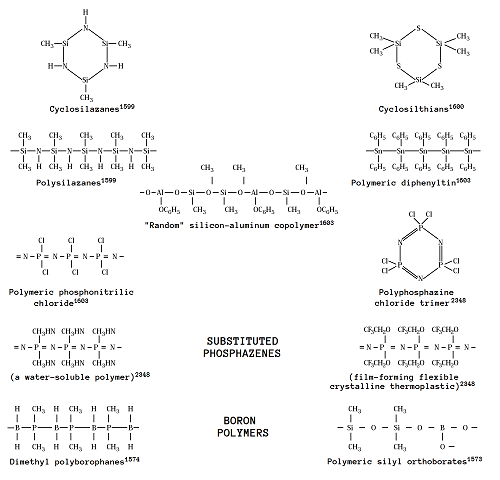 |
Actually, polymers of any kind should be of interest to xenobiologists (Figure 8.7). Since the basis of all life appears to be the polymeric organization of small molecules into larger ones, polymer chemistry seems a reasonable avenue to explore for alternative biochemistries.
In view of various deficiencies in normal carbonaceous organic chains, many other classes have been examined in recent times.2348 According to H. R. Allcock, a chemist at Pennsylvania State University, "a new revolution based on organic polymers is about to begin."
| Used in "silly putty" |
Silicon-nitrogen rubbers and oils have been known for many years. These compounds, called silazanes, are unstable in the presence of water or in an oxygen atmosphere.1598 Inorganic polymers with alternating silicon and boron atoms have turned up recently, and a boron-oxygen-silicon linkage is used in the well-known "silly putty." Various carbon-boron ("carborane") polymers which are quite stable have been discussed in the literature,1575 along with short-chain nitrogen, sulfur, and silicon-sulfur arrangements.
Phosphorus, nitrogen, and chlorine combine to form a kind of rubber in a water-free environment. These "polyphosphazines," as the chemists love to call them, are normally highly unstable in the presence of H2. However, it has recently been learned that short segments can be polymerized and made water-stable.
Soon after this discovery, the elated researchers wrote: "… it now seems likely that almost any set of required properties can be designed into the polymer by a judicious choice of side groups." The proposal that polyphosphazine polymers be used in biomedical applications to transport fixed metal ions2351 suggests a wide range of xenobiochemical applications, perhaps analogous to the metal-containing complexes in chlorophyll and hemoglobin.
 |
| The bottom line in xenobiochemistry |
What is the bottom line in xenobiochemistry?
It must be admitted that the mere ability of atoms to assemble themselves into polymers, while significant, is yet a far cry from the complex biochemistry needed to sustain a living system. There remains a vast gulf between the simple silicone and polyphosphazine polymers and the orchestrated symphony of life.
While chemists have been vaguely aware of the possibility of exotic life schemes for more than a century, no coherent, well-integrated alternative system has been proposed and none is on the horizon. Without actual specimens of alien organisms to examine, the task suddenly takes on staggering dimensions. Imagine trying to speculatively reconstruct our entire terrestrial biochemical basis, having no prior knowledge of its nature or even of its existence!
|
It is quite premature to conclude
that ours is the only, or even the best of all possible, biochemistries. |
The evidence admittedly is against the existence of silicon-based life-forms: The evolutionary mechanisms and planetary conditions appear much too unwieldy. Ammonia life seems far more feasible, if for no other reason than it is so closely analogous to terran biochemistry.
It would also appear that carbon is the backbone element of choice in Earthlike environments, although this should impose no real restriction on diversity. One must agree with Shklovskii and Sagan when they assert: "It is quite premature to conclude that ours is the only, or even the best of all possible, biochemistries."20
In spite of the difficulties, there probably exist many different kinds of life in our Galaxy, including some very exotic forms based on different physical interactions than ours. But we cannot be certain of this until we travel into space and seek them out.
 |
| The bioenergetic challenge |
Why are xenologists so concerned about bioenergetics? Bioenergetics means, simply, the study of biological energy. The engine of life, as any machine, needs a supply and a flow of energy — chemical, electrical, thermal, or whatever — to keep it running. If power is suddenly cut off, both mechanical and biological machines soon grind to a halt.
|
Fundamental requirement of life: a flow of energy from a source to a sink |
The thermodynamic definition of life discussed in an earlier chapter — that living systems "feed on negentropy" and thereby manage to maintain themselves against the universal drive to disorder mandated by the Second Law of Thermodynamics — demands a flow of energy from a source to a sink. This requirement is so fundamental to the basic character of life itself that we may confidently predict that bioenergetics will be a favorite discipline among alien zoologists and physiologists. But can we be as certain about the specifics?
The Viking Lander biology package assumed so. The Pyrolytic Release device tested for photosynthetic activity on Mars, and the other two experiments sought evidence of respiration and simple metabolism. But were these assumptions reasonable? Must lifeforms evolving under alien suns on distant worlds conform to Earthly patterns and cycles?
| ET photosynthetic animals |
ETs will have met the bioenergetic challenge in many diverse and unexpectedly clever ways. Each new race independently must have evolved intriguing and totally unique methods for absorbing, storing, distributing and regulating energy. While we don’t know for certain if extraterrestrial photosynthetic animals are possible elsewhere in our Galaxy, or if alien bloodstreams will run red, green or blue, or whether in some distant corner of the universe there exist "biological refrigerators" which can stabilize body temperatures on sweltering worlds as hot as blast furnaces, xenologists cannot resist the temptation to pose these and other fascinating questions.
|
All life on Earth ultimately depends upon one of two sources:
Photons from Sol (photosynthetic organisms) and Chemical energy (all nonphotosynthetic terran lifeforms). |
Active life requires a flow of energy between a source (a region of high energy) and a sink (a region of lower energy). To use heat energy, for example, a difference in temperature between two points in space must be maintained. A steam engine works not because it is hot, but rather because the boiler is hotter than the condenser.
| Plant life |
How does plant life fit into this scheme? It has been said that the only reason photosynthesis works at all is that the surface of the sun is at 6000 K, whereas the surface of the Earth (and its plant life) is only at 300 K. Photons emitted at the higher solar temperature travel through space to this planet, enter the chlorophyll molecule and power the plant’s metabolism. Later, photons of waste heat, a form of degraded energy, are radiated off at the far lower planetary surface temperature.
| Animal sources and sinks |
Animals too need sources and sinks. The food they eat is burned by the oxygen they breathe, and this constitutes a useful source of energy. The external environment, by accepting bodily waste heat, serves as a sink.
All life on Earth ultimately depends upon one of two sources: Photons from Sol (photosynthetic organisms) and chemical energy (all nonphotosynthetic terran lifeforms). However, various other possibilities have been suggested for hypothetical alien beings on other worlds.
One widely discussed alternative involves the evolution of life on so-called "starless planets."128,816 Such worlds, if they exist, lie in the dark plumbless abyss of interstellar space far from the coddling embrace of any friendly star. Were the object large enough, say, a massive jovian or super-jovian, it might be warmly self-heating with a tepid surface crust.
Of course, we know that heat alone will not power a living organism. And it is difficult to imagine how to establish a flow of energy in an environment heated to some relatively fixed, unvarying temperature. Most writers have ruled out life on starless planets on this basis.18,22,714
Dr. Thomas Gold at Cornell University disagrees. If we consider the surface of a starless planet as a source at 300 K, he points out, then all we need to do is find a sink somewhere at a lower temperature to establish a life-giving flow.
Space is very cold, only about 2.7 K. If this or something very close to it could be used for the energy sink, then biological thermodynamic efficiencies approaching those of terrestrial photosynthesis might in principle be possible.22
|
Many other imaginative and exotic energy systems have been
postulated by various writers, including geothermal heat and volcanism, piezoelectricity, solar wind ions, planetary magnetic fields, atmospheric electricity (lightning), and radioactive decay (fission). |
Extending this idea just a bit further, Gold suggests that some alien lifeforms may base their processes on a thermal gradient in time rather than in space. Imagine a uniformly heated environment in which there was a slow but regular diurnal temperature variation. Usable bioenergy could be extracted through the use of a chemical system which coupled only to the equilibrium state established at each extreme.
At the hottest extreme, certain reactions might take place which stored energy in chemical form. This energy would then be released only when the temperature swung down to the coolest extreme. In this scheme, the source and sink are no longer coextensive in time. As temperature fluctuates, the surroundings would be first the source, later the sink, and so on.
Many other imaginative and exotic energy systems have been postulated by various writers, including geothermal heat and volcanism, piezoelectricity, solar wind ions, planetary magnetic fields, atmospheric electricity (e.g. lightning), and radioactive decay (fission power).
J.W. Ycas has come up with a novel form of energy transduction, to which he has given the formidable appellation "palirrhotrophy."2379 His organisms, should they exist, are powered by chemical osmosis. A flow of bioenergy — an "osmotic current" — is established "by exploiting the rhythmic variations in salinity which occur in the estuarine environment." As the palirrhotrophic lifeform is periodically flushed, first with salty seawater and later with upriver freshwater, energy is pumped into its system osmotically.
Such creatures might exist on a predominantly watery world, one with a large moon or moons and a fast rotation to make the tides frequent but brief. A tropical climate would ensure plenty of rainfall and a bountiful source of freshwater, and high gravity would cause mountain water runoff to cut deep channels and fjords to the sea — a viable niche for palirrhotrophic ETs.
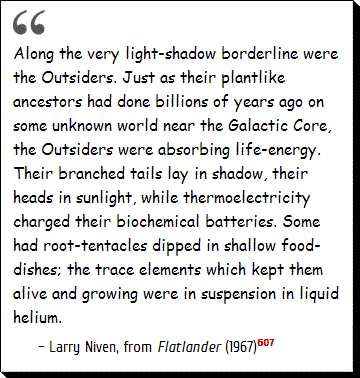 |
| Mechanical energy |
Another distant possibility is the use of mechanical energy. The waves, winds or tides might be harnessed to power a shore-dwelling alien creature. A slowly rotating planet with a massive moon in a fast orbit would have plenty of mechanical wave energy available at the surface. Yet organisms would find themselves without sunshine for such long night-time stretches that they might find it useful to evolve a biomechanical energy system as an auxiliary power supply.
| Thermoelectric organism |
A similar proposal is that extraterrestrial lifeforms might be able to use the internal heat flowing up though the surface of a terrestrial world. Unfortunately, even on a world as far removed from the stellar campfire as cold, distant Pluto, the sun out radiates internal planetary sources by nearly two orders of magnitude. A more viable proposition, perhaps, is the concept of the thermoelectric organism.607 On a planet with thin air, located close to its star, the temperature differential between direct sunlight and shade might be sufficient to adequately power an alien biochemistry.
| Thermonuclear lifeforms |
A few hardy souls have even suggested thermonuclear lifeforms. At a meeting of the British Interplanetary Society back in 1948, Olaf Stapledon proposed that the fusion power of the sun might conceivably be harnessed as an alternative to biochemical processes.556 Although Isaac Asimov has used this idea in the context of a small, planetbound animal,94 such a power supply might be more apropos for electromorphs akin to Hoyle’s Black Cloud.*
* It is interesting to note that Sol, the only nearby entity we know of that uses fusion power, has an overall energy output of only about 0.0002 watts/kg. The human body, on the other hand, operates at a whopping 2.0 watts/kg, about four orders of magnitude higher than the sun!
|
|
|
Despite that many energy schemes noted above, not all processes theoretically permissible under the Second Law of Thermodynamics are commonly or easily available to living organisms. The methods for the performance of useful work used, say, in modern industry are generally not utilized by Earthly lifeforms. For instance, changes in temperature such as might result from combustion or nuclear reactions are not found in biology. Instead, the creatures on this world uniformly may be characterized as "chemodynamic machines," operating by chemical rather than by thermal energy.
This is not a serious restriction. As Dr. E. Broda at the Institute of Physical Chemistry in Vienna points out, nutritionists have observed that "surprisingly high yields of useful energy can be obtained from food." Comparing chemical and thermal systems, Broda continues: "With a yield of 25% as observed, the {equivalent} temperature difference works out as 105 °C. Hence, if the body was a heat engine, local temperatures of at least 310 K (body temperature) + 105 K (food-conversion temperature) = 415 K would be needed."1013
While we recall that arguments on the basis of temperature alone cannot rule out the possibility of life, this example serves to illustrate the superior competitiveness of chemodynamic as opposed to strictly thermodynamic energy systems. We conclude, perhaps somewhat chauvinistically, that nonexotic chemical energy systems will normally be the method of choice for the majority of extraterrestrial lifeforms. Naturally, the most convenient and abundant source of usable energy for most ETs will be their sun.
|
It is difficult to imagine an easier or more elegant
solution to the fundamental bioenergetic problem. |
The process of energy utilization by a living creature is its metabolism.
Given the problem of designing a metabolic system, starting from the sole assumptions that:
- a chemical framework
- powered by sunlight
must be used, we quickly arrive at two logical conclusions.
| Autotrophs |
|
Autotrophs Harvest energy:
Heterotrophs Pirate energy-riches:
|
First, the simplest organisms in a planetary ecology will be those capable of tapping the given energy source directly. These lifeforms accumulate energy from photons received from the sun, absorb any needed inorganic matter that happens to be lying around, and put the two to work in an integrated biochemical system. Because they are able to harvest energy straight from the original source all by themselves, such creatures are called "autotrophs."
| Heterotrophs |
Second, we might imagine another kind of lifeform which cannot tap the energy source directly. This class of organisms is either too lazy or too incompetent to manufacture its own food. So what powers them? Instead of patiently accumulating solar energy, these larcenous "heterotrophs" pirate energy-riches from the complacent autotrophs. Since there is no honor among thieves, we would also expect to find heterotrophs stealing energy from each other as well. An entire chain of robbery would develop, with the strong taking from the weak, the stronger taking from the strong, and so forth.
With a few minor variations, this is the basic scheme of life on Earth. The autotrophs are our plant life, which take up carbon dioxide and convert it to carbohydrates and other energy-rich goodies. The heterotrophs are the animals.
Clearly, the organization of an ecology into two major groupings (producers and consumers) is not at all arbitrary but follows logically from the twin assumptions stated earlier. It is difficult to imagine an easier or more elegant solution to the fundamental bioenergetic problem. Although other ecological systems may exist, the dual autotroph/heterotroph arrangement is probably the preferred technique for chemically-based, solar-energized metabolizers.1428
Each year about 150 billion tons of carbon are taken in by the autotrophic plants on this planet and are combined photosynthetically with some 25 billion tons of hydrogen (split from the oxygen in water) to make carbohydrates. In the process, 400 billion tons of oxygen are set free. On the average, a typical molecule of carbon dioxide wends its way through the system once every 200 years; each O2 cycles less frequently, perhaps once every 2000 years.997
Of course, it is not absolutely necessary for alien autotrophs and heterotrophs to participate in a carbon cycle biochemistry powered by the breakdown of water to oxygen. While the photosynthetic process itself is so simple as to suggest a certain measure of universality, there is nothing sacred about which chemicals are recycled. In fact, there are a number of other systems in use today right here on Earth.
| Sulfur cycle as alternative |
One alternative to the photosynthetic H2/O2 cycle of which humanity is a part is the H2/H2SO4 process of the sulfur bacteria — an entirely different oxidation-reduction system than the one we use. Purple sulfur bacteria take in hydrogen sulfide (H2S) and oxidize it to sulfuric acid (H2SO4). Desulfovibrio, another class of sulfur bacteria, completes the cycle by reducing the acid back to the original hydrogen sulfide gas.
Many other systems are in use on Earth besides this "sulfur cycle." There is an H2/H2O cycle, a CH4/CO2 cycle, an NH3/N2 cycle, and so forth. Microorganisms on this planet are capable of metabolizing such peculiar and diverse substances as selenium, iron sulfide, arsenic, thiosulfate ion, cyanides, and methanol. But the main hangup with using any of these exotic non-oxygenic systems to power large extraterrestrial organisms is their relative inefficiency.
Most are at least an order of magnitude less energetic than the water/oxygen cycle which dominates the biochemistry of Earth.
Because they are so woefully inefficient, non-oxygen-cycle lifeforms are significantly out-competed in most terrestrial environments and "have been driven to the fringes of life-as-we-know-it."1390,1651 Nevertheless, there have been many valiant attempts to design viable extraterrestrial ecologies around various alternatives, notably by Asimov,1358 Clement,292 Glasstone,72 Mitz,1424 Salisbury,1658 and Vishniac et al.313
|
Porphyrins are very simple ring-shaped molecules
which have been produced in many prebiotic synthesis experiments,and which are believed capable of autocatalyzing their own production. Once formed, the porphyrin ring has enormous stability against decomposition. This may help to explain why these substances are so widely distributed on Earth today. |
If photosynthetic activity is extremely useful if not essential on other worlds, what is the best way to do it? Although there are many other molecules at work, chlorophyll predominates on Earth. Chlorophyll, the green active pigment in plants, is a member of a general class of carbon compounds known to biochemists as porphyrins.
Porphyrins are very simple ring-shaped molecules which have been produced in many prebiotic synthesis experiments,1590 and which are believed capable of autocatalyzing their own production. Once formed, the porphyrin ring has enormous stability against decomposition. This may help to explain why these substances are so widely distributed on Earth today.
The porphyrin pigment chlorophyll has a single magnesium atom located in dead center. The exact function of this metal atom has yet to be clarified, but it is believed to play a crucial role in trapping and utilizing the energy of incoming photons used in photosynthesis.
If alien autotrophs use porphyrins too, will they be restricted to green, magnesium-based chlorophyll?
| The case for magnesium porphyrins |
A few have argued that we should consider only the most abundant metallic elements in Earth’s crust — say, the top 99% in abundance — as candidates for the central atom.2374 If we buy this assumption, then a fairly good case can be made for the exclusivity of magnesium porphyrins in any water-solvent oxygenic biochemistry.1423,2399
Of course, this is only a plausibility argument — one which utterly fails if alternative liquid media (other than water) are considered. And even in water, despite the many points in favor of Mg, some doubt remains. Other possibilities may be open to ETs.
While photochemists have so far been unable to produce a substitute porphyrin complex "which involves relatively large storage acts" per photon of energy absorbed,993 it is well-known that zinc (Zn) porphyrin complexes are capable of undergoing reversible photochemical oxidation-reduction reactions similar to those exhibited by Mg-porphyrins.1422,1423
One chlorophyll near-analogue, called zinc tetraphenylporphyrin, has shown weak photoactivity.993 Other zinc porphyrins, although admittedly rare on this planet, have been found in several organisms including Rhodopsuedomonas apheroides, the diphtheria bacillus, various mammalian organs, and in leaf tissue homogenates.994,1069 Copper porphyrins have also been found in the diphtheria bacillus, and other substitutions using nickel, cobalt, or manganese are remotely possible but seriously questioned.1422,1442
But perhaps we are being overly restrictive. What, after all, is so magical about the porphyrins? True, they arise in prebiotic experiments, and true, they are relatively simple molecules and they get the job done. But maybe there exist other equally suitable substances that could stand in for chlorophyll in alien plant biochemistries.
It seems difficult for many to believe that porphyrins are the best-suited class of molecules for the photosynthetic function. In fact, according to Bernard Pullman of the Institut de Biologie Physico-Chimique, University of Paris in France, "it certainly is not."315 George Wald, Carl Sagan, and countless others have pointed out that chlorophyll actually absorbs light rather poorly in the green portion of the spectrum — paradoxically, the very region where solar radiation is most intense. It is likely that a variety of dyes other than chlorophyll could have been used by plants.
| Terran photopigments |
Several alternative pigments are known in terrestrial biology to participate in the process of light absorption. For example, the carotenoids — found in many species of bacteria, algae, and higher autotrophs — absorb primarily blue light (which has more energy per photon) and thus are red, orange, or yellow in color. Carotenoids have no metal atoms and contain no porphyrin-like substances. Another category of terran photopigments are the phycobilins, which give both the red and the blue-green algae their distinctive, vivid color.
In the purple "halobacteria" (salt-loving), chlorophyll is entirely replaced by another Earthly photosynthetic pigment called bacteriorhodopsin. This substance has a deep purple color and is chemically related to rhodopsin, the photosensitive pigment called "visual purple" found in the rods of all mammalian eyeballs.
Research has suggested that this pigment may be selectively more advantageous in certain specific environments. This is particularly true under conditions of intense sunlight, elevated temperature, high salinity, and low oxygen concentrations.2402 As a possible photosynthetic agent for extraterrestrial plant life, purple bacteriorhodopsin is less efficient (by one-third) but chemically simpler than chlorophyll.
| Oxides possessing high photosensitizing activity |
Going still farther afield, why must complicated organic compounds be used at all? It has been amply demonstrated that the oxides of titanium (white), tungsten (canary yellow), and zinc (white) all possess high photosensitizing activity in oxidation-reduction reactions comparable to the activity displayed by chlorophyll. And these particular pigments are known to store light-energy in stable terminal products.2374 This may be useful for biology.
| Organic photocells |
Finally, it is also well-known that many carbon-based organisms are capable of utilizing silicon and germanium to varying degrees. Why could not alien autotrophs, instead of sporting leaves impregnated with chlorophyll, sprout thin platelets of "organic photocells" analogous to the solar cells used by NASA to power spacecraft? Water could be split up by some electrolytic process, and the hydrogen thus liberated incorporated into useful energy-rich molecules.
Any of these substances could serve as photosynthetic pigments for alien plants. When human explorers reach out to other worlds, they may discover beautiful white, blue, red, yellow, orange, purple, glittering steel-gray — yes, even green! — landscapes of thriving vegetation.
|
Given optimum shape and plausible
environmental conditions, autotrophic turtles are quite possible. |
We have seen that photosynthesis is a highly useful means for collecting and storing solar energy. But only plants have been discussed. Could "animals" use this technique as well? This idea has cropped up from time to time in science fiction, so it is worthwhile to deal with it briefly here.
The basic idea is that it might be possible to design an alien metabolism falling somewhere between pure autotrophism and pure heterotrophism. The microscopic flagellate Euglena could be a possible ancestor of such creatures. This tiny microbe feeds both by chlorophyllic photosynthesis (like a plant) and by direct absorption of organic food (like an animal).
| Plant men |
But when it comes to larger organisms, many writers have been unable to conceive of plausible autotrophic animals. Usually it is alleged that "plant men" are impossible because they would be incapable of collecting enough energy fast enough, and that the only remedy for this failing is to become a sessile, vegetable-like being, perhaps akin to a tall, green-skinned saguaro cactus with corrugated skin and large, leafy limbs. But is this really true?
|
Water breathers, to inhale the same amount of
oxygen per minute as a lunged creature, must expose their internal environment to a heat sink with an effective capacity roughly 100,000 times greater than the equivalent amount of air. It is for this reason, xenologists believe, that warm- blooded aliens will almost certainly not have gills. |
The total power requirement of the typical mammal is roughly 3.4M3/4 watts, where M is the mass of the animal in kilograms.1662 The energy received from the sun is a fixed amount, and normal plant efficiencies range from 1-10% in normal light. From these values it is easy to calculate that the maximum size of a chlorophyllic autotrophic mammal on Earth is a small fraction of one millimeter. Moving the planet closer to the sun or raising the photosynthetic efficiency doesn’t help much, either.
But all is not lost! Reptiles, for various reasons, often consume as much as an order of magnitude less energy than mammals of comparable size. Taking this into account, we discover that reptilian autotrophs may be as large as 30 centimeters wide. Given optimum shape and plausible environmental conditions, autotrophic turtles are quite possible.
| Solar-powered avians |
Small autotrophic aerial insects or birds may also be possible on worlds where sizable wingspans are aerodynamically feasible. Energy could be absorbed by chloroplasts locked in the thin skin of the wings. Solar-powered avians may patrol the skies of other worlds high above the surface vegetation, thus escaping certain death under a dense and dimly-lit forest canopy. If their planet rotated slowly enough, they could probably glide sufficiently fast to follow the sun. They could keep their life-giving photoproductive wings in perpetual daylight. Since autotrophic avians would rarely have to stop to hunt for food, they could spend virtually their entire lives engaged in such travels.
| Floating marine species |
Another possible autotrophic animal would be a floating marine species, a pancake-thin stingray-like affair skittering across the surface of the sea. These creatures could grow to enormous sizes, not having to waste much time on hunting or predation. Their main concern would probably be fending off hungry heterotrophic thieves.
|
Fermentation: an anaerobic (oxygenless) reaction leaving most of the energy behind Respiration: in this reaction, the full amount of energy stored in the carbohydrate fuel is recovered |
But Euglena and green hydras aside, plant-eating is the way of life for all animals on Earth. Two broad classes of heterotrophic energy utilization may be imagined.
- First, the rich foodstuffs plundered from plants could be broken down directly for energy. This simple technique, probably used by the earliest protobionts and retained today by the yeasts, is called fermentation. A typical fermentation reaction in which carbohydrate is decomposed looks something like:
- C6H12O6 —> 2C2H5OH (ethyl alcohol) + 2CO2 + 74,600 joules
- This anaerobic (oxygenless) reaction leaves most of the energy behind, locked up in the two molecules of ethyl alcohol — which are discharged as poisonous wastes.
- The second alternative is to employ a powerful oxidant drawn from the environment (e.g. oxygen, chlorine, fluorine, etc.) to biochemically "burn" the carbohydrate fuel. Most animals on Earth today are powered in this way, using oxygen as oxidant, called respiration. In a respiration reaction, the full amount of energy stored in the carbohydrate fuel is recovered:
- C6H12O6 + 6O2 —> 6H2O + 6CO2 + 2,820,000 joules
About one and a half orders of magnitude more energy are released during respiration than during fermentation, at least with carbohydrate fuel.
As a result, many have concluded that animals powered by fermentation cannot be very advanced. This is of interest to xenologists, because if true, it sets a limit to the complexity of evolutionary processes in reducing environments — such as those on the primitive Earth and gas giants like Jupiter and Saturn. Carl Sagan sounds a note of caution:
This is an unimaginative conclusion. There may be more energetic foodstuffs available elsewhere; or the organisms there may eat at a faster rate than do organisms here; or their metabolic processes may be correspondingly slower. It is premature to infer that every planet populated with higher organisms must have an {oxidizing} atmosphere.20
However, there appears to have been great selective advantage for those lifeforms able to metabolize powerful oxidants. Clearly, in any biochemical system, respiratory organisms will obtain far more energy from a given quantity of food than others who rely solely on fermentation. The invasion of land on our world less than an eon ago was immediately preceded by the evolution and rapid deployment of respiratory mechanisms throughout the animal kingdom.2404,2405 Respiration would seem to be the metabolic process of choice for highly active, mobile organisms.
On Earth, three basic designs for respiratory organs have emerged over the eons: Tracheae, gills, and lungs.
| Tracheae |
The first of these is used by insects, worms, and other small creatures. An insect does not really breathe, as we understand the term. The system is essentially a passive one. Oxygen is not carried to the muscles by circulating blood, but rather by a network of branching air tubes called tracheae. Insects introduce oxygen into the interior of their bodies solely by diffusion (sometimes assisted by weak abdominal pumping spasms) — a far slower and less efficient technique than an active, forced-flow oxidant circulation system.
This tends to limit the size of tracheal breathers. Although this passive system might well serve much larger organisms on a planet with high atmospheric pressure (of oxidant),* on Earth insect bodies must remain fairly small to be efficient.89,1730 The largest alive today are the tropical beetles which grow as long as 15 cm; and while tropical dragonflies and centipedes during the Carboniferous Period (and the Devonian Period sea scorpion Pterygotus) often achieved lengths up to 150-180 cm, they were still stuck with attenuated cylindrical bodies no more than a few centimeters in diameter.722
* With much denser air, insects could be somewhat larger than we know them. Flowers might also be larger, broader, more colorful, in response.89
|
Breathing by water seems to present
more problems with fewer rewards than air breathing. |
If an animal can’t wait for oxidant to drift lazily through tracheae to replenish its cells, it can forcibly pump it there using a powerful circulatory system. This is an active system, in contrast to the passive mode of insect breathing.* Circulatory fluid may be enriched with the vital oxidant in one of two ways: Diffusion from a liquid medium (gill breathing), or diffusion from a gaseous medium (lung breathing).
| Water breathers |
Breathing by water seems to present more problems with fewer rewards than air breathing. Since the liquid has a far higher density and viscosity than air, it takes more energy to ventilate a gill than a lung. This difficulty is further aggravated by the simple fact that water equilibrated with the air above contains only 3% as much oxygen in solution. Hence, the gilled animal must pump a lot to breathe a little.
| Lung breathing |
Oxygen diffuses into the respiratory organ about a million times faster in air than in water. Water breathers also have less control over the flow of vital ions between body and environment, which can be quite hazardous.
| Heat loss |
Perhaps the most serious drawback to the use of gills is the problem of heat loss. Water breathers expose their blood to an external fluid of comparable heat capacity, while air breathers encounter a thin gaseous medium with a heat capacity some 3000 times lower than that of their circulatory fluid. Hence water breathers, to inhale the same amount of oxygen per minute as a lunged creature, must expose their internal environment to a heat sink with an effective capacity roughly 100,000 times greater than the equivalent amount of air. It is for this reason, xenologists believe, that warm-blooded aliens will almost certainly not have gills.724
* As a general rule, blood circulates continuously throughout the body. However, in a few animals (notably the annelid worms) there is no such throughput circulation. Instead, bodily fluids undergo a periodic ebb-and-flow cycle, a kind of "tidal irrigation" of the cells.
|
Figure 10.1 Alternate Blood Chemistry in Science Fiction |

Mr. Spock, the extraterrestrial Science Officer of the Federation starship
Enterprise, has green blood coursing through his veins. © 1976 Paramount Pictures |
It has been suggested that the color red is used to signify danger in so many human societies because it is the color of blood. We associate red with blood and bleeding, which in turn are associated with pain, bodily injury, or death. If the blood of ETs is, say, green (Figure 10.1) instead of red, one writer speculates, they "would think green a quite natural index of danger and be amused at the idea of using red."2552
|
Human heart:
|
Virtually all higher organisms on Earth circulate body fluids of one form or another. The grasshopper has a circulatory system involving blood and many hearts — though it is used only for food and waste, and not oxygen, transport. The earthworm has an advanced pumping network with five pairs of hearts, and the squid has two pairs — one at each gill to circulate fresh oxygenated blood, the other pair for returning spent blood. In the human body, a heart weighing about half a kilogram pumps 8000 liters per day through approximately 96,000 kilometers of vessels and capillaries.
One of the most important functions of circulatory fluid is to deliver oxidant to the organism’s cells, by dissolving more of it than would normally be possible in plain water. On Earth, where gaseous oxygen is the most common oxidant in general usage, the utility of blood in this regard is greatly enhanced by the presence of pigments. These pigments are able to combine "reversibly" with O2, picking it up in lung or gill and ferrying it along to the cells. For instance, pigments found in mammals typically can carry some 250 cm3 O2 per liter of blood, as compared to a mere 5 cm3 O2 that can be dissolved in a liter of ordinary seawater at the same temperature.
| Oxygen transport via pressure differential |
The way oxygen transport works is rather clever. Nature has discovered that certain substances will chemically combine with oxygen at high partial pressures, but that if the pressure is lowered past a certain point, the gas is let go again. By maintaining a high partial pressure in the respiratory organ of an animal, and a comparatively low pressure within its cells, O2 may be picked up by the blood pigment in the lungs and later forced to give it up when it reaches the body tissues.
|
Figure 10.2 Structures of Some Important Porphyrins1428 |
||
|
Side by side comparison of Chlorophyll and Heme
|
The most successful such pigment on this planet is hemoglobin (Hb), a member of the same class of porphyrins to which chlorophyll belongs (Figure 10.2).
A hemoglobin molecule consists of a porphyrin ring with a central iron atom (heme), hooked to a giant clump of protein called globin.
Hemoglobins are present throughout the entire animal kingdom, in all vertebrates (except a few Antarctic ice-fish1691) and in the circulatory fluids of many invertebrates as well (annelid worms, many arthropods, and some echinoderms, mollusks and crustaceans).
|
Figure 10.3 Respiratory Pigments for Alien Bloodstreams |
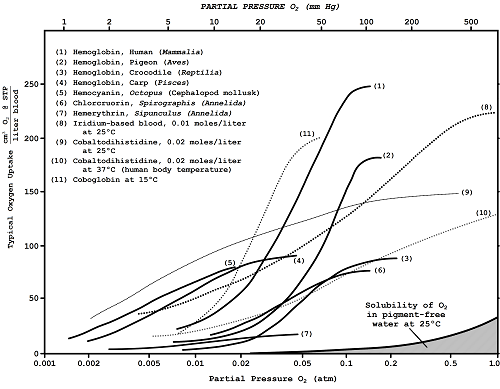 |
Hemoglobin remains the most efficient oxygen-carrier known. For the better part of this century, chemists have labored in vain to create other substances that could do a better job. Nevertheless, several other pigments have been discovered and utilized in nature.* These, while not as efficient as hemoglobin, still are able to serve as adequate oxygen-transporters in certain environments (Figure 10.3).
| Hemocyanin |
The copper-containing pigment hemocyanin, second in breadth of distribution only to hemoglobin, is found in the blood of various mollusks and arthropods.195,723 Unlike human blood, which is bright red in the arteries (oxygenated) and dark red in the veins (deoxygenated), hemocyanin blood is a beautiful blue in the arteries and crystal—clear colorless like water in the veins.
| ET blue bloods |
Hemocyanin is always found floating freely in the blood plasma, rather than being trapped inside corpuscles as are the relatively smaller molecules of Hb. This copper-based, proteinous, non-porphyrin blood pigment is only about 25% as efficient an oxygen carrier as hemogIobin.734 Might true extraterrestrial "blue bloods" exist? On a world with very high surface pressures and abundant oxygen we might suspect that the higher efficiencies achieved by Hb might not be needed for survival. Hemoglobin might then never have evolved at all.
* Most animals with colored blood (except insects) obtain that color primarily from the respiratory pigment. Naturally, since substances of all kinds may be dissolved in the circulatory fluids of an animal, the possibility of blood of any color cannot be positively ruled out. However, in most respiratory terrestrial species it remains true that the blood is vividly colored according to the particular oxygen transport pigment used.
Another free-floating respiratory pigment found in various tubular annelids (Polychaeta), also only about a quarter as efficient as Hb, is chlorocruorin.723 Solutions of this iron-based pigment are green in natural dilute solutions, but in higher concentrations become vivid red in color. The blood of one species, Serpula vermicularis, is remarkable in that it is a dual hemoglobin/chlorocruorin pigment system.
| Hemerythrin |
Hemerythrin is iron-containing proteinous pigment found in the blood of certain bottom-dwelling marine worms (nematodes, annelids) and brachiopods. It serves as a reversible oxygen carrier, but is far less efficient than hemoglobin. Blood containing this pigment is a bright pink or violet when oxygenated, but turns colorless by the time it reaches the veins. A small molecule like Hb, it must be confined to corpuscles in the bloodstream rather than allowed to float about freely.
| Vanadium chromagen |
Another pigment is called vanadium chromagen.1650 This is found in the blood of sea squirts, ascidians, and tunicates. Confined to tiny corpuscles known as vanadocytes, the blood containing these tiny packets is usually apple-green in color but can also be found in blue and orange varieties, presumably due to the presence of different oxides of vanadium.1070Although still questioned by some, vanadium chromagen appears to take up and release O2 freely in acidic solutions.
There are a few others known to biologists, such as the copper-based porphyrin found in the wing feathers of Turacus indicus and the occurrence of a manganese-based porphyrin in the blood of the mollusk Pinna squamosa (called "pinnaglobin," a brownish pigment), whose respiratory functions have not yet clearly been established.
Lifeforms on other worlds could use various combinations or varieties of any of the above to get oxygen to their cells. Their blood could take on virtually any color, as we have seen. But does the inventory of natural techniques on Earth exhaust the possibilities?
Not by a long stretch. Despite the undisputed fact that reversible oxygen binding is a comparatively rare biochemical property, there are many alternatives never seen by nature. For more than half a century now, chemists have been reporting the synthesis of Hb-like molecules, not occurring in nature, capable of reversible combination with oxygen.734 For example, a simple iron-indigo compound seems to work quite well.2411
Porphyrin complexes of dozens of metallic elements have been studied carefully in this regard.914,918,1068 Chemists have discovered suitable manganese and cobalt complexes unknown in terrestrial respiratory systems. Since early in this century, in fact, a wide range of cobalt histidines and "coboglobins" have been investigated in depth. (See especially the work of Hearon et al.,914 Hoffman and Petering,916 Martell and Calvin,1067 and Michaelis.915,2414) They appear most promising for use in possible alien biochemistries. There is some precedent for this on Earth: Vitamin B-12 is a cobalt-based porphyrin.
Coboglobin blood would be colorless with a faint pinkish tinge when loaded with oxygen, but in the veins would take on a dark yellow or deep amber color. Since coboglobin protein is a lightweight molecule like hemoglobin or hemerythrin, we might expect ET blood to carry the pigment in corpuscles.*
| Irreversible oxygenation |
After many cycles of use, a molecule of coboglobin gets old and "tired."
It loses its ability to reversibly bind oxygen. While this aging takes weeks in the case of normal human hemoglobin, less than a day is required for coboglobins to poop out. As this "irreversible oxygenation" sets in, the pigment changes color dramatically from amber to deep pink.
But this should pose no insuperable problem for ETs. We know that millions of human blood cells are broken down and rebuilt each minute of our lives. It is not implausible to suggest that alien organisms may have evolved a more efficient biochemical apparatus for the recycling and reconstitution of blood pigment than have Earthly animals.
It is doubtful that the relative scarcity of cobalt compared to iron will rule out the existence of coboglobins in alien blood. While the element is about 1/100 as abundant as iron in the seas, it is approximately as abundant as phosphorus, chlorine, and potassium, all of which are common in mammalian biochemistry. And the two elements copper and vanadium — used by terrestrial lifeforms in the O2-transporting blood pigments hemocyanin and vanadium chromagen — are almost an order of magnitude scarcer than cobalt in the cosmos and are of comparable abundance on planetary surfaces.**
* Like hemocyanin, hemerythrin and coboglobin are not destroyed by carbon monoxide as is hemoglobin in human blood. Organisms with these kinds of blood pigments thus would not be poisoned by the gas, as humans are.
** Cobalt, not iron, may lay claim to the simplest oxygen binding molecule on record. Cobalt forms a complex with ammonium hydroxide (ammonia dissolved in water) which is capable of reversible behavior. The carrier molecules have a mean lifetime of only a few hours, so must be rapidly recycled much like coboglobin.914
Another interesting though less likely possibility is iridium-based blood. One simple compound with an absolutely horrible name (chloro-carbonyl-bis(tri phenylphosphine)-iridium) has recently been shown to undergo reversible oxygenation.919,920 This substance is insoluble in water and other polar media such as liquid ammonia and alcohols, but this presents no barrier to its use in blood. The vanadium chromagen found in ascidians is also insoluble in water.
In solution, the compound takes up one atom of oxygen per molecule to change from brilliant yellow to sullen orange. The reaction is not quite as fast as with the cobalt complexes, so a more convoluted lung would be necessary.
| Pigment for a dimly lit world |
In the oxygenated condition, the iridium-based blood of extraterrestrials would have to be protected from light because it is very photosensitive. The pigment slowly decomposes over a period of days or weeks when exposed to strong light, gradually changing color from orange to green and finally to a deep bluish-black. Such aliens would therefore either have very dark skin, or would inhabit a dimly lit world. (In the absence of light, the molecule is stable for years.)
The iridium complex has one additional property which is extremely fascinating to xenobiologists. In addition to oxygen, the molecule is also capable of reversibly binding hydrogen as well!
Many other reversibly binding compounds can probably be found if chemists search for them diligently. And we haven’t even really considered the possibility of ETs using oxidants other than oxygen. To date, chemists have scarcely considered reversible chlorine- or sulfur-binding molecules which might serve as respiratory pigments in the bloodstreams of truly alien extraterrestrials.
|
It was quickly discovered
that it was of tremendous advantage to be able to run the biological machinery at top speed in virtually all circumstances. Cold-blooded animals are not really cold
but merely biologically unregulated. |
About 20 joules of energy are released for every cm3 of oxygen consumed in respiration. In reality, however, only a fraction of it can be utilized for activity and useful work. There is much waste heat.
A major problem experienced by extraterrestrial creatures will be controlling the generation and distribution of this excess energy within their bodies.
| Cold-blooded |
Of course, an organism might simply choose to ignore the problem, hoping that the environmental temperature extremes don’t become so great as to make life impossible. These are the "cold-blooded" animals, which are not really cold but merely biologically unregulated.
There are many examples on Earth. Sea creatures are most likely to follow this pattern, because temperatures in the ocean vary little from day to day.* The consequences of cold-bloodedness are often striking. During freezing weather, as much as 75% of the body water in several marine invertebrates has been found in the form of ice.943
Cold-blooded creatures are not seriously size-restricted, but tend to become lazy and sluggish in hotter or colder climes. Consequently, animals evolved certain techniques to maintain greater control over internal temperatures. It was quickly discovered that it was of tremendous advantage to be able to run the biological machinery at top speed in virtually all circumstances.
* Warm-bloodedness probably requires nonaquatic evolution. Air is less conductive than water, holds less heat, and is subject to much wider thermal variations. Air just can’t do the job water does, so a new approach is required. Warm blooded ETs will probably have evolved that ability on land.
The fact that most organisms on Earth are mostly water is itself a tremendous thermoregulatory advantage. A 75 kg adult human, for instance, may generate ten million joules of energy in a single day. As pure heat energy, this would suffice to raise the body temperature only about 30 °C. But if almost any substance other than water were used, the same quantity of heat would cause a temperature rise of from 100-150 °C — which is excessive.
| Dilating or constricting blood vessels |
Aliens, like terran lifeforms, may also control body heat by dilating or constricting blood vessels in the skin. An extraterrestrial with green blood whose body is overheating may appear flush-skinned, a sickly-looking pale patina.
| Thermal radiators and cooling vanes |
There are variations on this theme. Elephants are thought to use their giant ears as great thermal radiators. There is much speculation that the tough armored dorsal fins of the extinct dinosaur Stegosaurus might have acted as cooling vanes. ETs may come up with similar adaptations, especially among the larger creatures and in hotter planetary environments.
| Evaporative cooling |
Evaporative cooling is another simple technique. Humans can sweat out as much as 10-12 liters of water each day from some six million evaporative sites in the skin. However, it is believed that only large warm-blooded organisms can afford to throw away the copious amounts of water needed for strictly evaporative cooling. We might also expect that aliens on very humid worlds would be far less likely to evolve evaporative thermoregulation, because high humidity means slow vaporization.
| Panting, saliva spreading and wallowing |
Again, there are variations. Some animals, such as the rabbit, the ostrich and barn owl, and the dog, are cooled almost entirely by panting.944 Saliva spreading is the only known technique among rodents, several marsupial species, bats (Megachiroptera), and has been observed in cats, elephants, and opposums.942 Wallowing is most effective in bare-skinned or sparsely-coated species. The domesticated pig cannot sweat at all, but by wallowing in mud or its own urine it can increase evaporative heat loss by as much as two orders of magnitude.941 (Intelligent wallowing ETs, the utods, appeared in Brian Aldiss’ science fiction novel The Dark Light Years.226)
| Biological electric blanket |
The Canadian harp seal is a warm-blooded animal living in extreme cold, and has evolved a unique internal heating system. It has the equivalent of a biological "electric blanket" under the skin, which can be turned up or down as required to maintain stable body temperatures. The seal can also regulate its own heartbeat, ranging from 120 down to 20 beats per minute, to change the distribution of body heat.2408
|
Other control methods:
|
Many other methods of temperature control exist among Earthly fauna which could serve as models for ETs.
- Heat can be generated by shivering.
- Many believe that feathers may have been a thermoregulatory adaptation.1653
- There is "behavioral thermoregulation" (sun-basking, shade-cooling).
- "Social thermoregulation" (school swimming in fish, hive fanning in social insects).
- "Seasonal thermoregulation" (woodchucks and marmots are warm-blooded during one season, cold-blooded in another).
- And even variable metabolic heating demonstrated in some species of plants.
| Biological refrigerator |
To the best of our knowledge there exist no organisms on Earth that directly utilize the principle of the heat pump — which Carl Sagan has aptly described as "biological refrigerators."630 The cyclical expansion and contraction of a volatile coolant fluid might be possible. Or, cycles of complementary biochemical reactions could be designed to cool an extraterrestrial lifeform at one end while radiating off heat at the other.
For instance, consider a 100 kg alien with a normal body temperature of 50 °C. If it is sitting in an environment held at a uniform 75 °C, the desired body temperature can be maintained if the creature holds one fifth of its total body mass (about 20 kg) at 175 °C. Such a heat pump mechanism would be greatly simplified if a simple cooling fluid with high heat capacity could be found, especially on a planet with an atmosphere rich in heat-conductive gases such as hydrogen or helium.
|
The Square-Cube Law:
|
The overall problem of heat management has some interesting consequences as regards the limiting sizes of organisms elsewhere in the Galaxy. As dictated by the Square-Cube Law, an animal which is twice as tall has eight times more mass — and thus eight times more waste heat is generated — but only four times as much surface area across which to radiate it off.
The problem of very large animals, then, is to find ways to get rid of lots of excess heat. Since the quickest and simplest way to do this is by conduction in water, this may explain why the largest warm-blooded animals on Earth — the whales — are found in the sea.
The largest terrestrial land lifeforms in hot, tropical climates (rhinos, hippos and elephants) are designed without body hair to facilitate heat loss. Dinosaurs are believed by many to have been hairless, and this fact may have contributed to their extinction during the periods of extensive glaciation and global cooling which followed the balmy Jurassic a hundred million years ago)142,2412
|
Whereas a human consumes only 1-2%
of his body weight in food each day, a mouse must eat 50% of its weight daily to survive. A warm-blooded animal much smaller than a mouse seems virtually impossible. |
The Square-Cube Law predicts exactly the opposite problem at the low end of the size scale. An animal which is only half as tall generates only 12½% as much waste heat but has 25% as much skin surface to radiate it away. It must eat twice as fast just to stay as warm as before. The problem of small animals (say, 1-1000 grams) is to conserve body heat and find enough to eat to stay alive. As Isaac Asimov once remarked, "no one has ever seen a fat shrew or ever will."2409
For example, whereas a human consumes only 1-2% of his body weight in food each day, a mouse must eat 50% of its weight daily to survive. A warm-blooded animal much smaller than a mouse seems virtually impossible.
|
The size and shape of extraterrestrial organisms will be
closely determined by their need for energy, the efficiency of their metabolisms and ecology, and the nature of their internal temperature control mechanisms. |
The disadvantages of small size with warm-bloodedness further aggravated in cold Arctic climes or in large heat-sink media such as the ocean. In both these niches on Earth larger animals tend to predominate — polar bears and seals in the cold North, and dolphins and whales in the seas. There are no reptiles or amphibians, and few small mammals. It is also known that body limbs and tails tend to be shorter in colder climates, a phenomenon known as Allen’s Rule.
The size and shape of extraterrestrial organisms will be closely determined by their need for energy, the efficiency of their metabolisms and ecology, and by the nature of their internal temperature control mechanisms.
 |
| Construction of physical beings |
The rich diversity of multicellular life on our own planet should tip us off that nature will have produced similarly intricate designs elsewhere in our Galaxy. The flora and fauna of extrasolar worlds doubtless will differ markedly from terrestrial species. One has only to consider the tremendous variety of terran life to realize at once that we live in a grand planetary zoo without equal — save that of another world. Nevertheless, there must exist some limits to strangeness, some basic, universal rules regarding the construction of physical beings.
Our imagination sorely needs stimulation rather than restraint. So perhaps it is appropriate to begin by attacking one of our most basic assumptions about alien life: That all organisms must be built of cells. Since phase separation is probably a fundamental prerequisite to life, and since small cells are virtually certain to arise prebiotically, it was not an unwarranted assumption, to be sure.
But it is not essential, either.
| Slime molds |
Interesting in this regard are the slime molds native to Sol III.444 At one stage in their life history, they are small and insignificant one-celled flagellates capable of individual multiplication by simple fission. At a later time, however, large clumps of these cells fuse together. The resulting single, large, amoeba-like organism is capable of collective movement as a single entity. During this "plasmodium" stage cell walls dissolve away, leaving an amorphous mass of living protoplasm which can grow as large as 25 centimeters or more.
Here’s the catch. Although there are many cell nuclei floating around inside, the "body" of the slime mold in the plasmodium stage bears no trace of the earlier division into many cells. The organism has, quite literally, metamorphosed into a large single-celled organism.*
Hence, large extraterrestrial beings plausibly may be unicellular.
| Diffuse-organism |
Another peculiar possibility is the diffuse-organism concept. Despite the assertions by some that "no biological life has developed in which a single integrated organism has covered large geographic areas,"600 it has been pointed out by the renowned American entomologist Edward O. Wilson that a colony of social insects may be thought of as a kind of organism:
…weighing anywhere from less than one gram to as much as a kilogram and possessing from about a hundred to a million or more tiny mouths. It is an animal that forages amoeba-like over fixed territories a few meters in extent. …The giant of all such superorganisms is a colony of the African driver ant Dorylus wilverthi, which may contain as many as 22 million workers weighing a total of over twenty kilograms. Its columns regularly patrol an area between 40,000 and 50,000 square meters in extent.565
What would an ET with detachable cells be like? Would we recognize the parent organism as living? If it were intelligent, could it comprehend us? Contact with an alien diffuse-organism might prove frustratingly difficult for early human explorers of distant worlds.
[Note: See also the author's article "Extraterrestrial Zoology", published in 1981.]
* This idea has already been used in several science fiction stories by Larry Niven. His Bandersnatchi are an example of an elephant-sized extraterrestrial organism constructed on a unicellular basis. The creature consists entirely of "undifferentiated protoplasm."451
 |
|
By "specialization" we usually mean
"the utilization of specific structures which perform given functions within the body." These structures are called organs. |
Despite the fascinating possibilities suggested above, a compact multicellular condition will probably develop on many worlds with highly organized life.* This is primarily because multicellularity permits specialization.
Specialization permits a division of labor in the primitive cell colony. Some cells become expert at, say, moving the body around. Others, free to ignore motion, may perfect their skill at digesting foodstuffs. The division of labor allows cells to do what each does best, and the aggregate efficiency is vastly increased.
It is the business of life to accumulate information and complexity. The specialized, highly differentiated organism is the bearer of far more information than a more homogeneous or generalized entity. The specialist metazoan has greater complexity.
This is not to say that complexity per se necessarily has survival value. But solutions to complicated environmental crises may require complicated solutions. As Carl Sagan observes, a solution involving many molecules will frequently be qualitatively superior to one which involves only a few.20 There does seem to exist a general evolutionary trend towards increased information storage, greater complexity, and higher levels of biological specialization.
By "specialization" we usually mean "the utilization of specific structures which perform given functions within the body." These structures are called organs.
* Terrestrial organisms display remarkably little variation in the sizes of the individual cells, most falling within a single order of magnitude of scale. However, colder planets may spawn lifeforms with somewhat smaller cells than ours. This is because there is less thermal disruption at the molecular level at lower temperatures.63 But how small can cellular building blocks be? The 1000 Angstrom "pleuropneumonia-like organism," or PPLO (the smallest living thing on planet Earth capable of independent metabolic activity), is probably extremely close to the theoretical limit of roughly 400 Angstroms.1440, 2395 An alien analogue to a human being, if constructed of cells this small, would weigh a mere fifty milligrams and would stand only five millimeters tall.
Organs, while specialized in function, need not be specialized in structure. It is entirely possible that extraterrestrial lifeforms might have what is often referred to as "distributed organs." Instead of neat packages of similar cells, distributed organs would be scattered throughout the body. There are precedents for this on our own world.
For instance, insects inhale oxygen like other animals and yet they have no lungs. Unlike the localized organs found in humans, mammals and other animals, the insect "lung" permeates the entire body. The insectile structure is crisscrossed, like a piece of Swiss cheese, with a network of tracheal tubules and microscopic holes. Air reaches the interior cells only by diffusion. The insects’ "lung" is a distributed, nonlocalized "organ."
Peter Ritner has suggested that a creature’s brain might be of a distributed nature.1550 We can imagine an enormous blob of alien protoplasm suffused with more or less generalized nervous tissue. The organism’s brain and body, like the breathing apparatus of the insect, would be coextensive.
|
Sometimes, organs combine several functions
at once — such as the human mouth. |
The number of organs of each type is highly variable. The squid, for instance, has two kinds of hearts — one for arterial blood and one for the venous. Many terrestrial creatures have two or more eyes, multiple anuses and stomachs, pairs of arms and legs, and so forth.
Sometimes, organs combine several functions at once — such as the human mouth. There is no reason to believe that ETs will have exactly the same combinations as us.
They may have separate organs for eating, drinking, breathing and speaking. The dolphin, for example, eats through its mouth, breathes through its blowhole, and "speaks" through its "ears." The land snail’s lung opens onto a passageway quite distinct from its food canal, and sea cucumbers breathe through their rectums. (This is called "anal respiration.") Brachiopods can only vomit their solid and liquid wastes, because they have a "blind intestine," a kind of alimentary cul-de-sac.
Then there is the ant lion, which is incapable of voiding any excrement at all. This is because all digestion occurs outside of its body, by the powerful saliva it injects into its victims. After the prey’s innards have turned to soup, the ant lion sucks the victim’s body clean of the predigested pap, leaving a dry husk behind. There are no wastes.
And the members of phylum Nematomorpha (long worms) have no mouths at all. All nutrients are "eaten" by direct absorption through the skin. Aliens can be no less strange in their organ arrangements.
| Multiple-brained / split brained |
There is also the possibility of multiple-brained extraterrestrial animals. After all, Brontosaurus and Diplodocus, two species of giant dinosaurs, carried an enlarged section of neural tissue in the hip region — larger than the brain itself! The volume of this "sacral enlargement" in Stegosaurus, another fossil animal of grand proportions, was perhaps twenty times larger than the brain in the cranial cavity in the head. Further, Homo sapiens (a species not yet extinct) tenders a curious "split brain." The left and right hemispheres are two coordinated organs with distinct functions and reactions to stimuli.502 Most vertebrate brains have a similar dual construction.
|
Based on the evidence of literally millions
of terrestrial animal species, we conclude that highly-organized mobile aliens will most probably have bilateral symmetry if they have any physical form at all. Virtually all of the metazoans may be
regarded as having bilateral symmetry. |
In addition to varying degrees of specialization and organ distribution, most extraterrestrial multicellular lifeforms will display some sort of symmetry. Symmetry refers to the basic geometrical layout of an organism, the way its various parts are positioned with respect to one another, its shape.
Probably the first to appear in evolution was radial symmetry. The radiolarians — small, spherical lifeforms — are ideal examples. The main body is distributed around a single point in a radiating fashion.
The cylinder shape is another form of radial symmetry, in which parts are arrayed around a line instead of a point. Many sponges and coelenterates display this pattern.
| Bilateral symmetry |
However, virtually all of the metazoans may be regarded as having bilateral symmetry. In this design, an imaginary line drawn from head to tail bisects the animal into two similar pieces. That is, the organism may be divided down the middle by a plane which results in two mirror-image halves. Humans are organized in this fashion, as are all mammals and most chordates. Bilaterality, if we can trust the fossil record of a single specimen planet, must have great selective value because it has been re-invented countless times in most phyla of the animal kingdom.
Of course, body symmetry reflects lifestyle. Primitive sedentary or attached animals are usually radial, a body configuration that permits exploration of the environment in all directions. Conversely, animals that must pursue their food more actively need a more mobile, streamlined shape. The bilateral cylinder is ideal for efficient unidirectional movement through viscous media such as water. And it is characteristic of the most successful of Earth’s fauna, including all of the vertebrates and most of the invertebrates.
Based on the evidence of literally millions of terrestrial animal species, we conclude that highly-organized mobile aliens will most probably have bilateral symmetry if they have any physical form at all.
 |
| Momentous consequences of the Square-Cube Law |
Besides the gross form alien life may assume, xenologists also want to know how large these beings might be. What role does planetary surface gravity play in determining the size and shape of bodies? What are the limits of biological building materials? Will alien skeletal support structures resemble our own?
|
Square-Cube Law (revisited) Size × 2 results in:
|
As with most areas in the field of xenology, these questions are quite complicated and have no quick, simple answers. A good place to begin, however, is the Square-Cube Law, first recognized by Galileo more than three centuries ago.2410
| Universal constant |
This mathematical law, which will hold anywhere in the universe, states that volume increases faster than surface area as size is increased. If an animal’s size is doubled, its surface area rises by a factor of four. Its volume, and therefore its weight, rises as 23 or eight. From this simple result flow many momentous consequences.
If weight increases eight-fold, but the surface which supported that load increases only fourfold, then the pressure that must be sustained to support the body against gravity has actually doubled. Bones are asked to carry proportionally twice as much stress as before. Consequently, as animals get larger, their bones must become thicker, sturdier, and squatter to accommodate the higher pressures.
| Redesigned with size |
All parts of an animal must be modified when there is an increase in size. Muscle tissue, the strength of which is determined by cross-sectional area, must double in relative thickness in response to a twofold increase in size. Lungs, kidneys, intestines and other blood-filtered organs also function according to surface area rather than body volume. The entire organism must be redesigned as it becomes larger.
|
As animals get larger, their bones must
become thicker, sturdier, and squatter to accommodate the higher pressures. |
The horror movies about giant insects ravaging the countryside are really quite impossible. A bug the size of a house has a billion times more mass to carry around, and its thin, spindly legs are called upon to sustain pressures thousands of times greater than before. To walk at all, the misshapen insect needs muscles proportionately thousands of times thicker than before — yet such tissue already virtually fills the hollow bones of the tiny original so there is really no room to grow. If it did not collapse under its own weight, or was not immobilized by the feebleness of its muscles, it would starve to death because its stomach was a thousand-fold too small or would suffocate because its tracheae could carry only a thousandth of the needed oxygen.
The worlds of size are truly worlds apart.*
|
Weight of water on:
|
* Consider the following excerpt from J. B. S. Haldane’s Possible Worlds (1928):
A man coming out of the bath carries with him a film of water of about one pound. A wet mouse has to carry about its own weight of water. A wet fly has to lift many times its own weight, and a fly once wetted by water or any other liquid is in a very serious position indeed. An insect going for a drink is in as great danger as a man leaning out over a precipice in search of food. If it once falls into the grip of the surface tension of the water — that is to say, gets wet — it is likely to remain so until it drowns. The majority keep well away from their drink by means of a long proboscis.974
|
This force [gravity] at the surface of any
world determines to some extent the maximum mass and size of the animal life. |
The strength of biological building materials sets an upper limit on size. Galileo once calculated that a tree taller than about 100 meters (on one-gee Earth) must buckle under its own weight. This is because its cross-sectional strength would be insufficient to stabilize such a tall mass against collapse. (Some sequoias, which slightly exceed this theoretical limit, are nevertheless close to the maximum height attainable using woody materials.)
| Bone strength |
The typical loads sustainable by animal bone are about: 600 atm laterally (shear strength), 1000 atm in longitudinal tension, and as much as 1700 atm in compression.204, 1730 These should be compared to the following: 340 atm for Douglas fir, 540 atm for hard-burned brick, and 5400 atm for cold-rolled steel.48, 924 Clearly, bone is an excellent building material.
The villain of this story is, of course, gravity. This force at the surface of any world determines to some extent the maximum mass and size of the animal life.
One way to meet this challenge is to take to the water. In the sea, the force of gravity is partly cancelled out by the opposing natural buoyancy of immersed bodies. There are no obstacles to large structures per se.
But subtle problems arise when sea creatures grow too large. It has been suggested that inertial mass, rather than weight mass, may be the limiting factor. That is, the larger a body in motion is, the more it wants to remain in motion. An extraterrestrial leviathan larger than a whale would experience severe steering, braking, and turning difficulties. Cornering too fast could easily exceed the strength of the building materials, and snap the behemoth in two.400
There are also ecological considerations. Larger aliens will generally eat more than smaller ones, all else being equal. Yet at the same time it is getting huger, the organism is also getting bulkier and less maneuverable. The animal needs to spend more and more of its day feeding. Indeed, the largest whales must drive incessantly through food-laden waters in order to meet the severe metabolic demands of their ponderous bodies.
Further, note that the mass which must be fed increases as the cube of the linear dimension, the nutrients must be absorbed through the surface area of a gut which increases only as the square of the linear dimension. The Square-Cube Law thus predicts that at the same time it is becoming harder to ingest food fast enough, it’s also becoming harder to actually utilize what is eaten.*
What is the largest skeletonless creature that can exist? We really don’t know, but in the ocean the answer is — reasonably large.
| Supreme escape artist |
Life without a rigid frame offers advantages difficult for humans to fully appreciate. Many molluscs such as the squid and octopus have pretty much lost their ancient shells and have become essentially skeletonless lifeforms. Octopuses can stretch themselves quite thin, passing rubberlike through small holes and narrow crevasses. Arms, eyes, and even head can alter shape and elongate when necessary. The octopus has been called "the supreme escape artist," and is known to be able to walk across desktops and the decks of ships.
|
Henry’s Law: The amount of O2 dissolved at any given temperature is directly proportional to the atmospheric surface pressure. |
* There is another still more subtle twist to the story of pelagic lifeforms. On a high pressure world (which may or may not correlate with higher gravity), more gaseous oxidant (e.g., oxygen) will dissolve in the water in the oceans. The amount of O2 dissolved at any given temperature is directly proportional to the atmospheric surface pressure (Henry’s Law).
So on a world with a hundred times the Earthly partial pressure of oxygen, a hundred times more can dissolve in the sea. Warm-blooded fish should be common. Cold-blooded fish without gills could also exist, breathing directly through their skin like the earth worm and the salamander of Earth. On a cold oceanic planet these effects would be even more pronounced, since oxygen dissolves more readily in cold water than in hot.86, 2513 And, of course, more oxygen means larger bodies.
|
By and large, alien creatures should not appear
grossly over- or under-built as compared with Earthly lifeforms of comparable mass. |
But a creature of the land must be a creature of gravity. Whether resting on the surface or traveling across it, alien organisms must find some means of support or be reduced to a groveling mass on the ground.
As long ago as 1917, the well-known zoologist D’Arcy Wentworth Thompson speculated on the effects on evolution of altering the planetary gravity. "Were the force of gravity to be doubled," Thompson declared,
… our bipedal form would be a failure, and the majority of terrestrial animals would resemble short-legged saurians, or else serpents. Birds and insects would suffer likewise, though with some compensation in the increased density of the air. On the other hand, if gravity were halved, we should get a lighter, slenderer, more active type, needing less energy, less heat, less heart, less lungs, less blood. Gravity not only controls the actions but also influences the forms of all save the least of organisms.958
The concept of the small, squat, muscular high-gravity beasts and the tall, wiry, frail low-gravity beasts has been tediously reiterated by generations of writers.
There are good reasons to doubt such simple conclusions.
First, we may properly assume that the strengths and densities of biological building materials are roughly the same on any terrestrial planet in our Galaxy. And it is certainly true that the maximum mass of a living organism cannot exceed the crushing strength of its bones. But it is very important to bear in mind that this observation is applicable only to maximum size. Indeed, few Earthly animals exist at or even near the theoretical maximum.
This is because animals, extraterrestrial or otherwise, are designed for motion. They must be able to withstand the peak pressures and accelerations encountered during running and jumping. Standing at rest, for example, a horse seems greatly overbuilt. But on the racetrack, where it may pull to a halt in as little as 0.3 second (near the breaking point of its bones), its design limits are more fully exploited.400
Second, it is relatively straightforward mathematically to demonstrate, from the simple laws of Newtonian mechanics, that the maximum height of animals on a planet is inversely proportional to gravity. That is, height ~ 1/g.214, 1309 Similarly, we can show that the cross-sectional area of supportive bone must increase directly with ~g, the bone radius as ~g1/2, and the maximum mass as ~1/g3.
Let us consider the significance of these results.
We recall from an earlier chapter that the most massive of all terrestrial worlds should not have a surface gravity in excess of 2.2 Earth-gees. (Although self-heating starless planets or superjovians could have tremendous forces, even monstrous Jupiter only musters 2.64 gees.) Luna, whose gravity is too feeble to hold sufficient oceans or atmosphere for life, checks in at 0.16 gees. Apparently the range of plausible terrestrial habitats for life spans a single order of magnitude of gravitational force.
With this in mind, let’s look at the maximum size of land animals here on Earth — a typically exotic, standard one-gee planet.
|
Few Earthly animals exist at or even
near the theoretical maximum [size]. |
The largest land creature alive today is the African elephant, weighing in at an impressive 6600 kg. But larger animals have trod the soil of our world. The Baluchitherium, an extinct land mammal, had a total mass of well over 12,000 kg. Tyrannosaurus rex, the largest land carnivore, was about 13,500 kg.2409 The largest land animal ever was the Brachiosaurus, weighing an estimated 45,000-78,000 kg, but we’ll ignore this majestic brute because it is believed that he had to spend a great deal of time sitting in swamps resting his tired bulk.
We shall hazard a crude guess, from these data alone, that the heaviest viable exclusively land-dwelling creature that can plausibly be designed on an average one-gee world is about 20,000 kg. (The precise value selected doesn’t affect the conclusions very much.)
Applying the aforementioned maximum mass ~ 1/g3 relation, we discover the following: The weightiest alien animal that can inhabit a 2.2-gee world might be about 1900 kg. On a tiny 0.16-gee world like Luna, the largest creature could be nearly five million kilograms (though I’d hate to try to keep it fed).
So on the heaviest of all reasonable terrestrial worlds, animals such as walruses, small elephants, and even 70 kg humanoids are not excluded. On massive, 2.2-gee planets, all animals the size of hippos or smaller will certainly be possible with a modicum of redesign — no need to call for "powerfully built, squat creatures, perhaps rather like an armoured pancake on multiple legs … limited to slow, creeping motions across the surface."41, 45 There is no reason why such relatively minor alterations in surface gravity should drastically affect the allowable sizes of typical alien animals.
This is not to suggest that gravity won’t control the construction of large ETs to some extent. It is true that, in any given mass category, the members of an animal species evolving on a high-gee world will have shorter, stockier bones than those evolving in low-gee environments. We can estimate how large this effect might be.
Consider the form of man. A typical human femur — the most perfectly cylindrical and the largest single bone in our bodies (found in the thigh) — is perhaps 3.5 cm in diameter. From the bone radius ~ g1/2 relation noted above, we find that the femur should increase to 5.2 cm on a 2.2-gee world, or fall to 1.4 cm on a 0.16-gee world, to provide equivalent support for a 70 kg human body mass.
Such changes would probably necessitate major alterations in bone distribution, structural stress loading, and internal organ design. Experiments have shown that animals reared in high gravity environments tend to grow slightly thicker than normal bones, stronger hearts, and to lose fat.
(See especially Kelly et al.,1309 Oyama and Platt,2418 Smith and Kelly,2419 Steel,2417and Wunder.2416)
But by and large, alien creatures should not appear grossly over- or under-built as compared with Earthly lifeforms of comparable mass.
There are two most common varieties of skeleton currently in use on planet Earth, both of which are suitable designs for extraterrestrial land-dwellers.
- The first of these is the exoskeleton, essentially a hollow tube into which the creature’s viscera are poured. Our earnest ecological competitors, the insects, have this form of body support.
- The second type of skeletal structure, displayed by all vertebrates, is called an endoskeleton. In this design, the support lies under the skin deep within the body. The animal’s vital organs are hung around the central spine like coats on a hat rack.
- The two are complementary. Exoskeletons consist of gut surrounded by skeleton; endoskeletons consist of skeleton surrounded by gut. Each is the other turned inside out.
Which is the superior design for aliens?
It has often been pointed out by zoologists that a tubular column of bone always gives greater strength than a solid beam of equivalent mass.215, 965 In virtually all situations involving static loading, exoskeletons appear more advantageous (though usually only slightly). For instance:
- The same resistance to bending is achieved with an exoskeleton weighing half the mass of an endoskeleton.1715
- Also, the same mass of exoskeleton has seven times more resistance to buckling than an endoskeleton — although this advantage diminishes with size.1730
- Finally, the area of bone to which muscles may be attached is far greater in exoskeletons — muscles may be better placed to take maximum advantage of the mechanical advantages available in a given design.
Why, then, would any self-respecting extraterrestrial want to be a vertebrate? If external skeletons are so clearly superior to internal ones, why bother with the latter at all?
| Dynamic impact loading |
The answer is this: We’ve only considered static conditions. Animals are designed not for the static situation but rather for the dynamic one. As bulk size increases, endoskeletons soon outstrip exoskeletons because their performance is superior under dynamic impact loading.1715, 1730 Insects, the Earthly land-dwellers who make the greatest use of external skeletons, are the same animals for whom gravity is least important. Small animals have much less to fear from falling than do large animals.
That is, small animals, not needing high impact strength, may develop the structurally sounder but dynamically less secure exoskeletal arrangement. Large animals, whose greater size demands better protection from destructive impact loads (e.g. falling out of trees), cannot afford this luxury. The largest of all animals, both living and extinct, have had endoskeletons. This is probably not a bad rule of thumb for alien lifeforms.
Of course, on a low-gee planet falling impacts would be somewhat diminished for larger creatures. The exoskeleton might remain the preferred design up to bigger sizes than we find on Earth.
The largest exoskeletons this world has ever seen measure on the order of 10 cm (on land). It is not inconceivable that the most lightweight of habitable planets could allow meter-sized or larger structures.*
There are, however, certain other disabilities of the exoskeleton. Setting aside the usual extreme overmassiveness of the structure, the central difficulty is the problem of growth. If an alien organism possesses a hard, unyielding integument, there is no space left for its body to grow.
| Molting |
Insects on Earth solve this problem, albeit rather clumsily, by periodically "molting" — shedding the too-small, aging dermal skeleton and replacing it with a newer, larger one. This procedure has the unhappy consequence of leaving the animal highly vulnerable and less mobile during the time between the actual molt and the completion of the replacement. Predators lick their chops.
| Other ET solutions |
ETs may have found better solutions. For instance, an exoskeleton could be constructed from a series of overlapping laminar plates. They would be designed in adjustable sections held fast by a protein glue. This glue could then be loosened from time to time to permit the plates to slide a bit farther apart, thus enlarging the interior volume of the skeletal cavity and permitting continued growth.
Another alternative for aliens might be to use a hard, rubberlike substance in the outer dermal layers. This material could be forced slowly to expand (by biochemical means) while providing continuing firm support. Similarly, one can imagine specialized polymers with different unidirectional cohesion. Maximum tensile strength would lie in the horizontal plane of the ET, and minimum strength would lie in the vertical direction — thus permitting vertical growth.
Extraterrestrials may have an exoskeleton which, like the human skull, has a very thin layer of living tissue over it. As the organism grew, material would be dissolved from the interior face of the skeletal wall and redeposited as fresh bone on the outward growing side. Massiveness would represent an increasingly serious problem with size, but any significant thinning of this "shell skeleton" would render the animal more prone to lethal puncture.
* These limitations are far less severe in the sea. Fossil marine arthropods have been measured up to three meters in length — most of it hard exoskeleton.
Twenty-meter-long invertebrate molluscan squids (e.g.,Architeuthis princeps) likewise exist with large external carapaces, although most of this great size consists of soft, fleshy tentacles rather than hard, rigid exoskeleton.
|
Figure 11.1 Basket Skeleton |
||||
This internal structure is stiffened after the manner of a Warren’s truss in mechanical engineering, providing both strength and lightness. A possible large-animal analogue of the basket skeleton?
|
Higher lifeforms elsewhere in the Galaxy may not be limited to only two choices — exoskeleton or endoskeleton. Countless outré support structures may be readily imagined, but it will suffice to mention a mere handful of them here.
One of the most popular alternatives, which appears in the drawing on the right, is known as the "basket skeleton." (Figure 11.1) Found only in the echinoderms of Earth — sea cucumbers, starfishes and sea urchins — have a bone structure which is neither endo nor exo but rather a peculiar combination of both.
Instead of a central support column or an exterior support tube, the basket skeleton is like a piece of calcified Swiss cheese, a kind of bony trellis. This frame is a curving, intricate labyrinth of molded biocrystal.2191 Each segment of the internal basketwork is strapped to the rest with sturdy collagen fibers looping through the structure "like laces through eyelets."215
The idea of intelligent aliens with basket bones appeared in science fiction as long ago as 1937, in a novel by Olaf Stapledon:
Then there were men that had developed from a slug-like ancestor along a line which was not vertebrate, still less mammalian. Men of this type attained the necessary rigidity and flexibility of limb by means of a delicate internal "basketwork" of wiry bones…1946
Another alternative is the multiple endoskeleton. Instead of one spinal column, aliens may sport two or more major internal support columns.
On Earth the flatworm and other free-living turbellarians have a double spinal cord which runs the length of their bodies. While these twin structures serve a neural rather than a support function, the evolutionary implications are clear: ETs may have at least two, possible more, spines.
| Ladder skeleton |
Such a "ladder skeleton" would provide added postural stability, strength, and reliability. Although turning or twisting motions of the trunk might be somewhat restricted (even if the multiple support posts were segmented or jointed), much heavier loads could be hefted by this physically powerful creature. Ladder skeletons may actually be selectively advantageous in many niches on high-gravity worlds.
| Hydrostatic skeleton |
A still different arrangement is another analogy to terrestrial experience. The "hydrostatic skeleton," as it is customarily called, is typically found in rather small marine organisms such as earthworms and nematodes. (Internal pressurization is also found in echinoderms, some molluscs, caterpillars and spiders, although to a lesser extent.)
Instead of bone or cartilage, the hydrostatic animal is supported by pressurized fluid in the interior. The idea is to make use of the incompressibility of water. Any closed container with flexible walls will serve; such a body is really just a bag of water which can change its shape but not its volume.
Although perhaps restricted to smallish lifeforms on other worlds, the hydrostatic skeleton might possibly be scaled up dramatically if a more viscous support fluid than water could be found. This liquid skeleton would be held in place inside a tough fiber-strengthened central tube with extensive reinforcing musculature. And the possibility of devising muscles that push instead of pull has also been raised.878
Then there is the "corkscrew skeleton," typified on this planet by several of the nemertines. These are predominantly marine, bottom-dwelling wormlike organisms typically 20 cm in length (a few have measured several meters in length when fully extended). Their bodies are soft and extensible, with no exoskeleton or vertebral structures whatsoever.
Instead, these creatures have evolved a helical arrangement of firm collagen fibers just beneath the upper layers of the skin. This spiral skeletal construction, although relatively weak, allows large changes in shape in response to the contraction of circular and longitudinal muscles by simply changing the pitch of the collagen helices.1730
It is not difficult to imagine scaling up the corkscrew skeleton to larger sizes for serpentine creatures on other worlds. The tremendous stabilizing effects of internal tissue make this possible. Vertebrate tendon has a tensile strength approaching 1000 atm, which compares favorably with bone and insect chitin. Further, it is well-known that muscle tensions are frequently much greater than the loads imposed on the bones.215 The extensive interior sinewy bracing that would be required for adequate support is made more plausible by the observation that the human body itself has more than 400 individual muscles, representing roughly 40% of the total body weight.
| Telescoping bones, limbs with universal joints and variable skeletons |
Countless other skeletal schemes may be visualized, including such oddities as telescoping bones (imagine a giraffe with a retractable neck), limbs with universal joints (a full 360º freedom of motion, like an owl’s neck), and variable skeletons (an ability to restructure and reallocate the internal distribution of bones). Designing ETs is an enjoyable game for anyone with a sharp imagination, and can prove both fun and informative if you stick to the rules.
 Mobility seems to be a central characteristic of all large animal lifeforms on Earth. It may be presumed that this function will be evolved elsewhere in our Galaxy in delightfully diverse ways.
Mobility seems to be a central characteristic of all large animal lifeforms on Earth. It may be presumed that this function will be evolved elsewhere in our Galaxy in delightfully diverse ways.
There are three distinct media which may be used for locomotion in any planetary environment: Sea, land, and air. Life is believed to have arisen in the oceans, and is likely to have done so again on uncounted worlds among the stars. The first creatures that ever moved evolved in the seas, so it is appropriate that we begin with aquatic locomotion.
The intention here is merely to illustrate, not to exhaust, the possibilities.
|
With the emergence of a brain and sensory organs
strictly comparable to molluscs on this planet, a kind of living clipper ship might evolve — complete with masthead (forward sensors), jib, mainsail and riggings (extensible tendon), and probably a rudder. The minds of such lifeforms could be truly awesome. |
The most ancient and respected form of aquatic locomotion is by undulatory movements of the body. Even at the level of the protozoans we find this to be true. Alien fishes in watery oceans of other worlds must often have evolved some similar technique.
| Serpentine swimers |
Earth’s first fish species — eels, lampreys, and so forth — swam in a serpentine fashion using sinuous motions of the body. More evolved creatures of the sea, such as the stingray and the skates, drive forward through the medium by rippling their bodies in a series of back-moving up-and-down waves (rather than the sideways motions of the eel).
| Fins, vanes and tail thrust |
As time went on, still more sophisticated methods came into general usage. Aquatic lifeforms developed paired fins for added power and control. Stabilizing vanes appeared. As in the case of the alligator and several other water-dwelling lizards, many fish use their tails alone as the main source of thrust.*
When traveling at a steady pace, the output of propulsive energy is proportional to the resistance of the surrounding medium. Therefore, it is in the best interests of the seagoing organism to reduce that resistance as much as possible. How might alien lifeforms accomplish this?
| Variable skin surface |
We might take a tip from the dolphins. These lissome marine mammals have a unique conformable skin which changes shape slightly as the animal slices through the water. At higher speeds, the cetacean varies its skin surface to maintain an exactly hydrodynamic streamlined form. The smooth, laminar flow of water over the dolphin’s body minimizes resistance and saves large amounts of energy. Indeed, porpoises are known capable of steady speeds of 55 kph, and still higher velocities are probably attainable by schooling.1708
But there is no need to hurry so. Most animals manage quite well with far less speed at their command. Earthworms, nematodes and others with hydrostatic skeletons slither along the ocean bottom like tiny accordions.
| Biological ramjet |
Jellyfish, squids, cuttlefish and octopuses all use a kind of biological ramjet for propulsion. After water is passed over the gills for respiratory purposes, the exhaust is rapidly expelled. The siphon-like apparatus is such that, by merely gasping harder and faster, the organism can propel itself backwards in a series of sharp bursts. Octopuses can manage 8 kph or better in this fashion, and there is no reason why extraterrestrial biological ramjets could not do far better than this.
* As a general rule of thumb, the top swimming speed of aquatic lifeforms on Earth is roughly ten body-lengths/second. Normal cruising speeds check in at about four body-lengths/second.224, 2424
|
Pressure is a force which can be harnessed to do useful work.
And osmotic pressures are usually quite high. Pure water dilutes seawater with a pressure of nearly 25 atm. |
There are more exotic possibilities. One highly unusual technique which has never been exploited on Earth is osmotic power.
A permeable sac filled with salty water and placed in a beaker of fresh water will expand. This is the process of osmosis at work: The pure solvent flows through the membrane into the region of higher salt content. This represents a force which, when distributed over the surface of the sac, becomes a pressure.
Pressure is a force which can be harnessed to do useful work. And osmotic pressures are usually quite high: The pure water in the example above tries to dilute the seawater with a pressure of nearly 25 atm.230 This osmotic force is known to increase directly both with temperature and with salt concentration in the sac.
Could osmosis drive an alien fish through some faraway ocean?
Imagine a "freshwater" ET constructed in three sections: Head, torso, and hindbulb. The head faces forward, exposing a sac of highly concentrated salts to the surrounding water. An osmotic pressure of many tens of atmospheres forces the pure liquid into the sac in an attempt to dilute the salts. But this working fluid is continuously filtered through a large organ in the torso. There, energy is expended to reconcentrate the saltwater and to extract the excess water, which is stored in the hindbulb. When the creature wants to move, this liquid is rapidly exhausted from the hindbulb through a small nozzle in the tail.
There are three evolutionary preconditions for the emergence of the osmofish.
- First, there must be some reason why the animal cannot simply inhale the surrounding fluids directly and jet them out again. Perhaps the osmofish inhabits a sea filled with poisons, or maybe the creature’s organs might be thermally or ionically damaged if contact with the outside were permitted. There is some terrestrial precedent for this: To this day, cell nuclei exposed to life-giving oxygen are poisoned by it.
- Second, the medium must be so viscous that ordinary fin-flapping and body-wriggling are wholly inadequate. On a sulfur thalassogen world, where the sea alternated regularly from very thick to very thin, osmotic propulsion might evolve as a backup system for when the oceans became too gluey to swim in.
- Third, the diffusion process across the membrane must be sufficiently fast to render the osmotic drive competitive with other forms of locomotion. This is probably do-able.
The osmofish is thus a very real and plausible possibility.
The surfaces of seas and inland pools of other worlds may harbor still more surprises. There are many forces that may be tapped for motive power. Let us consider just a few of these.
|
Table 11.1 Surface Tension and Alien Locomotion |
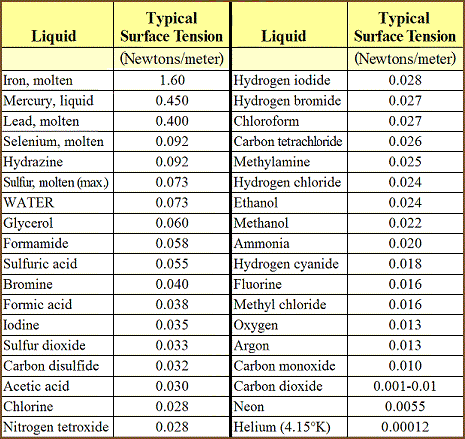 |
The swamps of Earth are inhabited by a fascinating variety of water beetle known to zoologists as Stenus. Thrown to the middle of a pond, these tiny creatures shoot to the safety of the banks at the water’s edge. The method of propulsion is not unlike that used by toy camphor boats: surface tension.
Surface tension is a property of all liquids, causing them to adhere to themselves at the interface between fluid and atmosphere. This tension represents a considerable force, and many insects such as water striders are elevated above water entirely by this support.
Stenus not only uses the surface for support, but for propulsion as well. By secreting a substance similar in action to camphor, the surface tension behind the organism is lowered. The resulting imbalance of forces causes the beetle to be drawn forward rapidly.
The data in Table 11.1 suggest that few liquids can compete with water in terms of providing useful energy for surface tension locomotion. Picture a propulsive appendage with reduced tension on one side only. Table 11.1 gives the maximum available force along each meter of appendage for which the surface tension is lowered from its normal value down to zero.
How large could an alien surface-sprinter be?
Let’s assume 100% efficiency, propulsive appendages one millimeter in radius with the approximate density of water, and a total length of all propulsive strands of a hundred meters when unfurled.
If such a creature totaled 2 kg in mass, it would theoretically be capable of accelerative bursts on the order of 0.4 gees — the approximate rate achieved by Olympic-class human sprinters. The bundled threadlike appendages would represent 16% of the total body mass in this case. If only a tenth as much acceleration is required, our surface tension beast may weigh as much as 20 kg, with appendages a mere 1.6% of the total.
There are other forms of surface locomotion. The basilisk lizard of Central America has the unique ability literally to walk on water. (Locally, this has earned it the appellation "lagarto Jesus Cristo.")
This small but active reptile, biologically related to the desert iguana, speeds across lakes with a gait suggestive of the hasty canter of a terrestrial biped. This ability is of tremendous selective value, since by scurrying along the water’s surface the animal avoids aquatic predators as well as its enemies back on shore.2433
The basilisk is a cold-blooded animal, so a warm-blooded ET might be expected to do much better. The coordination and agility required at such high speeds could provide the challenge necessary for the evolution of intelligence on another world.
| Rowing |
What about the principle of the rowboat? Rowing consists of a series of power strokes by which oars move backwards relative to the boat, thus driving it forward. Is it possible that extraterrestrial animals could copy this idea and, fantastic as it may sound, row across the surface of the sea?
Mother Nature has provided ample precedent. The hexapodal water beetles Dysticus and Acilius, and an insect known as the water boatman (Notonecta), use their middle and hind legs to row themselves along near the water’s surface. Hairs on their appendages have a distinctive oarlike appearance, and it has been calculated that this method of locomotion could be as much as 45% efficient energetically.230 The platypus, a far larger animal, may also be said to "row."
|
Certain spirochetes have flagellae driven
by tiny ionic motors complete with rotor, stator, bushings and drive shafts. |
| Flywheels and paddlewheels |
It is often asserted that rotating structures such as flywheels and paddlewheels cannot be used in living organisms, because "all parts of the body must be connected by blood vessels and nerves." This simple objection contains two hidden fallacies.
First, it is now known that certain spirochetes have flagellae driven by tiny ionic motors complete with rotor, stator, bushings and drive shafts.2432 The feisty bacterium E. coli, for instance, comes equipped with a rotor spinning at roughly 60 cycles per second (just like the alternating current from a wall socket). Although admittedly small in size, this micromotor involves an axle which spins around its long axis through a kind of universal joint. It is in no way connected directly to the main body — save through the rotating armature itself.1661
This finding contradicts the common assertion that living organisms may not contain detached, self-rotating parts.
|
Many strong paddlers have evolved on this planet.
The duck, for example, is efficient enough to propel herself through the water at a stately three kilometers per hour. |
Second, there really is no need to design a paddlewheel as a true rotating assembly. Fins may be stuck out, scooped through the water, and retracted again in regular sequence. This would provide both the appearance and the motive power of a true paddlewheel.
Many strong paddlers have evolved on this planet. The duck, for example, is efficient enough to propel herself through the water at a stately three kilometers per hour.1006
Paddlewheel aliens thus may not be excluded a priori.
Wind power is yet another largely unexplored avenue of water surface locomotion. The possibilities are barely hinted at by the fauna of this planet. Whales are known playfully to dive underwater, leaving only their giant broadleaf tails exposed above the surface. These lighthearted leviathans then "sail," catching gusts of air on their huge tail vanes and drifting with the wind for hundreds of meters before they’re forced to come up for air.5522 (Since it is far more efficient to swim than to sail, this is presumably a form of play.)
Let’s carry the idea to its logical conclusion.1946
| Living clipper ship |
Imagine a mollusc-like organism with a moderately thick concave shell which inhabits the coastal shallows of another world. Over the years this alien species acquires the ability to float boatlike on the inverted shell, drifting with the shore currents slowly across the face of the planet. Such creatures might feed on floating plant life such as surface scum or the tops of seaweed stalks.
With evolution, the shell might become better adapted for navigation, perhaps developing a more streamlined underbelly. This would allow the ET to better chart its course between patches of food. Eventually it would discover that its speed could be significantly augmented with a crude "sail," a thin membrane growing up out of the animal’s back.
In time, the membrane could become retractable, or even delicately manipulable by muscles. With the emergence of a brain and sensory organs strictly comparable to molluscs on this planet, a kind of living clipper ship might evolve — complete with masthead (forward sensors), jib, mainsail and riggings (extensible tendon), and probably a rudder. The minds of such lifeforms could be truly awesome.
What other glorious mysteries may await us in the star-dusted depths of space?
|
Figure 11.2 How Many Legs? |
|||||||||||||||||||||||||||||||||||||||
|
|||||||||||||||||||||||||||||||||||||||
| Universal locomotive device |
The surface of a terrestrial planet is a very crude, rugged environment, vastly less homogeneous than either sea or air.
- There are rivers to be forded, forests to be traversed, craggy crevasses to be leaped, and sand and mud and swampy bogs to be waded.
- Travel by land thus demands the development of extremely versatile locomotive techniques.
Xenologists find Earthly zoology most instructive in this regard.
- Here, the vertebrates and the arthropods are the only major animal groups which have proved adaptable enough to fill virtually all available planetary niches.
- Curiously, they are also the only two groups that have heavily exploited the mechanical principle of rigid levers in locomotion.
- The implication seems to be: Successful phyla use struts.
The ambulatory limb is probably the closest thing to a "universal" locomotive device for surface travel. But how many legs will aliens have (Table 11.2)?
|
The implication seems to be:
Successful phyla use struts. |
On strictly mechanical grounds, three points are needed to geometrically define a surface plane. Two points define only a line. Any ET attempting to stand on only one or two points of contact must be unstable — almost by definition. A minimum of three legs would seem to be necessary.
Tripedalism appears to have little to recommend it. All organisms will be designed for dynamic rather than static conditions. But when the three legger walks, it must lift one foot off the ground. The instant it does so, it is no longer supported by a three point platform but merely by two — which is dynamically unstable. From an engineering standpoint, four legs would allow the organism to remain balanced while one leg was moved to walk.
Still, the creature may not mind unstable walking. Bipedalism has been quite common among the birds, reptiles, and mammals of Earth, and should actually be favored on low-gee worlds.736 But it seems difficult to plead for the existence of extraterrestrial tripeds when two legs seem easier to operate and maintain.86 And then there is the old argument that appendages will always come in pairs, because of our origins in the sea and the need for hydrodynamic symmetry.2435, 2436, 2437
However, xenologists remain unconvinced by such reasoning. They dismiss the stability problem as academic, recalling that most running bipeds and quadrupeds keep only one or two limbs on the ground during the locomotary cycle (as in the pace gait, or the trot, the rack, or the gallop). Also, terrestrial animals in the same general weight class also have roughly equivalent vestibular balancing equipment, so going from three to two legs probably wouldn’t save much there.
| Facultative tripeds |
As for the objections to unpaired limbs, they are pragmatic but unpersuasive.* Many dinosaurs, such as Tyrannosaurus rex, and a few large contemporary organisms, such as the kangaroo, run bipedally but stand tripedally. These creatures’ tails are as thick and strong as the forelegs, and are regularly used as postural support. Furthermore, when kangaroos fight they are known to rear up on their tail to free both legs in order to deliver crushing kicks at their opponents.450 In some sense, then, these massive marsupials may be considered "facultative tripeds."
Pure tripedalism appears rather rare on Earth, but this is insufficient to rule it out elsewhere. Advanced aliens on other planets may have different evolutionary ancestors than we. For these reasons, xenologists expect to find at least a few intelligent three-legged species in our Galaxy.
At the heart of the multipedia controversy is the issue of neural control. How much independence of movement is each appendage to have? Must quality be sacrificed for quantity?
Humans and other primates, basically quadruped in design, have: full and complete control of each of the four limbs. But there is some recent evidence that other four-leggers are not so fortunate.
| Odd appendages |
* Odd appendages are often used for highly specialized tasks, as with the trunk of the elephant, the prehensile tail of primates and the sea horse, the hind catapult bar of the spingtail insect, the Ichneumon ovipositor and the scorpion’s massive stinger.
At moderate speeds, horses appear to be naturally predisposed toward either of two distinct natural gaits. One is the trot, in which the diagonal legs swing in unison. The other is the pace, with the two limbs on the same side swinging together. It turns out that a horse which trots cannot be made to pace, and vice versa, without extensive training in special harnesses.400
So even among quadrupeds there is a hint of pre-programmed leg motions. Many otherwise perfectly acceptable gaits are generally ignored — four-leggers have twelve symmetric gaits available, but only about four of these are used much at all.2439 The hexapodal insects are still more wasteful. With a total of some thirty-six symmetric gaits available, cockroaches and flies use just two. Limb movements have become almost totally "hard-wired."
The extreme case of the centipede and millipede drives this point home. These creatures perambulate by sending a single signal pulse the length of their partitioned bodies. As the message reaches each segment in turn, the connected limbs automatically sweep forward, robotlike, in a downsloping arc. (Otherwise, the appendages do not move at all.) It is quite impossible for a millipede to wiggle just one leg.
|
In the typical mammal: To actuate the muscles:
Processing of visual data:
|
As a general rule applicable to extraterrestrial lifeforms, then, we might suspect that fewer limbs means more control per limb. But why? The late John Campbell and others have suggested that extra arms and legs means extra demands on the brain. Six legs are impossible in large aliens, asserted Campbell, because there would be substantial neural-coordination problems in guiding so many limbs.1380 No brain could meet such an enormous challenge.
Most xenologists today would probably dispute this contention.400 The neurological equipment needed to operate an additional appendage is far less complicated than the circuitry required for, say, an extra eye. While the processing of visual data takes millions of neuron interconnections in the typical mammal, that same organism requires only on the order of thousands to actuate the muscles independently.501
We see that only a relatively small slice of the brain is dedicated exclusively to motor control, whereas about one-third of the entire organ is wholly committed to sensory functions. It should therefore be orders of magnitude less difficult to add extra arms and legs to ETs than extra eyes.
|
It should therefore be orders of magnitude
less difficult to add extra arms and legs to ETs than extra eyes. |
There are many who seriously believe that hexapodal aliens are quite plausible.1216 One recent fan of hexapedia is Bonnie Dalzell, a writer trained in paleontology who has been called "the best designer of alien life in the United States."2423
Ms. Dalzell insists that vertebrates on Earth have four limbs solely because of their common descent from fishes adapted to free-swimming conditions in large, open oceans. Fish needed only two sets of independent diving planes to maintain stability as their powerful tails drove them through the water. Perhaps if we had evolved from the Euthacanthus, a fish which lived in the Devonian Period with no fewer than seven pairs of fins, we might be hexapodal or more-podal today ourselves.1222
|
Figure 11.3 How Many Fingers? |
||||||||||||||||||
|
| The original amphibian |
So, assuming ETs have limbs, how many digits (i.e., fingers, toes) are they likely to possess (Figure 11.3)?
It is generally believed by paleontologists that the original amphibian, ancestor to virtually all lifeforms on land, had a hand with five digits. However, it has been admitted that this really cannot be accurately determined because of "the imperfect state of the earlier fossils."223 Many authors have postulated that one or two additional digits might have existed.
In fact, a few fossils are known in all three major tetrapod classes — mammals, reptiles, and amphibians — which appear to have marginal bony vestiges from a piscine ancestor.223 There is precedent for multidactylism among the fishes. The Sargassum fish, to take one example of many, possesses pectoral fins which operate like tiny ten-fingered (decadactyl) hands.586 But this does seem to push close to the upper limit: It is difficult to understand how more than ten digits could be of utility to any animal.
|
There is a general evolutionary trend |
There is a general evolutionary trend toward a reduction in the number of digits, especially in runners and swimmers. The adaptation to running commonly proceeds in two stages. Dactyls are lost when the animal first switches to running, taking on a "digitigrade locomotion" — walking high up on the fingers. In later stages, the animal progresses to "unguligrade locomotion" — or walking on the fingernails (hooves).
The size of hooves is markedly influenced by the environment. Dwellers on shifting sands and mushy marshes develop larger, flatter ungulae. Mountain dwellers, on the other hand, retain smaller, pointed, digit-like hooves. For instance, the African kopjes appear to be standing on tiptoe — a specialization for rocky terrain and for taking advantage of every slight irregularity along narrow ledges on cliffs.223 Ungulates tend to be herbivores.
|
Lost dactyls: The thumb always the first to go |
| Ancestral pentadactylate |
The ancestral mammal is thought to have been pentadactylate with an (at least partially) opposable thumb. Unfortunately, when dactyls are lost this is always the first to go. But exactly how does an animal lose its thumb? The first digit vanishes more often in the foot than in the hand, which suggests that you will lose your thumb if you walk on it.
Also, animals who use their extremities for non-arboreal progression — such as locomotion across level ground rather than by swinging through the trees — do not retain the digit. However, the mandate to remain arboreal is not infallible. The thumb has retrogressed in many arboreal forms (such as the sloth) when the digit is not used for grasping. Reduction in number seems to be the penalty for disuse.223
Environment plays a key role in determining what evolves. For instance, Dalzell expects to find six-leggers on worlds with small, shallow oceans. There, bottom-dwelling fishes would be the predominant marine lifeforms early in evolutionary history, occupying coastal and freshwater environments. If the planet had a very seasonal climate, perhaps accompanied by large-scale periodic evaporation of shallow seas, then few fishes would have the chance to evolve into highly efficient swimmers — as evidently occurred on Earth.
With little open ocean available during most of the year, potentially adept swimmers might not find it a very profitable niche to occupy. The bottom-dwelling many-finned fishes and crabs would inherit the land instead, and go on to produce a rich variety of hexapodal alien lifeforms there.
|
Earthly insects with three pairs of legs are hardly
noted for their well-developed mental powers but most of them walk just fine. |
Many advantages can be cited in favor of hexapedia. On a high gravity world, for instance, each leg would support far less mechanical stress than those of a quadruped of similar mass in the same environment. This should be of great selective value. An additional consideration is that the loss of one limb through accident or misadventure would be less serious for six-leggers than four-leggers. It’s always good to have spares.
Another advantage is better balance. Hexapodal locomotion provides a stable support tripod for the ET even at high speeds, unlike quadrupedal running.2605 And as pointed out earlier, there should be no problems with coordination, Says Dalzell: "Earthly insects with three pairs of legs are hardly noted for their well-developed mental powers but most of them walk just fine."736
Prophetically, Sir Richard Owen, a British paleontologist of some repute, wrote nearly a century and a half ago (1849):
We have been accustomed to regard the vertebrate animals as being characterized by the limitation of their limbs to two pairs, and it is true that no more diverging appendages are developed for station, locomotion, and manipulation. But the rudiments of many more pairs are present in many species. And though they may never be developed as such on this planet, it is quite conceivable that certain of them may be so developed, if the vertebrate type should be that on which any of the inhabitants of other planets are organized. The conceivable modifications of the vertebrate archetype are very far from being exhausted by any of the forms that now inhabit the Earth, or that are known to have existed here at any period.2422
|
The giant clam of Earth has reached
masses of more than a third of a ton. |
| Monopeds |
Despite the tremendous versatility of legs, there are many other kinds of locomotion possible on land in specialized niches. The freshwater clam, for example, has a single hatchet-shaped muscular foot protruding from its shell which allows it to plow along the bottom at a leisurely pace.
As the organism "walks" its foot is thrust forward through the bivalve shell. Blood flows into many sinuses, causing the organ to expand and anchor the animal securely. Retractor muscles contract, pulling the clam a few centimeters forward. Blood is then drained from the foot, which shrinks and is withdrawn from the sand. The cycle repeats.
The giant clam of Earth has reached masses of more than a third of a ton. It is entirely possible that huge pelagic lifeforms may scour the bottoms of alien lakes and streams in this fashion.
Another monoped is the common snail, which slides along on a cushion of slime. Its movements are similar to those of the clam, but its foot doesn’t appear to move much at all. This is because the snail takes shorter "steps." The creature advances in a peculiar loping motion by forcing a wave of tension down the length of its foot. This oscillatory thrusting causes it to slide gently forward.
One of Larry Niven’s fictional extraterrestrials, the Bandersnatchi, locomotes in this way.
| Tube feet |
Although there are no direct large-animal analogues of the protozoan pseudopods of amoeboid movement,* the "tube feet" of the starfish might be considered a distantly related metazoan form. Starfish, sliding silently over rocky surfaces, give no hint of the source of the graceful fluidity of motion. But upon turning one on its back, one sees hundreds of tiny sucker-tipped tubes lining the underbelly. These are the tube feet, opening into a water-filled canal running the length of each of the five arms.
| Ski foot |
By pumping water in or out of the canal, the organism can control the actions of its feet. Motion is very rapid: The tubes are pushed forward in the direction of travel and then fixed by their suckers to the rock. Successive waves of tension and relaxation waft the animal along. ETs too may try this trick.
There are many alternatives that have never been tried on Earth. A world covered with vast tracts of snow, one writer has suggested, might favor aliens with feet shaped something like skis or snowshoes. Or, creatures in such a habitat might evolve bodies shaped like snow sleds. (It is well-known that Antarctic penguins, with few predators around to disturb them, can travel faster by tobogganing on their bellies than by walking.2157) An ice planet could give rise to extraterrestrial critters with cleats or specialized treads to improve traction.
On a flat world with few large lakes or oceans, great furry globe-shaped creatures might be found rolling serenely across the landscape. There are precedents for this on Earth: The tumbleweed of the American Southwest (Sisymbrium altissimum, or tumbling mustard) and the wheel-like motions of various spherical seeds. The extinct trilobite could curl itself into a smooth ball capable of rolling downhill, and wood lice and certain other arthropods retain this ability today.
| Track star of the amoebas |
* Amoeboid locomotion, whether by "ectoplasmic contraction" or protoplasmic streaming, is extremely slow. The track star of the amoebas, Flabellula citata, can only make about 0.1 body-lengths/second forward motion.48 Large alien amorphs probably could not better this by much.
|
The evolutionary process: Never invented the wheel on Earth |
| Rotary motion |
Other adaptations of "undoubted utility," such as the possibility of tractor treads in swampy environments, have been put forth lightheartedly from time to time. The potential of rotary motion seems to cry out for fulfillment. And yet the evolutionary process has never invented the wheel on Earth, and Carl Sagan explains why:
Why are there no wheeled spiders or goats or elephants rolling along the highways? Wheels are only of use when there are surfaces to roll on. Since the Earth is a heterogeneous, bumpy place with few long, smooth areas, there was no advantage to evolving the wheel. We can well imagine another planet with enormous long stretches of smooth lava fields in which wheeling organisms are abundant.15
Of course, rotary motion is not unprecedented in the animal kingdom. We have already seen that E. coli has a tiny rotor motor to drive its flagellae. But consider instead the significance of pearl production in oysters, initiated by tiny grains of sand or other microscopic irritants.
| Caster creature |
Imagine an alien world the size of Earth, with continental shelves well-flooded to a depth of tens of meters during warm spells. A creature not unlike the molluscan cuttlefish Sepia hovers near the bottom, stalking small fish, shrimps, and crabs. Occasionally, sand particles enter its water-jet exit portals, clogging them up. The body responds by encasing them in perfectly smooth spherical pearls, much like the modern oyster.
After millions of years, an Ice Age arrives and the water slowly recede. There are few mountains due to extensive erosion, and the retreating shoreline leaves behind vast tracts of smooth, exposed continental surface. We might imagine our cuttlefish species, forced to live in ever shallower waters near an increasingly turbid bottom, evolving into a kind of "caster creature."
Its several jet ports permanently plugged by large pearly structures, such an alien might develop the ability to roll along the smooth continental raceways. Its speed would be controlled by internal contiguous sphincters, aided by heat sensors to allow guided braking on downhill stretches and a "low gear" muscular assist for steep climbs. Degenerate tentacle arms could provide additional stability on fast runs along the coastline.
The caster creature, hotly pursued by interstellar astronauts or xenozoologists, might prove rather difficult to capture!
|
The ability to fly has been evolved by each
of the three major animal phyla of Earth. |
The air is such a useful niche that it will probably be occupied on any world with atmosphere. The ability to fly has been evolved by each of the three major animal phyla of Earth. Among the molluscs there is a cephalopod of the genus Omnastrephes, often called the "flying squid," having broad lateral flippers or fins which allow it to leap far out of the water. Most prominent among the arthropod fliers are the insects, whose aerial acrobats are well known.
The chordates too have many avian species. Flying fishes (e.g., the "flying gurnards") can leap from the water and glide hundreds of meters before touching down. The South American Gastropelecus has been observed to progress through the air by rapid beats of the enormous pectoral muscles of its fins. With its keel hardly cutting the water’s surface, this fish eventually emerges into true (but not prolonged) powered flight. The Catalina Flying Fish is also reputed to be a strong flier.224
|
The unique challenge of powered flight: The central problem is the need for a high power/weight ratio to generate enough power to get above the stall speed (the slowest an object can fly and still remain aloft) |
Reptilian gliders are widely known, including the extinct giant pterodactyl (9-12 meter wingspan) and archaeopteryx, the flying lizards (Draco), the so-called Flying Snake of Borneo, and so forth. Birds are an entire class of chordates subscribing to an avian existence, and most members of Aves can fly. There are also the gliding mammals, such as the flying lemur and the many species of flying squirrels, and flying foxes and bats beat the air with their wings much like birds. There are at least three species of aerial marsupials.450
Powered flight presents a unique challenge for lifeforms on other planets. The central problem is the need for a high power/weight ratio — that is, to generate enough power to get above the stall speed for the design and into the air. (The stall speed is the slowest an object can fly and still remain aloft.)
|
Figure 11.4 Avian Power Utilization Curves2426 |
|
|
Power required for flight is high during hovering (far left of each curve) and greatest at high velocities (far right of each curve) than at the intermediate "optimum velocity" in the trough. Small avians such as pigeons tend not to have serious power/weight ratio problems. Continuously available muscular energy is sufficient to propel the animal comfortably through a wide range of speeds (shaded area in trough). Short duration "sprint power" permits an even wider velocity range, and is often enough to allow jump-takeoffs from a standing start ("grasshopper effect") or brief periods of hovering. Large avians such as vultures and albatrosses are not so fortunate. Their power/weight ratio is too low to allow protracted flight even at the optimum velocity for their wings. Hence, the large aerial animal must find a long run way, or dive from a high perch, to reach stall speed (the minimum for flight), and then use short duration sprint power to remain airborne long enough to attain optimum velocity and begin relatively exertionless soaring flight. |
Typical power utilization curves for extraterrestrial avians are shown in Figure 11.4. (The exact details of the curves are governed by something called the Reynolds number of the wing, which relates power consumption to the actual shape of the airfoil.) As we see, for any given wing shape and given atmospheric conditions, there is some optimum velocity at which minimum power is required. Flying faster or slower is less efficient and costs more energy.
If the creature flies too slowly it cannot remain aloft, and will stall out. The speed at which this stall occurs is inversely proportional to the square root of the density of the atmosphere.224
Given the same aerodynamic design, avians on a world with air as thick as the atmosphere of Venus could remain airborne at speeds ten times slower than on Earth. Conversely, on planets with Martian-thin air the stall speed would be ten times faster than on Earth.
Stall speed is also inversely proportional to the square root of the surface area of the wing.
An ET with huge wings can fly much slower — and not stall out — than an avian with the same shape but with tiny wings. An alien with 100 m2 of wing should be able to cruise as much as ten times slower than a creature of similar design with only 1 m2 of airfoil — assuming identical atmospheric conditions.
|
Primary determinant of avian size: Atmospheric pressure not gravity as many erroneously believe< Gravity and pressure are unrelated High gravity does not imply high surface pressure For instance Venus, our sister planet has
|
Exactly how do we go about designing an extraterrestrial avian?
On Earth, the albatross is pretty close to the maximum. This 10 kg bird has been known to achieve wingspans of up to four meters. (The most massive aerial animal that has ever lived probably weighed less than 20 kg, although there are reports of an enormously fat cock bird shot down over the Transvaal in 1892 which measured 24½ kg.360) The albatross requires a lengthy "runway" for takeoff. When it lands, it must use wing flaps like a commercial jetliner to lower the stall speed sufficiently to land safely at about 20 kph.
The primary determinant of avian size turns out to be atmospheric pressure, not gravity as many erroneously believe. It should also be pointed out that the two are unrelated. High gravity does not imply high surface pressure, as is clearly demonstrated by the members of our own solar system. For instance Venus, our sister planet, has 9000% more pressure but 12% less gravity than Earth.
A good empirical relation that seems to work well for most aerodynamic lifeforms is: S = 0.24P-1(MG)0.82, where S is total wing surface area (m2), P is air pressure (atm), M is total body mass (kg), and G is planetary surface gravity (Earth-gees).1749
So on high pressure worlds, alien avians can make do with vastly smaller wings. If larger wings are retained, massive bodies can be maintained aloft. An extraterrestrial with the mass of a man, standing on the surface of a one-gee, 5-atm world, could fly with the wings of an albatross. An albatross, on the other hand, could make do with less than half the original wingspan. On a 100-atm world, the 10 kg bird could be supported by stubby finlike airfoils a mere 30 cm in breadth.
|
Figure 11.5 Power Requirements for Active Flight vs. Walking Compared, for Earth-Dwellers |
|||
Full line at lower right indicates the power/weight ratio needed to sustain steady flight. Animals in the hatched area generate insufficient power to fly. Values are calculated on the basis of aerodynamically optimal wing design, at the given mass on a 1-gee planet. This "minimum power" line varies for different worlds, and in fact: P ~ 1/SQRT(r) and P ~ g where P is the minimum power for flight, r is the atmospheric pressure (or density), and g is the minimum power for flight, r is the atmospheric pressure (or density), and g is surface gravity. Horsepower may be converted to watts by multiplying by the factor 745.7 watts/horsepower.
Minimum cost of transport is given both for surface and for aerial niches. Open circles are the insect data, squares are for birds, and filled circles are land mammals. The values represent the coat to an animal of transporting one kilogram of its bulk one kilometer of distance. Note that it is generally much cheaper to fly than to walk or run, except for very large organisms. The best-fit curves for the above data are as follows: AIR: Cost : 1.25(MG)-0.227 LAND: Cost 10e-1, e = 1.67(MG)-0.126 where M is total mass of the animal (kg), G is planetary surface gravity (goes), and "Cost" is in Kcal/kg-km. Kcal may be converted to joules by multiplying by the factor 4190 joules/Kcal. |
Low-pressure worlds are not amenable to large avian lifeforms (Figure 11.5). Lift falls off rapidly, and nothing more massive than perhaps a small pigeon would be able to take to the air. The force of gravity plays a secondary role in fixing the size and flight characteristics of extraterrestrial bird life. On a heavy 2.2-gee planet, the wing area would have to be about 90% larger than an Earthly avian of comparable design. On a bantamweight 0.16-gee world, wing area could be reduced by as much as 80% without losing the ability to fly.
Gravity also affects the stall speed. In fact, the minimum velocity at takeoff ~g1/2. This has several interesting consequences.
On a 2.2-gee planet the stall speed would be about 50% higher. An extraterrestrial heavy-world albatross would require a correspondingly lengthened runway to get off the ground.
| Grasshopper effect |
The problem of takeoff is greatly simplified on lighter planets. At 0.16 gees, liftoff occurs at a speed 60% below the nominal Earthly value for the same animal. Avian ETs could perhaps take advantage of what has been called the "grasshopper effect": An animal the size of a large pigeon could easily hop into the minimum airspeed from a standing start on the ground.86
In light of all the evidence, we are most likely to encounter large, intelligent winged avians on relatively small worlds with high atmospheric surface pressures.
|
Using the principle of economy,
extraterrestrial avians will have one pair, or at most two pairs, of wings. |
The first winged insects on ancient Earth probably had no more than three pairs. A few modern insects retain vestigial traces of the third pair, notably the Stenodictya of the Order Strepsiptera.1212 By and large, however, aerial arthropods have cut down on the number of wings. Locusts, ant lions, fishflies, termites and aphids each have two pairs apiece, but a single pair is far more common in the animal world,
There are good reasons to reduce the wing count. The usual arrangement is a single pair, which serves more or less in the capacity of a helicopter rotor — that is, to generate active lift. Another less common design is to use one pair of wings to generate passive lift (like the wings of an airplane) and a second pair taking the more active role. (Beetles come close to doing just this.) But no useful purpose is served by adding more wings, which would only interfere with the smooth airflow and ruin the aerodynamics of the design.1212
Using the principle of economy, extraterrestrial avians will have one pair, or at most two pairs, of wings.
Or they may have no wings at all. Thus far we have discussed only the most common techniques of flight known on Earth. But there are many other — wingless — ways to get into the air. On this planet, the principles of the rocket, the kite, and the balloon have not been widely exploited.
Imagine a world with a thick atmosphere rich in oxygen and abundant seas. Evolution might favor large but slow-moving insects as discussed earlier in connection with respiration. We might expect a kind of "rocket fish" to arise near the coasts, feeding where such insect life swarmed thickly in the air.
Like the small plastic toy projectiles that shoot high into the air when fully charged with water and compressed gas, the rocket fish suddenly would bolt from the sea skyward and mouth their aerial prey at high speeds. To be able to eat on the run, this jet-propelled alien predator has to evolve a sturdy posterior pressure canister which can be discharged rapidly through a rigid nozzle. The rocket fish might have a recycling time on the order of minutes, and might charge their canisters using osmotic pressure.
|
A low gravity planet with fast rotation
and a thick atmosphere could be ideal for the evolution of parachute beasts. |
Another class of alien creatures might take to the air on other worlds. A low gravity planet with fast rotation and a thick atmosphere could be ideal for the evolution of "parachute beasts." These ETs could travel virtually anywhere for free, simply by extending their retractable ‘chutes. With strong winds, they could tack across the planetary surface. With a good stiff breeze, even fairly massive parachute beasts could kite hundreds of kilometers each day without effort.
There is some precedent among Earthly fauna. In the majority of spider species, aerial dispersal of the young takes place. A spiderling crawls to the end of a blade of grass or other protuberance, raises its tiny abdomen, and lets fly a thin thread of silk into the wind. As the gossamer strand is caught by a breeze, the spiderling leaps from its perch and climbs to the middle of this floating "magic carpet." Air currents carry the animal to considerable distance: Spider threads have been sighted at least as high as 8 km and as far seaward as 500 km from shore. Couldn’t extraterrestrial "hang gliders" do just as well?
The idea of the balloon principle in relation to living organisms is a common one, both in science and science fiction.20, 442, 2427 It appears, for instance, in a nineteenth-century novel by the French writer Charles Ischir Defontenay — Psi Cassiopeia (1854):
Here is what the Starian naturalists say of this animal, which they call the psargino: Its skin, which has great extensibility, is only attached at the eyes, the mouth, the other natural openings of the body and the soles of the feet. Over the rest of its expanse, it is only juxtaposed to another membrane or internal skin having the property of secreting, at the animal’s will, {hydrogen} gas. The psargino, thus surrounded by gas, becomes a sort of balloon lighter than the atmosphere, and it makes use of this property to rise into the air and escape its enemies. A kind of aperture furnished with valvules on its abdomen relieves it of part or all of the gas burdening it and serves for descent to earth when the predator has lost its track.564
|
Spider species: aerial dispersal of the young
Air currents carry it a considerable distance
|
Bonnie Dalzell has designed an "airship beast" for a planet with cold winters, heavy gravity and a thick atmosphere.736 Twice a year this herbivorous 100 kg animal inflates its lifting bags with metabolically generated hydrogen gas* and drifts to the opposite hemisphere to avoid the cold. Strong winds are an advantage, but predators are widespread. And many of these living balloons are lost during their semiannual migration when lightning from an electrical storm strikes and ignites their bodies.
There are a few indirect precedents for such a creature among the lifeforms of our own world.2574 For example, the Portuguese man-of-war (Physalia) is a shapeless, baglike marine organism whose large air sac serves both as a float and a sail in the water, Its numerous tentacles perform many functions, including stinging its prey into senselessness,
| Chambered nautilus |
Another creature even more analogous to the airship beast is the chambered nautilus. Some 3000 species of this animal once flourished in the primitive, shallow seas of our planet. They are found as deep as 700 meters, and although they measure a mere 0.2 meters today their ancestral forebears left fossil remains up to three meters in diameter.584
|
The nautilus is a miniature submarine, consisting of a series of
as many as forty individual chambers partially filled with air. All are connected by a thin tube called the siphuncle, which is thought to control the buoyancy of the animal as it dives and ascends in water. |
The nautilus is a miniature submarine, consisting of a series of as many as forty individual chambers partially filled with air. All are connected by a thin tube called the siphuncle, which is thought to control the buoyancy of the animal as it dives and ascends in water.
As the man-of-war and the chambered nautilus utilize the principle of buoyant lift in the seas of Earth, why could not giant living extraterrestrial gasbags ply the skies of alien worlds?
* Many bacterial photosynthetic autotrophs generate hydrogen metabolically. Examples include Clostridium, Chromatium, Athiorhodaceae, and green algae under certain special circumstances.
 |
| The point of biological activity |
Reproduction is unique among the many biological functions performed by living things. Take away an animal’s food or drink, or drain away its blood, or remove its skeleton, and death rapidly overtakes its enfeebled body. But deprive it of the ability to reproduce and nothing happens. The species may die out, but the individual organism lives on. Reproduction, while an enormous convenience, is not an absolute essential of life.
This is true despite all protests that duplication is "the point of biological activity."20 The vast majority of social insects never engage in personal reproduction, and such species are extremely successful. One highly evolved contemporary terran lifeform, the mule, is quite sterile.
It is relatively easy to imagine a nonsentient alien species designed such that, when mating occurs in a certain way or in a special environment, sterile but intelligent offspring are the result of the union. Clearly, there is no bar to the rise of intelligence in such a situation: Perhaps the hybrid’s brain mass or neural complexity is twice that of its nonsentient parents.
| Nonsentient breeders |
At any rate, we can conceive of a race of intelligent but sterile alien hybrids residing somewhere in this commodious Galaxy. Their numbers would be supported entirely by a subrace of nonsentient breeders. The hybrids would corral and manipulate the teeming parental population, much as stockmen raise cattle and stablemen breed champion thoroughbreds. An extraterrestrial culture based on this peculiar inversion of the standard parent-offspring relationship would be fascinating to observe.
|
The hybrids would corral and manipulate the teeming
parental population, much as stockmen raise cattle and stablemen breed champion thoroughbreds. |
Still, reproduction is not without its advantages. Whole-body duplication allows rapid expansion and fast evolution in new niches. We might expect that many, perhaps even most, alien races will involve reproducers.
| Universal lust |
When the first exploratory manned starships from Earth touch down on the continents and seas of distant worlds, will we discover that aliens, too, know sex? Is the uniquely human preoccupation with matters lustful more or less universal? If extraterrestrial lifeforms do enjoy sex as much as we, then exactly how many sexes do they enjoy? Two? Three? Ten? Might sex be alterable at will, or could more than one somehow be incorporated into a single individual? What about alien sex practices? Do ETs have orgasms? Are interspecies sexual relations possible?
The curious Earthling demands to know.
|
|
|
| Shuffling the data deck |
If reproduction is merely a useful convenience, we must admit that sex is pure luxury. There is no fundamental reason why evolution and diversity cannot thrive in its absence. There is no law against asexuality.
In point of fact, asexual reproduction is vastly more prolific in the short run. Bacterial lifeforms churn out literally billions of offspring in the space of hours, relying solely on such simple techniques as binary fission and budding. No "opposite sex" is required. And while it is true that many sexual species are also quite fecund, as a general rule fewer offspring are produced and survive to adulthood than among the asexuals.
Furthermore, asexual reproduction is good economics. An organism which copies itself without sex passes its entire genetic heritage to its young undiluted. Offspring are exact duplicates of the originals.
| Selfish gene |
A sexual parent, on the other hand, may contribute only half of its own genes towards the construction of a child. The other half, in the case of a bisexual species, must be donated by the other parent. From the standpoint of the selfish gene, sex has a lousy profit margin in comparison to no-sex.
Nevertheless, there is a more subtle difficulty with asexuality that turns virtue into vice.
|
[Asexual] Change spreads only
slowly through the gene pool. |
A completely asexual species produces a population of virtual duplicates — except for an occasional mutation. Since variation is the raw material of evolution, and the lack of sex decreases this variation, such lifeforms should be at a distinct disadvantage when competing with their sexual brethren. New genetic combinations in asexual species can only proceed through a sequence of fortuitous mutations in the same family lineage. Asexuals therefore must "stand in line" to wait for a series of rare mutations. Change spreads only slowly through the gene pool.1044
| Gene-jumbling |
But sex allows the accumulation of variation in parallel, rather than in series.1045 A sexual species is able to spread many new genes rapidly throughout the population, because gene-jumbling allows a new combination, a new throw of the genetic dice, with each act of reproduction. Rare mutations become widely dispersed. So great are the advantages of sex that even many normally asexual organisms have occasional sexual encounters to beef up the waning gene pool. This is especially true in harsh or rapidly changing environments.
For example, the freshwater hydra and the aphid reproduce asexually for most of the year. As winter approaches, with hard times ahead, these animals switch over to sexual reproduction. This ensures genetic diversity when the colonies disband and disperse with the arrival of cold weather.
In the billion years or so since its invention, sex has proven remarkably successful — if we are to judge from the fossil record of life on this planet. Sexual species have come to dominate the animal world, and the most widespread and important groups are all but exclusively sexual in their mode of reproduction. These broad brush strokes of nature should paint a similar picture elsewhere in the universe.
Of course we don’t know if aliens have genes, or even if information-carrying molecules are necessary at all. For all we know, extraterrestrials may reproduce by xerography85 or in direct response to the environment by inheriting acquired characteristics.22 But one fact is clear: Variability is an advantage in the quest for biological complexity. And sex provides a unique opportunity for shuffling the data deck — genetic or no — which asexual techniques simply cannot match.
If sex is necessary, then how many sexes are best? Can there be more than two?
| Multisexuality: few and far between |
Terran lifeforms provide several examples of multisexuality, although they are few and far between. The lowly paramecium, for instance, has between five and ten sexes — depending on how you count. These are distinct mating forms which arise at different times under definite conditions, and which can only mate in certain specific combinations. Another example includes fungi, notably Basidiomycetes, in which there are four distinct sexual groupings. Fungi are quadrisexuals. Still another example is found among the greylag geese — a rather clear case of behavioral trisexuality.455 (One goose "marries" and mates with two male ganders.) Multisexuality is clearly a viable alternative.*
|
Why, then, is the vast majority of sexual terrestrial
lifeforms bisexual? … Apparently, two are both necessary and sufficient. |
Why, then, is the vast majority of sexual terrestrial lifeforms bisexual?
The answer seems to be that two sexual partners are just enough to provide the requisite genetic recombination. Each healthy individual has a reasonable chance to mate with a member of the opposite sex. Apparently, two are both necessary and sufficient.
More than a single pair of sexes may seriously impair the chances for species continuity. The more sexes required for successful reproduction, the more difficult it becomes to bring them all together properly at just the right time. If there is a weak link in the mating chain — as where one member of a reproductive triad is characteristically vulnerable to certain predators or other environmental severities — the future of the entire species would be jeopardized. Finally, it is not clear how, say, three sexes could shuffle the genes very much better than two.
There are no compelling reasons to exclude the possibility of a thriving population of alien multisexuals on another planet. That is, extraterrestrial multisexuality cannot be ruled out. But requiring more than two sexes for reproductive activity seems to be an unnecessarily complicated solution to a problem elegantly solved by only two.
It’s a safe bet that bisexuality is the overwhelmingly dominant mode of sexual reproduction among the biological alien lifeforms in our Galaxy.
* Science fiction writers and many others have toyed with the implications of intelligent trisexual and multisexual aliens for years.
See especially Asimov,2485 Farmer,2500 Niven,753 Ritner,1550 and Stapledon.1946
Norms of marriage, inheritance, language, religion and social behavior would be profoundly affected by this state of affairs. Indeed, they might prove virtually incomprehensible to us. The normal social tensions caused by sexual competition would be greatly aggravated in a society in which every member was a potential mate. In their eyes, humans might appear perverted.97
| Heterothallism |
 The apparent general restriction of ETs to only two sexes is no cause for alarm. An incredible number of variations can be played on the single theme of bisexuality.
The apparent general restriction of ETs to only two sexes is no cause for alarm. An incredible number of variations can be played on the single theme of bisexuality.
For example, bisexuality — contrary to popular belief — does not demand the existence of distinct male and female forms. A case in point is the black mold Rhizopus nigricans, which displays an unusual type of sexual behavior known as "heterothallism."
| Plus and minus |
This species of fungus is bisexual, inasmuch as two organisms are required for fertilization and reproduction. However, the two sexes are indistinguishable! There are no constant differences between members of opposite mating groups other than their reciprocal behavior when crossed. Thus, it is impossible to designate one form of the black mold as male and the other as female. The complementary groups are labeled merely "+" and "-" for convenience during experiments.
One can imagine a race of intelligent extraterrestrials, apparently unisexual to our undiscerning eyes but which actually practices heterothallic sex. Such creatures would most certainly lack secondary sexual characteristics, those hormone-induced physical landmarks such as beards and breasts to which we humans are accustomed. They might even lack distinctive primary sexual characteristics such as internal or external gonads.
|
Intersexuality:
|
While we might expect maleness and femaleness to be well defined among most bisexual alien species, intersexuality constitutes a major exception to this rule. Intersexuality is a state in which an organism is neither strictly female nor strictly male. Rather, it displays some alternate, intermediate, or variable condition that lies somewhere in between.2494
There are two major classes of intersexes.
| Spatial intersexuality |
The first of these is illustrated by a strain of fruit fly (Drosophila) which has three copies of all its chromosomes instead of the normal two. In most bisexual hereditary systems, each parent contributes one set of genes — including the sex-determining ones — to the offspring. But with three sets, this special strain of fly can attain intermediate states of sexual expression. Using artificial breeding techniques, any desired degree of intersexuality may be arranged: 30% male/70% female, 60% male/40% female, and so forth.
These insects, and various higher animals such as the bovine freemartin (the female of a male-female twin pair in cattle), are called spatial intersexes. They are stuck with their ambiguous constitution for the rest of their lives. They cannot change, and are often sterile.
| Simultaneous hermaphroditism |
Hermaphrodites represent an interesting special case of spatial intersexuality. A "simultaneous hermaphrodite" is an organism which possesses at once both female and male sex organs. Ovaries and testes are present together in the same individual. Planarians, earthworms, annelids, sponges, hydras and snails exhibit this form of bisexuality.2493 A few vertebrate simultaneous hermaphrodites are known, such as the banded flamefish (Serranus subligarius).
|
But the intersexual animal can be a sex-mosaic in time as well as space. There are many organisms, of which the gypsy moth Lymantria is but one example, which start life as one sex and finish it as another. This condition, in which the two sexes are separated temporally, is called temporal intersexuality or "sequential hermaphroditism."
Sequential hermaphrodites come in many varieties. Protoandry is a system where an animal is first male, and later female; proterogyny is the converse, with young females metamorphosing into functional males as they age. And there are many other more complicated arrangements. Populations of sea anemones, for example, consist only of females and simultaneous hermaphrodites, a condition known as gynodioecy.
| Magnificent bisexual system |
What would a temporal intersexual extraterrestrial be like? We can take a few clues from the freshwater shrimp Gammarus pulex. Each individual crustacean is both male and female, but not at the same time. Newborn animals spend early life in a neuter stage, after which they pass through puberty and enter the first sexually active phase as functioning males.
After a while, the maleness is exhausted. Latent ovaries ripen into maturity, and the organism spends the remainder of its life as a full-fledged female. Eggs are shed by middle-aged mothers and fertilized by energetic youthful males (who are still in the middle of their first cycle).
It is a magnificent bisexual system, one that works quite well on this planet. No one is excluded from any phase of the reproductive process. Still more significant, each member of the colony plays both male and female roles during his/her life. This cannot fail to have major effects on the intensity and depth of interpersonal relationships among these beings. In the case of such hermaphroditic aliens, the impact on the development of society, patterns of competition and aggression, laws and government, and attitudes toward the young are scarcely imaginable. (Science fiction writers have had a field day with this theme.97, 226, 442)
|
…both male-first and female-first alien intersexuals
may be common, if not abundant, among the many intelligent extraterrestrial races in the universe. |
If there exist extraterrestrial hermaphrodites patterned after the freshwater shrimp on some other planet, what would their lives be like? Dr. Norman J. Berrill, Professor of Zoology at McGill University in Montreal, gives us some insight into the lifestyle of a temporal intersexual alien:
[Measured against a human yardstick], all half-grown individuals, about ten years old and weighing about 34 kilograms, would be males, the only males, ready to act as such both sexually and probably in other wayward ways. But as troublemakers like their truly human counterparts they would undoubtedly be kept in place by a closed society of matriarchs, roughly equal in number to the males, each twice the weight and much older and wiser. And not only wiser in a general way, but in the special sense of having each been a male herself, as understanding as a mother with a child and as little likely to put up with any nonsense, perhaps wistfully looking back to her youthful manhood. Girlhood would bud as usual when masculinity had faded, with growth continuing and full female maturity yet to come. Apart from lovelife the only question is, who would do man’s work? Little men browbeaten by large women who once had been little men themselves, or the women themselves, whether full-grown and breeding or not?89
Of course, the reverse of the above is also quite possible in ET races, although it appears much less common among the fauna of Earth. There is no reason why bisexual alien hermaphrodites could not develop along a cycle in which young females transformed into old males.
An example of this appears in the sword-tailed minnow (Xiphophorus helleri), a teleost fish that bears live young much as the mammals do. Xiphophorus females typically produce offspring until they are a few years old. Then, during a period of only a few short weeks, they take on the characteristics of the male of the species. They produce sperm and are capable of fertilizing females. Exhaustion of the ovaries is believed to trigger the changeover.
We see that both male-first and female-first alien intersexuals may be common, if not abundant, among the many intelligent extraterrestrial races in the universe.
 |
|
Males are necessary,
but only as a last resort. |
What about the fascinating possibility that extraterrestrials might be able to choose their sex voluntarily in some fashion? How much different the world would be if sex were a matter of choice rather than accident or compulsion! It would also matter a great deal whether the decision to switch was made by society, by pressing cultural or environmental exigencies, or by the individual himself (who might exercise his sexual option at puberty).
| Environmental exigencies |
Xenologists are convinced that optional sexuality is a real prospect for alien lifeforms because of the many times this system has arisen independently on Earth. One common transformation, found among starfish, the slug (Limax maximus), and the molluscan gastropods Crepidula plana and Patella, involves a changeover from male to female. The cause in this case is environmental. When necessary to maintain proper ecological balance, some members of the colony will voluntarily transmute from male to simultaneous hermaphrodite. Soon thereafter, they blossom into full females without any trace of maleness remaining.
Given the relatively major body alterations that occur during puberty in the higher mammals, it is not inconceivable that ETs might be capable of altering sex in response to the environment.
|
Each individual would have the advantage of
knowing the world from the viewpoint of either sex. |
Extraterrestrials may also be able to change sex as a purely personal prerogative.2863 Quite a few terrestrial creatures can switch back and forth between male and female on a regular basis — and at their own pleasure. The most notable examples include the oyster and the clam.
| Oysters and clams |
The native oyster begins its life as a male. After a year or two, it may change to female much like a sequential hermaphrodite. But after the animal has "ovulated" (deposited its ova into the mantle cavity), it becomes "white sick" and reverts to maleness.
While still carrying its own embryos, the female oyster can fully retool as a working male in a matter of weeks. Male and female phases typically follow one another, in irregular cycles a few months long. This ensures that all fertilized eggs are the product of different parents, and eliminates the problem of accidental self-fertilization.
Intelligent extraterrestrials modeled after the changeable oyster would probably experience fewer psychological conflicts, in many ways, than humans. Each individual would have the advantage of knowing the world from the viewpoint of either sex. Furthermore, the opportunity to assume the role of either mate at any time could encourage what some earthlings might regard as a promiscuous social and cultural code of liberal sexual behavior. Their political, legal, religious and humanistic traditions would doubtless reflect this added layer of complexity.
|
The female carries the egg.
This is the basic raw material of reproductive activity. On the other hand, the male’s function is clearly ancillary. He is expendable. |
While the sexual identity of aliens may be regulatable either by the environment or by the individual as discussed above, it may also be subject to sociocultural management. There is ample precedent for this on Earth. Numerous behavioral adaptations exist which allow colonies to regulate their sex ratio (the fraction of each sex in the population). These systems usually favor the female, and it is easy to see why.
The female carries the egg. This is the basic raw material of reproductive activity. On the other hand, the male’s function is clearly ancillary. He is expendable.
| Parthenogenic species |
Consider the purely "parthenogenic" species, in which the male is dispensed with altogether. In such systems of virgin birth, eggs develop into full adults without ever being fertilized at all. The sawfly is a case of an all-female species. All of their eggs develop into more insect females, with no males — or sex — required in the process.89 This amounts to practical unisexuality.
In less extreme systems, the male is not totally expendable but is still optional. A typical colony of the crustacean waterflea Daphnia is all-female, producing offspring by parthenogenesis like the sawfly. But at the first sign of trouble, such as overpopulation or the approach of winter, an interesting thing happens. The females "panic," and lay some eggs which quickly develop into males.
If the trouble passes without incident, the males have no duties to perform and are ignored by the females — who continue breeding parthenogenically as before. But if major difficulties do materialize, the females deign to use the male stud service to increase variability in the gene pool and ensure survival of the colony. Says one marine biologist of this arrangement: "Males are necessary, but only as a last resort."*
* Parthenogenesis (all-female reproduction) is not limited to insects. Many species of lizards, for instance, commonly reproduce without males.2583
|
Genetic three-caste system
|
So we might expect that if society has the final say, alien races will consist mostly of females when optional sex is available. Many females can be sexually serviced by a single male, so this choice is hardly surprising. What is striking and unusual is the degree of social stratification which frequently results. Biological caste systems are not uncommon.
| Apian assembly line |
Honeybees are a case in point. The focus is on the only fertile female, the queen bee. A hive’s queen mates but once in her lifetime, and then only with a single male and only on her nuptial flight.* All the eggs the queen will ever produce must be fertilized by the sperm stored from that single mating.
As a general rule only female offspring are produced, and the beehive is populated almost exclusively by sisters. Males appear only occasionally in small numbers, whenever a new queen is needed either to replace an aging matron or to found a new colony.
The apian assembly line is faintly reminiscent of Aldous Huxley’s Brave New World. All eggs start in the queen’s ovaries. If they are not fertilized they grow into male bees called drones. Most eggs, however, are fertilized and placed in tiny compartments in the hive. Those which are fed the regular pap of the drones mature into female bees called workers. Larvae raised on a specially enriched nutrient mix (royal jelly) grow into queens.
Notice that the honeybee has a genetically programmed three-caste system. Queens constitute the reproductive caste. Workers, while technically females, are really neuters because their sex organs are degenerate. They represent the laboring caste, able to carry on with the daily chores of the hive without the distraction of sex. The drones, or stud caste, are virile males who lack this admirable detachment and are not good for useful work. They are usually exterminated by the workers at the approach of winter.
* The penis of the male honeybee breaks off during mating, and he promptly bleeds to death. The severed organ remains inside the queen for some time thereafter, serving as a plug to prevent the semen from dribbling out.
|
Shortly after copulation, a sudden surge
of hormones automatically kills the male. … The price of love is death. |
Ant and termite societies have four castes — generally two classes of royalty and two classes of industrious eunuchs. As with bees, the queen retains many fertilized eggs in her swollen belly. Kinghood and queenhood is the reward for those few active larvae who are fortunate enough to make an early escape from the maternal womb. For the vast majority, however, the exit is delayed and a horrible thing happens to them: They begin to be reabsorbed back into the body of the gravid female. The longer they delay, the smaller they are at birth. The largest become soldiers, the smallest workers. (All are sterile.)
It is a kind of merit system. The more active the organism, the bigger its body and the higher its social status.
The extrapolation of a breeding system with genetic castes to a race of intelligent extraterrestrials has been attempted by science fictioneers Larry Niven and Jerry Pournelle in their recent collaboration The Mote in God’s Eye.668Their aliens, the Moties, have many tens of biological castes, each one specializing in a particular societal function. Depending on the details of birth, there are Engineers, Farmers, Mediators, Warriors, and so forth. Though the Moties are fictional, can reality be much less strange?
As suggested earlier, there is no real limit to the dimensions of bisexual reproduction. To some ETs, optional sex may mean more than mere changeability. It may mean instead the decision to reproduce, the option to mate, the choice between life and death.
Consider the common mole, Antichinus stuarti. These tiny animals have a brief but concentrated rutting season spanning only a few days in June. Shortly after copulation, a sudden surge of hormones automatically kills the male. This makes available greater quantities of food, water, and other critical resources for the pregnant female and, later, for the developing fatherless family.
The price of love is death.
Extraterrestrials patterned after such a scheme may exist on some arid world in our Galaxy. Could humans hope to fathom the psychology of an alien species in which marriage was the culmination of the life of every father, in which only females lived on from year to year and provided social continuity, and in which a single act of sex meant inevitable, almost instant, death? Conversely, could such sentient ETs comprehend our peculiar addiction to erotica, our marriage vows, our complex family life, our political institutions, or our social sexual mores and taboos?
And which of us would better know, and understand, the true meaning of ecstasy?
|
Table 12.1 Approximate Coition Times for Various Animals |
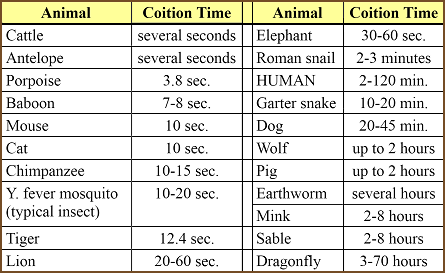 |
We have examined just a few of the many possible variations in pairwise reproduction. Bisexual aliens, who may comprise the majority of higher lifeforms in this Galaxy, will undoubtedly display an even richer variety of reproductive styles than we can imagine.
But exactly how will biological ETs execute their sexual functions? The fundamental need for a joining of male and female is clear, but the details of this fascinating operation (e.g., Table 12.1) remain indeterminate where ETs are concerned. Of course, it is far too early in our exploration of space to be offering detailed speculations on this matter. Nevertheless, the grand diversity of sexual practices among the fauna on this planet can give us some idea of what to expect from aliens. Earth is typically exotic; terrestrial animals are typically peculiar.
Consequently, we may demolish the age-old myth that it is the male who always chases the female. In crickets, it is the female who courts the male and later mounts him. ETs may conduct themselves in similar fashion.
| Biological chastity belt |
Another instance of the unusual: humans are not the only beings concerned with the virtuousness of their female mates. While men once fashioned chastity belts to keep their ladies safe, other creatures must improvise without the benefits of technology. The male garter snake, to take one example, is so suspicious of his companion’s attentions that he installs a "chastity belt" inside his mate after copulation. This hardened plug effectively ensures the fidelity and continued continence of the female.
|
But what is taking place is not breeding in the proper sense of the word,
but only a transmission of eggs. The female wants to deposit her spawn in the male’s pouch… . This act apparently exerts an irresistible stimulus upon the male. For at the same moment that the female’s "penis" enters his body, he pours his sperm into the brood pouch. |
Certainly one of the most outré sexual fashions on this planet is found in a small fish that lives in the upper strata of kelp beds in the sea. Shaped like the head of a chessboard knight, the tiny sea horse challenges our traditional conceptions of normality. In these curious creatures, it is the female who impregnates the male with her eggs, and the father who becomes pregnant and carries the child to term!
German naturalist Herbert Wendt describes how they mate:
Two sea horses ready for mating put on the tenderest and most charming of courtship spectacles. As among the closely related pipefish, the female is an active partner. In her resplendent wedding dress, far showier than the modest male, she dances around her mate and grasps him with her prehensile tail. Both swim through the water, head against head, in a close embrace, like human lovers. They sway to every side, rock back and forth, and then rise to the surface of the sea. Thereupon something altogether extraordinary happens. The male puffs up his abdomen so that it presents a kind of sac, and the female protrudes a sort of penis from her body.
With it, the female gropes about along the male’s body and tries to introduce it into an opening in his abdominal sac. An observer of this process cannot help feeling that the male is being fertilized by the female. But what is taking place is not breeding in the proper sense of the word, but only a transmission of eggs. The female wants to deposit her spawn in the male’s pouch. Again and again she thrusts her organ into the opening in the pouch and drops one egg after another inside. This act apparently exerts an irresistible stimulus upon the male. For at the same moment that the female’s "penis" enters his body, he pours his sperm into the brood pouch.
After a while the couple terminate their embrace. The female swims away, but the male sea horse has been "impregnated" and must now undertake the nourishing and raising of the brood. He continues to behave like a female. The embryos develop in his brood pouch. They hatch out there. And as the small sea horses grow, the father’s abdominal region swells like a balloon…1028
|
This organ [the penis] has arisen independently in so many
vertebrate, arthropodal and molluscan species as to suggest its tremendous utility in accomplishing the designated purpose. The vagina has a related, but more involved, evolutionary history.
Most female animals which engage in copulation, up to and including the amphibians, the reptiles, most birds and the lower mammals, do not have any distinct reproductive organ. |
Actually, some form of copulatory organ, or "penis," has probably been around virtually since the invention of sex an eon ago. This organ has arisen independently in so many vertebrate, arthropodal and molluscan species as to suggest its tremendous utility in accomplishing the designated purpose. (Even the rare male rotifer has a ciliated sperm duct that could be viewed as an early version of the penis.2493)
Using a convergent evolution type of argument, we might advance the proposition that male penises will be common but not universal among alien races.
The vagina has a related, but more involved, evolutionary history. Most female animals which engage in copulation, up to and including the amphibians, the reptiles, most birds and the lower mammals, do not have any distinct reproductive organ.* Instead, these concupiscent creatures accept the male member in their cloaca, an opening which doubles as a passageway for the excretion of intestinal and liquid bodily wastes. Only in the higher mammals has the female evolved a sexual orifice separate from the anal and urethral tracts.
| Cloacal kiss |
Males of various species, including frogs and many birds, also have a cloaca in place of the penis. The cloaca is a mere rear opening, used in mating as alternative to the penis-vagina combination. Like pressing two pairs of rubbery lips together in carnal embrace, sperm are transferred to the female by the "cloacal kiss."
Multiple organs are quite possible.** Some lizards and snakes exude not one but two penises during mating, although usually only one of these actually passes semen. These copulatory organs are "truly terrifying" in appearance, covered with spines, warts and hooks.
* In some jellyfish, the sperm enter through the female’s mouth and fertilize her eggs. Later, the larvae exit via the same route.2493
| Pseudopenis |
** Some male ostracods (mussel shrimp) have a double penis, and the females a double vagina. A few species of flatworm have up to twenty extra penises, although only one is customarily used for reproductive purposes.2493 Another peculiarity is the "pseudopenis" of the female hyena. When approaching a group, she wags it back and forth in a conspicuous display. This is a vital part of the greeting ceremony and pack communication among these dangerously aggressive animals.2499
|
Moreover, the creature is apparently inclined to sadism.
…the excited snail suddenly releases a dagger of chalky material from a kind of quiver and drives it into the body of its mate. Other varieties shoot arrows of chalk at their victim-mates, and these are not aimed at the genital orifice, but are merely intended to wound some part of the mate’s body. |
Snakes are also known to attend public orgies unabashed:
Among vipers and adders we will sometimes see a whole knot of males and females in sexual congress. The reptiles which have thus transformed themselves into a Gorgon’s head are attached in pairs, anus to anus, and if disturbed cannot extricate themselves from their tangle. They can do no more than extend their heads from the knot, hiss and strike at the disturber. Courageous foresters and rangers have sometimes amused themselves by gathering the whole hissing lot in a canvas bag and carrying them away.1028
| Double penetration |
Alien hermaphrodites may take after the Roman snail in their sex practices. In this Earthly organism, the major sex glands and penis are situated near the top of the body rather than in the lower regions near the sexual orifice. As simultaneous hermaphrodites, snails are two sexes in one, having at once both sperms and eggs. Copulation thus involves two penises (one from each partner) and two "vaginas" (again, one from each).
| Inclined to sadism |
The loveplay of the Roman snail is shocking indeed:
Its penis is a gigantic, erectile generative tube, and its wooing is more passionate and tempestuous than any human Casanova’s. Moreover, the creature is apparently inclined to sadism. For after a wild love dance in which the partners rear up sole to sole, rock back and forth and even exchange regular smacking kisses, the excited snail suddenly releases a dagger of chalky material from a kind of quiver and drives it into the body of its mate. Other varieties shoot arrows of chalk at their victim-mates, and these are not aimed at the genital orifice, but are merely intended to wound some part of the mate’s body. The wounded snail visibly twitches with pain, and indeed the act seems like the prelude to a veritable sex murder. In fact the love daggers of the Roman and garden snails occasionally penetrate the lung or the abdominal wall of their partners, inflicting deadly wounds.
But so far we have described only one of the mates. The other behaves in exactly the same way during the sex act. It, too, is extremely excited, and its excitement mounts when it is struck by the love arrow. Whereupon the masochist likewise becomes a sadist; it too fires a dart or stabs with a dagger at the body of its partner. It too protrudes a huge penis. And after fierce efforts and writhings, each of the two inserts its member into the genital orifice of the other.
For several minutes the snails remain united in this mutual copulation. The male organ must penetrate as deeply as possible into the female genital canal in order to deposit the semen at the right place, in a bladder-shaped receptacle where it will fertilize the eggs some time later. Each partner in this act is both male and female. And both seem to discharge sperm at the same time. Then they separate and both snails drop exhausted to the ground, where they remain lying motionless for some time. At last they crawl away, each in a different direction.1028
Snails, then, appear also to experience that strange and wonderful phenomenon known as orgasm, an explosive discharge of muscular tension at the climax of sexual tension. We shall have more to say about this in regard to alien sex life in Section 12.3.1.
| Copulatory daisy chains |
One might naturally suspect that hermaphrodites would enjoy even better orgies than the snakes. Since they have both female and male organs, snails, leeches and others are not limited to a single partner during the mating ritual. The European mud snail, and a variety of marine snail called Acera bullata, regularly form copulatory chains of as many as six mates among them selves. In these gastropodal "daisy chains," the lead snail serves only as a female. For the rest, each performs as a male for the one in front and as a female for the one behind. The last in line functions solely as a male.
The American slipper snail Crepidula fornicata has perfected this fine copulatory style:
|
What human sexual mores might regard as
"perverted" is a way of life for the slipper snail. |
Grown slipper snails are sessile, like most molluscs, but in their youth the animals are motile and all are males. Once a slipper snail attaches itself to some base for life, it transforms itself into a female. Soon it is mounted by a male and fertilized. The male settles on the female’s shell; a third snail mounts it, and so on until at last a tower of ten to fourteen individuals is established. The lowest and largest specimens in this tower are female; the middle ones will be gradually changing from males to females; and only the topmost indicates by its penis that it has remained a male.1028
What human sexual mores might regard as "perverted" is a way of life for the slipper snail. Whatever opinions we may harbor as to the propriety of these sexual practices are irrelevant — for the snails, like the intelligent extraterrestrials we may encounter on another world someday, cannot change what they are.
Arthropods, those fearsome looking organisms with jointed legs and hard-shelled bodies, comprise roughly three-quarters of all known animal species on this planet. Carapaced creatures are the most prolific and diverse lifeforms on Earth.
|
A headless creature, an insect amputated down
to the middle of the chest, a very corpse, persists in endeavoring to give life. Apparently the reflexes of male mantis
copulation are restrained by the brain ganglia, so the organism must be decapitated to copulate. |
They are also the most ruthless, murderous lovers.
The late French entomologist Jean H. C. Fabre observed two scorpions retiring to the nuptial nest:
The foreheads touch, bend a little to left and right, as if the two were whispering in each other’s ears. The little forelegs flutter in feverish caresses. What are they saying to each other? How shall we translate their silent epithalamium into words?
But connubial bliss hardly lasts until dawn:
The idyll of the evening is followed, during the night, by a hideous tragedy. Next morning, we find the scorpioness under the potsherd of the previous day. The little male is by her side, but slain, and more or less devoured. He lacks the head, a claw, a pair of legs. I place the corpse in the open, on the threshold of the home. All day long, the recluse does not touch it. When night returns, she goes out and, meeting the deceased on her passage, carries him off to a distance to give him a decent funeral, that is, to finish eating him.2491
| Notorious nuptial cannibals |
The gold ground beetles have been described as "notorious nuptial cannibals." Having observed such a beetle pair mating, Fabre saw the female hurl herself at her mate in a savage attack as soon as the unfortunate suitor had finished his business:
A vain struggle to break away — that is all the male undertakes toward his salvation. Otherwise, he accepts his fate. Finally the skin bursts, the wound gapes wide, the inner substance is devoured by his worthy spouse. Her head burrowing inside the body of her husband, she hollows out his back. A shudder that runs through the poor fellow’s limbs announces his approaching end. The female butcher ignores this; she gropes into the narrowest passages and windings in the thoracic cavity. Soon only the well-known little boat of the wing sheaths and the thorax with legs attached are left of the dead male. The husk, sucked dry, is abandoned.2496
| Nuptial ecstasy paid for with their lives |
The most hideous of all is the praying mantis, a ferocious centaur-like carnivorous insect that can grow to more than nine centimeters in length. These arthropod monsters have been known to attack and devour small frogs, birds and lizards, so it is hardly surprising to learn that their mates receive no better treatment:
I find, by themselves, a horrible couple engaged as follows. The male, absorbed in the performance of his vital functions, holds the female in a tight embrace. But the wretch has no head; he has no neck; he hardly has a body. The other, with her muzzle turned over her shoulder, continues very placidly to gnaw what remains of the gentle swain. And, all the time, that masculine stump, holding on firmly, goes on with the business!
Love is stronger than death, men say. Taken literally, the aphorism has never received a more brilliant confirmation. A headless creature, an insect amputated down to the middle of the chest, a very corpse, persists in endeavoring to give life. It will not let go until the abdomen, the seat of the procreative organs, is attacked….
The Mantis, in many cases, is never sated with conjugal raptures and banquets. After a rest that varies in length, whether the eggs be laid or not, a second male is accepted and then devoured like the first. A third succeeds him, performs his function in life, is eaten and disappears. A fourth undergoes a like fate. In the course of two weeks I thus see one and the same Mantis use up seven males. She takes them all to her bosom and makes them all pay for the nuptial ecstasy with their lives.2496
(Apparently the reflexes of male mantis copulation are restrained by the brain ganglia, so the organism must be decapitated to copulate.)
| Instinctual protein hunger |
As enlightened and rational sentients, we are urged to ignore the wanton brutality and utter callousness of such mating behaviors. Cannibalism, the experts tell us, is a purely instinctual act. The mantis, the gold ground beetle and the scorpion are compelled to eat their-mates, not by cruel premeditation, but rather because of a biological urge that is simply irresistible for them — "protein hunger."
But are humans capable of displaying such stolid, rational objectivity in the face of intelligent extraterrestrials known to eat their mates while copulating? Would we, could we, ever feel truly comfortable in the presence of such creatures? Will man be able to retain his sanity and businesslike demeanor long enough properly to conduct interstellar commerce with these beings?
Of course, not all animals are as deadly serious about their sex as the arthropods. Others consider it the purest of fun, such as the spritely orangutans:
Making smacking sounds with her tongue, the female loudly greeted the orang male sitting in the bed of straw. She put her arm around his shoulders and caressingly scratched his abdomen. Then she climbed up to the ceiling of the big enclosure and hung with all fours from a crossbeam, her hind legs straddled. The jungle giant straightened up to his full height and looked up longingly. One rapid movement and his hands grasped the beam. Body dangling, he swung toward his mate, who for her part loosened the prehensile toes of her spread legs and affectionately embraced him. He too now clasped her with his thighs and feet twined around her back. Breast to breast they mated, hanging by their hands and rocking back and forth.2497, 2498
If there are sentient primate forms on other worlds, humans may find them selves at once embarrassed and challenged by the limberness of these distantly-related sexual acrobats.*
| Face-to-face copulation |
* Man has no monopoly on face-to-face copulation.
Young chimpanzees often experiment with this position, although they soon give it up in favor of the more classic mammalian posture.
Whales and other cetaceans, due to the turbulent nature of their watery medium, also must copulate belly-to-belly. Sailors have spotted pairs of blue whales leaping from the water, their midsections pressed tightly together in a few brief moments of airborne ecstasy.
Beavers, too, sit upright in shallow water to copulate, facing each other and embracing with their arms like human couples kissing. Alternatively, beavers can drift along the surface of the water, holding each other lovingly breast to breast. Finally, most male crabs, crayfish and lobsters make love with the female lying on her back, and in many species of millipedes the couples lie abdomen to abdomen and hold each other with all of their many legs.
It is unknown at present whether these examples constitute sufficient evolutionary convergence with humanity to warrant any conclusion as to the probable mating posture to be assumed by highly advanced alien lifeforms.
|
A large fraction of male animals possess a penis
or a penislike organ, the majority of birds do not. Female birds and reptiles also lack that all-important female organ of stimulation — the clitoris. Only mammalian females appear to have this. |
| Neuromuscular release |
While a large fraction of male animals possess a penis or a penislike organ, the majority of birds do not. Female birds and reptiles also lack that all-important female organ of stimulation — the clitoris. Only mammalian females appear to have this.1028
Nevertheless, research indicates that most mammals and many birds do experience a paroxysm of neuromuscular release, that is, an orgasm, during mating. This has been determined with some reliability by measuring pulse rates and blood pressure in these animals during copulation. Sexologist Alfred C. Kinsey once noted that "there is only one other phenomenon, namely sneezing, which is physiologically close in its summation and explosive discharge of tension. Sneezing is, however, a localized event, while sexual orgasm involves the whole of the reacting body."2486
|
The orgasm may be regarded as an evolutionary invention
which drives animals to mate. The reward of pleasure is a most useful expedient to induce individuals voluntarily to engage in procreative behavior. Since such an inducement to mate is necessary only for those species intelligent enough to be capable of choosing to do otherwise, we might reasonably expect the following to hold true: The smarter the lifeform, the more intense the orgasm. |
A state of relaxed exhaustion and quiescence is observed in most mammals following coition:
The body can be so violently affected that some mammals subside into a state of exhaustion or total rigidity after mating. This is especially observable in mice and other small rodents, which lie curled up as if they were dead. Cattle stand apathetically in their pasture. Other animals, in a condition of unwonted quietude that is like a half sleep, exchange a variety of gentle caresses. Gazelles allow the bucks to rub them with their horns. Horses nibble one another with their teeth. Even cats, which exhibit such excitement in the immediate postlude of coition, end by licking their mates peacefully.1028
Will lickerous, lustful aliens necessarily follow suit?
| Evolutionary invention |
The orgasm may be regarded as an evolutionary invention which drives animals to mate. The reward of pleasure is a most useful expedient to induce individuals voluntarily to engage in procreative behavior.2440 Since such an inducement to mate is necessary only for those species intelligent enough to be capable of choosing to do otherwise, we might reasonably expect the following to hold true: The smarter the lifeform, the more intense the orgasm.
Still, it is not a universal feature of animal lifeforms on this planet, even among mammals. For this reason, xenologists remain extremely cautious in extending this extraordinarily satisfying response to all bisexual aliens.*
| Artificial parthenogenesis and androgenesis |
* One unresolved question is whether technologically advanced ETs will have any need for sex at all on an individual basis.1622 In a perfectly stable environment, sex is not really necessary at all.1042
Artificial parthenogenesis (maternal clones) or androgenesis (paternal clones) are possible using a genetic-surgical technology that will surely be available to extraterrestrial bioneers. Since natural childbirth is a rather messy affair, advanced aliens may dispense with normal reproduction altogether, preferring instead to clone their children and mate only for recreation, pleasure, or competitive sports.
|
Figure 12.1 Is xenogamy possible?2569 |
 |
| Interspecies sexual contacts |
One last important issue must now be addressed:
Are interspecies sexual relations possible?
Many science fiction authors have tried sensibly to deal with this touchy question, such as Philip José Farmer in The Lovers, in Flesh, and in Strange Relations, Walter Tevis in his The Man Who Fell to Earth, and a host of others. There have been reports of sexual molestations of humans by the occupants of UFOs.1672 And Star Trek’s own Mr. Spock is a prime example of xenogamy — the product of a marriage between a human female and a male alien from the fictional planet Vulcan.
| Copulations of gross morphologic disparity |
It is not at all implausible that interspecies copulation can occur. Given the prevalence of the penis and the complementary female organ, such activity may indeed be possible even between creatures of "gross morphologic disparity." Kinsey’s researchers turned up accounts of attempted copulations between a female eland and an ostrich, a male dog and a chicken, a female chimpanzee and a tomcat, and a stallion and a human female.2486 Obviously, relations between humans and other beings even roughly humanoid in shape are possible in theory.
If such activity is possible, is it likely? Or to rephrase it in a slightly different way, could two alien races derive sexual pleasure from a mutual encounter? This is a very difficult question, mainly because the ET is such an unknown quantity. Extraterrestrials may have organs, sensitivities and responses wholly incompatible with any conceivable human style of lovemaking.
| Kinsey survey on barnyard animals& |
And yet — in 1948, Kinsey reported that some 17% of all rural farmboys had experienced sexual congress with various barnyard animals, and had achieved orgasmic satisfaction in this way.2486 (Less than a tenth of a percent of all females interviewed admitted such coition, although 1.5% of the sample reported some form of sexual contact with animals.)
What does this mean? If bestiality occurs so regularly among human populations, can we state with any assurance that "xeniality" will not also occur when humans mingle socially with biological alien races? This author thinks not. The evidence, scanty though it may be, definitely indicates that interspecies sexual contacts, between humans and sentient extraterrestrial lifeforms, is not only possible but probable.
| Inter-species fertilization |
One last question remains. When humans and aliens join, will anything result from the union? Again, this is a difficult question because an unknown physiology is involved.1388 Different species on Earth have been mated successfully — the hybrid offspring of a mallard and a pintail duck are fertile — and even interkingdom clones (combining plants and animals) have been attempted in this decade.1617 But in the first analysis, we suspect that inter-species fertilization, as a general proposition, is unlikely in the extreme.
|
But in the first analysis, we suspect that inter-species
fertilization, as a general proposition, is unlikely in the extreme. |
Why should this be so?
| Unlikely pregnancy |
We know that slight changes in the environment can cause enormous variations in planetary biochemistry. Nucleic acids, genes and codons may not be needed by ETs, or they may be essential but in permuted forms. For an alien/human mating to prove viable, many complicated and highly unlikely coincidences must occur. The two species must have identical amino acid sequences for proteins, the same optical rotation in their molecules, matching numbers of chromosomes with identical size and shape, the same kinds of genes located on the same chromosomes at the same locations, etc., etc.1387, 1391, 1870 Humans cannot even produce viable interspecies offspring with their own immediate ancestors — apes, chimps, and other primates.
We conclude that an interspecies mating involving humans is unlikely to result in pregnancy.
If pregnancy does occur somehow, the hybrid offspring probably won’t be viable. After all, it is estimated that 50% of all normal human pregnancies end in spontaneous abortion.2440
If somehow viable and carried to term, the offspring will most likely be sterile or maladapted, like the mule and the liger. Hybrid vigor is improbable among lifeforms of such widely varying genetic constitution.
This does not augur well for Mr. Spock (Figure 12.1).
|
According to negentropic definitions of life,
the gathering and utilization of environmental data is somehow the point of living. |
| Window on reality |
Of all the abilities possessed by creatures of other worlds, perhaps none is so important as information processing. According to negentropic definitions of life, the gathering and utilization of environmental data is somehow the point of living. On our own planet, neurons, nervous systems and brains have been instrumental at the highest level of organismic functioning: Intelligence.
If intelligence is data processing, senses must provide the data. It’s a good bet that any entity complex enough to have intellect will also have evolved a fairly complicated sensory network to keep its mental equipment well-supplied with information.
|
If intelligence is data processing,
senses must provide the data. |
| ET sensori |
The sensoriurn of any extraterrestrial creature must, at the very least, be sufficient to ensure survival. There will be few if any monosensory (having only one sensory modality) races in the Galaxy. Even the lowest microscopic lifeforms on Earth are not so restricted. Aliens will have a multitude of complementary senses which "support, confirm, modify and duplicate the major one."1000
On the other hand, there’s no point in evolving more senses than the brain can handle. Those which are essential to survival will be developed, but there will be high efficiency and little surplusage. New senses will arise only if they clearly increase the organism's chances for survival, or if the basic environmental constraints — the rules of the game of living — change. So extraterrestrials should have just those senses which are optimal or optimized for survival, and none which are superfluous or which might overload the brain.
|
… it is one of the highest aspirations of
xenology to elevate humanity to a new awareness of itself and its limitations. |
The sensorium will be based on natural phenomena commonly occurring in or around the immediate habitat. Of course, any form of energy that can be emitted, transmitted, modulated or received theoretically may serve as a basis for sensation. But there do seem to be a few normal limits on the diversity of biological sensors.
For small organisms tactile senses (touch) are usually sufficient to get by, since the immediate vicinity and the imminent future are all these creatures care about. Taste, touch, vibration, temperature, and all other qualities of the external world that can be communicated by direct physical contact alone are valid possibilities for tactile beings.
| Remote sensing |
Among larger creatures, contact senses tend to be less important because the organism now must be apprised of distant events and more extensive time spans. Remote sensing is of greater significance — perhaps chemical diffusion (smell), acoustic radiation (sound), electromagnetic radiation (seeing), particulate radiation (alphas, betas), and so forth.
| Subjective universe |
Seldom do we pause to consider just how many separate worlds exist side by side on Earth. Every lifeform has its own way of knowing and its own unique brand of intelligence, because each operates with a different set of input data. The dog lives in a world of scent; the porpoise in a world of ultrasonic sound; the frog in a world of motion; the human in a world of color. Each of these organisms has a singular window on reality, a novel way of looking at the material universe. Indeed, each sentient creature occupies a different subjective universe altogether.
If we attempt to "see" through the senses of other beings, how different would be our view? Without sight, or sound, what would human culture and science and society be like? What would it mean to be able to sense the myriad electrical fields around us, or the variations in barometric pressure which herald the arrival of a thunderstorm? With other kinds of knowledge directly accessible to our brains, how much differently might we think and act?
The windows on reality of intelligent extraterrestrials may be wider than ours in some places, narrower in others, and occasionally absent altogether. Vistas of natural beauty and panoramic splendor may be available to them about which we can only dimly speculate. If they draw different conclusions about the cosmos, we shall not be surprised. Indeed, we should be delighted, for it is one of the highest aspirations of xenology to elevate humanity to a new awareness of itself and its limitations.

|
Virtually all organisms respond when touched |
The contact or tactile senses are the most primitive of all. Virtually no terrestrial organism alive today fails to respond in some manner when physically touched. Pressure receptors seem useful in almost any environment imaginable, so it appears reasonable to presume that aliens will have at least some simple tactile sensitivity.
| Vibration sensing |
Vibration sensing is a direct extension of the sense of touch. The blow fly is an excellent example. This amazing creature has an elaborate network of vibration sensors along the leading edges of its wings. This serves two purposes. First, the insect is alerted to changes in speed of the prevailing winds. When local gusts greater than about 1 kph are detected, the animal drops down and quits flying against this dangerous headwind. Second, air passing over the wings sets up vibrations of particular kinds. In response to this tactile information, the blowfly carefully adjusts the shape of the airfoil and the frequency of flapping during each wingbeat cycle.82 It is a remarkable example of sophisticated biological avionics.
There are many other vibration sensitive creatures on Earth. Earthworms have no eyes or ears, yet they are so responsive to ground vibrations that they can actually feel the footfalls of an approaching shrew.79 Among honey bees, ants and other insects touch is both a method of sensing the environment and a means of social communication. Bees are known to be thoroughly distracted by vibrational frequencies between 200-6000 Hz. (One in particular, an octave or two above middle-A, produces virtual anesthesia in the insects.82)
|
This enables them to construct
perfectly hexagonal honeycomb structures to engineering tolerances of less than 0.1 millimeter. |
Bees also seem to have an "absolute architectural sense." This enables them to construct perfectly hexagonal honeycomb structures to engineering tolerances of less than 0.1 millimeter. This extreme accuracy is achieved by the use of many tiny tactile hairs located on minute sensory bristles on the creatures’ legs.1000
Could touch be the sense modality of choice for some advanced alien species? It is admittedly difficult to conceive of a plausible environment which would favor touch over all other competing senses. Still, one can imagine dark, turbulent, noisy surroundings which render seeing, smelling and hearing virtually ineffectual. Organisms evolving in such a milieu might be able to glean reliable nonconflictory data only by slowly feeling their way along, sampling the taste, texture, and vibrations in the solid surface below. It would be a kind of two-dimensional existence — "up," a direction both dangerous and without useful sensation, would have little meaning for these entities.
Such beings, relying almost exclusively on tactile data, could easily develop a most precise and detailed system of communication. Aside from such familiar passive systems as Braille books and typewriters, active techniques might easily be employed even be less intelligent alien lifeforms.
About two decades ago, Dr. W.C. Howell and his colleagues at, the University of Virginia attached a series of vibrators to the chests of male human volunteers. These devices could be triggered at any of three different frequencies, three intensities, and with any of three distinct types of signals (akin to "dot," "dash," and "long dash" in Morse code). A 27-letter "alphabet" was thus set up.
After about 75 hours of training, one student was able to master a language jokingly called "vibratese" by the experimenters. He had become proficient enough to understand sentences vibrated through his skin with better than 90% accuracy, and at a rate of up to 38 five-letter words per minute. (This is better than "proficient Morse" in radio telegraphy.) It was estimated that with further practice, rates approaching 67 words/minute might have been achieved.1694
The significance of "vibratese" to xenobiology is driven home when we realize that many animals on Earth have at least the latent capability for such tactile languages. Consider, for instance, the octopus. These clever cephalopods possess highly responsive sensory tentacles which allow them to chemically sample and feel their way around the ocean floor. In addition to these amazing organs of taste-touch, however, octopuses are also known to be extraordinarily sensitive over all parts of their bodies to tactile stimuli.
|
A kind of interactive tactile Braille-talk
seems quite possible among octopoids, should they ever be of a mind to develop it. |
This could be an important factor in social communication among these animals, because the octopus can alter the texture of its skin at will. Like a shifting mosaic of brailed skin, the cephalopod’s integument can be altered to display many shades of roughness — from perfect smoothness, to slightly corrugated, to a kind of "gooseflesh" or tiny raised dots, to larger pimples called "papillae," to even coarser irregularities which have been described as "arborescent projections." A kind of interactive tactile Braille-talk seems quite possible among octopoids, should they ever be of a mind to develop it.
| Tactile technology |
What sort of technology could be mustered by predominantly tactile creatures? Dr. Frank A. Geldard and others at the University of Virginia have extended the earlier work of Howell in a way that gives some insight into the possibilities.
Geldard provided ten subjects with cutaneous vibrators similar to the ones used in Howell’s experiments. The chest devices were buzzed in sequence to give the illusion of direction and speed, and the volunteers were required to turn an automobile steering wheel in response to the perceived motion. The humans proved capable of keeping on target using chest-vibratory tracking just as well as they could using visual clues alone. Writes Geldard:
Although the visual conditions are not optimal for this sense — the target was "traveling" at the rate of only 3.5 degrees per second, and the eye can handle speeds many times at great — the tracking task imposed on the subjects was one that would keep all but the speediest vehicles comfortably on course, and the skin was handling the assignment fully as well as the eye.1694
|
With eons of natural evolution behind them, such
tactile systems could be fantastically complicated, beautifully refined, and far more versatile than any comparable means found on Earth. |
The "Optacon" (OPtical-to-TActile CONverter) developed by NASA is another step in a similar direction. The device converts normal inkprint into a tactile format on an array of small vibrating rods and enables the blind to feel-read without Braille at speeds as high as 90 words per minute. Various attachments allow the unsighted to read typewriter and electronic calculator displays in a similar fashion.
Of course humans are visual, not tactile, beings. The fact that people can do so well is incredible, given that the skin is one of our least sensitive organs. How much more might ETs on other worlds be able to accomplish after their sense of touch has undergone millions of years of evolutionary honing and polishing?
Geldard’s experiments and the results of NASA research seem to suggest that much as radar converts radiation we cannot see into useful visual information on a glowing screen, perhaps tactile aliens, likewise aided by their machines, may be able to drive cars, fly airships, and communicate over long distances using a tactile telegraphy technology.
While a sensorium based mainly on touch seems horribly restrictive to sighted and auditory beings such as ourselves, there may be others in this Galaxy who think otherwise. With eons of natural evolution behind them, such tactile systems could be fantastically complicated, beautifully refined, and far more versatile than any comparable means found on Earth.
|
Olfactory cells in animals:
|
What about the sense of smell? While the related sense of taste may be too restricted for use as a primary sensory modality,* could intelligent extraterrestrials on some distant planet find that olfactory cues are optimal for survival?
In man, the organ of smell is quite small — a total of 5 cm2 of odor-sensitive tissues representing some five million olfactory sensory cells. With their sense of smell, humans are remarkably responsive to a wide variety of odors. Sherlock Holmes once stipulated that a good detective should be able to recognize at least 75 distinct scents, but anyone restricted to so few would be the olfactory equivalent of "deaf and dumb." Humans normally can distinguish literally thousands of different smells, and extreme sensitivity to certain key substances does exist. (For example, a man can detect ally mercaptan in concentrations as low as 60 million molecules/cm3.1695)
| Smell-conscious |
Yet humanity is a visual species, in the main. Our language for describing scents is virtually destitute. Other animals are vastly more smell-conscious than we, proving that the adoption of such a strategy may well be a viable alternative for intelligences on other worlds.
The nostrils of an unaspiring rabbit hide some 100 million olfactory cells. Dogs do even better. Dachshunds have 125 million cells, fox terriers nearly 150 million, and the German sheepdog 225 million smell cells — enough for 45 human noses, all packed into a single snout. (This figure should be compared with the 125 million optical sensory cells in man’s eyeballs.) Experiments have suggested that the dog’s sense of scent is a million times more acute that of a human being.
| Silkworm moth |
An even better smeller is the silkworm moth Bornbyx mori. The female of this insect species secretes minute quantities of a fatty alcohol called "bombycid" which evaporates rapidly to permit wide dispersion. A male moth can become "drunk" on this sexy scent from as far away as 20 kilometers, catching the chemical messengers on some 17,000 sensory hairs located on each of two feathery directional antennas. Each hair responds to single quanta of odor, and the male takes to the air when the concentration of bombykol rises to about 14,000 molecules/cm3. Test subjects released several kilometers from their prospective mates have returned, like sexual guided missiles, in less than half an hour.565, 2511
The idea of substituting smell for sight as the primary mode of perception for intelligent beings is hardly farfetched, despite its relative neglect by science fiction writers.2510, 2536 According to the renowned Harvard University entomologist Edward O. Wilson:
It is conceivable that somewhere on other worlds civilizations exist that communicate entirely by the exchange of chemical substances that are smelled or tasted. Unlikely as this may seem, the theoretical possibility cannot be ruled out. It is not difficult to design, on paper at least, a chemical communication system that can transmit a large amount of information with rather good efficiency. The notion of such a communication system is of course strange because our outlook is shaved so strongly by our own peculiar auditory and visual conventions.2533
* A few science fiction writers, especially Stapledon,1946 might dispute this. The dolphin is known to have a fairly well-developed system of taste-navigation, as do the salmon and the snake.217, 2537 It has recently been discovered that the tiny laboratory bacterium E. coli has a highly sensitive gustatory response capability: It can taste a chemical concentration gradient of only 0.01% over its two-micrometer length.2452
|
Smell-talk probably has the greatest
transmission range of any normal sensory or biological signaling mechanism — including vision or sound. |
Chemical signals have many advantages over visual ones which might make them more competitive. For instance, pheromones (scent-messages) travel around obstacles rather easily, and pass through cracks, tubes, tiny holes, and around corners — unlike light. Smells can be transmitted through total darkness or in extreme brightness, or through audibly impenetrable regions of high sonic noise.
| Energy efficient / greatest transmission range |
From a strictly energetic standpoint, pheromone transmission is quite efficient. Less than one microgram of a compound (which is very cheap for the organism to manufacture) can produce a beacon covering many square kilometers for hours or even days.565 Odor broadcasting is also a very simple operation, requiring only the exposure of a chemical-soaked gland to the passing winds. Consequently, smell-talk probably has the greatest transmission range of any normal sensory or biological signaling mechanism — including vision or sound.
| Time extension |
Humans and other visual creatures depend to a large degree upon instantaneous line-of-sight communications. We see, we react; we don’t see, we don’t react. Our past is sharply distinguished from our present. But scents linger in the air. The odors that identify and describe events for the osmic intelligence tend to blur the passage of time. Olfactory cues have the peculiar ability to transmit data into the future. Indeed, the same creature who released the signal in the first place can return later and use the information again. Intelligent ETs relying heavily on smell would differ profoundly in their manner of thinking from sighted animals.
| World of echoes |
From the human point of view, the osmic alien lives in a world of echoes. Smell signals, buffeted by tiny breezes and trapped in every little nook and cranny, would seem to reverberate again and again as they are redetected long after emission. Were our noses sharp enough to pick out the subtle olfactory distinctions and patterns, we might regard them as a meaningless cacophony of insensible jabber.
| Anosmic illiterates |
From the alien point of view, human would be deaf and dumb — anosmic illiterates incapable even of baby-talk. They would doubtless be perplexed by the brief human attention span, but might be equally astonished at our rapidity of movement and thought and at our emotional transparency.
Along similar lines, Doris and David Jonas have suggested that reliance on scent could lead to more serene, stable interpersonal relationships between intelligent ETs. "Apparently forewarned of mood changes by pheromone messages," the Jonases tell us, "the Olfaxes find it easier to adapt to each other’s emotions before they become extreme or frustrated."1000
|
Human face conveys 150-200 distinct paralinguistic signals |
Xenobiologists, by and large, remain skeptical of such simple conclusions. It may be that emotions are more easily sensed by olfaction — although R.L. Birdwhistle believes that the human face alone can convey an enormous amount of emotional data for sighted beings, some 150-200 distinct paralinguistic signals.2523 But even granting the primacy of smell in this respect, it is anyone’s guess whether sensitivity to the emotions of one’s fellows would result in greater or lesser provocation. Surely the argument may be advanced that osmic aliens would tend to be creatures of the heart and the instinct, rather than of the intellect, since the constant bombardment by emotional cues from perhaps an entire city-full of beings would provide a most compelling distraction.
As regards interspecies contact, there is no guarantee that all pheromone messages will have universal meanings. For all we know, humans may normally (and quite innocently) emit odors which to the scent-conscious aliens are sexy, rapacious, or obscene. Such unintentioned misunderstandings could have fearsome consequences.
| Transmission rate / message fade-out / limited vocabulary |
The slowness of olfactory transmission and message fade-out have long been viewed as tremendous disadvantages for osmic aliens. It is difficult to convey signals over a long distance and to swiftly change from one signal to another, because odors must diffuse slowly through the air. Of course, ants react quickly to "fear" and "attack" pheromones laid down along trails, and rats in the midst of combat will suddenly cut off the attack when the opponent releases the odor of submission.2546 But there is little evidence among Earth's creatures that pheromones are used to transmit rapid-fire messages — representing changes in aggressiveness, status, or attitude — which are so routine in audiovisual biocommunications systems. In other words, the odor vocabularies of the inhabitants of Earth appear to be extremely limited.
|
When people talk, the sound emerging from their
voice boxes consists of pressure waves in air of variable frequency and amplitude. Why couldn’t aliens, by analogy, transmit modulated waves of scent? |
| Modulated waves of scent |
But there are other ways for intelligent osmic ETs to get their meaning across. When people talk, the sound emerging from their voice boxes consists of pressure waves in air of variable frequency and amplitude. Why couldn’t aliens, by analogy, transmit modulated waves of scent?
No case of information transfer by such means has yet been reported in any animal species on Earth. However, it is also true that this possibility has scarcely begun to be considered by zoological researchers. Dr. William H. Bossert at Harvard University has calculated that the theoretical information transmission rate using olfactory communication is surprisingly high.2509 As has been pointed out by others,565, 1693 transmissions over large distances in a steady moderate wind are both practical and highly efficient. Under favorable conditions, an optimal system could transmit roughly 104 bits*/second of information by modulating the emission of a single pheromone. Using more realistic assumptions — say, sending messages 10 meters in a steady 14 kph wind — the maximum potential information flow is still encouragingly high. About 100 bits/second could be transmitted, the equivalent of four 5-letter English words each second. This is much faster than most humans can speak.
| Pheromone vocabulary |
Of course, this is only the value for each modulated pheromone channel used. The capacity of the system increases by 100 bits/second for each additional chemical substance which the osmic alien is able to generate and properly modulate. Ants (typical insects) have a pheromone vocabulary of at least ten distinct odor messages. If olfactory ETs have as few as ten channels at their command, they could "speak" at the truly astounding rate of 40 words/second.
|
Information: a choice of one message from a set of possible messages. The simplest type of choice is made between two equally likely alternatives. The "bit" is the single unit of information, the answer to a simple yes/no question. |
* "Information" may best be thought of as a choice of one message from a set of possible messages. The simplest type of choice is one that is made between two equally likely alternatives. The "bit" (binary digit) is the single unit of information, the answer to a simple yes/no question.
|
3-D smell-space:
|
| Lack of spatial resolution |
Another apparently serious disadvantage of smell as the primary sensory modality is its relative inability to fix direction accurately and the corresponding lack of spatial resolution. It is probably impossible to thread a needle, play a fast game of darts, read a newspaper, or soldier electronic components onto a circuit board using a sense of smell alone.
However, there are two very good reasons why this need not be an insurmountable problem. First of all, the language of the osmic aliens may consist of a very large number (say, a thousand) of alphabetic characters much like modern Chinese or the hieroglyphs of the Mayans and ancient Egyptians.* Interpretation of written or spoken symbols would then depend far less upon positional cues than on the character of the symbols themselves. This would make possible such technological marvels as osmophones and smellprint, as well as the ability to publish books and newspapers readable by predominantly olfactory ETs.
| 3-D smell-space |
In addition, the olfactory bulb in vertebrate brains may permit a spatial patterning analogous to the three-dimensional quality of vision.1000, 1701 If this is the case, animals receiving scent messages from their environment can actually "see" in a kind of 3-D "smell-space" — a mentally reconstructed depth-perceptive odor-hologram of sorts. Most flora and fauna vary in constitution (and thus in scent) over the surfaces of their forms, and also smell differently if they are hot or cold, wet or dry, dead or alive, etc. An osmic creature could see another animal three-dimensionally by perceiving separately the odors emitted from its tail, legs, the fur on its back, its mouth, and so forth. By adding together the bits and pieces of data entering through the nostrils, an extremely accurate composite model of the object under observation might be built up by the brain.
What about the technology of these beings? Could a sophisticated scientific dialogue take place in a language of odor? The Jonases believe so:
| The Olfaxes |
The Olfaxes {an hypothetical race of ETs whose primary sense is scent} would not see the sun, moon(s), or stars of their planetary system. However, they feel the warmth of the hidden sun, or sense cosmic electromagnetic emanations. Using this information, they will be able to construct instruments that can penetrate their atmosphere and receive signals that they can translate into olfactory terms, just as the instruments of our astronomers can receive electromagnetic and other energy pulses and register these in visual terms.1000
* Chemically, this is very easy to do. Countless molecular species may act as "alphabetic" information carriers. The typical pheromone has a molecular weight from 80-300, with 5-20 carbon atoms.2547 Even assuming the fixity of these rather restrictive ranges, there are still literally thousands of different substances to play with.
|
There is no reason why alien lifeforms who rely on
smell as their primary source of information about the surroundings should not be common among the sentient extraterrestrial races of our Galaxy. |
Finally, where might we expect to find a race of "Olfaxes"? One oft-cited argument against the possibility of osmic aliens claims that it is comparatively difficult to imagine an environment which would favor smell over sight or hearing. But on a perpetually foggy or extremely hot planet, visual images would be wavering, dimly perceptible, and highly distorted. In rarefied atmospheres, sound waves would be weaker and less audible. Since pheromone molecules travel the farthest the fastest in hot, thin atmospheres, such an environment might favor olfactory modalities.
Furthermore, both audition and vision were fairly late developments in the evolution of life on this world. Osmosensory mechanisms, on the other hand, were among the first to evolve. It is entirely conceivable that else where in the Galaxy the early development of a highly refined sense of smell reduced the need for more elaborate alternatives. Evolution might never have had to go to the trouble of bringing forth complicated ears and eyes if complicated noses were already available and were adequate to ensure the survival of the species.
There is no reason why alien lifeforms who rely on smell as their primary source of information about the surroundings should not be common among the sentient extraterrestrial races of our Galaxy.
|
Modulated waves of pressure, impressed on the
gaseous or liquid medium in which the creature dwells, can convey much valuable information relevant to survival. |
Hearing is extremely important in many animal species on Earth, so we may expect it to be widespread among the lifeforms of other worlds as well.
Modulated waves of pressure, impressed on the gaseous or liquid medium in which the creature dwells, can convey much valuable information relevant to survival.
|
ETs speaking by means of surface waves
would sound like they were in an echo chamber. |
| Surface waves |
One fascinating but little-discussed acoustical sense is the surface wave communication found among a few specialized terrestrial species. There are many insects that have utilized the peculiar two-dimensional quality of their environment to develop a rather exotic mechanism for transmitting and receiving data.
| Water striders |
For instance, water striders (Gerris buenoi) are small, stilt-legged insects that skim over quiet ponds, supported by the force of surface tension. Much like the kinesthetic sensors in human bodies which provide continuous positional and velocity data for each limb, water striders can detect the slightest disturbance traveling across the surface of the water. This is highly useful survival-oriented information, because it alerts these organisms to the presence of various dangers such as predators, competitors, and obstacles.
|
Depending upon the exact nature of the return,
the clever beetle can determine size, distance, velocity, and even texture of all nearby targets. |
| Whirligig beetle's sonar |
A somewhat more sophisticated surface dweller is the whirligig beetle (Gyrinus), which has devised a kind of "sonar" or echolocation system for use in its peculiar two-dimensional world. This creature senses the vibrations of its own ripples over the water’s surface as they are reflected from the shore or from objects moving within a certain range. Depending upon the exact nature of the return, the clever beetle can determine size, distance, velocity, and even texture of all nearby targets.
Not a few small animals on this planet use surface waves directly for communication. One species of water striders (Rhagadotarsus) is known to conduct its entire courtship display using complex patterns of modulated surface waves:
| Courtship calling |
The sequence begins when a male grasps a floating or fixed object on the water surface and vibrates it in a way that sends out waves at the rate of 17-29 per second. Females nearby respond by moving toward the source. When one approaches to within 5-10 centimeters of the male, he switches to "courtship calling" and finally to pure courtship signals. At 2-3 centimeters the female responds with courtship signals of her own, followed by a series of tactile signals that finally lead to copulation.565
| Web strumming |
Several species of spiders are known to use a form of surface wave communication which involves strumming the webs they weave in specific rhythms and patterns. (This is usually used to pass data between mother and offspring.) Desert scorpions can also detect compressional and surface waves in sand to locate prey.2573
| Fundamental, qualitative difference |
There is no reason why surface-dwelling aliens could not respond to and utilize this exotic 2-D "way of knowing." Because of the peculiar nature of the medium, the universe inhabited by such creatures would be strange indeed. This is due, in part, to the fact that two-dimensional waves are fundamentally and qualitatively different from three-dimensional ones we’re used to hearing.
|
One striking feature would be the
amazing persistence of messages… . The media continues to "wave" for a long time after the emission of the original signal. |
| Persistence of messages |
One striking feature would be the amazing persistence of messages. We know that 3-D acoustical waves pass an observer located at a fixed point in space only one time, never to return again. Except for the single wavefront, the medium is relatively undisturbed. In contrast, oscillations in 2-D media die away only very slowly from frictional forces. The entire surface space is set in motion by such stimuli, and damping is often very weak. The media continues to "wave" for a long time after the emission of the original signal.
ETs speaking by means of surface waves would sound like they were in an echo chamber. Words would have a peculiar drawn out quality, persisting long after they have been spoken. And since the higher frequencies always travel faster than the lower ones, each repetition of the echo will sound distinctly different. The word will stretch itself thin, the higher pitched treble notes bunching together at the beginning of the sound and the progressively lower bass tones trailing behind.
|
… auditory signals are considerably more
efficient than optical ones in biocommunication. |
The most common acoustical sense on Earth is 3-D sound perception. Such sound waves normally don’t carry much energy. For example, the pressure variations in a room due to people talking are only about 10-6 atm. Yet our ears can detect waves with so little energy (10-16 watts /cm2) that our eardrums only vibrate 10-9 cm in response.79 It is a fact that the primary human acoustical organ is extremely well-developed, able to distinguish at least 1600 discrete frequencies and to hear the quantum hiss of molecular motion of the air — the theoretical lower limit of sonic sensitivity.
A good sense of hearing is highly advantageous for a number of reasons. Much like scent signals, sound waves diffract around obstacles in total darkness — at night, in dark caves, deep underwater — or in blinding light to reach the recipient. And while pheromones are a less expensive way to transmit data over large distances, auditory signals are considerably more efficient than optical ones in biocommunication.
| Simple system for audition |
Unlike visual displays which require whole body motion or complex lighting patterns, or scent-talk which requires a separate glandular "voicebox" for each chemical letter in the odor alphabet, sound may be adequately generated by a single organ. A relatively simple system can produce wide variations in pitch, tone, intensity, wave shape, and timing. This means higher data flow between brain and terrain, significantly increasing the chances for survival.
|
The upper limit for spatial resolution of targets
is a function of the wavelength of sound. The tiniest object that can just be discerned has a size roughly equal to the wavelength. Smaller objects are too small to give an appreciable reflection and so remain invisible. |
| Echolocation |
Perhaps the only real disadvantage to audition is that the sonic alien must provide its own source, since natural sounds in the environment are rarely sufficient to permit a thorough surveillance of the surroundings. But sonic senses may be highly directional with fine resolution: Even humans, who have no echolocation system at all, can accurately separate distinct sound sources located only 10-20° apart.
Animals with built-in sonar fare much better.* Many can virtually "see" with sound. For instance, bats are small mammalian avians able to navigate at high speeds using ultrasonic echolocation. Although visually blind, these creatures easily avoid millimeter-wide wires strung across their path by investigators. Even when 0.3 mm wires were substituted the animals managed to avoid them more often than not. Only when tiny threads the thickness of human hair — about 0.07 mm — were used in the obstacle course were the bats unable to dodge them.219, 2514
The upper limit for spatial resolution of targets is a function of the wavelength of sound. The tiniest object that can just be discerned has a size roughly equal to the wavelength. Smaller objects are too small to give an appreciable reflection and so remain invisible.
* Part of the difficulty is ear design — most of the energy in sound is reflected away at the surface of the structure. There are various solutions to this problem. Star Trek’s Mr. Spock’s ears are adaptations to the thin air of his home planet Vulcan. They permit greater directionality of sonic reception by utilizing a back-curving pinna ("pointed" ears). Another solution commonly found on Earth is the independently targetable ears of goats, cats, dogs, and others.
|
Table 13.1 Range of Hearing for Terrestrial Animals48,1698 |
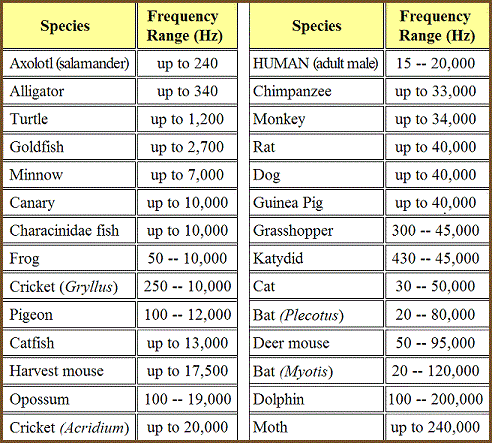 |
Typically, the sonic beings of planet Earth use frequencies from 20-100 KHz or higher for echolocation (Table 13.1).
- This corresponds to a wavelength on the order of millimeters in normal dry air at a range of several meters.
- Much higher frequencies, say, 500-1000 KHz, would permit the resolution of targets 0.1 mm in size.
- This is quite enough to thread needles and soldier circuit boards at distances of about 10 centimeters from the creature’s face.
Of course, aliens using sound waves with that kind of resolution would take a great deal of energy to produce. They would be "decidedly dangerous to human explorers," according to science fiction writer Hal Clement:
A story could be built on the unfortunate consequences of the men who were mowed down by what they thought must be a death ray, when the welcoming committee was merely trying to take a good look.
|
But there is no fundamental reason why
sentient extraterrestrials couldn’t use sound as their primary sense, and to build and create as well as any sighted being. |
But there is no fundamental reason why sentient extraterrestrials couldn’t use sound as their primary sense, and to build and create as well as any sighted being.
Audition has been developed as the primary sense modality among many aerial and land based animals on Earth. Creatures evolving on planets with unusually thick atmospheres with heavy refractive effects might tend to rely far more on hearing than on seeing. Also, there is much evidence that the sea is also a most auspicious environment for the development of sonic senses. It’s quite possible that hearing may even be the sense of choice for intelligent organisms residing in the murky oceanic media of other worlds. Why is this so?
Sound travels about four times faster in water than in normal air. This allows faster response times and greater ranges of communication and data collection. For example, at sonic frequencies of 500-1000 KHz, spatial resolution in ordinary seawater is equivalent to that in air at 100-200 KHz — but the range is about a hundred times greater.
|
We can easily imagine that sound may be
the preferred sensory modality among many, if not most, intelligent aquatic races scattered throughout the universe. |
| Compared to smell |
Sound fares well against competing senses in the watery environment. Pheromones are relatively ineffectual in water, since diffusion in liquid media generally proceeds 103-104 times slower than in air. Smell signals are emitted, but creep slowly away from the source. Ocean currents are tamer than atmospheric ones, so pheromones would have to be about a million times more concentrated in water than in air to achieve comparable results.
| Compared to vision |
Vision doesn’t compare much better. Light and other electromagnetic radiation cannot penetrate most liquids to any appreciable degree and are subject to countless distorting effects. In a tropical sea at high noon under very clear water, useful visual information can be gained only out to about 30 meters. Using acoustic channels instead, this range is extended to many kilometers — comparable to vision in air on a hazeless day.
|
Human sensory data flow
Dolphin sensory data flow
|
These facts are reflected in the physiological differences between humans and dolphins. The eyeballs of a man receive an estimated 50 million bits of information each second, while his ears manage only 2 million bits/second. In porpoises the emphasis is exactly reversed: Dolphin sonar handles perhaps 40 million bits/second, while the eyes manage only 5 million bits/second of information.*201We can easily imagine that sound may be the preferred sensory modality among many, if not most, intelligent aquatic races scattered throughout the universe.
There are many properties of sound that make it a totally unique window on reality. For instance, the ultrasonic world is very quiet in comparison to the normal range of human hearing. This is because of the relatively short range of ultrasound. There is little noise because sources remain localized.
In a dense fog, both sighted and sonic organisms are ill at ease: The former, because light is scattered away causing everything to appear visually white; the latter, because the droplets of moisture or particles are excellent ultrasound absorbers and cause the entire field of view to appear acoustically black.2514
* Lilly’s figures are probably overoptimistic. Homer Jacobson and others have done a more careful analysis, and have concluded that the human eye is capable of transmitting only 4.3 million bits/second and the human ear only about 50,000 bits/second maximum.955, 979, 980
| Acoustic x-ray snapshot |
Human vision is limited to the surfaces of objects, but sound penetrates and exposes the insides of targets to view. Objects may be scanned for composition and internal structure using almost distortion- and reflection-free sound waves. A pelagic sonic alien (perhaps modeled after the dolphin) thus views its fellows, not as a sharp contour of lines and edges and distinct boundaries, but rather more like an x-ray snapshot. Skin, muscles, and fatty tissues are virtually transparent to ultrasound. Bones and teeth, internally-trapped gas bubbles, and cartilaginous structures give good reflections. Hard parts, as well as the digestive and respiratory tracts, stand out in clear relief.
|
If your visceral reactions are
obvious to everybody, you don’t waste much time trying to lie. |
Might aliens with such sonic sight be more honest and less deceitful than humans generally? Physiological reactions to other individuals might be instantly perceived by those others, a kind of body-telepathy. At least one writer has remarked: "If your visceral reactions are obvious to everybody, you don’t waste much time trying to lie."2855
| Stereophonation |
Dolphin echolocation may properly be compared to human vision. Just as people are able to see by the reflected white light of the sun, porpoises emit ultrasonic clicks and trills that illuminate the surroundings with white noise. Differences in texture and composition are as obvious to their sonic senses as to our visual ones. As Dr. Winthrop N. Kellogg points out; "Wood simply 'sounds different' from metal to a porpoise in the same way that it looks different to the human eye. It is the sound spectrum of the returning vibrations which gives the clue to the nature of the reflecting surfaces."1698 Even more sophisticated, the dolphin has sound generators on either side of its head, which allows sonic depth perception176 using binaural hearing — what Lilly has called "stereophonation."201
| Sonic Doppler effect |
Acoustically-oriented aliens will also have a rather clever use for color. The color of an object is just the frequency of radiation it emits, and we may expect that objects may take on various sonic colors. But there is more. Objects moving rapidly towards a sonic sensor will reflect sound at a higher frequency because of the Doppler effect. Likewise, objects in the field of view which are moving away will reflect lower frequencies.
If sonic beings divide their audible frequency spectrum into colors, then the sonic Doppler effect will cause approaching targets to appear "bluer" and retreating targets to appear "redder." As objects pass in front, their color alters noticeably depending on relative speed, angle of approach, and distance. If the medium is in motion, as with gusts of wind or surging water currents, the apparent color will flicker in frequency — a phenomenon quite alien to normal human visual experience.
|
Many researchers believe that the language
of dolphins consists not of words as we understand them, but rather of a series of sonic images transferred into speech. |
| Sonic images transferred into speech |
The linguistic significance could be enormous. Much as the Eskimos have more than fourteen different ways to say "snow" (depending on its firmness, wetness, age, etc.), intelligent marine ETs will have words without analogue in our language. There might be terms describing approaching-red, receding-red, stationary-red, stereophonic-red, circulating-red, gulfstream-red, and dozens of other subtle distinctions we cannot begin to imagine. Or perhaps these sea-folk communicate in a manner which is possible only among creatures who use the same sense to see as to talk. Many researchers believe that the language of dolphins consists not of words as we understand them, but rather of a series of sonic images transferred into speech:
In this view a dolphin does not "say" a single word for shark, but rather transmits a set of clicks corresponding to the audio reflection spectrum it would obtain on irradiating a shark with sound waves in the dolphin’s sonar mode. The basic form of dolphin/dolphin communication in this view would be a sort of aural onomatopoeia, a drawing of audio frequency pictures — in this case, caricatures of a shark. We could well imagine the extension of such a language from concrete to abstract ideas, and by the use of a kind of audio rebus — both analogous to the development in Mesopotamia and Egypt of human written languages. It would also be possible, then, for dolphins to create extraordinary audio images out of their imaginations rather than their experience.2552
|
Sounds generated at the proper depth remain trapped
in the zone, much like light in a strand of optical fiber. Messages may travel virtually unattenuated for literally thousands of kilometers in all directions. Sentient oceanic creatures of other worlds may regularly broadcast long-distance calls to other "universes" in the sea. |
| Sofar channel |
It is difficult to emphasize too strongly how unfamiliar the world may appear when viewed through other senses. Extraterrestrials will have experiences and capabilities that are difficult for humans to fully appreciate. A case in point in the perception of a peculiar sea phenomenon known to oceanographers as the sofar channel.
The speed of sound in water increases with pressure and decreases with temperature. Moving downward from the surface the temperature plummets, and about 100 meters down the speed of sound reaches a minimum value of 1480 m/sec. At greater depths the temperature remains fairly constant (close to freezing) but the pressure begins to build, causing the speed of sound to go back up. This region of minimum sound speed is called the sofar channel.
Sonic radiation, due to the physics of refraction, is actually attracted towards the channel. As with astronomical black holes (from which light waves cannot escape), acoustical signals sent from within the sofar channel likewise can’t get out. Transverse waves cannot cross it easily, which must cause it to appear sonically dark and foreboding when "viewed" from above or below.
If sufficient courage can be mustered, the channel has one very interesting property as regards long range marine communications. Sounds generated at the proper depth remain trapped in the zone, much like light in a strand of optical fiber. Messages may travel virtually unattenuated for literally thousands of kilometers in all directions. Sentient oceanic creatures of other worlds may regularly broadcast long-distance calls to other "universes" in the sea.
 |
Nearly all organisms, including humans, emit direct-current electricity when swimming in ordinary seawater. This is due to the gradient in electrical potential between normal body fluids and the saline electrolytic ocean. Voltages are actually developed across different parts of the body.
|
Sharks can detect a flash light battery at 1500 kilometers (about 10-8 volt/cm) |
Sharks — rather large animals of low intelligence — are sensitive to incredibly minute electric fields. They can detect the equivalent of a single flash light battery at a distance of 1500 kilometers (about 10-8 volt/cm). A small wound can double a person’s voltage gradient in water, and sharks have no trouble sensing this.574
Intelligent extraterrestrials may have developed an electric sense, given the proper evolutionary environment. By maintaining a carefully shaped field around their bodies, such creatures could detect the entry of foreign objects and other lifeforms into its personal space. Electrosensitive aliens could clearly identify the exact nature of the intruder by noting the location, magnitude, and shape of the distortion in the static field. Also detectable are such nonbiological sources as motions of and compositional changes in seawater, subsurface ore concentrations, earthquakes, thunderstorms and other meteorological disturbances.
Many terrestrial animals use a kind of electropulse reflection system analogous to sonar. Such mechanisms have evolved independently on Earth at least six different times among fishes. The most familiar include the electric eel (Electrophorus electricus), the electric ray (Torpedo), the skate, the knifefishes, the electric stargazers (Astroscopus), and the electric catfish (Malapterurus electricus) of the Nile.
The electrosonar fishes generate pulses at regular intervals. Amplitudes rarely exceed a third of a volt, and the frequencies range from 55 Hz for the Gymnotid species Sternopygus macrurus up to 300 Hz for Eigenmannia.474, 2516 (Peak surge rates as high as 1600 Hz have been recorded, though.)
Sense organs located in the head of Gymnarchus niloticus respond to currents as small as 0.003 picoamperes and voltages as low as 0.15 microvolt/cm. Dr. Hans W. Lissmann of Cambridge University believes that this typical electric fish uses its 300 Hz electrosonar for navigation. Its natural habitat is the muddy waters of Ghanese rivers in Africa. Since light cannot penetrate, the organism is forced to rely heavily on its inboard electronics. The fish uses its electric sense both to avoid obstacles and to detect and capture prey.2516
|
When two of these animals meet, each adjusts his
frequency up or down to avoid jamming the signals sent out by the other. And these high-speed discharges aren’t simple sine waves; rather, they are rich in harmonic variability and might easily serve as highly sophisticated communication systems in more cerebral alien creatures. |
| Electrocommunication |
The knifefish Eigenmannia has been closely studied by marine biologists because it uses its electrical sensitivity for social communication as well as navigation. When two of these animals meet, each adjusts his frequency up or down to avoid jamming the signals sent out by the other. And these high-speed discharges aren’t simple sine waves; rather, they are rich in harmonic variability and might easily serve as highly sophisticated communication systems in more cerebral alien creatures.2545
Dr. Carl Hopkins of Rockefeller University in New York has studied the sex habits of the electrical fish Sternopygus. When the male of this species passes a female, his normally polite and mild-mannered electronic emissions suddenly become an impassioned tangle of impulses — the chaotic mixture of harmonics and timing that are his love song to potential mates. Literally, the female "turns on" the male.2541
| Listen mode |
The Mormoryd or "elephant trunk" fishes provide our last example of social electrics. These organisms send pulsed electrical messages to each other as a form of territorial display to warn off competitors. When a stranger intrudes on the home turf, the defender raises his frequency in angry protest. Mormoryds also show a distinct fondness for playful activity, and at least one researcher has documented what might be called a "listen mode" of behavior. In this mode, one fish attentively ceases all electrical emanations when certain of its fellows pass by.2540 Similar patterns of electrocommunication have been observed in Gymnotus carapo, a knifefish.2550
One major question remains: What kind of planetary environment might give rise to intelligent aquatic beings who relied primarily on an electric sense? As first Lissmann and later the Jonases have suggested, there would appear to be two basic requirements.
- First, to evolve electrosensitivity as the preferred sensory modality, the medium in which the creature dwells should be quite dark. This must be a permanent (not diurnal, seasonal, or sporadic) condition. Otherwise, eyes are so useful that it would be very difficult to rule them out as the primary modality. Even Gymnarchus, living out its entire existence in darkened and perpetually muddy waters, has a set of weak, poorly-developed eyes which it uses to tell day from night.
- Second, virtually all electrosensitive creatures on Earth live either in the ocean depths or in a turbid, fast-flowing watery habitat. If evolution is to favor these beings, the environment should probably be both dark and turbulent. Sonic senses would then be scrambled, vision virtually useless, and olfactory messages rapidly mixed, diluted, and swirled away. Electric field sensing could then become the sensation of choice.
So we might expect to find electric intelligences in the deep oceans of fast-spinning pelagic worlds. Another possibility could be a terrestrial planet with some oceans but which orbits a bright star at a great distance or a feeble star at a moderate distance. (Subjovian worlds might work well too.) A third alternative might be the dark side of a tidally-locked one-face planet located near the inside edge of the stellar habitable zone, a set of conditions likely to give rise to violent oceanic currents and turbulent winds.
|
Depending on the texture, conductivity,
and chemical composition of the target, electrosensitive extraterrestrials might have an equivalent to our "color" which we could scarcely understand or appreciate. |
| Electrosensitive perception |
How would electrosensitive ETs view their world? We can imagine that it would be an utterly alien environment compared to anything in normal human experience.
Sensations could be detected only at relatively close range due to the high electrical resistivity of water.82, 565 The creature’s immediate sensory universe might extend out to about 100 meters for small objects, perhaps to a kilometer for larger ones. It should be a simple matter for these creatures to locate and distinguish various objects. Electric field lines diverge from a poor conductor — such as rubber, plastic, glass, and other insulators — and converge toward good conductors — such as metals. Tests with electrosensitive fishes have proven that they are capable of detecting tiny glass rods 2 millimeters in diameter which are optically invisible in water. Two objects of the same size and shape, but constructed of different materials, are also easily distinguished.2516 Depending on the texture, conductivity, and chemical composition of the target, electrosensitive extraterrestrials might have an equivalent to our "color" which we could scarcely understand or appreciate.
The natural magnetic field of the planet, or submerged ferromagnetic ore lodes, would produce minute variations and distortions in the electrosensory field. A warmer or cooler layer in the watery medium could give rise to similar effects. And electrical impulses can play over the skin of an object or penetrate it to varying depths, permitting both interior and exterior views.
|
The uniform absence of biomagnetism on this world
seems to suggest that it may be restricted to a somewhat passive role elsewhere — as on Earth. |
A related but more restricted sensory modality is the perception of magnetic fields. Zoologists have not yet found any creature on Earth capable of generating its own magnetism. Such ability cannot be ruled out elsewhere, since terrestrial fishes can generate electric fields and circulating electric fields give rise to magnetic ones. Nevertheless, the uniform absence of biomagnetism on this world seems to suggest that it may be restricted to a somewhat passive role elsewhere — as on Earth.
| Magnetotaxis |
The magnetic sense has been documented in the common mud snail (Nassarius)82 and in planarian worms.765 Magnetotaxis — attraction to magnetic sources — has also been clearly demonstrated in marsh bacteria and a few other microscopic species. These diminutive organisms have tiny chains of iron-rich beads incorporated within their bodies which allow them to orient themselves along Earth’s north-south axis and swim towards Magnetic North.2518
Insects, too, make use of the planetary field. Bees are known to build their hives in perfect alignment parallel to Magnetic North. If a strong magnet is placed nearby, the insects obligingly construct their new home in accordance with the new distorted direction of the magnetic field vector. (In one experiment a deflection of more than 40° from true north was achieved in this manner.438) Some species of termites are similarly affected, building their nests either parallel or perpendicular to the geomagnetic field at that location.219 These insects are believed to be sensitive to a mere 10-5 gauss, yet to date no organs or receptors have been isolated that could serve in this capacity.
| Bird navigation |
Finally, one of the leading theories of bird navigation holds that these avians (besides sighting on familiar landmarks and the stars2532) take some of their directional cues from the position of the planetary magnetic field. There is much recent experimental evidence that birds can respond to fields as weak as 10-3 gauss (Earth’s field is about 0.5 gauss at the surface).2517, 2519 There is also some unconfirmed evidence of a tiny organ in the corner of the eyes of the homing pigeon which is sensitive to magnetic flux.79
Magnetosensitivity may well serve in at least an auxiliary role for many extraterrestrial animal species.
 |
|
Light can carry far more bits/second than any other stimulus |
Virtually all higher lifeforms on planet Earth have some optical sensing capability, testimony to the tremendous advantage in being able to see. Light is most familiar to us, but there are also many other forms of electromagnetic radiation. Likewise subsumed under "vision" must be eyes that see by gamma rays, x-rays or ultraviolet rays in the higher frequencies, and by infrared (heat), microwave or radio waves at the lower end of the spectrum.
| Instantaneous response |
There are many advantages to sight. While all but radio frequencies cannot diffract around obstacles or turn corners, vision provides the greatest accuracy, highest directionality, and the finest resolution of any sense available. Since photons travel faster than any material pulse — as with olfactory or auditory signals — vision permits virtually instantaneous response times. And light can carry far more bits/second than any other stimulus.980
| Visual messages |
One possible disadvantage of vision is that it requires elaborate whole body motions,2534 body color changes,2506 or complex biochemical mechanisms such as are found in bioluminescent insects and "flashlight" fishes2522, 2526, 2544 for social interaction to take place. So visual messages may be an inferior mode of communication between individuals unless there are overriding environmental factors at work — such as an unusually thin atmosphere which transmits sound poorly.
|
The sighted animal has a tremendous
advantage enjoyed by no other: An external source of illumination. manna from heaven. Photons bounce off everything and thus collect information which is free for the taking by any organism equipped with eyeballs. |
But this difficulty is more than offset when we consider vision as a means of sensing the surroundings generally. The sighted animal has a tremendous advantage enjoyed by no other: An external source of illumination.
| Manna from heaven |
It has been suggested in earlier chapters that most lifeforms will probably evolve on planets circling other stars. If this is a valid assumption for the majority of extraterrestrial races in the Galaxy, it follows that most of these environments will also be reasonably well-lighted.
While osmic alien must emit their own pheromones and auditory beasts must radiate homemade sonar pulses if they desire high resolution, light falls from the sky like sensory manna from heaven. Photons bounce off everything and thus collect information which is free for the taking by any organism equipped with eyeballs.
Naturally, there are a few restrictions. Despite the fact that stars emit radiation at all frequencies in varying intensities, planetary atmospheres tend to absorb a great deal of it. Depending on the composition of the air, its pressure and a hundred other factors, there will exist one or more "windows" through which environmental illumination may pour.
As a rule, gamma rays and x-rays are absorbed by energy-level jumping in the atoms of air. It’s true that snails are known to be especially sensitive to x-ray’s,551 and Arthur C. Clarke has speculated on the possibility of an x-ray sense,81 the fact is that such high energy photons will probably be unable to penetrate any planetary atmosphere of reasonable density.
Ultraviolet (UV) is absorbed too, although to a lesser extent. In a thin or unshielded (e.g., ozone-free) atmosphere like that of Mars, ultraviolet rays might reach the surface and become useful for vision. It is a surprising fact that the human retina is quite sensitive to UV down to at least 3300 Angstrom.2528 This soft-ultraviolet radiation normally never reaches the retina because it is filtered out by the lens. A few persons have undergone lens replacement operations to remove cataracts, and since the artificial lens passes UV the full potential of the retina is finally realized. Such people can see a "color" that the rest of us cannot!* Unfortunately, on most planetary surfaces any scene viewed in ultraviolet light would probably be quite dark.
|
Three main bands exploited for vision on any world:
|
Near-infrared (IR) radiation is partly removed by the vibrations in molecules of water, carbon dioxide, methane, ammonia and a variety of other atmospheric constituents, and far-IR is absorbed by molecular rotational transitions common in the air of all planets. Still, some infrared does get through and may become useful for seeing.
| Three main bands of electromagnetic radiation |
We are left with "visible" light, some near-infrared, and some radio frequencies to which normal atmospheres are transparent. Thus there are three main bands of electromagnetic radiation which may profitably be exploited for vision on the surface of any world: The visible, the infrared, and the radio.
* During World War II, senior citizens who had undergone lens replacement operations were used by the Office of Strategic Services to pinpoint the flashing UV signals from agents stationed on enemy coasts. Secrecy was maintained be cause these messages were completely invisible to anyone else.2529
|
Table 13.2 Wavelength of Maximum Sensitivity to Visible Light |
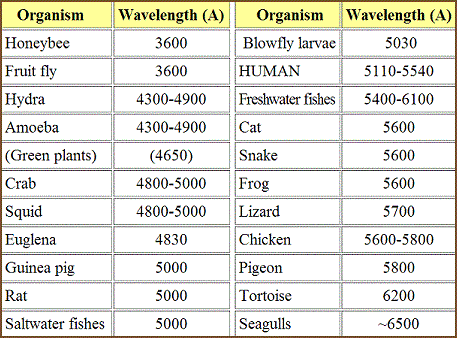 |
The "visible" range of light is actually slightly broader than the visual spectrum for human eyes. Our sight is normally limited to 4000-7000 Angstrom. Bees, however, are fully sensitive to ultraviolet radiation down to about 2500 Angstrom but they cannot see red. All animals have somewhat different reactions to visible stimuli, as shown in Table 13.2 at right.
Many have advanced the interesting notion that ETs evolving under the light of other suns will necessarily have eyesight which is most sensitive to the frequency of peak output of their home star. Hotter stars, under this scheme, would spawn creatures with bright-light accommodation and heightened sensitivity to blue light. Cooler stars would give rise to organisms more attuned to the red. (See especially Anderson,63 Clarke,81 Clement,292 Macvey,61 and Shklovskii and Sagan.20)
|
Table 13.3 Electromagnetic Power Delivered to Planet, Orbiting in Earth-Normal Ecosphere, by Various Stars in Visible Wavelengths of Light |
 |
There are strong reasons to doubt the above hypothesis. Consider Table 13.3 at right, which shows the visible radiation from various stars incident on planets located near the center of the Earth-normal habitable zone. Note that among all stellar classes of xenobiological importance the shift in the visible power spectrum is not dramatic. While some small variation exists in the relative intensities of blue, green and red from star to star, the differences are decidedly underwhelming — hardly sufficient to represent a decisive evolutionary selective factor.
Furthermore, the peak sensitivity of terrestrial lifeforms is highly variable, ranging from 3600 Angstrom for bees (the equivalent emission peak of an A7 sun) up to 6500 Angstrom for seagulls (the equivalent emission peak of a K3 star).
| Arboreal origins |
And yet all of these creatures evolved under the same sun. It seems clear that eye sensitivity probably relates more closely to other environmental factors than the stellar class of the home sun. For example, it is often suggested that the wavelengths of light to which humans are most sensitive are virtually identical to the color of sunlight filtering down through a dense forest canopy of green vegetation and foliage, thus reflecting our arboreal origins. Aliens will answer in similar fashion to their own peculiar evolutionary heritages.
If sight is so important to living beings, then what kinds of photoreceptors might we expect to find on other worlds? Will ETs have eyes like ours, and if so, how many?
|
The ubiquity of the eyeball is perhaps
the clearest indication that it’s simply the best design for the job. |
| Convergent evolution of the eye |
One of the most striking examples of parallel or "convergent" evolution in the terrestrial animal kingdom is the incredible similarity between the eyes of creatures with vastly different evolutionary histories. Animals in many separate phyla — Chordata (amphibians, fishes, reptiles and birds), Mollusca (octopus, squid), Annelida (the alciopid worms Torrea andVanadis2482), Coelenterata (the cubomedusan jellyfish2816), and even Protista (the elaborate lensed eyes of dinoflagellates2856) — have independently evolved photoreceptors surprisingly similar in structure to the mammalian eye. There are some discrepancies; for instance, the photoreceptor cells in molluscs point towards the light, the opposite of vertebrates.1697 Nevertheless, close comparison reveals that the adjustable lens, retina, pigments, focusing muscles, iris diaphragm, transparent cornea, and eyelids all are immediately recognizable. The ubiquity of the eyeball is perhaps the clearest indication that it’s simply the best design for the job. Similar evolutionary forces and physical laws should lead intelligent ETs down much the same path.
| Camera lens eye / compound eye |
Of course, the "camera lens" eye used by mammals isn’t the only imaging system lifeforms can use (though it’s probably the best for larger organisms). The next most common — indeed more common if you just count species — is the compound eye of insects and crustaceans.2535 Each organ looks like a small multifaceted jewel, but is actually a bundle of optical tubes. Light is directed down each of these tubes onto a large matrix of individual photosensitive spots on the retina. The image appears as a composite mosaic of tiny light-bits. Dragonfly eyes, to take an example, have more than 28,000 facets each.79 Motion may be discerned as far away as 12 meters.
|
Table 13.4 Resolving Power of Some Common Animal Eyes |
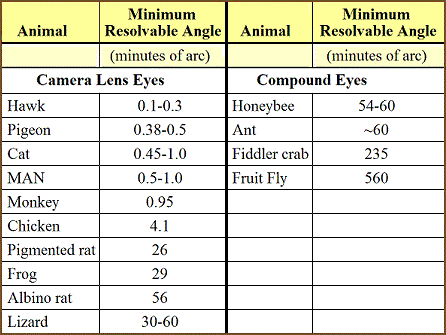 |
Unfortunately, the compound eye has only very poor resolving power. (See Table 13.4.) It has been pointed out that an insect, poring over this page of print, would be quite unable to make out the individual letters.81 This is why larger creatures who need large amounts of accurate, well-resolved visual data will probably find the compound eye an unattractive alternative on any planet. Yet for smaller organisms it is ideal. Part of the reason for this is the laws of physical optics. If a flea had a spherical lens eye like that of humans, the pupil would be so minute that diffraction effects would make clear imaging impossible.958 Once again we see that the worlds of size are truly worlds apart.
| Pinhole camera |
Other image-forming techniques are of limited importance on Earth, but this is no guarantee that the emphasis on other planets will be the same. For instance, alien species may utilize the pinhole camera concept. Such a system uses a open optical pit without lenses that is exceptionally useful in water. The beauty of the pinhole eye lies in its simplicity, and it has been adopted by at least one group of animals on Earth: the chambered nautilus.584
| Scanning eye |
Another curious mechanism is the scanning eye of the snail. The image formed by a simple crystalline lens is scanned by moving a single retinal nerve sensor over the field of vision. The entire picture is slowly reconstructed from a series of these scans. Scanning eyes aren’t particularly useful for spotting rapid movements, but may be of value in highly viscous environments.
The principle of the optical reflector telescope has never been directly employed to form images by terrestrial lifeforms. But it is clearly possible to do so. And while pinhole and compound eyes cannot gather light but merely serve to redirect it, both lenses and reflectors can.439
| Biological reflectors |
Some animals have developed biological reflectors for other purposes. The luminous squid has retractable reflectors which, when coupled with its bioluminescence, produce a kind of searchlight. This elaborate apparatus, constructed of lenses, concave mirrors, diaphragms and shutters, emits a beam of illumination with which it sweeps the vicinity in search of prey.1000
|
If a flea had a spherical lens eye like that of humans,
the pupil would be so minute that diffraction effects would make clear imaging impossible. Once again we see that the worlds of size are truly worlds apart. |
The common house cat also makes use of curved reflectors. When light enters the feline eyeball not all of it is absorbed by the visual pigment in the retina. In most mammals this light is simply wasted. But the cat has evolved a mirrorlike coating on the inward-facing front side of its eye, called the tapetum. This specialized device reflects unused photons back into the retina for another try at absorption. Efficiency is increased and sensitivity heightened, although the image is blurred very slightly.
| Split-pupil eyeball |
Another specialized adaptation is the split-pupil eyeball. This allows an organism swimming along the surface of a liquid body to enjoy bifocal vision.61The Four-eyed Fish, one of the largest tropical tooth carps (Anableps), actually has this remarkable feature. It is an elongate fish with eyes projecting upwards, each member of the pair divided into an upper part adapted for vision in air and a lower part adapted for vision in water. Any creature so equipped — alien or Earthly — can keep tabs on events above and below at the same time!
|
The Four-eyed Fish … is an elongate fish with eyes
projecting upwards, each member of the pair divided into ■ an upper part adapted for vision in air and ■ a lower part adapted for vision in water. |
| Polarized light |
Another kind of visual perception is the sensation of polarized light. Many animals on Earth have this sense — insects, crustaceans, birds — although most mammals do not.*
Radiation coming from the sun is unpolarized. But when these rays are intercepted by a planetary atmosphere the plane of vibration is altered depending on the position of the star in the sky during the day. Honeybees, to take one example of many, monitor these shifting patterns of light and use this information to map out the shortest direct air route home. Sky polarization thus serves as a highly accurate navigational aid for these creatures.2530
Since sunlight reflected off a lake or ocean also is polarized, sentient avians of other worlds who must seek their prey by diving through a shiny water surface may be equipped with internal Polaroid filters. (Herons, kingfishers and other terrestrial birds have these.961) Species inhabiting a "glassy" desert planet (with large expanses of volcanically or electrically fused surface sand) might also find this sense quite useful as sunlight bouncing off glass is polarized. And in constantly swirling irregular media, the detection of polarized light could help to maintain a proper orientation of "up" and "down."
| Time lapse vision / wraparound eyes |
We can imagine still more exotic schemes. Nature may have use for an eye with the ability to integrate light from a scene over a long period of time, much like photographic film. Such a system might be useful on a torpid, dimly-lit world (such as Venus) or in an environment populated by creatures with very slow response times. Since human rod cells are able to soak up dim light like a sponge for seconds at a time,82 there is no reason why aliens could not go us an order of magnitude or so better. This same ability could be used to design "wraparound eyes" for panoramic viewing.
|
… no superior intelligence could evolve in
circumstances in which it lived in constant fear of being struck down and eaten. |
| Eye stalks |
What about eyes on stalks? Despite the attractiveness of this idea among devotees of the outré, both omnidirectional viewing (as found in some insects and terrestrial fishes) and independently swiveling eyes (like the chameleon) are generally seen by most xenobiologists as rather unlikely adaptations for thinking animals. It is said that eyes on mobile stalks are a feature more of animals likely to be preyed upon, and that "no superior intelligence could evolve in circumstances in which it lived in constant fear of being struck down and eaten."50
Bonnie Dalzell has produced three additional arguments against eye stalks for intelligent ETs that are very persuasive:
- Eye stalks require an hydraulic support mechanism, which is very inefficient except in small animals.
- Eye stalks are too dangerous. Eyes are often the most vital sense, yet a predator could just clip them off with the stroke of a claw or pincer. And such organs are more prone to normal injury — in an accident, stalks could be bumped, slammed, or squashed rather easily.
- Stalks, in fact all independently-targetable eyes, present severe problems for the brain in making the correct parallactic computations necessary for binocular vision.400 (However, the chameleon seems to triangulate on his food quite easily.474)
| Haidinger’s Brushes |
* Humans can see polarized light, but just barely. In natural skylight "Haidinger’s Brushes" appear as a small yellow and blue Maltese cross in the center of the visual field, the blue segment oriented parallel to the plane of polarization. The phenomenon is so close to the borderline of perception, so faint and unreliable, that it cannot serve a navigation function for man.2531
|
Three eyes represent not nearly
the same improvement over two that two represent over one. The Principle of Economy
tells us that nature invariably chooses the cheaper of several ways to do the same thing. |
How many eyes are best? It’s clear that nature usually chooses the cheapest way to do a given job. Certainly for senses that are not highly directional, it would seem that a single receptor organ should suffice. This is perhaps why most larger organisms have but one organ of smell and one of taste.
On the other hand, senses that are highly directional can make good use of the benefits of stereo. The ability to accurately triangulate a source depends on the simultaneous operation of at least two physically separated receptors. One organ of sight or sound gives 2-D resolution; a second organ, by making use of binocular or binaural sensing, gives three-dimensional coverage.
But there appears to be little to gain from using more than two sensors.
A single pair is sufficient to ensure spatial resolution with depth perception — a quantum leap over single organs but not much poorer than three or more. Notes one xenologist: "Three eyes represent not nearly the same improvement over two that two represent over one."20
Since the Principle of Economy tells us that nature invariably chooses the cheaper of several ways to do the same thing, this may partly explain why we have exactly two eyes and two ears. The advantages of having more than this number are slight or nonexistent, a conclusion bolstered by the apparent convergent evolution of stereoscopic vision among mammals, birds, and other animal groups on this planet.2520 Still, there is plenty of biological precedent for alternatives.
Cyclopean organisms are common in the microscopic world, but these are mere eyespots, useless for imaging or any discrimination between all but fuzzy patches of light. Scorpions and water fleas have a pair of compound eyes set so close together that they appear almost as one — but these are not truly monocular.
| Monocular vision |
It is possible that monocular vision might suffice even for large alien creatures. For example, a single eyeball that vibrated slowly from side to side could provide limited depth perception. Nearer objects would seem to move faster across the field of view than more distant ones, giving clues to their relative positions in space. (The human eyeball constantly quivers to prevent "visual accommodation," but the effect is too small to permit stereoscopy.)*
| Third eye |
Very few animals have more than two imaging eyes, because third eyes don’t tell the being anything it didn’t already know. Reptiles (and man) have an ancient third eye called the pineal gland. In today’s reptiles it is only a day/night sensor and has no imaging capability whatsoever,2521 and in humans it is fully degenerate. But such may not always have been the case. The skull of Cynognathus, an extinct Triassic Period theriodont reptile, definitely shows three eyes. This animal was mammal-like, possibly warm-blooded and probably hairy.600
| Tetraocular / pentaocular |
Nereis, the common sandworm or clamworm, has four eyes. The Horseshoe Crab (Xiphosura) is also tetraocular, though two of the four are degenerate. Most insects are pentaocular, with three small eyespots called ocelli located on the upper part of the head between the two compound eyes. Once again, how ever, there are only two image-forming eyes.965
In a few cases, several batteries of eye-pairs are used during the successive phases of the hunt for food. Dr. Norman J. Berrill describes the dinnertime antics of the spider, which has four pairs of eyes:
The rear pair serve to watch behind for either food or danger. The other three pairs work together but in succession. If something comes within the range of vision of one of the outermost pair, the head turns until the object is brought into the field of the two pairs of eyes in the middle, and the spider then advances. When the object is brought into focus of the forward pair, the spider jumps to attack. The whole business is much like a self-operated mechanism with seeing instruments, and the eight eyes together do not compare with the camera or the compound eye of a bird or a bee.89
|
From the many examples above we know
that more or less than two eyes have seldom proven more adaptive than exactly two. |
| The ultimate limit |
The ultimate limit is probably reached by the scallop, whose literally hundreds of tiny, beautifully constructed "eyes" are spread around the circumference of its mantle like running lights on an ocean liner. These sense organs are very limited in function, however, as they cannot image. They serve only to initiate an automatic escape reaction at the approach of a hungry starfish (the scallop’s natural predator) heading in from any direction.
Specific environments can be imagined in which more or less than a single pair of eyes might be selectively advantageous. But the cost in added neurological equipment will usually be prohibitive. From the many examples above we know that more or less than two eyes have seldom proven more adaptive than exactly two.
Large sentient aliens, if they see by visible light, will most likely be binocular.
| Two eyes without stereoscopic vision |
* It should be pointed out that the possession of two eyes does not guarantee stereoscopic vision. The rabbit and the woodcock, for instance, have eyes located on opposite sides of the head — which provides almost no binocular field.82
|
Figure 13.1 Peak of Blackbody Radiation at Various Temperatures2524 |
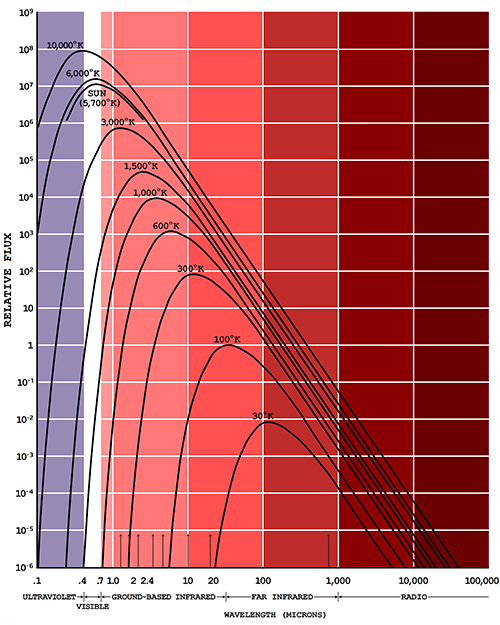
Wavelength of Radiation emitted by heated bodies varies with the absolute temperature. The wavelength of the most intense emission is given by Wein's displacement law, which states that for a thermal radiator the product of the peak wavelength and the absolute temperature is a constant.
|
|
Simply because they have
some heat, all objects "shine" in the infrared. So to infrared eyes, all the world illuminates itself. |
| The world illuminates itself |
The second range of electromagnetic radiation generally considered useful for vision is the near-infrared. While about 45% of Sol’s energy arrives as visible light, and 10% as UV, most of the remaining 45% comes in as infrared of various wavelengths. But seeing in the IR has another great advantage which is independent of atmospheric conditions. Every material body in the universe, provided its temperature is above absolute zero, emits a continuous spectrum of "black body" radiation (Figure 13.1). Simply because they have some heat, all objects "shine" in the infrared. So to infrared eyes, all the world illuminates itself.
|
The rattlesnake
Click for Synopsis
|
| Rattlesnake's heat sense |
The rattlesnake is remarkably good at sensing heat waves. This creature has four eyes — two imaging eyeballs operating in the visible, and two conical pits on either side of the head which house its binocular infrared cameras. Each one measures 2 cm2 in area and is packed with 150,000 receptors sensitive to the near-IR from 15,000-150,000 Angstrom.
To this reptile, the world of heat is as important as the visible world. The typical rattler can sense a mere 0.005 watt/cm2, equivalent to the infrared radiated by 1 cm2 of human skin.2525 Temperature differences of only 0.002°C can be seen by the snake. This allows it to hunt mammalian prey even in darkness, and to penetrate protective coloration ruses and camouflage ploys during the daytime.
|
Diameter of the eye
|
| Visual acuity in the IR |
What about visual acuity in the IR? Would the accuracy of sight be much impaired? Arthur C. Clarke has suggested that infrared eyeballs would give "coarse and fuzzy pictures, for the images they produced could not be sharply focused." Furthermore, since "a typical heat wave is about a hundred times longer than a wave of visible light, infrared eyes with vision as sharp as ours would have to be a hundred times larger." Clarke then conjures visions of monstrous two-meter-wide alien eyeballs which, he then concludes almost casually, "would certainly be inconvenient!"81
This result is extremely misleading. Extraterrestrial infrared sensors need not be grotesque at all. For example, let us consider an intelligent ET peering at a crowd of Homo sapiens through infrared eyeballs. The black body radiation emitted by a warm human body peaks at about 93,000 Angstrom. How large must the sensor be?
At the stated wavelength, the aperture* of the alien eyeball only needs to be 3.9 cm to enable it to resolve one minute of arc — about as good as a man’s eye. This size is comparable to the diameter of the eye of the horse (5.0 cm) and the Indian elephant (4.1 cm), and is nowhere near as large as the eyeball of the largest cephalopods (up to 37 cm) or even the largest mammal, the blue whale (14.5 cm).1697 So infrared eyes have to be just a few times larger than our own to achieve comparable optical resolution.
| ET stargazer |
An extraterrestrial stargazer with IR eyeballs would not see what we see, however. Most of the familiar constellations would be gone because most of the brightest stars radiate only faintly in the infrared. New constellations would appear, comprised of stars visible to humans only with telescopes in the visible range but which burn brightly in the IR.
| Absolute temperature sense |
Beings capable of seeing down into the infrared may have divided the spectrum into heat-colors. The coldest objects would appear "red," the hottest "blue." This is easy for us to conceptualize, even though we are incapable of making such fine distinctions of temperature and have no absolute sense of temperature. That is, the perception of a given temperature is variable, depending upon whether our skin was previously hotter or colder.
|
Honeybees are known to have an exact
thermoregulatory mechanism by which they maintain the hive at a constant temperature. |
| Incubator bird |
But there are creatures indigenous to Earth that do have an absolute temperature sense. Many insect, birds, fishes and rodents possess the ability in a limited way. Fish have been trained to respond to a specific temperature — say, 14 °C — regardless of whether they had previously been kept in warm or cold water.2543Honeybees are known to have an exact thermoregulatory mechanism by which they maintain the hive at a constant temperature. And one large bird — the Australian bush turkey or "incubator bird" — can keep its nest within 0.1 °C of precisely 33°C.2542
With this kind of absolute heat sense, an intelligent alien brain might interpret an entire rainbow of color in the heat spectrum. Since electrical permittivity varies widely in the infrared from substance to substance, "seeing" the chemical composition of the surroundings should not be too difficult for these beings.1703 With both visible and IR vision, like the rattlesnake, complicated visual messages and intricate works of interactive thermal art would be possible.
| Persistent phenomenon |
Heat, of course, is a persistent phenomenon. The footprints of a barefoot person across a cold floor or the jet blast on an airport runway well after departure remain visible in the infrared long after the source of these traces has departed. Like olfaction, thermosensitivity produces a world of echoes. The past gradually melds into the present as the traces of hot objects that passed by earlier begin to dissipate. Not only would such a clear view of the immediate local past be extremely useful survival-oriented information, but ETs with this sense would perceive reality and the flow of time in ways we can scarcely imagine.
* Calculated using usual approximation to Rayleigh’s criterion for optical resolvability of two point sources in air (diffraction pattern overlap): qR = 70l/A, where qR is resolution in degrees, l is wavelength and A is eye aperture both in meters.
|
Table 13.5 Peak Emission Wavelength of Radiation from Various Stars |
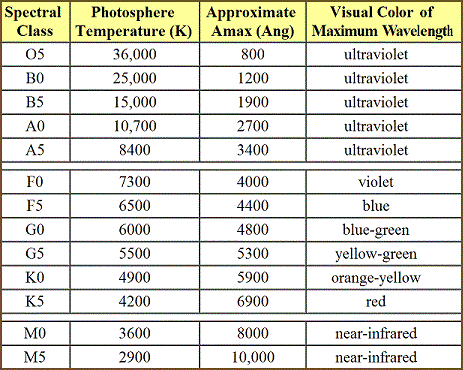 |
In so many ways the visible portion of the electromagnetic spectrum seems ideal for use by living beings.
- The atmosphere conveniently allows these wavelengths to pass.
- Most photosensitive chemical substances respond well in this region.
- Photons of visible light are energetic enough to excite our senses, yet not so energetic as to damage our tissues.
- Wavelength is small enough to permit the resolution of extremely small objects without distortion.
- As if this was not enough, we find that our sun emits its maximum power smack in the center of the visible range. Our sight spans just those frequencies in which the greatest power is available for illumination — a most auspicious arrangement. Let’s take a closer look at this.
The peak wavelengths in the power spectra of all classes of stars are shown in Table 13.5. Note that all stars of xenobiological interest have peak emissions well within the visible range. So choosing a star other than Sol won’t alter our conclusions — alien worlds will be impinged with quite similar wavelengths of bright visible light, though the mixture of colors may vary slightly.
|
If we hope to find radar beings
elsewhere in the Galaxy, we must think up some excellent reasons why nature should go to so much trouble. |
| 40 meter radio eyeball |
The fact that F0 through K5 stars peak in the human-visible optical window argues strongly for the evolution of visual, rather than radio, eyesight. It has also often been asserted that radio eyes would be difficult if not impossible from a bioevolutionary point of view. To achieve the same resolution as the human eye, a radio eyeball using 1-meter radio waves (300 MHz) would have to be several kilometers in diameter.1338 If 1-centimeter waves (30 GHz) are used, the radio eye need only be about 40 meters wide, but Carl Sagan’s cryptic remark is still appropriate: "This seems awkward."20
| No organisms with radar sense |
No organisms on Earth are known regularly to use radar as a functional part of their normal sensorium. Of course, we cannot exclude such a possibility elsewhere on this basis alone. Electrical senses are quite well-developed on this planet, and there’s no reason why alien creatures could not learn to manipulate kilocycle and megacycle signals with ease. Recordings have been made of electric fish sputtering along at 1600 Hz for brief periods,2516 and experiments conducted by Clyde E. Ingalls, Associate Professor of Electrical Engineering at Cornell University, have demonstrated the ability of some humans to actually "hear" radar waves beamed at the head.79
And there really is no need at all for a single, localized viewing organ. To demand such is to become an "eyeball chauvinist." For instance, the entire body of a moderate-sized macromorph could be used for this purpose, much as arrays of electric field sensors are embedded in the outer skin of sharks and the electric ray.
The central, most critical test is to find a good reason to evolve a radar sense. Certainly it is not an easy matter, and the rewards appear marginal because of the low radiative power of most natural sources of radio waves. In other words, if we hope to find radar beings elsewhere in the Galaxy, we must think up some excellent reasons why nature should go to so much trouble.
|
Table 13.6 Radiative Power Output at the Surface of Sol |
 |
The power output of Sol in the visible is compared with its radio emissions in Table 13.6. The radio window, while far broader than the visible, has more than ten orders of magnitude less energy available for sight! With hotter class-F stars the disparity is even greater.
If radio is to be competitive with sight as a primary sensory modality, the levels of environmental illumination should at the very least be roughly equivalent in magnitude. This guesstimate is probably a trifle optimistic since the information-carrying capacity (bit rate) of radio is about a million times lower than for visible light — but we’ll stick with it anyhow.
Where might we find the proper conditions?
| Close the visible window |
The planet Venus has a surface temperature of about 750 K. The hot rocks emit blackbody radiation in the radio at roughly the same intensity as in the visible. This would give radar eyes a fighting chance, except that we still have the enormous influx of visible light from Sol to contend with. It appears that if radio is to win, the visible window somehow must be closed.
It was once believed that the thick cloud cover over Venus would preclude the illumination of the planet’s surface by Sol’s rays. But on-site measurements made by the Russian space probes Venera 9 and Venera 10 have shown that such is not the case.2386 Sunlight penetrates the Cytherian gloom rather easily, providing light equivalent to Earth’s on a rainy, overcast day.
|
Sunlight penetrates the Cytherian gloom
rather easily, providing light equivalent to Earth’s on a rainy, overcast day. more opaque can feasibly be designed. |
It’s doubtful whether cloud covers very much more opaque can feasibly be designed. Unless we resort to such planetological oddities as chlorine or sulfur atmospheres to blot out the light, vision in the visible range must still be preferred over radio in any reasonable solar system.
|
Probably the best environment for the evolution
of radio-sensitive creatures would be the surface of starless, self-heating planets. |
If we cannot easily close the visible window, only one alternative remains: We must turn out the lights!
Probably the best environment for the evolution of radio-sensitive creatures would be the surface of starless, self-heating planets. Ensconced in the cold, dark blanket of the interstellar void, these worlds might sustain life and intelligence. Radar beasts with 40-meter-wide sensors may well be found on subjovian, jovian, or superjovian planets in the dead of space. No sun shines; all illumination must percolate up from below, and most of that is in the radio.
What might extraterrestrial radio eyes see on such a world?
| Giant radio moon |
From orbit, the night sky would appear suffused with a faint radio glow. Normal stars — as we know them — would all be gone. All constellations would vanish. In their places would be found a few brightly flaring pulsars and quasars, visible to the naked radio eye because of its greater sensitivity. Tiny creases and splashes of multicolored light would mark the titanic explosions in distant radio galaxies. The Milky Way itself would cut a bold, wide circular swath around the field of view, a glorious aurora-like ribbon of brilliance punctuated by a giant "radio moon": The Core of the Galaxy. Probably visible even from the ground as a spot of light about the size of a dime held at arm’s length, it would inspire the awe and curiosity of the inhabitants of the starless world below.
On the surface of the planet most of the astronomical universe visible from the orbital platform would be blotted out by ground and sky glare. Since the ground is the source of all energy, it will appear the brightest. The atmosphere, in close equilibrium with the ground temperature but slightly cooler, will be brighter but appear as a "colder" (redder) color. A radio snapshot would look surprisingly like a photographic negative of a scene on Earth: A brightly gleaming world nestled beneath a soft hazy blanket of swirling, cloud-pocked, multicolored, dully-glowing sky.
|
On Earth there are an estimated
100 lightning flashes each second worldwide. |
On Earth there are an estimated 100 lightning flashes each second worldwide. On a radio world, the atmosphere would be constantly flickering with "fireflies" dancing in the distance. Radio waves generated by electrical discharges any where on the planet would spread over great distances. The horizon would literally sparkle with light all around.
| 3-D see-through color vision |
Water and many other liquid surfaces would appear shiny and bright, but outcroppings of dry, solid rock must look dark and foreboding. If there are any clouds hanging over the planet, they probably won’t be seen because they are generally transparent to radio waves. Radar sensing can be used to peer deep inside non-metallic objects heated nonuniformly1338 (such as a living body). "Radio blue" might be defined as the radio color coming from the hottest parts of such objects, whereas "radio red" would be perceived from the coolest regions. How can we comprehend what it means to simultaneously view all parts of a solid body, heated from within or with layered surfaces, which appears "red" on the outside, "green" on the inside, and "blue" at the center? This is three-dimensional see-through color vision with a vengeance!
If radio-sensitive extraterrestrials have developed some form of space travel technology, they might tend to beware the blinding radio brilliance of stars. Should they happen to approach Sol, our sun would not appear to be the well-behaved, steadily-shining object we know it to be. The total radio flux can wander over as much as five orders of magnitude during periods of intense solar activity (during which the variations in optical brightness rarely exceed 1%).1339
|
To radio-sensitive aliens, all stars must appear to be
quite dangerous places indeed — variable, inhospitable, random, violent, and very uninviting in comparison to the tranquil, stately quiescence of the home planet. |
Enormous storms lasting many days would be observed near sunspots, releasing powerful blasts of radio energy resembling bombs bursting. A typical outburst raging across the shimmering surface of Sol would last tens of minutes, but the star might suddenly flare up unexpectedly, climbing several orders of magnitude in brightness in a matter of seconds. To radio-sensitive aliens, all stars must appear to be quite dangerous places indeed — variable, inhospitable, random, violent, and very uninviting in comparison to the tranquil, stately quiescence of the home planet.
But suppose for a moment that some foolhardy adventurer ventures close to our solar system in search of life. The terrestrial worlds would be only faintly visible, so the alien astronaut would first be drawn to the gas giants. The jovians emit vivid and colorful flashes "as if an enormous electrical storm were raging over its entire surface."49
With proper shielding and access to powerful telescopes, however, the alien might journey to Earth at last. On our world, there would be three sources of radio-light by which our strange visitor could see: (1) Radio emissions from our sun (a kind of flickering daylight to the ET); (2) black body emissions (given off by all warm bodies — air, ground, human bystanders, etc.); and (3) artificial sources.
It is the last of these which is most likely to cause an early breakdown in interstellar relations. Earth-based radiotelescope transmitters, TV and radio broadcasting antennae, and BMEWS defense radars would appear as hot and bright as the unshielded surface of the sun to the alien’s eyes. When our military radar first scans the incoming spacecraft, it may be interpreted as an act of war. A beamed radio "welcome" signal would fare no better.
After all, would we take kindly to a megawatt optical laser beam trained on our vessel as we came in for a landing on another world?
|
Learning alters perception. Other worlds mean,
|
We are far from having exhausted all of the sensory possibilities.
Man himself has many others:
- The vestibular senses relating to body position and accelerations
- Pain
- Time (circadian rhythms)
- Blood sugar level monitoring
- Thirst and hunger
- Internal temperature, and so forth
In the animal world:
- Most organisms, including jellyfish, shrimps, octopuses, and virtually all vertebrates are able to sense gravity to some degree. Even most of the higher plants have gee-sensors to keep them growing upright.*
- The water scorpion Nepa uses a fathometer sensitive to hydrostatic pressure gradients to keep itself informed of the depth to which it has dived.2358
- The alciopid worm Torrea has an unusual double-retina eyeball which may serve as an accurate depth gauge.2482
- Honeybees and a species of fire ant (Solenopsis) can detect changes in the concentration of carbon dioxide in the air.
- Other organisms have humidity sensors, brightness sensors, salinity sensors, and so forth
Any of these could be quite useful in combination with the more important modalities discussed earlier.
| Biological Geiger counters |
One possible extraterrestrial sense that is often overlooked is the ability to detect radioactivity. Such a sense could be much in demand on a world with highly concentrated radionuclide ores near the surface, or on a planet in the throes of recovering from a global nuclear holocaust. Biological Geiger counters would give warning to steer clear of large tracts of radioactive hazards.
The ability to respond to radioactivity has been artificially bestowed on a small group of experimental animals. Several cats were outfitted with portable Geiger counters which telemetered impulses directly to the "fear centers" of the feline brains. When confronted with a pile of radioactive materials in one corner of their cages, each cat shied away.92
| Meteorological sensorium |
We could also imagine a sophisticated meteorological sensorium, especially useful for ETs native to a world with highly volatile, perpetually inclement weather. Barometric (like the pigeon’s) and humidity sensors would be helpful, as would an anemometer to measure wind velocity (like the blowfly’s). It’s also well-known that atmospheric turbidity, which is closely related to developing weather patterns, greatly influences the degree of skylight polarization. A sensor responsive to the intensity and distribution of polarized light might permit its owner to seek shelter from the elements before disaster struck.
| Biological dowsers |
The ability of many animals to "sense" an earthquake or tornado before it strikes is documented fact. The phenomenon is thought by some to relate to the perception of very low frequency infrasonics or minute electrical field variations which immediately precede the event. And elephants are said to be able to sense water located a meter or so underground, as in a dry river bed. Although this allegation remains unproven, biological "dowsers" would be far more likely to survive on a drought-stricken planet.
|
First, it is not necessary for an alien’s primary sensory Second point: The role of the brain must not be neglected The mechanisms and patterns of perception may depend |
Two unrelated points should be made in closing.
First, it is not necessary for an alien’s primary sensory modalities to be located near the brain or even on the head. There are many lifeforms on Earth which disobey this seemingly essential rule. Some animals carry their ears on their stomach (grasshoppers) or on the knee-joints of their front legs (crickets), or which hear through antennae (mosquitoes) or their whole body (cicadas). Still others smell and taste with the soles of their feet (flies), the tips of their tentacles (octopuses) or their antennae (bees). Then there is the scallop, a headless mollusc with hundreds of eyes distributed around its perimeter.
The argument is often heard that senses should be located close to the brain in order to minimize neural response times, facilitate navigation, and maximize safety. But it must always be borne in mind that these are only broad generalizations and not the holy grail. Nature may see fit to violate them if there are good enough reasons.
Second point: The role of the brain must not be neglected when we consider the kind of world an alien sees. The mechanisms and patterns of perception may depend on sociocultural factors as much as on biophysical ones.
|
Sir Isaac Newton supposedly associated The composer Alexander Nicholaevich Scriabin |
| Color hearing |
An interesting example of this is the phenomenon in humans known as "color hearing." This is not just a matter of vaguely associating sounds with colors, which many people do, but rather of rigidly linking specific musical tones to specific colors. Sir Isaac Newton supposedly associated middle-C with red, D with orange, E with yellow, etc. The composer Alexander Nicholaevich Scriabin is said to have experienced the piano keyboard as a sequence of particular colors. Indeed, such is often interpreted as a symptom of mental disorder, in which a patient is literally incapable of distinguishing whether a given color stimulus is a sensation of sound or of light.79
The explanation seems to be that as infants we make little distinction between the various forms of sensory input — the sounds, sights, and smells of the world around us. In our culture we are taught this demarcation at an early age. Yet anthropologists have reported the discovery of whole cultures in which the young are not taught to differentiate between audio and visual data. Their native languages reflect this fact.
Learning alters perception. Other worlds mean, not just other senses, but other ways of dealing with sensation. In the English language, smell and taste are closely linked; in other societies, seeing and hearing are allied instead. What peculiar patterns and combinations of information might alien cultures put together? If so many different senses are available, are not the permutations and synergistic blends almost uncountable?
| Vegetable sense organs |
* In the absence of nervous systems, sensors remain uncomplicated. A few "vegetable sense organs" have been discovered. The sensitive pea has scarlet beads at the base of its stalks. When this tropical plant is stimulated with heat, light, or various chemical substances, the beads can control the drooping of the leaves.90 Venus flytraps are pressure-sensitive, and plants are known to grow in the direction of an increasing gradient of moisture or light. But this, apparently, is the best that nonsentient leafy lifeforms can do.
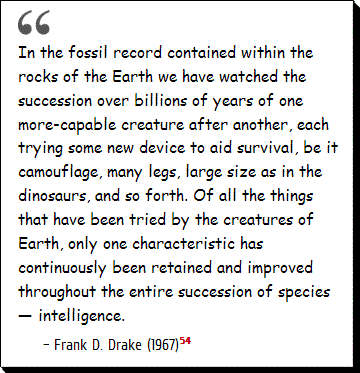 |
In Chapter 3 we suggested that there are basically two distinct ways of viewing the question of intelligence.
- First, there are the "structural" approaches which attempt to define intellect in terms of specific physical characteristics of neural equipment — brain mass, neurological complexity, and so forth.
- These were briefly discussed in that earlier chapter, and were found to be somewhat useful in comparing relative intelligence levels among the fauna of a single world (Earth).
But structural definitions are suspect in xenobiology because they tend to restrict the universe of discourse.
- While we hope that we have at least a vague notion of what intelligence does or ought to do, there may be many physiological — structural — ways of building a biological unit to do the same job.
- For this reason, probably the majority of xenobiologists would favor a functional definition of intelligence over a merely structural one.
- This would appear to be the only way to avoid the peculiarities and limitations of the mental organs found on Earth.
What is the best way to set forth a functional definition of sentience? Some writers have advocated a "checklist" approach.
The suspect creature should be carefully observed, they urge, and watched for signs of a specific constellation of behaviors from which smartness can be inferred.
Typical list items include:
- Faculty of reason
- Ability to fashion and use tools
- Proficiency with language
- Predisposition to learn from experience, or "mental plasticity"
- Forethought and equilibration
- Creativity, insight, and intuition
- Ability to transmit culture
- Sociability
- Use of logic
- Ability to symbol
- Curiosity
- Ability to perceive spatial, temporal, numerical, or abstract relationships
- Imagery and the ability to construct perceptual worlds
- Memory
- Self-awareness or consciousness
Such definitions, while perhaps adequately circumscribing the bounds of human intelligence (and this is questionable), actually tell us little about the nature of intellect as a general force in nature. Checklists tend to be anthropomorphic, culture-limited and starkly geocentric, and as such afford no real insight into the possible character of alien intelligence elsewhere in the Galaxy.
A somewhat more generalized intellect-defining behavioral hierarchy has been suggested by the well-known Harvard University entomologist Dr. Edward O. Wilson. He divides evolved intelligences into three distinct levels:
- Lowest grade — the complete instinct-reflex machine. Representative organisms (sponges, coelenterates, flatworms on Earth) are so simply constructed that they must depend largely or wholly on token stimuli from the environment to guide them.
- Middle grade — the directed learner. These organisms (arthropods, cephalopods, cold-blooded vertebrates and birds) have a fully elaborated nervous system with some programming, some learning. Typically it is narrow in scope and limited in responsiveness to a narrow range of stimuli. It results in behavior as stereotyped as the most neurally programmed "instincts."
- Highest grade — the generalized learner. These organisms (humans, primates, social canids) carry a wide variety of memories, some of which have only a very low probability of ever proving useful. Insight learning may be performed, yielding the capacity to generalize from one pattern to another and to juxtapose patterns in ways that are adaptively useful. Few if any complex behaviors are wholly preprogrammed morphogenetically at the neural level. Perception of history, in the broadest sense, is a key feature.565
Wilson’s system provides an evolutionary progression, a standard against which extraterrestrials might theoretically be measured. Yet this definition — rather, identification — of intelligence suffers from many of the same weaknesses of the checklist approach. The fundamentals of thinking simply are not addressed.
Roger A. MacGowan, an aerospace computer scientist formerly at the Redstone Arsenal in Alabama, recognized that the key to understanding alien intelligence lies in data processing.729 The thinking process, he notes, consists of an arbitrary number of information-processing functions which may be carried out by living creatures. MacGowan selected five criteria which he believed to be both necessary and sufficient to specify intellectual functioning in any life-form in the universe:
- Input — An organism must be capable of reacting to physical events occurring in its environment. If it has no sensory input, it has no information to process and thus cannot think.
- Storage — Without the ability to remember, a creature could not learn. All data processing would have to proceed in real time, with full throughput and no delays. Such a being would perceive no past or future, merely an ever-present now. Since the primary function of life is to accumulate information and structure, it is hard to see how a creature without memory could possess an adaptive and useful intellect without recollection of the past.
- Deduction — The ability to compare current input information patterns with stored information patterns is a crucial intellective function. By making such an association, the creature becomes able to respond to the present on the basis of its past. The ability to use the generalizations formulated yesterday to respond to the problems of today is of great selective value in the struggle for survival.
- Induction — Inductive thinking must be considered a prerequisite for thinking, because it provides "a means of altering stored information patterns as a function of each input information pattern in such a way as to form or modify generalizations on the basis of experience." With induction, an organism is able to respond to its future on the basis of its past.
- Output — After it has decided what to do, an intelligent being must act. This output may manifest itself either as physical or mental activity.
MacGowan’s criteria for intelligence, if we accept them at face value, are probably sufficient for the purposes of the First Contact Team. Yet they provide more identification than explanation of what intelligence does. Our search is not quite ended, but we sense that we are on the right track.
|
It is easy to view intelligence, on the one hand,
as a kind of speeded-up evolution of sensory data, or to view natural evolution, on the other hand, as a "painstaking and slow, but implacable, intelligence." Life is a negentropic process that extracts order from ■ How much alive is determined by how complex ■ Life is properly defined along a spectrum — Similarly, intelligence is a negentropic process ■ Again, we claim, the greater the data flow ■ Intelligence, like life, cannot be defined in |
It is interesting to note that the processes of intelligence are remarkably similar to those of life itself. The methods used by brains to collect and order environmental information recapitulate the methods used by natural evolution.
To perform the functions suggested by MacGowan, for instance, brains or nervous systems must collect data, filter and reject irrelevancies, store and process that which is relevant, and then arrive at some conclusion based on the input stimuli.
- The techniques of natural selection are quite similar.
- Thousands, millions, or even billions of organisms — the "data bits" of evolution — are "fed" into the environment.
- There they are shuffled, ordered, discarded and selected according to fitness — that is, they are "processed" through the environment.
- The species as a whole picks up information thereby and collectively "learns" how to survive, storing the hard-won data in the community gene pool.
It is easy to view intelligence, on the one hand, as a kind of speeded-up evolution of sensory data, or to view natural evolution, on the other hand, as a "painstaking and slow, but implacable, intelligence."1000
| Negentropic process |
Life is a negentropic process that extracts order from the environment and stores it in a complex structure. How much alive is determined by how complex the structure is. Life is properly defined along a spectrum — the greater the data, the more alive the lifeform. Similarly, intelligence is a negentropic process by which information is extracted from the sensory data stream generated by stimuli in the environment. Again, we claim, the greater the data flow the smarter the lifeform. Intelligence, like life, cannot be defined in a yes/no manner but must be viewed in terms of a spectrum of functionality.
|
Intelligence, indeed,
seems as inevitable as life itself. |
Even primitive protozoans have rudimentary neural apparatuses, and can be trained to do simple tasks such as swim up glass capillary tubes and cling to sterile platinum wires. More advanced creatures such as earthworms and snails are easily trained to perform more complicated "tricks." We find the glimmerings of higher intelligence in the most modest of Earth’s inhabitants, a striking example of evolutionary convergence on a grand scale which should provide some clue as to its ubiquity on other worlds.
Intelligence, indeed, seems as inevitable as life itself.3241
 |
We may perhaps glean some insight into the evolutionary processes underlying the emergence of intelligence by examining how human intellect arose on Earth.*
- While details may differ from planet to planet, the outcome of mental evolution elsewhere in the universe should be at least functionally similar.
* What is the optimum body shape for sentient ETs? Scientific opinion remains sharply divided on this question, and two schools of thought have emerged. The pro-humanoid camp (including Bieri,1706 Blumrich,1058 Campbell,1380 de Camp,2572 Fletcher,1935 Howells,330 Hynek,597 Ley,212 MacGowan,600 Ordway,2571 Puccetti,71 Rall,445 and Spall1137) claims that the primate form is best for tool-using aliens.
|
What is the optimum body shape for sentient ETs? Click for Synopsis
|
The non-humanoid camp (see Blum,1668 Broms,1191 Clarke,81 Dobzhansky,1705 Eiseley,135 Huygens,602 Muller,1184 Oparin,1558 Ornstein,327 Ruzic,559 Sagan,85 Shapley,1554 Simpson,334 Vertregt,1171 and Wald867) holds that the human form is a unique evolutionary accident that will not be repeated elsewhere. (There is also a middle-of-the-road camp, such as Anderson,63 Gardner,1555 and Molton,1129 but this is a minor faction.) The debate has raged for decades, and will not be detailed here. Suffice it to say that the humanoid form is a very useful one, so it probably will not be rare. Whether it will be common remains an open question.
| Most primitive microorganism |
The amoeba is one of the most primitive microorganisms on Earth today. In its own limited environment, it does quite well without any nervous system. The amoeba responds to chemical gradients and bits of food floating by, towards which it extends its pseudopods, engulfs, and consumes.
| More sophistication with crude memory |
Another protozoan — the paramecium — is vastly more sophisticated by comparison. This animal is covered with a kind of "fur," a coating of tiny hairlike cilia growing from the outer wall of the single cell. As paramecia move through the water the tiny cilia beat in unison, coordinated by small filaments connecting the roots of the hairs. Each organism also has a ciliated mouth so that food may be fanned into the microscopic gullet.
While it has only the simplest of nervous systems, the paramecium does have a crude "memory." For instance, when it bumps into an obstacle, it has the ability to back up, turn slightly to one side, and move forward again. It can thus remember whether what it did last was wrong, and If so, it can correct the situation.
| Colony of single-celled creatures |
The sponge exemplifies the next stage in the evolution of multicellular intelligence on Earth. This organism is really just a colony of single-celled creatures with abilities similar to those displayed by paramecia. The hundred or so individuals in the collective manage to beat their cilia in the same general direction, thus setting up a flow of water and food for the benefit of all.
But there is no whole-body coordination — a stimulus applied to one part of the animal causes only a local disturbance close to the site of application. Cells farther away are never informed of the problem, and do not react.
| Global coordination |
The hydra is probably the simplest terrestrial creature alive today with what is called "global coordination." If there is some noxious stimuli, the entire organism will bend away. It has a rudimentary "true" nervous system which permits impulses to traverse the entire body. But there is no brain, so the hydra is incapable of very sophisticated responses. It cannot pool a variety of stimuli, and it cannot really choose among alternative actions.
The development of early life, from simple reactivity in the amoeba to full global coordination in the hydra, seems fairly straightforward. If the Hypothesis of Mediocrity holds true and Earth is typically exotic, the evolution of whole-body coordination may be expected to be basically similar on other worlds.
|
The ganglionic system ■ The invertebrates, representing perhaps 97% of all ■ Information is processed fast enough and in sufficient If this is no measure of biological success, what is? |
But above the level of Hydra, evolutionary convergence begins to break down.
- According to the paleontological record, there is a fork in the road.
- The animal kingdom divides into two distinct classes representing wholly different stratagems for gaining increased intelligence.
| First stratagem: Ganglionic nervous system |
Nearly a million animal species — arthropods, molluscs, and many other invertebrates — opted for what paleoneurologists call the "ganglionic" nervous system. The earthworm is typical. Each of its many segments is almost an individual organism unto itself — each having its own set of kidneys, muscles, sensors and so forth. Coordination is achieved by a thin latticework of nerve fibers crisscrossing the animal from side to side and lengthwise.
The ganglionic system resembles, more than anything else, a ladder with bulbous neural ganglia at each of the joints. The invertebrate organism thus is comprised of a collection of sub-brains, each of which controls a separate part of the animal with fairly complete autonomy. The organizational structure is not unlike that of a political confederation.
|
The ganglionic system (details) Click for Synopsis
|
Sensors tend to cluster nearer the head. A brain of sorts — enlarged ganglia — accumulates there, but it isn’t a true brain as we understand the term. Perhaps it is better described as merely a large collection or bundle of separate ganglia. Nevertheless, such a nervous system proves to be highly efficient for getting quick response to stimuli. Each clump of nerve cells becomes "expert" as some particular function — detecting and passing along sensory information, sweeping leg or wing in wide uniform arcs, opening and closing the jaws in slow munching motions during feeding, and so on. The entire system is orchestrated by "consultation" with the "chairmanship" of the bundle of ganglia concentrated in the head, but there is no real centralized control.
The ganglionic system has proved an enormous success on Earth. The invertebrates, representing perhaps 97% of all animal species alive today, have discovered a data processing technique adequate to ensure their survival. Information is processed fast enough and in sufficient quantities to enable ganglionic organisms to thrive and proliferate. If this is no measure of biological success, what is?
|
Why virtually no improvement in the design? Click for Synopsis
|
Might extraterrestrials develop extremely high intelligence using a ganglionic nervous system, by far the most common on this planet?
The chances are strongly against it.
Half an eon ago the invertebrates ruled the Earth. Huge trilobites crawled the shores, gigantic dragonflies with impressive wingspans patrolled the skies, and monstrous squids plied the oceans with little competition. But since that time, in all the hundreds of millions of years that have followed this period of early dominance, there has been virtually no improvement in the design. Why?
Evolutionary biologists have suggested several answers which are interesting from a xenobiological point of view. First, it is believed that the system simply is too complicated when it is scaled up in size. With more and more units, ganglia become inefficient, unwieldy, and bureaucratic. While invertebrates tend to be restricted to smaller sizes for unrelated technical reasons, it’s even true that large invertebrates of greater mass than vertebrates are not nearly as intelligent. For example, many lobsters are larger than squirrels, and many squids are vastly bigger than most vertebrates — and yet these ganglionic creatures invariably are stupider kilogram for kilogram. The system itself appears to be at fault.
It has also been suggested that the ganglionic system is self-limiting. Typical invertebrate structure has only enough room to accommodate programmed "hard-wired" behavior, with no space left over for surplus neural matter that might eventually evolve and enlarge into higher intellect. Still another factor is that the endless cross-connections within the body can become so entangled and interwoven that they actually begin to strangle other body organs. A case in point in the spider, whose head ganglia happen to ring its gullet. But they have grown so massive that they squeeze the throat very tightly, and the poor animal can only swallow its food in a thin trickle.
|
If one deftly clips off the abdomen of a feeding wasp,
the head may go on sucking, obviously not distressed. The mind of such a creature must be alien to us almost beyond comprehension. |
It is hard for us to imagine the mentality of beings with ganglic intelligence. Dr. H. Chandler Elliot, Professor of Neurology at the University of Nebraska College of Medicine, describes the peculiar disconnectedness of the world-view of the invertebrates:
We humans usually disregard our internal organs: We suffer discomfort from an empty stomach, and we heed a stomach’s demands for relief of indigestion, but normally we disregard its activities. The head of an insect apparently regards not only its viscera but also its legs, wings, and so on, with similar detachment: If one deftly clips off the abdomen of a feeding wasp, the head may go on sucking, obviously not distressed. The mind of such a creature must be alien to us almost beyond comprehension.90
|
As we shall see presently, this "central nervous system"
is probably the intelligence of choice for sentient extraterrestrials even though it represents only a tiny percentage of all living animal species on Earth. |
We come at last to the second distinct stratagem for achieving intelligence. A long time ago, a small band of daring organisms set out to explore a totally new system of neurological organization. The chordates (vertebrates plus a few others), who even today number only in the tens of thousands of species, began to experiment with "neural monarchy." As we shall see presently, this "central nervous system" is probably the intelligence of choice for sentient extraterrestrials even though it represents only a tiny percentage of all living animal species on Earth.
| The flatworm |
The flatworm (Planaria) was perhaps the earliest organism to advance beyond the simple nerve net of the hydra. With its primitive central nervous system, the flatworm can actually combine different types of stimuli and then act on this processed information. The animal has two eyespots, a pair of photosensitive cups which give it a curious cross-eyed look. Depending on which side is brighter, the flatworm wriggles away, for it fears the light. Olfactory sensors spread over the surface of its body can sense the smell of rotting meat — a repast the flatworm heartily enjoys — and off he goes in the direction of the scent. If contradictory input is received (the smell of rotten meat under a bright light) the organism is able to decide whether dinner is worth braving the intervening glare.
| The lancelet |
|
Figure 14.1 The Rise of the Brain in Terrestrial Biological Evolution |
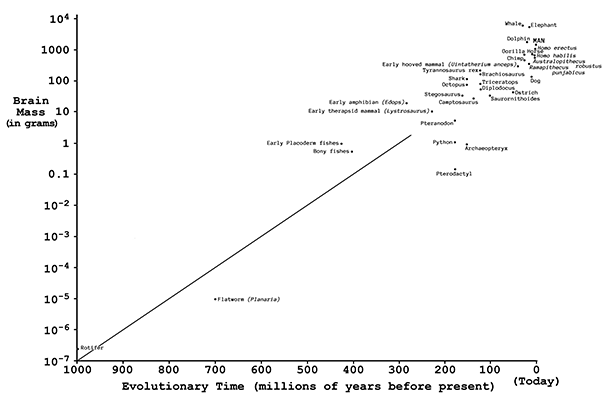 |
One of the first true chordates probably was the ancestor of the modern lancelet (Amphioxus), a small wormlike aquatic mud-dweller. Amphioxus takes the global coordination of hydra and the deductive ability of the flatworm and packs it all into a neat, centralized neural tube. Under dissection there appears to be little difference between brain and spinal cord. But the distinction is of fundamental significance.
The lancelet’s central nervous cord is vastly simpler than the ladder-like ganglionic system of the earthworm. Any number of additional sensory, analytical, or information-processing units may be plugged into the "central data bus." With this simple invention organisms could evolve to any size, yet continue to increase their intelligence simply by plugging in more "peripherals." The spinal column could grow into something far more massive than ganglionic nerve nets, yet never entangle or choke off other organs of the body. The simple brain was more compact and had plenty of room in which to expand. Over millions of years, it began to grow (Figure 14.1).
Dr. Elliot explains the evolutionary significance of this invention in the development of intelligence on Earth:
Thus our worm-fish ancestor could learn. As an individual, of course, he must have been an unteachable dolt, compared to whom a bee is a gifted scholar. But as a race, he and his descendants steadily added new resources to their bodies and brains for ages during which the bee was interminably repeating its perfected, dead-end patterns of living. Till finally creatures arose that could learn freely as individuals — squirrels, cats, and men, who can expand their unified minds farther in an hour than a bee in all its year or two of life, and for many thousands of hours. Man, above all, aspires to worlds and universes of power and delight eternally closed to the bee. All this he owes to the original neural tube, simple but overwhelmingly more potent than the highest facile, flashy, self-limiting ganglionic system.90
|
Many comparative neurophysiologists now
believe, the ganglionic or "distributed brain" is the wrong path for higher intelligence |
If, as many comparative neurophysiologists now believe, the ganglionic or "distributed brain" is the wrong path for higher intelligence, then it is virtually certain that a great many extraterrestrial races in our Galaxy will have made the same momentous discovery during their long evolutionary trek. If ETs have discovered other alternatives to the ganglia and the central notochord, well and good. They would be fascinating to observe, because they would be without precedent on Earth. But we know that the path of the chordates is a sound one, and this is why we expect the idea of notochords and brains to be familiar to alien xenologists as well.
|
It must be borne in mind that evolution is Once something novel has been invented, The new is built upon the old, but does not |
Even assuming that evolution on this world has selected the optimum basic configuration for neural components in the development of intelligence, we cannot expect the specifics of brain development elsewhere to exactly parallel our own. Yet it is fascinating to consider how much of what we are today has been dictated by our neuroevolutionary past.
Among chordates, the most ancient component of the central nervous system is the plug-in spinal cord. As noted above, all sorts of interesting subsystems and advanced modifications could be hooked on as the organism grew in size and complexity. But it must be borne in mind that evolution is a tendentious, almost bureaucratic, process. Once something novel has been invented, it's generally retained and not thrown away. The new is built upon the old, but does not replace it.
| Triune brain / neural chassis |
Dr. Paul MacLean, chief of the Laboratory of Brain Evolution and Behavior at the National Institute of Mental Health, believes that this is exactly how the human brain evolved over the years.2559 His theory of the "triune brain" is one of the most xenologically important developments in our understanding of the emergence of human intelligence. This theory, which neuroanatomists agree is a gross oversimplification of reality, nevertheless provides real in sight into the nature and potential diversity of alien minds.
MacLean begins by pointing out that the simplest fishes have small add-on lumps of neural cells which comprise its limited brain. These lumps are in two sections which biologists call the brain stem and the midbrain. The brain stem and midbrain, together with the spinal notochord common to all chordates, are probably the minimum amount of equipment necessary to operate any vertebrate larger than a small fish. MacLean groups together these three components and calls them the "neural chassis."
|
Figure 14.2 The Triune Brain in Humans, and Possible Alien Alternatives |
|||||
|
Figure 14.2A
A highly schematic representation of the reptilian complex, Figure 14.2B
Possible Alien Triune Brain Figure 14.2C
Possible Alien Triune Brain Figure 14.2D
Possible Alien Triune Brain |
The scientist believes that the story of man’s brain involves the slow accretion, over evolutionary timescales, of three successive and overlapping brain structures that were plugged in to the neural chassis, modular-style — but which were never removed once nature was through with them. Following each evolutionary step, the older more primitive modules were left in place and new ones plugged in on top of them (Figure 14.2).
The human triune brain, explains MacLean, "amounts to three interconnected biological computers, each with its own special intelligence, its own subjectivity, its own sense of time and space, its own memory, motor, and other functions."2559 Each represents a major new evolutionary step. Because the present human brain has this peculiar tripartite structure, and since each of the primitive components is still present and operational, "we are obligated to look at ourselves and the world through the eyes of three quite different mentalities."
| Reptilian brain |
The earliest of the three human plug-in brain systems has been called the "reptilian brain." This structure surrounds the midbrain in the neural chassis and probably arose 300 million years ago with the rise of the first reptiles.
| Limbic brain |
The second unit was laid over the first, eventually taking over the higher organismic functions. This unit is called the "limbic brain," and probably arose about 150-200 million years ago with the emergence of the first mammals on Earth.
| Neocortex |
The third and final unit, which appears in most of the higher mammals, is the neocortex. This structure began to develop about 30 million years ago as a small growth on top of the limbic system, slowly spreading, enlarging, becoming more massive over time, finally reaching the peak of accelerated development a few million years ago with the rise of man. The neocortex now completely encases the underlying layers of reptilian and limbic brain. It is more central to neurological control functions in humans than the other two systems.
Each of these brains has a different way of looking at the world. Each has a different mode of operation. And yet each is functioning still within our heads, causing untoward psychological conflict and, as we shall see, much of what is interesting about human behavior.
|
The reptilian mind is not characterized by
powerful passions and wrenching contradictions, but rather by a dutiful and stolid acquiescence to whatever behavior its genes and brains dictate. |
The reptilian brain, for example, is now known to play a major role in determining aggressive behavior, territoriality, ritualism, and the establishment of social hierarchies.2552 This dull, plodding neurosystem, with its slavish dependence on programmed "hard-wired" behaviors, may be responsible for a great deal of human ritualistic and hierarchical behavioral patterns:
- our political institutions and bureaucracies
- our fertility dances
- our unparalleled aggressiveness and competitiveness
The reptilian mind is not characterized by "powerful passions and wrenching contradictions, but rather by a dutiful and stolid acquiescence to whatever behavior its genes and brains dictate."2552
| Endocrine glandular system |
The limbic system, which overlays the reptilian brain, appears to generate strong, vivid emotions of various kinds. This is the seat of the endocrine glandular system, which is governed by the pituitary or "master gland." The amygdala, a subsidiary gland, is known to regulate aspects of fear, aggression, and attack behavior. Hormones released into the bloodstream by the hypothalamus and thalamus control such diverse functions as hunger and thirst, attention span and anxiety, and visual retention.
|
There are reasons to suspect that the
beginnings of individual altruism, neonatal and parental care, even love may have followed the development of the limbic system in the evolving mammalian brain. |
The oldest part of the limbic brain is the olfactory cortex, which does for smell what the higher auditory and visual centers do for sound and light. The hippocampus, another limbic structure, is believed to control a wide variety of mental functions including:
- short-term memory
- sensitivity to pain
- sexual interest
There are reasons to suspect that the beginnings of individual altruism, neonatal and parental care, even love may have followed the development of the limbic system in the evolving mammalian brain.2552
The neocortex, home of the higher human cognitive functions, represents perhaps 85% of the entire brain volume in man. As mammals evolved this gigantic "tumor" swelled outward like a balloon, increasing the cranial volume — and intelligence — markedly.
The neocortical brain carries on a wide variety of highly sophisticated data processing functions.
- The frontal lobes are concerned with deliberation, initiative and caution, anticipation and planning, and overall regulation of complex behaviors.
- The parietal lobes handle spatial perception, three-dimensional orientation, and the exchange of information between the brain and the rest of the body. They also provide the ability to manipulate symbols which is so crucial to the development and use of language.
- The temporal lobes contain the auditory centers were acoustical data is monitored, processed, and rerouted.
- The occipital lobes are charged with processing visual information coming from the eyes.
What do xenobiologists have to say about all of this? It is not unreasonable to suppose that alien evolutionary patterns may also include some form of neural chassis with plug-in components. Certainly this is an adaptive course of development that encourages survival. But it is asking too much of evolutionary convergence to expect that natural selection on other planets will produce exactly the same neural chassis structural overlays as our own. ETs might have only two higher brain systems, or four, instead of our basic three. And the distribution of behavioral functions and memory subsystems will likely be vastly different.
|
It has been suggested that
one prerequisite for neocortical development is a stable internal body temperature — that is, homeothermy or warm-bloodedness. |
Nevertheless, and purely as an hypothetical exercise, let us examine the kinds of alien minds we might encounter elsewhere if the three major stages of vertebrate mental development on Earth (ritual, emotional, and reasoning) prove to be more or less universal.
| Homeothermy (warm-bloodedness) |
It has been suggested that one prerequisite for neocortical development is a stable internal body temperature — that is, homeothermy or warm-bloodedness.85 This hypothesis receives at least tentative confirmation by the appearance of both limbic and neocortical systems only after the rise of the warm-blooded mammals. On a world where homeothermy was never invented, the reptilian complex might eventually come to dominate the brain of sentient extraterrestrials.
Dinosaurs, bearers of the largest of the reptilian brains, are traditionally regarded as extremely dumb animals. Typical is Diplodocus, a monstrous beast weighing twelve metric tons and guided by a tiny brain the size of a golf ball.The dinosaurs ruled the Earth for a hundred million years, yet their brains advanced little during that time.
Still, we must take care to avoid "mammal chauvinism." In point of fact, there were a few dinosaur species that were slowly evolving towards higher intelligence using the reptilian brain. One good example is the species Saurornithoides, whose members weighed in at 50 kilograms with brains of about 50 grams. These small reptiles were bipedal, with four-fingered hands and an ability to catch and eat small mammals. Their intelligence has been compared to that of the modern ostrich.
| High alien reptilian intellect |
On another world, given enough time and a slower introduction of homeothermy, might high alien reptilian intellects emerge? (Figure 14.2b) Sentient creatures in whom the R-brain dominated the others might have learned to hunt collectively and perhaps prevent the proliferation of mammals at a later date. The psychology of such creatures would be a fascinating blend of ritual and peculiar species-specific responses, and their dogged aggressiveness and unyielding devotion to duty could make them quite fearsome warriors.
Most of the mammals on Earth did quite well with only a limbic brain perched atop the ancient reptilian complex. Perhaps the neocortex isn’t necessary for higher intellect at all. What if conditions on another world were such that the limbic brain (Figure 14.2c), rather than the neocortex, came to represent the highest level of brain development? How could this state of affairs ever come about?
|
It is a fact that the olfactory cortex takes up
a considerable portion of the limbic brain. whom scent is the primary sensory modality, such as dogs, the olfactory cortex is far more intricate and elaborated than it is in man. |
Xenobiologists recognize that the limbic component of the mammalian brain is very closely connected with the sense of smell. It is a fact that the olfactory cortex takes up a considerable portion of the limbic brain. It’s also known that in those animals for whom scent is the primary sensory modality, such as dogs, the olfactory cortex is far more intricate and elaborated than it is in man.
In the previous chapter we suggested various environments which may tend to favor the evolution of beings who rely more heavily on olfactory, rather than visual or auditory, stimuli. These same environments, given enough time, should also tend to favor the enlargement and articulation of the olfactory centers in the limbic system which no subsequent neocortical development could ever hope to match. In other words, osmic aliens will have brains designed to handle olfactory data, which in turn implies the evolution of high limbic intelligence.
Sentience which is predominantly limbic will be more subject to emotional distractions than other forms of intellect. These extraterrestrials may be unduly concerned with ameliorating hunger, thirst, and other "creature comforts" of life. They might also be inordinately preoccupied with sex, even by the most libidinous human standards.
We see that diverse forms of alien intelligence can be imagined, simply by allowing that extraterrestrial brains may be dominated by reptilian or limbic, rather than neocortical, components. But even if ETs are predominantly neocortical, this is no guarantee that their minds will be equivalent to ours.
| Perpetually inclement world |
Reptilian creatures first appeared during the Mesozoic era on Earth, a period in our planet’s history marked by a very mild, warm, uniform climate on a global scale. Mammals didn’t take over until, so to speak, the weather turned from fair to foul. Let us imagine a world which is perpetually inclement, varying widely from hot to cold and dry to wet without respite. On such a planet, there might be significant advantage in developing homeothermy far sooner than on Earth.
If warm-bloodedness arrived early enough, perhaps even predating the rise of cold-blooded or reptilian creatures, then the rapid unfolding of biological evolution could leave the reptilian component of the brain relatively small and insignificant. ETs might have few traces of the R-complex, a few scant shards of the limbic system, and would possess brains comprised primarily of neocortical material.
These aliens would think far differently from humans, even though they share with us a large neocortical component. The ancient drives of aggression, dominance, and impulsive hierarchical organization might be wholly foreign to them, and they could have great difficulty fathoming the significance of our many cultural rituals and our religious and political institutions. To them, our emotionality would appear primitive, even barbaric.
|
While intelligence arises because lifeforms
must adapt to their environment, it will continue to evolve only so long as the adaptation is not perfect. Higher intellect leads either to greater survivability or to superior control of the environment, either of which in turn lead to a decrease in the need to develop still greater intelligence. |
Along similar lines, Doris and David Jonas point out that while intelligence arises because lifeforms must adapt to their environment, it will continue to evolve only so long as the adaptation is not perfect.1000 Higher intellect leads either to greater survivability or to superior control of the environment, either of which in turn lead to a decrease in the need to develop still greater intelligence.
In the last 30 million years of terrestrial history, the neocortex of mammals has enlarged from a mere wisp to a massive structure dominating the human cranial cavity. The Jonases hypothesize that this trend will continue, because human society is not yet perfectly adapted to the technological environment it has created. The ability to comprehend and analyze increasingly complex and abstract problems is of greater selective value than ever before. The knee-jerk emotional reactions radiated by the limbic system appear maladaptive in a society in which rationality is the hallmark of success. And the ritualistic and aggressive behaviors caused by the reptilian brain seem incompatible with a healthy, undogmatic, liberal culture on a small planet with limited resources and finite territories.
| Homo neocorticus |
So it is not unreasonable to suppose that the neocortex may continue to enlarge with the passage of future human generations. Perhaps it will eventually grow to replace most or all of the cognitive and behavioral functions presently assumed by other brain systems. The resulting intelligence, which the Jonases feel may be in the cards for humanity, may be called Homo neocorticus (Figure 14.2d).
Like the ancient alien homeotherms described above, extraterrestrials whose culture is highly technologically oriented may undergo similar evolution, slowly casting off their primitive drives one by one as they become highly rational and unflappable thinkers.
|
Then there is the possibility of Homo bionicus,
with his snap-on input monitors, his plug-in memory modules, and his subcutaneous microcomputer logic circuits. |
It could be that the timescales in such projections are all wrong. Millions of years were required even for the abnormally rapid expansion of the human neocortex, whereas social and technical changes require time periods on the order of tens, hundreds, or thousands of years.
| Homo bionicus |
However, it is unlikely that the ultimate evolution of Homo neocorticus or his extraterrestrial counterpart is impossible. The very rapidity of technological processes may permit a kind of artificial evolution to an equivalent state. Advanced genetic engineering, for example, could make possible the design and development of altered humans with reduced or restricted limbic and reptilian brain components. Artificial biological brain components or bioneered modules could be used to replace ancient brain sections with more advanced neocortex-like structures. Then there is the possibility of Homo bionicus, with his snap-on input monitors, his plug-in memory modules, and his subcutaneous microcomputer logic circuits. Each of these are reasonable models of conceivable alien intelligences with whom we may someday have to learn to deal.
|
Figure 14.3 Information Stored in Genes, Brains, and Cultures |
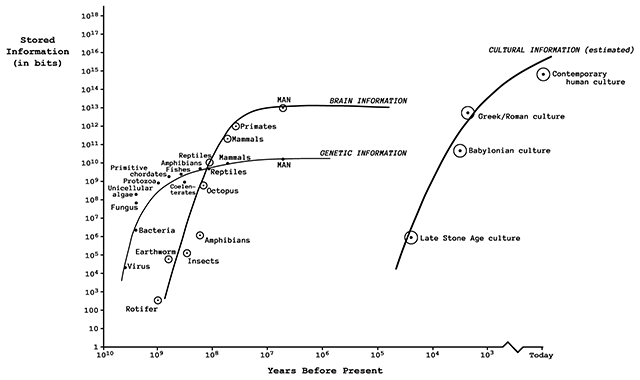 |
| Biological information storage |
Any organism that must sense its environment and react to it, or seek mates and reproduce, or hunt for prey and avoid being preyed upon; or which has some form of locomotion or mobility probably will discover that added intelligence is of enormous benefit and selective value. In the game of life, smarter animals generally do better than dumber animals. Certainly one of the most interesting questions from the standpoint of xenology is: Will extraterrestrials have "advanced" intellect?
To the extent that intelligence is data processing, the more information a creature and process and store the smarter it is and the more competitive it will be in the struggle for survival on its home world during its natural evolutionary phase. The fundamental unit of information is the "bit," or binary digit, briefly discussed in the previous chapter in connection with sensory apparatuses. A bit, in the parlance of information theorists, is the amount of information needed to correctly choose between two equally likely answers to a simple yes/no query.
| Twenty Questions |
Let’s take an example. The English alphabet has 26 letters. If you play "Twenty Questions" with a friend who has some single letter in mind, it’s possible to guess which one it is by asking as few as five independent yes/no questions. (Try it.) Thus, theorists argue that a printed letter represents exactly five bits of information. The average five-letter word therefore has 5 × 5 = 25 bits, and so forth.
Figure 14.3 is a map of the various forms of biological information storage found on planet Earth. There are three curves, defining a clear progression from lower to higher capacity.
|
We can imagine three distinct ways in which
the quality of intellect may be worked out in biology. We shall call these "genetic sentience," "brain sentience," and "communal sentience," three steps along the path of ever-increasing intelligence. |
| Data stored in genes |
The lowest curve represents the amount of data stored in the genes of terrestrial organisms. Judging from its antiquity, genetic information storage appears to be the slowest, most time-consuming means available to living creatures. On timescales of millions of years, changes in the information stored per genome are imperceptible. Evolution evidently is a very slow intelligence.
| Data stored in brains |
The middle curve shows the storage of data in the brains of animals. This is a much faster process — large changes are readily apparent over time-scales of millions of years. The number of bits stored per entity, as well as the complexity of behavior, is greater with brains than with genes. Still, on timescales of millennia there is little change in the maximum quantity of information capable of being stored by a single biological brain.
| Data stored in human cultures |
The highest curve at the far right displays the amount of data stored in human cultures as a function of time. Sociocultural bit-storage is at once the most volatile and the most efficient technique, representing another quantum leap in overall capability. Change is rapid on timescales of millennia, and long ago surpassed the levels of the other two curves. In a sense, social evolution may be viewed as an extremely fast intelligence.
From these three curves, we may define three distinct orders of possible "advanced" alien sentience. Accepting tentatively the speculation that level of intelligence may depend in part upon the ability of an organism to assimilate information, we can imagine three distinct ways in which the quality of intellect may be worked out in biology. We shall call these "genetic sentience," "brain sentience," and "communal sentience," three steps along the path of ever-increasing intelligence.
 |
| Group intelligence |
Imagine an alien species which for some reason is trapped at the level of genetic information storage. Unable to progress to more efficient forms with higher data ceilings, the intellect of each individual entity is limited to what can be done with genes alone.
The insects of Earth are a case in point. It will be recalled that the majority of the animal world consists of invertebrates without notochords. instead, a network of smaller sub-brains called ganglia is used. The main brain in the head is merely a larger-than-normal aggregation of ganglia, so the basic system appears to be self-limiting as regards maximum size and complexity.
| Information stored in genes |
Finding the road to bigger brains — the next step up in intelligence — blocked, a few clever insects decided to make do with what little they had. Unable to become better at coping with the environment by individual intellectual effort, the social insect species (ants, bees, termites, etc.) reworked their genetic structures in order to increase their adaptability. Instead of storing information in their limited brains alone, they stored it in their genes. Their DNA, rather than their individual minds, learned.
| Social insects |
Can we really say that the social insects are sentient, though? There is nothing wrong with this at all. If one considers the anthill or the beehive as a single superorganism — as do several xenobiologists565 — each clearly displays many of the attributes of higher intelligence:
- Data from the immediate environment are absorbed and acted upon.
- Judgments are made almost exclusively at the community level as regards:
- • foraging for food
- • reproductive activity
- • temperature and humidity control in hive or hill
- • military defense of the colony and so forth
|
Ants respond strongly to pheromone (smell) signals,
and bees to visual cues (e.g., the waggle dance). or electrical* modes to achieve community-wide information processing and control. |
And if sentience requires an ability to recognize the self, the social insect superorganism clearly meets this test.
- Colonies of ants or bees are acutely aware of their own identity.
- Individuals have no difficulty recognizing members of foreign colonies (even of the same species) as strangers.
In this sense, each nest is aware of itself as an entity or living system distinct from all others.
Many variations on this theme may readily be imagined from the vantage point of the xenological perspective. ETs with genetic sentience (often called “group intelligence”) may achieve communication between individual units in a wide variety of different ways. Ants respond strongly to pheromone (smell) signals, and bees to visual cues (e.g., the waggle dance). Aliens might choose auditory, tactile, magnetic or electrical* modes to achieve community-wide information processing and control.
| Intelligent scum |
Radioastronomer Ronald Bracewell has proposed a slime-mold colony with genetic sentience, which he disparagingly refers to as an "intelligent scum."80 But there is no reason why individual members of societies with genetic sentience need be small and insignificant creatures, There may be valid evolutionary pathways that lead to genetic overspecialization before an advanced, self-aware brain can gain a foothold.
|
The result of such evolution might be a society
of genetically distinct breeds within the main species, each specialized to perform specific societal functions — farming, construction, administration, recordation, soldiering — and each possessing a fairly complex technologically- capable mind without individual sentience. |
The result of such evolution might be a society of genetically distinct breeds within the main species, each specialized to perform specific societal functions — farming, construction, administration, recordation, soldiering — and each possessing a fairly complex technologically-capable mind without individual sentience. At least one modern psychological theorist has claimed that it is possible to think, calculate, and build complex technical civilizations without the capacity for individual self-awareness.2599
Science fiction writers Larry Niven and Jerry Pournelle created such an alien race in The Mote in God’s Eye.668 The extraterrestrial creatures in this novel had a diversity of different castes, determined genetically, for specialized forms of labor. The society was highly technological, despite the superficial resemblance to a termite colony, and was capable of radio, nuclear fusion, and interplanetary travel. Individual self-awareness, while apparently possessed by a few castes on a limited basis, was not the norm.
Genetic sentience and high technology, then, are not necessarily mutually incompatible.
* In Olaf Stapledon’s excellent science fiction novel Last and First Men,2567 the author describes the evolution of sentience among a collection of biological components which he calls “virus types." What appears to he a mere cloud of particles on the surface of Mars is actually a diffuse mass of physically separated units, whose intelligence arises through the integration of the whole by means of an electrical information transmission capability in the larger aggregates. The radio signals used by the human astronauts scramble the aliens’ "mind," precipitating an outbreak of hostilities. Dr. Thomas Gold also has suggested the possibility of a society of “electric ants” with “group intelligence” and immortal consciousness.22
 |
|
The brain sentient ET
is aware of itself as a unique being different from all others. |
| Unique from all others |
Genetic sentience involves a community of organisms that is aware of itself, but whose members are not individually aware. For such lifeforms, automatic behaviors and duty are all. To a social insect, each of its neighbors are virtually indistinguishable and fully interchangeable (within each caste or age grade). There is no sense of individuality; there is no word for "I." And with no sense of self there can be no sense of empathy for the selves of others — their thoughts, their drives, or their pain.
The brain sentient ET is aware of itself as a unique being different from all others. In the higher lifeforms, many subtle and complex clues are used to distinguish each of perhaps thousands of other local members of the species from the self. These distinctions are achieved without the penalty of genetic overspecialization. Much societal information is not "hard-wired" as in the social insects but rather is learned during childhood and possesses a flexible, or "plastic," nature.
- The lowest brain-toting creatures on Earth, such as fishes and amphibians, seem incapable of telling their own offspring apart from members of physically similar species which are their prey (the kids are eaten at birth if the parents happen to be hungry).
|
Genetic sentience involves a community
of organisms that is aware of itself, but whose members are not individually aware. and duty are all. virtually indistinguishable and fully interchangeable. |
- Reptiles improve on this somewhat.2566
- However, it is mainly among the birds and the mammals — the two animal groups with the most highly evolved brains on this planet — that familial and social ties begin to be taken seriously.
- Many birds are known to have complicated pecking orders with dozens of independently identifiable animals in the chain.
- Among primates, particularly the chimpanzees, orangutans, and, of course, humans, xenologists find a developing or well-developed sense of the self2563 as well as a complex awareness of the individuality of others.
Possible variants of brain sentience, involving the concept of the triune brain. have already been discussed in an earlier section.
 |
|
Communal sentience is difficult for ■ Just as insects can only be dimly aware of the implications of their tiny brains, ■ We humans can only vaguely appreciate the plethora of historical forces and sociocultural processes which circumscribe our social existence. |
|
To them, humanity would appear ■ Our continual relapses into states of war ■ Our dependence on elaborate, formalized and highly specialized institutions ■ Our lack of empathy with others would seem pitiful and barbaric. |
| Internalized sociocultural awareness |
Cultural information storage is clearly the most efficient and well-integrated technique available to biological lifeforms. As the graph indicates, it represents as great an improvement over brain-dependent systems as the brain represents over genetic systems. Sentience based on an internalized sociocultural awareness must be equally advanced beyond our own.3329
| Genetic sentience |
Beings with genetic sentience are physiological and social specialists.
- Both body and mind are strictly "mission-oriented."
- Individual initiative is stifled and behavior is stereotyped.
| Brain sentience |
Brain sentient individuals have cast off the shackles of biological specialization.
- Members of these species are more or less physiologically generalized.
- Such creatures, of which humans are a typical example, are nevertheless forced to retain their social specialization patterns — pecking orders, dominance hierarchies, governments, etc.
| Communal sentience |
Extraterrestrial species that have achieved communal sentience will be both physiological and social generalists.
- Not only will physical form be roughly equivalent throughout the society, but each individual member will be capable of handling virtually all sociocultural tasks with ease.
- While the individual members of a genetically sentient group are totally unconscious, and brain sentient humans are aware of themselves but not of their society, communal sentient aliens will have a well-developed, very real sense of their community as well as of themselves.
- Individuality need not be sacrificed: A new level of awareness is simply tacked onto the old.
- Somehow — perhaps by electronic telepathy or psychological synchronization — each creature can sense what is good for society just as a human knows that it is good to eat when he is hungry or to scratch when he itches.
- The alien feels personal anguish at offenses against the community, and perhaps even views it as a real, physical extension of his own body.
One wonders what such a race might think of us. To them, humanity would appear at best partially conscious. Our continual relapses into states of war, our dependence on elaborate, formalized and highly specialized institutions, and our lack of empathy with others would seem pitiful and barbaric. Just as humans can train a dog to perform certain useful tasks for purposes incomprehensible to the animal itself, perhaps communal ETs could teach us a few sociopolitical "tricks" to enable us to live together in harmony — though we understand them not at all.
The distinctions between the communal and genetic modes of sentience should perhaps be made more explicit. In a differentiated genetic society, the individuals are physically different from members of other castes and perform only very specialized physical and social tasks. In comparison, the communal society consists of individuals with similar bodies (no castes) and who perform highly generalized physical and social tasks. In the former, the individual member has no self-awareness whatsoever; in the latter, the individual has a deep and abiding (almost visceral) understanding both of his own self and of the corporeality of his society.
Communal sentience is difficult for human beings to imagine. Just as insects can only be dimly aware of the implications of their tiny brains, we humans can only vaguely appreciate the plethora of historical forces and sociocultural processes which circumscribe our social existence. The idea that alien beings may exist who can sense the pulse, the hunger and the mood of their community as easily as we can of our physical bodies is a mysterious and alluring possibility.
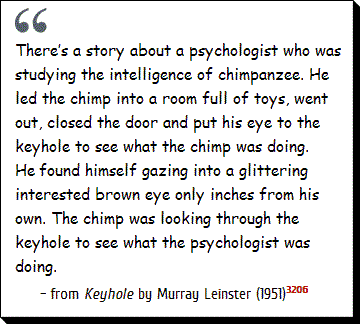 |
|
Despite several millennia of avid
theorizing, philosophers, theologians and psychologists still cannot agree exactly what consciousness is. |
At last we arrive at the fascinating question of alien consciousness — whether it exists, what form it may take, and how advanced it may be. From our awareness of our own consciousness, we suspect it may be the most significant and unique aspect of the human thinking apparatus. Will ETs be conscious too?
Despite several millennia of avid theorizing, philosophers, theologians and psychologists still cannot agree exactly what consciousness is.
- The standard dictionary definition is fairly popular:
"Consciousness is the awareness of one’s self as a thinking being." - (Indeed it has been argued by some that the emergence of self-awareness represented the true dawn of humanity.2564)
- Other definitions abound, ranging from "awareness of awareness" to mere "wakefulness" or alertness.
According to Dr. Julian Jaynes, a Princeton University psychologist, most people feel that consciousness is the most self-evident thing imaginable about the human psyche:
We feel it is the defining attribute of all our waking states, our moods and affections, our memories, our thoughts, attentions, and volitions. We feel comfortably certain that consciousness is the basis of concepts, of learning and reasoning, of thought and judgment, and that it is so because it records and stores our experiences as they happen, allowing us to retrospect on them and learn from them at will.2599
|
Thinking, judgment, verbal association, deductive
and inductive reasoning, intuition, creativity and abstraction all do not require consciousness in order to be displayed by an intelligent lifeform. |
Unfortunately, most if not all of these statements may be false. Consciousness does not appear to be a copy of experience, storing up experience, copying it like a camera to be reflected upon at some future time. Rather, suggests Jaynes, "conscious retrospection is the retrieval of what you have been conscious of before, and the reworking of these elements into rational or plausible patterns." Consciousness is not necessary for conceptualization either. One of the great functions of language, Jaynes says, is "to let the word stand for a concept, which is exactly what we do in writing or speaking about conceptual material, {which} we must do because concepts are usually not in consciousness at all." Similarly consciousness seems unnecessary for learning, which snails and flatworms can do. In fact thinking, judgment, verbal association, deductive and inductive reasoning, intuition, creativity and abstraction all do not require consciousness in order to be displayed by an intelligent lifeform. Concludes Jaynes:
Consciousness is a much smaller part of our mental life than we are conscious of, because we cannot be conscious of what we are not conscious of. How simple that is to say; how difficult to appreciate! It is like asking a flashlight in a dark room to search around for something that does not have any light shining upon it. The flash light, since there is light in whatever direction it turns, would have to conclude that there is light everywhere. And so consciousness can seem to pervade all mentality when actually it does not. … Consciousness does not make all that much difference to a lot of our activities. If our reasonings have been correct, it is perfectly possible that there could have existed a race of men who spoke, judged, reasoned, solved problems, indeed did most of the things that we do, but who were not conscious at all.2599
|
More complex living systems at higher levels of
organization manifest characteristics, more than the sum of the characteristics of the units which comprise them, not observed at lower levels. |
Consciousness, much like intelligence itself, appears to be an example of what is called an "emergent" by evolutionary theorists. According to Dr. James Grier Miller, President of the University of Louisville and a pioneer in systems science, more complex living systems at higher levels of organization manifest characteristics, more than the sum of the characteristics of the units which comprise them, not observed at lower levels.3071 These new characteristics are emergents, made possible by the increased complexity present in higher-level systems. Dr. A.G. Cairns-Smith, Professor of Chemistry at the University of Glasgow in Scotland, describes emergents from the standpoint of biological evolution:
One can see natural selection as conserving and improving biological machinery. But this is far from the whole story: sometimes a quite new function is discovered, or some new way of performing an old one. Maynard Smith3303 has discussed how this can happen. He says: "This is a very common feature of evolution: a new structure evolves first because it confers advantage by performing one function, but in time it reaches a threshold beyond which it can effectively perform a different function." Lungs seem to have arisen through such a threshold, through fish finding another use for the esophagus — as an auxiliary respiratory organ. This set in train a series of modifications that was to lead, eventually, to the exclusive respiratory organs of animals. The "improving" aspect of selection was an essential part of the story, but lungs are not improved gills, they did not evolve through a succession of design modifications from gills. Lungs took over.
Objects often turn out to have uses other than that for which they were originally designed: headlamps are signals, books are flower presses, and so on. Indeed often a machine may be curiously well adapted to an inadvertent function, or a material developed for one purpose be found to have diverse uses. We might say that bone is stiff for load bearing functions, but this property was to be important too, in connection with efficient sound transmission, during the evolution of the mammalian ear. For higher evolution generally, such function ambivalence has not been simply an odd side effect. It has been part of normal strategy. Above all it has provided means of escape from initial design approaches.3302
Miller offers another clear-cut example of emergents by comparing three different electronic systems:
One of these — a wire connecting the poles of a battery — can only conduct electricity, which heats the wire. Add several tubes, condensers, resistors, and controls, and the new system can become a radio, capable of receiving sound messages. Add dozens of other components, including a picture tube and several more controls, and the system becomes a television set, which can receive sound and a picture. And this is not just more of the same. The third system has emergent capabilities the second system did not have, emergent from its special design of much greater complexity, just as the second has capabilities the first lacked.3071
|
A number of scientists today suspect that
the phenomenon of consciousness may be an emergent arising naturally from the organizational complexity and processing efficiency found in the human brain. |
How does all this relate to consciousness? A number of scientists today suspect that the phenomenon of consciousness may be an emergent arising naturally from the organizational complexity and processing efficiency found in the human brain. Neurobiologists recently have delved more deeply into the workings of the brain, and many have concluded that a general physiological theory of human consciousness soon may be possible. Dr. Gerald M. Edelman, Nobel. prize-winning immunologist from Rockefeller University in New York, has made a tentative step in this direction.3005 At a 1977 meeting of more than a hundred neuroscience researchers in Colorado, Edelman outlined his theory.2562
| Primary brain repertoire |
The human thinking organ, he claims, is not infinitely malleable as previously supposed. Instead, there are a large number of different kinds of neural circuits hardwired into the brain. These respond to input from each of the senses like a tuning fork stimulated with resonant vibrations. The hardwired circuit groups consist of aggregates of from 50 to 10,000 individual neurons (the human brain has a total of about 10 billion), and together comprise the "primary brain repertoire."
| Secondary brain repertoire |
According to Edelman’s theory, the primary repertoire responds when the message to which it is susceptible is received. Such receipt causes the neuron group to emit its own signal, which is recognized in turn by a second level of neural groups called the "secondary brain repertoire." The secondary level equipment, presumably since it receives greater amounts of compounded and pooled data, lies at a deeper level of awareness than the primary sensory hookups.
Consciousness arises when impulses and patterns generated by the secondary repertoire are cycled around and fed back in as fresh input for other units in the secondary repertoire. While the primary system only responds to direct sensory data from the outside, the secondary system can also respond to internally-generated data as if it were externally-generated. This self-monitoring effect, according to Dr. Edelman, gives rise to human consciousness because it allows a review of internal states. In other words, the brain can watch itself work.
| Levels of awareness |
Science fiction writers are fond of pointing out that there may exist many different levels of awareness among the extraterrestrial races of our Galaxy.1543 Perhaps the most classic example of this may be found in The Black Cloud, written by astronomer Fred Hoyle.62 In the novel it is suggested that natural grades of consciousness may exist, and that it is virtually impossible for a being at one level to comprehend the mentality of another being at a higher level of consciousness. In a similar vein, Carl Sagan draws a fanciful analogy from our relation to the insect world:
The manifestations of very advanced civilizations may not be in the least apparent to a society as backward as we, any more than an ant performing his anty labors by the side of a suburban swimming pool has a profound sense of the presence of a superior technical civilization all around him.15
These writers may not be far of the mark, for it appears quite possible that a variety of different grades of awareness may emerge at successively higher levels of organization and processing capability. Why is this so?
|
The essential characteristic of all intelligent
systems constructed of matter-energy is that they process information. |
The essential characteristic of all intelligent systems constructed of matter-energy is that they process information. As noted earlier, smarter lifeforms tend to survive more often than dumber ones, so we should observe a strong evolutionary trend toward increasing intellect. Translating this into the language of information theory, we might say that the more bits per second a given creature can process, generally the more successful it will be and the stronger the evolutionary pressure to increase the bit rates that brains can handle. Furthermore, since more efficient organisms preferentially survive, all else being equal, there should also exist strong evolutionary tendencies to increase the efficiency of information processing — that is, to process more information using less energy and less material supportive bulk.
| Figure of merit |
If these notions are basically sound, then xenologists may define a "figure of merit" applicable to all sentiences in the universe, one which expresses both capacity and efficiency in a single number. This we shall call the Sentience Quotient (SQ). It is expressed. as the log10 of the quotient of two numbers: The maximum bit rate a sentient creature can process per unit time interval (in bits/second), divided by the quantity of mass-energy the entity needs to do it (in kilograms).
What is the theoretical maximum SQ of any thinking entity in the universe? While this question may at first appear intractable, actually it is not. According to H.J. Bremermann, if energy levels are used as information markers (the most efficient markers imaginable) then the theoretical maximum amount of information that can be processed by a totally dedicated lump of matter is 1.4 × 1050 bits/sec-kg.3072 (See further discussion in Section 25.2.2.) An alien being capable of handling data this rapidly would have to be considered a "perfectly efficient" thinker. In any given mass category, such an entity would possess the greatest intelligence theoretically possible in this universe. Hence, the highest SQ is about log10(1.4 x 1050) ~ 50.
|
That is, there may exist a number of
higher-order intellectual emergents, analogous to but qualitatively vastly superior to consciousness. |
| Natural order of awarenesses |
Consider, as a purely speculative hypothesis, that there may exist a natural order of awarenesses in the cosmos. At each higher level of mentality, a new kind of thought process emerges which is unique to mental systems of equal or higher values of SQ. That is, there may exist a number of higher-order intellectual emergents, analogous to but qualitatively vastly superior to consciousness.
|
Table 14.1 Universal Scale of Sentient Emergents |
 |
What might these higher-order emergents be? The author’s own speculations are offered in Table 14.1. According to this scheme, the most primitive emergent of intelligence is simple "reactivity" — the differentiation of body cells into specialized cells whose sole function is data processing. Perhaps this requires a minimum of 1 bit/sec-kg in the most primitive organisms.
Consciousness of the human type is the next highest emergent. Human brains have about 1010 neurons with about 103 interconnections each and a bit rate on the order of 103 bits/sec/neuron.3071 But brains have tremendous redundancy; assuming a redundancy of 1:104 and a body mass of about 100 kilograms, the human organism works out to about 1010 bits/sec-kg,3233 or SQ ~ 10. This seems near the minimum for the emergence of consciousness.
| Mental classes |
Taking similar steps of ten orders of magnitude for each new emergent to appear, at least four successively more sophisticated mental classes should exist above the level of ordinary human consciousness.
- The first of these is "communality," or the emergent of communal sentience discussed earlier in this chapter (14.2.3 Communal Sentience), perhaps at the 1020 bits/sec-kg level.
- Second could be "hypersociality," a yet higher order of mentality capable of internalizing the processes, functions, and interrelationships between many different societies and species of sentient beings (1030 bits/sec-kg).
- Third might be "galacticity," a single creature’s comprehension of the complexities of a galactic community (1040 bits/sec-kg).
- Finally there could be "universality," the ability of a single sentient entity to hold in its mind the seemingly incalculably complex orderings of an entire universe – full of living systems at all levels of intellectual sophistication (1050 bits/sec-kg).
Naturally, at each higher level of data processing fewer data may be processed at that level. For instance, human consciousness can only handle in formation at about 0.1-1.0 bits/sec-kg,3071 even though our brains may be able to process reactivity (nonconscious) data at much higher rates. Note also that a conscious brain-based entity such as a human can only process communal-level data at the rate of 10-10 bits/sec-kg (because communality has not yet emerged), which perhaps helps to explain why humans have such great difficulty comprehending the intricate workings of the societies in which they live. Finally, note that an intelligent entity at any one level should also possess all simpler levels of awareness as well. Thus for example an hypersocial sentient ought to have communality and consciousness as well as simple reactivity.
Further implications of the Sentience Quotient concept in "first contact" situations are explored in greater detail in Section 25.3.

